PBE Europe as Axell Wireless 55-165703 55-165703 Cell Enhancer User Manual 80 330501HBKM
Axell Wireless 55-165703 Cell Enhancer 80 330501HBKM
Contents
- 1. Manual 1 of 5
- 2. manual 2 of 5
- 3. manual 3 of 5
- 4. manual 4 of 5
- 5. manual 5 of 5
manual 2 of 5
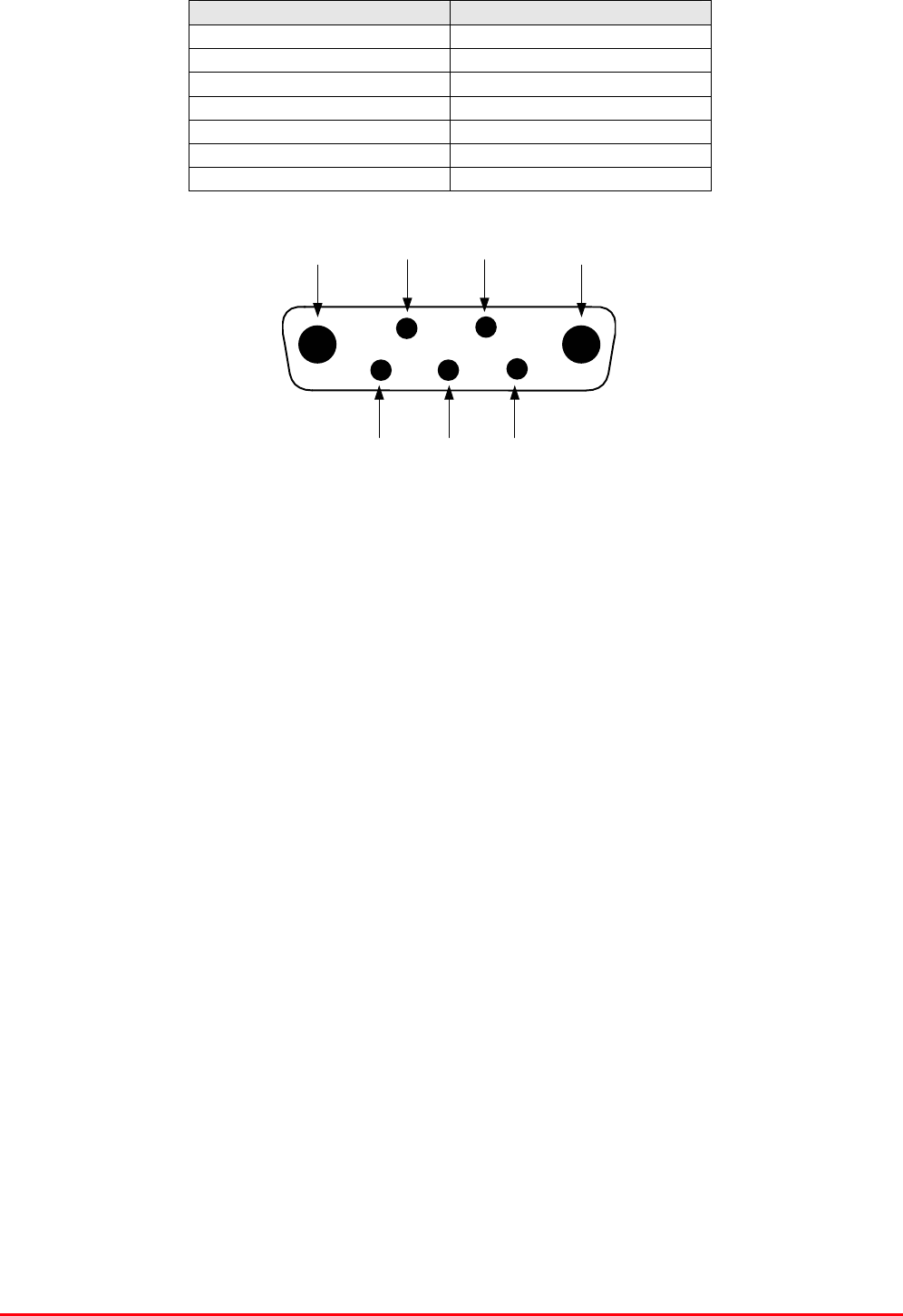
STTRS DOCUMENTATION
Document Number 80-330501HBKM – Issue A - Draft Page 125 of 500
Power Amplifier (12-018002) 7-Way Connector Pin-outs
Connector Pin Signal
A1 (large pin) +24V DC
A2 (large pin) GND
1 Alarm relay common
2 TTL alarm/0V good
3 Alarm relay contact (bad)
4 Alarm relay contact (good)
5 O/C good/0V bad (TTL)

STTRS DOCUMENTATION
Document Number 80-330501HBKM – Issue A - Draft Page 126 of 500
9.4.3. 800MHz Line Amplifier (Ext. Amp.) (55-165401)
800MHz Line Amplifier (Ext. Amp.) (55-165401) list of major components
section Component
Part Component Part Description Qty. Per
Assembly
9.4.3.3. 02-007206 Bandpass Filter 4
9.4.3.4. 07-015105 Wideband Asymmetric Coupler 2
9.4.3.5. 10-000901 Switched Attenuator 0.25W, 0 - 15dB 2
9.4.3.6. 11-006702 Low Noise Amplifier 1
9.4.3.7. 12-018002K Power Amplifier 1
9.4.3.8. 12-021901 Low Power Amplifier 2
17-001109 AGC Detector Assembly (Logarithmic) 1
17-001117 AGC Detector Assembly 1
9.4.3.9.
17-001201 AGC Attenuator Assembly 2
9.4.3.10. 80-008901 12V (Single) Relay Board 1
9.4.3.11. 94-100004 Dual Diode Assembly 1
9.4.3.12. 96-200047 DC/DC Converter 1
9.4.3.13. 96-300052 12V Switch-Mode PSU 1
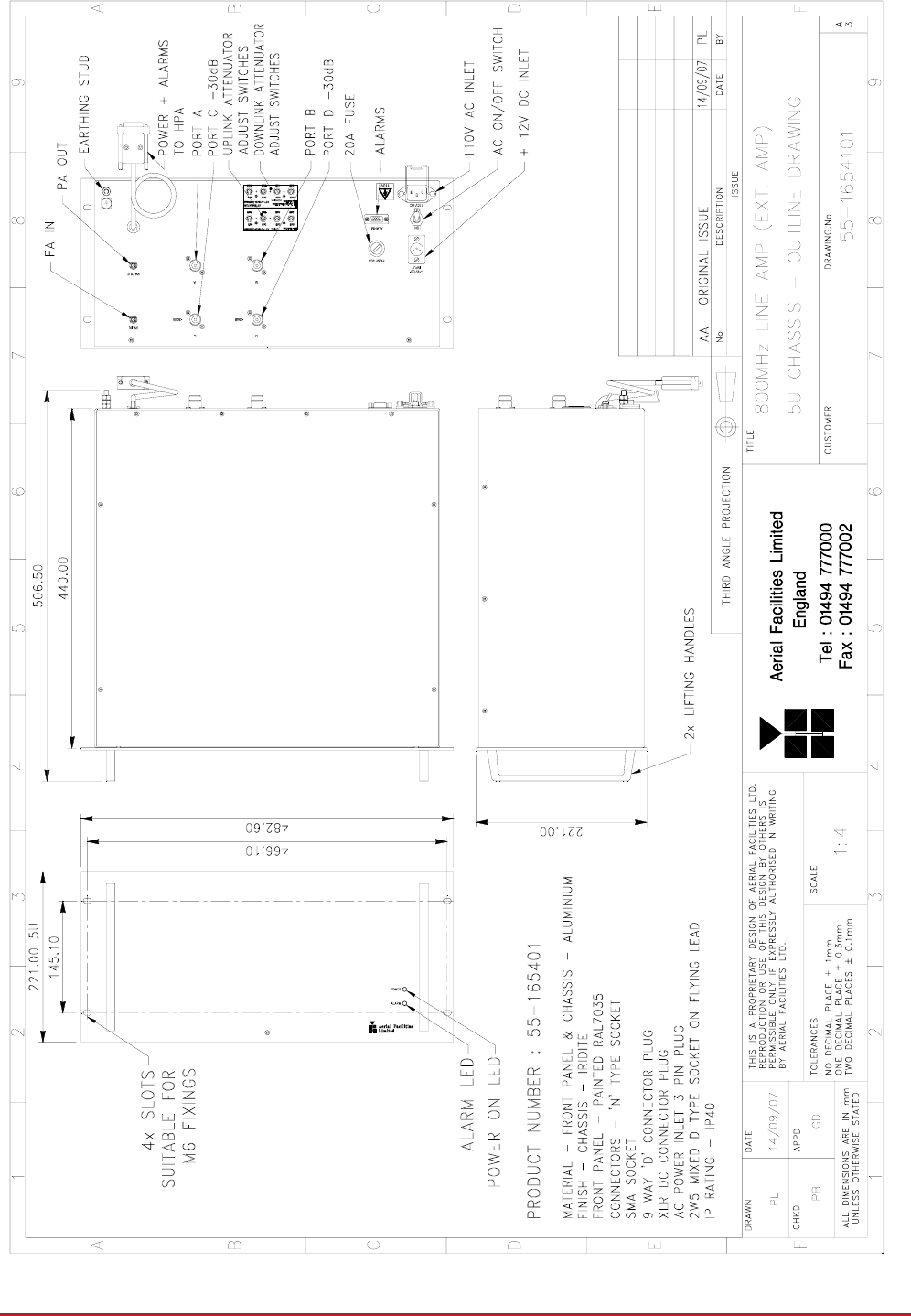
STTRS DOCUMENTATION
Document Number 80-330501HBKM – Issue A - Draft Page 127 of 500
9.4.3.1. 800MHz Line Amplifier (Ext. Amp.) (55-165401) outline drawing
Drawing number 55-1654101
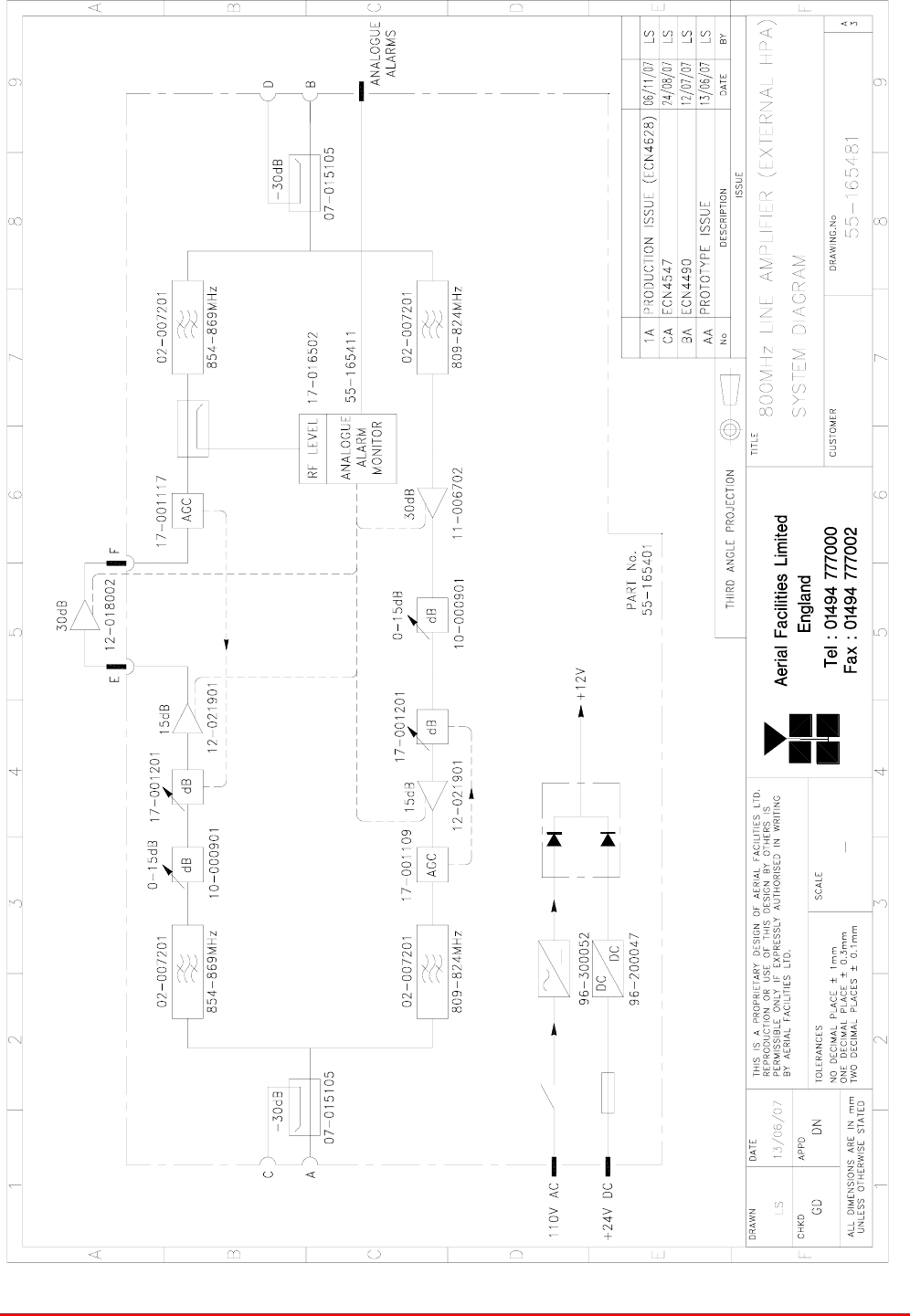
STTRS DOCUMENTATION
Document Number 80-330501HBKM – Issue A - Draft Page 128 of 500
9.4.3.2. 800MHz Line Amplifier (Ext. Amp.) (55-165401) system diagram
Drawing number 55-165481

STTRS DOCUMENTATION
Document Number 80-330501HBKM – Issue A - Draft Page 129 of 500
9.4.3.3. Bandpass Filter (02-007206)
The bandpass filters are multi-section designs with a bandwidth dependent upon the passband
frequencies, (both tuned to customer requirements). The response shape is basically Chebyshev with
a passband design ripple of 0.1dB. The filters are of slot coupled, folded combline design, and are
carefully aligned during manufacture in order to optimise the insertion loss, VSWR and
intermodulation characteristics of the unit. The tuned elements are silver-plated to reduce surface
ohmic losses and maintain a good VSWR figure and 50Ω load at the input and output ports.
Being passive devices, the bandpass filters should have an extremely long operational life and require
no maintenance. Should a filter be suspect, it is usually most time efficient to replace the module
rather than attempt repair or re-tuning.
No adjustments should be attempted without full network sweep analysis facilities to monitor both
insertion loss and VSWR simultaneously.
02-007206 Specification
PARAMETER SPECIFICATION
Response type Chebyshev
Frequency range 800 - 950MHz *
Bandwidth 25MHz *
Number of sections 8
Insertion loss 1.2 dB
VSWR better than 1.2:1
Connectors SMA female
Power handling 100W max
operation -20°C to +60°C Temperature
range storage -40°C to +70°C
Weight 3 kg (typical) *tuned to Customer's specification
9.4.3.4. Wideband Asymmetric Coupler (07-015105)
The purpose of Wideband Asymmetric Coupler (07-015105) is to tap off a known portion (in this case
30dB) of RF signal from transmission lines and to combine them, for example through splitter units for
different purposes (alarms/monitoring etc.), whilst maintaining an accurate 50Ω load to all
ports/interfaces throughout the specified frequency range. They are known formally as directional
couplers as they couple power from the RF mainline in one direction only.
07-015105 Specification
PARAMETER SPECIFICATION
Construction Inductive air gap
Frequency 800-2500MHz
Through loss 0.4dB (typical)
Coupling level -30dB ±0.5dB
Isolation N/A
Weight <1.0kg
Connectors SMA, female
operation -20°C to +60°C
Temperature
range storage -40°C to +70°C
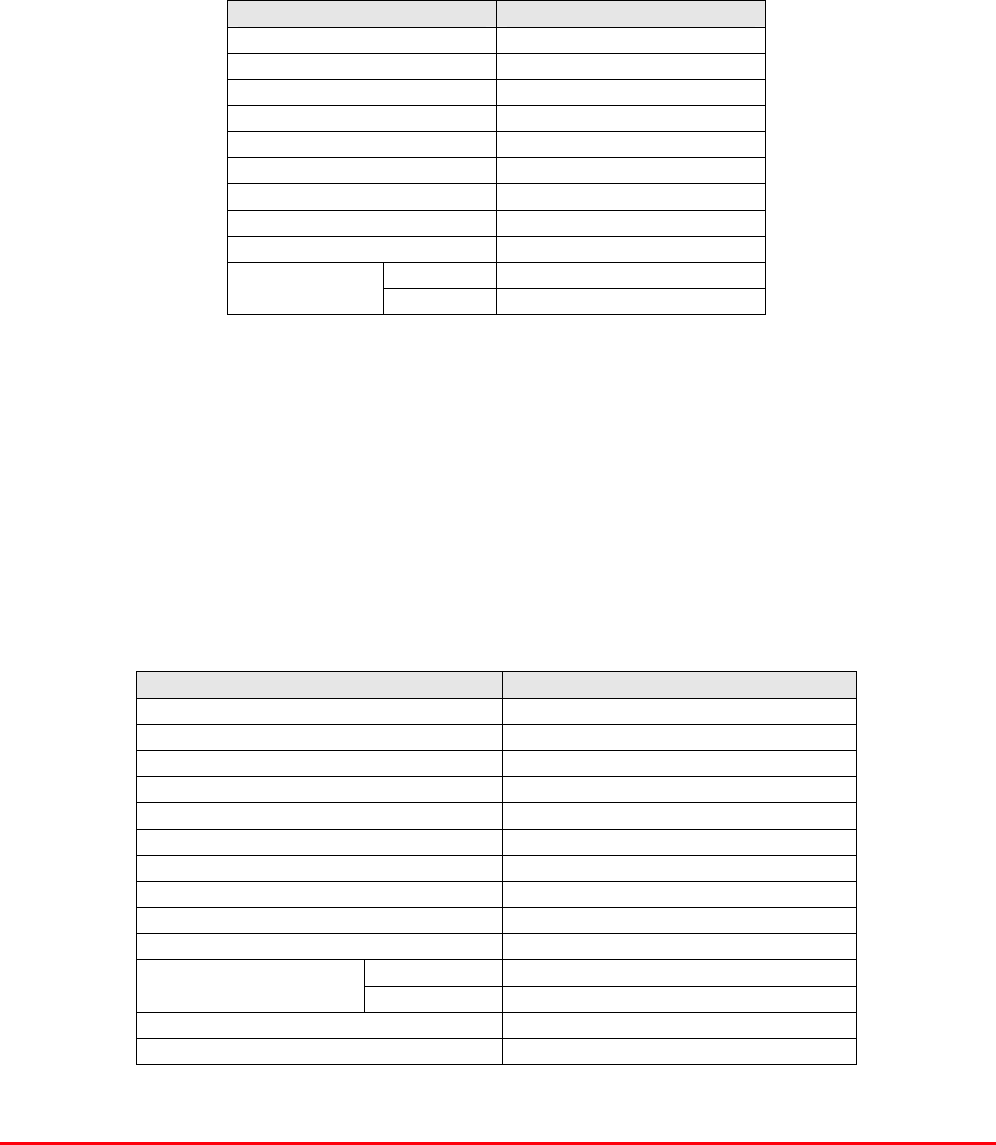
STTRS DOCUMENTATION
Document Number 80-330501HBKM – Issue A - Draft Page 130 of 500
9.4.3.5. Switched Attenuator 0.25W, 0 - 15dB (10-000901)
In many practical applications for Cell Enhancers etc., the gain in each path is found to be excessive.
Therefore, provision is made within the unit for the setting of attenuation in each path, to reduce the
gain.
10-000901 provides attenuation from 0 - 15dB in 2 dB steps The attenuation is simply set using the
four miniature toggle switches on the top of each unit. Each switch is clearly marked with the
attenuation it provides, and the total attenuation in line is the sum of the values switched in. They are
designed to maintain an accurate 50Ω impedance over their operating frequency at both input and
output.
10-000901 Specification
PARAMETER SPECIFICATION
Attenuation Values 0-15dB
Attenuation Steps 1, 2, 4 and 8dB
Power Handling 0.25 Watt
Attenuation Accuracy ± 1.0 dB
Frequency Range DC to 1GHz
Impedance 50Ω
Connectors SMA
VSWR 1.3:1
Weight 0.2kg
operation -20°C to +60°C Temperature
range storage -40°C to +70°C
9.4.3.6. Low Noise Amplifier (11-006702)
The Gallium-Arsenide low noise amplifiers used in 800MHz Line Amplifier (55-165703) are double
stage, solid-state low noise amplifiers. Class A circuitry is used throughout the units to ensure
excellent linearity and extremely low noise over a very wide dynamic range. The active devices are
very moderately rated to provide a long trouble-free working life. There are no adjustments on these
amplifiers, and in the unlikely event of a failure, then the complete amplifier should be replaced. This
amplifier features its own in-built alarm system which gives a volt-free relay contact type alarm that is
easily integrated into the main alarm system.
11-006702 Specification
PARAMETER SPECIFICATION
Frequency range 800 – 1000MHz
Bandwidth <200MHz
Gain 29dB (typical)
1dB Compression point 20dBm
OIP3 33dBm
Input/Output return loss >18dB
Noise figure 1.3dB (typical)
Power consumption 180mA @ 24V DC
Supply voltage 10-24V DC
Connectors SMA female
operational -10°C to +60°C Temperature
range storage -20°C to +70°C
Size 90 x 55 x 30.2mm
Weight 290gms (approximately)
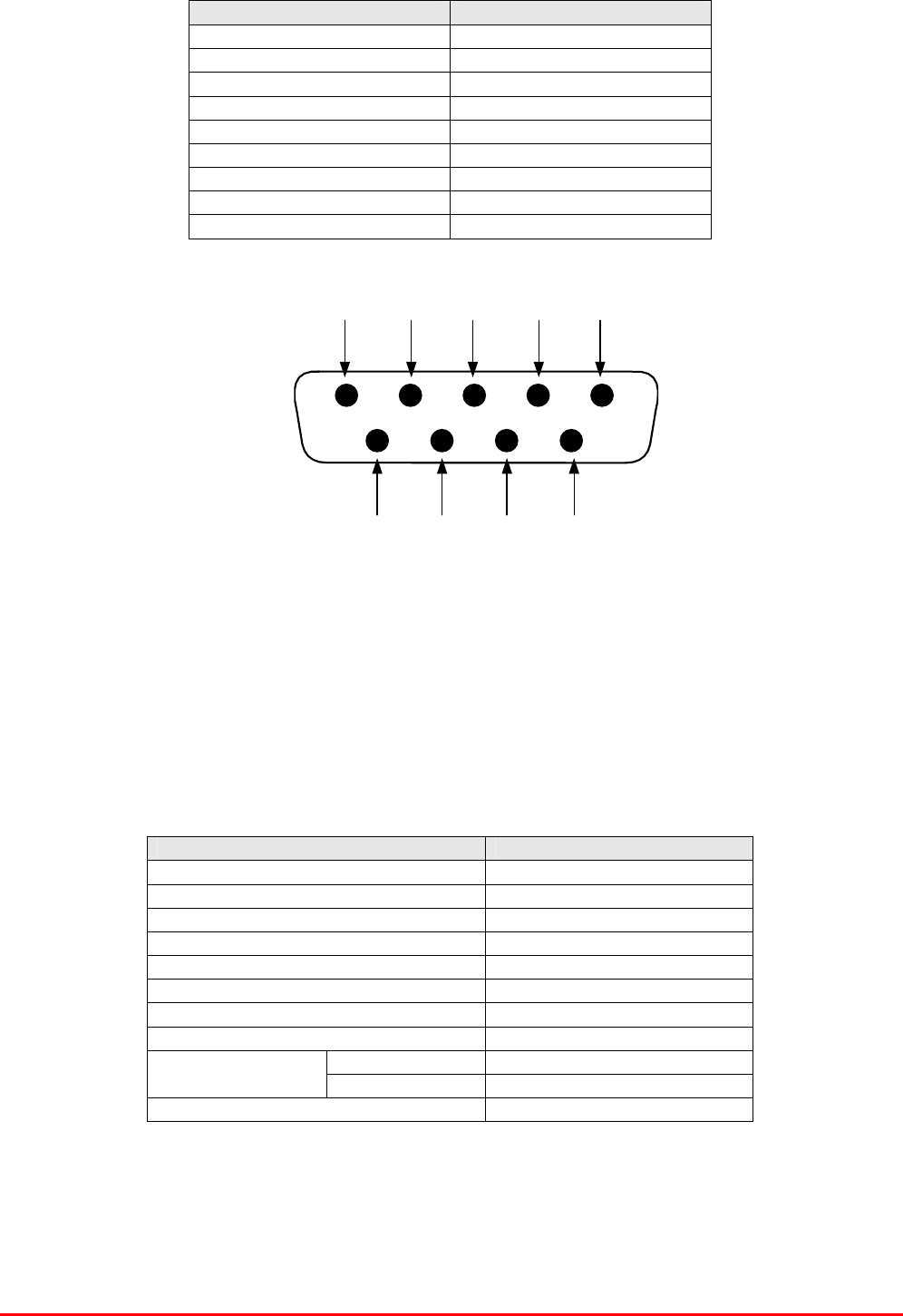
STTRS DOCUMENTATION
Document Number 80-330501HBKM – Issue A - Draft Page 131 of 500
7 8 96
1 2 3 4 5
9-Way Pin-Out Graphical Representation
Low Noise Amplifier (11-006702) ‘D’ Connector Pin-out details
Connector pin Signal
1 +Ve input (10-24V)
2 GND
3 Alarm RelayO/P bad
4 Alarm Relay common
5 Alarm Relay good
6 No connection
7 TTL voltage set
8 TTL alarm/0V (good)
9 O/C good/0V bad
9.4.3.7. Power Amplifier (12-018002)
This amplifier is a Class A 20W power amplifier from 800-960MHz in a 1 stage balanced
configuration. It demonstrates a very high linearity and a very good input/output return loss (RL). It
has built in a Current Fault Alarm Function.
Its housing is an aluminium case (Iridite NCP finish) with SMA connectors for the RF input/output and
a D-Type connector for the power supply and the Current Fault Alarm Function.
12-018002 Specification
PARAMETER SPECIFICATION
Frequency range: 800-960MHz
Small signal gain: 30dB
Gain flatness: ±1.2dB
I/O Return loss: >18dB
1dB compression point: 42.8dBm
OIP3: 56dBm
Supply voltage: 24V DC
Supply current: 5.0Amps (Typical)
operational: -10°C to +60°C Temperature
range storage: -20°C to +70°C
Weight: <2kg (no heatsink)
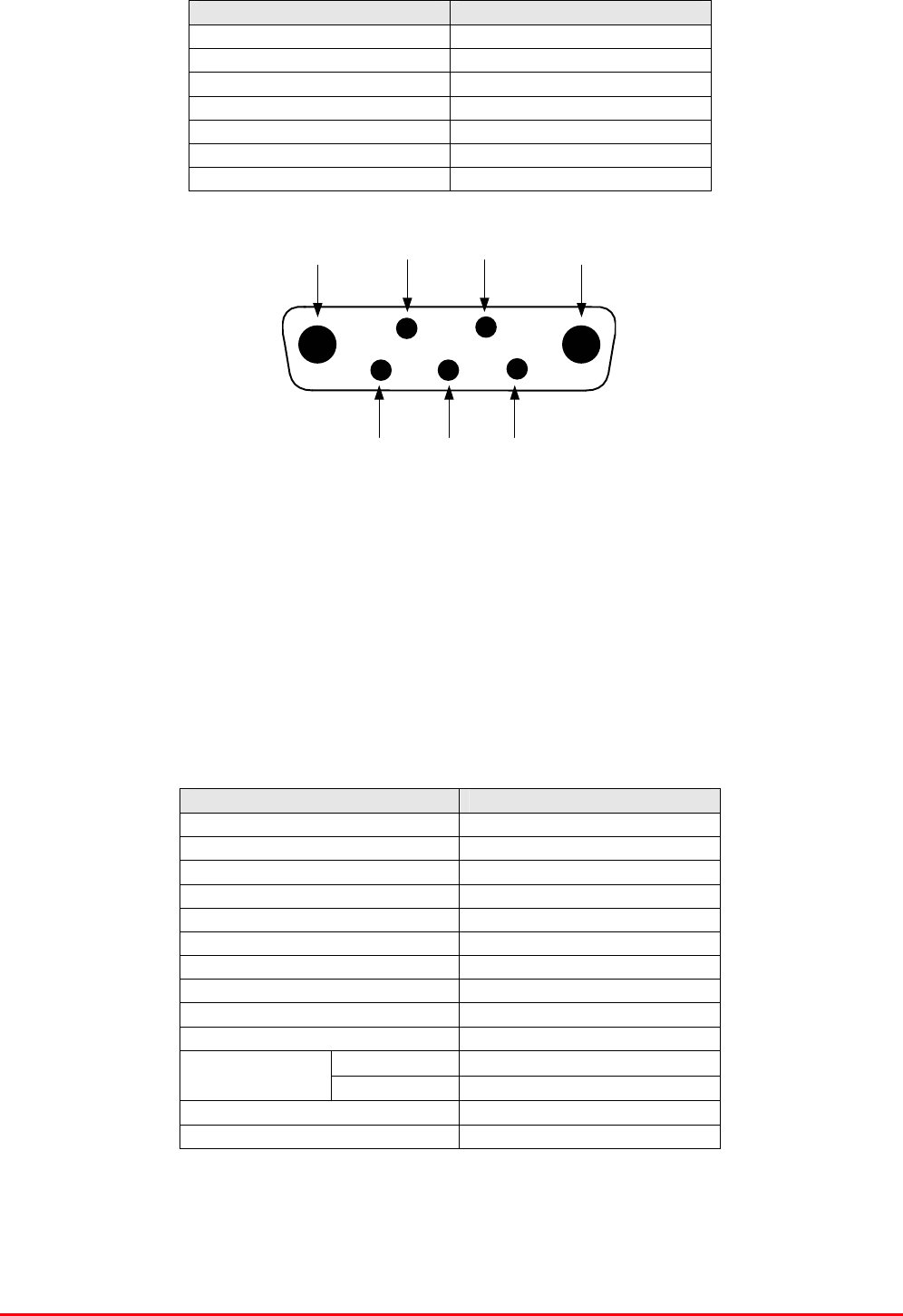
STTRS DOCUMENTATION
Document Number 80-330501HBKM – Issue A - Draft Page 132 of 500
Power Amplifier (12-018002) 7-Way Connector Pin-outs
Connector Pin Signal
A1 (large pin) +24V DC
A2 (large pin) GND
1 Alarm relay common
2 TTL alarm/0V good
3 Alarm relay contact (bad)
4 Alarm relay contact (good)
5 O/C good/0V bad (TTL)
9.4.3.8. Low Power Amplifier (12-021901)
The low power amplifier used is a triple stage solid-state low-noise amplifier. Class A circuitry is used
in the unit to ensure excellent linearity over a very wide dynamic range. The three active devices are
very moderately rated to provide a long trouble-free working life.
Its housing is an aluminium case (Iridite NCP finish) with SMA connectors for the RF input/output and
a D-Type connector for the power supply and the Current Fault Alarm Function.
There are no adjustments on this amplifier, and in the unlikely event of failure then the entire amplifier
should be replaced.
Low Power Amplifier (12-021901) Specification
PARAMETER SPECIFICATION
Frequency range 800-960MHz*
Bandwidth 20MHz *
Maximum RF output >1.0 Watt
Gain 15dB
1dB compression point +30.5dBm
3rd order intercept point +43dBm
Noise Figure <6dB
VSWR better than 1.5:1
Connectors SMA female
Supply 500mA @ 10-15V DC
operational -10°C to +60°C
Temperature
range storage -20°C to +70°C
Weight 0.5 kg
Size 167x52x25mm
* Tuned to Customer’s specification
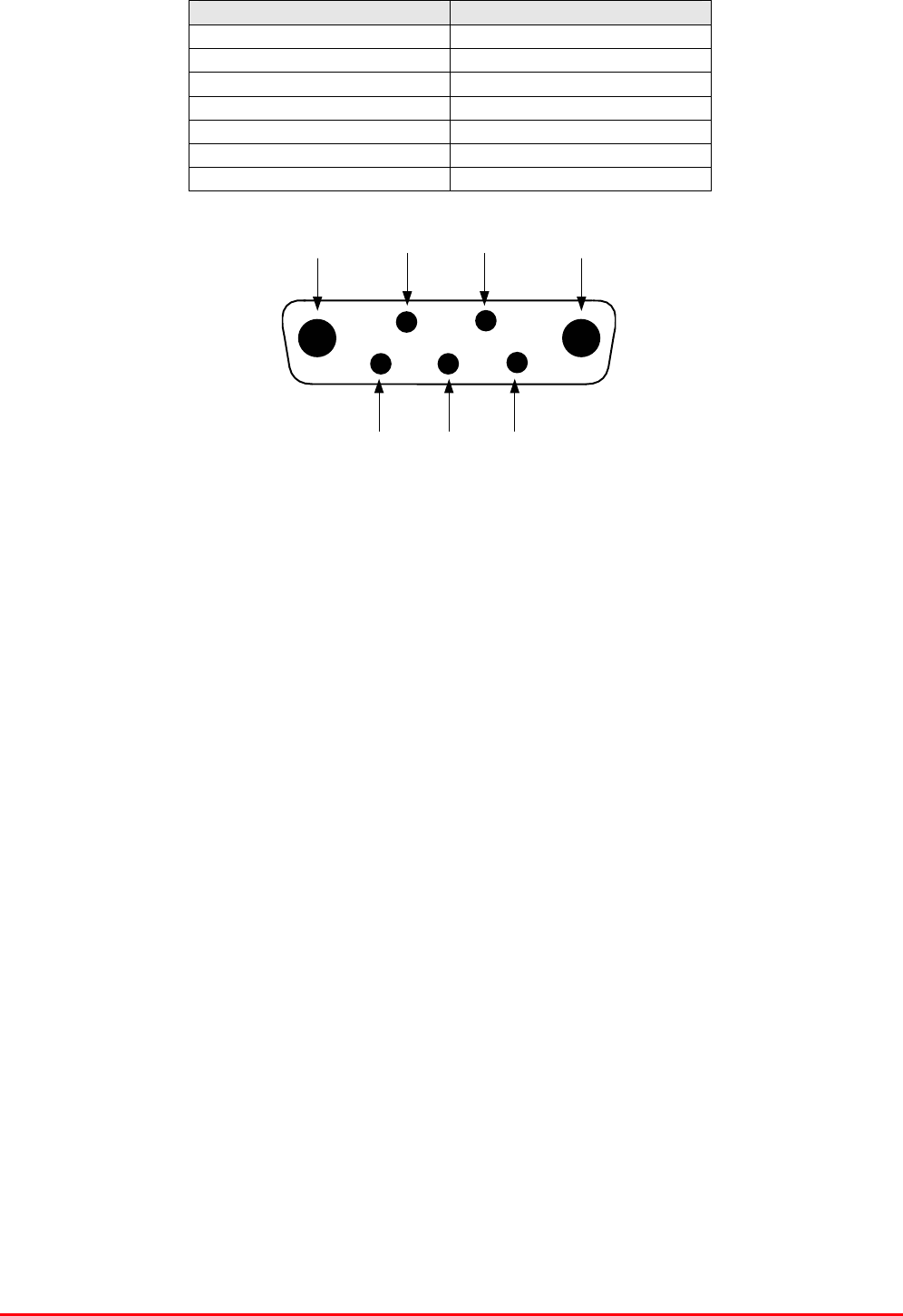
STTRS DOCUMENTATION
Document Number 80-330501HBKM – Issue A - Draft Page 133 of 500
Low Power Amplifier (12-021901) 7-Way Connector Pin-outs
Connector Pin Signal
A1 (large pin) +24V DC
A2 (large pin) GND
1 Alarm relay common
2 TTL alarm/0V good
3 Alarm relay contact (bad)
4 Alarm relay contact (good)
5 O/C good/0V bad (TTL)
9.4.3.9. Automatic Gain Control
17-001109 AGC Detector Assembly (Logarithmic)
17-001117 AGC Detector Assembly
17-001201 AGC Attenuator Assembly
The sub components 17-001109, 17-001117 & 17-001201 are parts of the Automatic Gain Control
(AGC) system used in 800MHz Line Amplifier (Ext. Amp.) (55-165401); 17-001117 and 17-001201
are paired for use in the uplink and 17-001109 and 17-001201 are paired for use in the downlink
800MHz Line Amplifier (Ext. Amp.) (55-165401) is fitted with two differing types of Automatic Gain
Control (AGC) system, one linear, and one logarithmic. The AGC with logarithmic detector (17-
001117) is fitted in the uplink path and the AGC with linear detector (17-001109) is fitted in the
downlink path
The AFL Automatic Gain Control system consists of two units, a detector/amplifier and an attenuator.
The detector/amplifier unit is inserted in the RF path on the output of the power amplifier, and the
attenuator is situated in the RF path between the 1st and 2nd stages of amplification.
17-001117 and 17-001201 are paired for use in the uplink and 17-001109 and 17-001201 are paired
for use in the downlink
The attenuator comprises a 50Ω P.I.N diode, voltage-variable attenuator with a range of 3 to 30dB.
The attenuation is controlled by a DC voltage which is derived from the associated detector controller
board.
Normally the attenuator is at minimum attenuation. The detector/amplifier unit monitors the RF level
being delivered by the power amplifier, and when a certain threshold is reached it begins to increase
the value of the attenuator to limit the RF output to the (factory set) threshold. Therefore overloading
of the power amplifier is avoided.
The factory set threshold is 1dB below the Enhancer 1dB compression point. Some adjustment of this
AGC threshold level is possible, a 10dB range is mostly achieved. It is not recommended under any
circumstances to adjust the AGC threshold to a level greater than the 1dB compression point as
system degradation will occur.
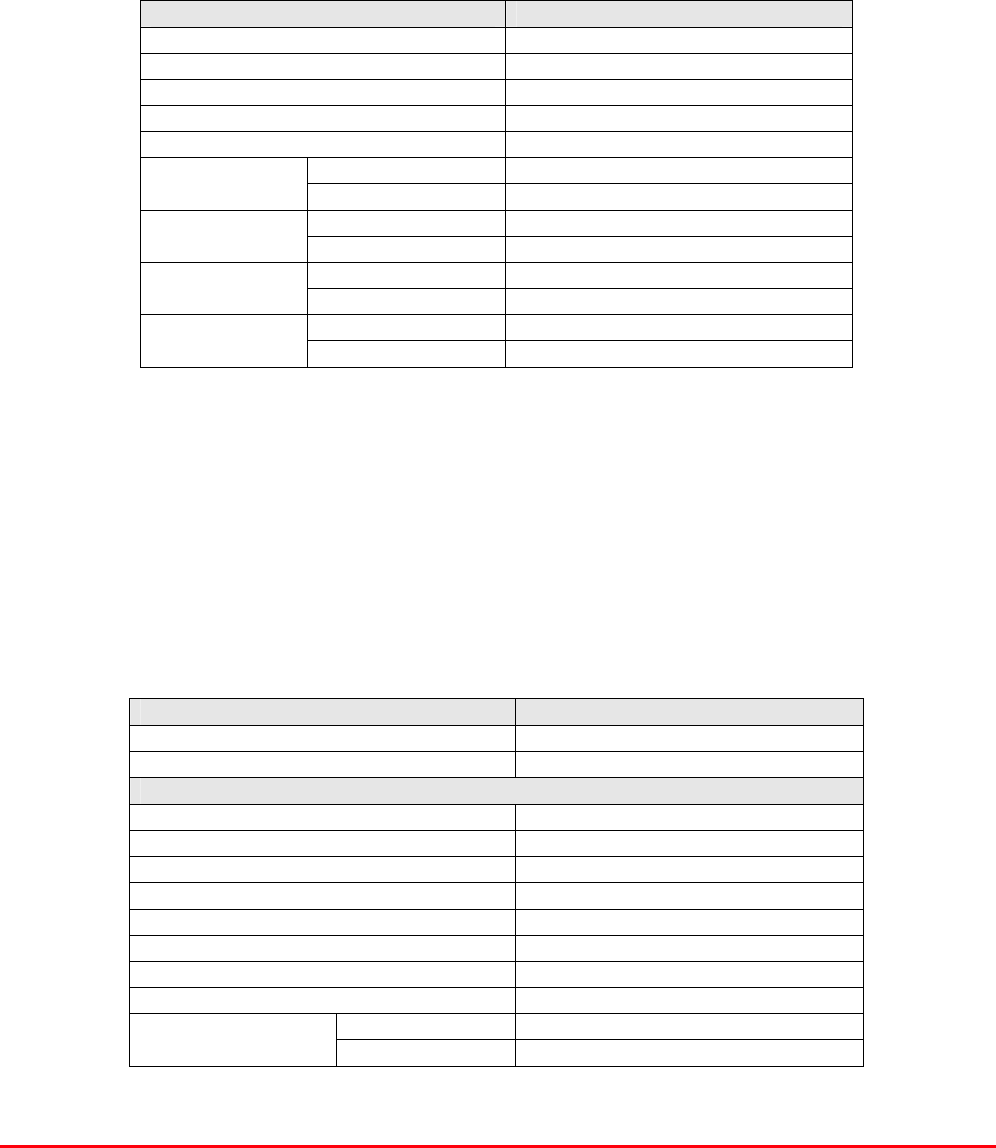
STTRS DOCUMENTATION
Document Number 80-330501HBKM – Issue A - Draft Page 134 of 500
The detector comprises of a 50Ω transmission line with a resistive tap which samples a small portion
of the mainline power. The sampled signal is amplified and fed to a conventional half wave diode
rectifier, the output of which is a DC voltage proportional to the RF input signal.
This DC voltage is passed via an inverting DC amplifier with integrating characteristics, to the output,
which drives the attenuation control line of the corresponding AGC attenuator. This unit is fitted at
some earlier point in the RF circuit.
For small signals, below AGC onset, the output control line will be close to 12V and the AGC
attenuator will have minimum attenuation. As the signal level increases the control line voltage will
fall, increasing the attenuator value and keeping the system output level at a constant value.
AGC Specification (both types)
PARAMETER SPECIFICATION
Frequency range up to 1000MHz
Attenuation range 3 to 30dB
Attenuation steps continuously variable
VSWR better than 1.2:1
RF Connectors SMA female
attenuator 1W Power
handling detector/amp >30W (or as required)
operation -10°C to +60°C Temperature
range storage -20°C to +70°C
attenuator pcb 50 x 42 x 21mm
Size detector/amp pcb 54 x 42 x 21mm
attenuator 90grams
Weight detector/amp 100grams
9.4.3.10. 12V (Single) Relay Board (80-008901)
The General Purpose Relay Board allows the inversion of signals and the isolation of circuits. It is
equipped with a single dual pole change-over relay RL1, with completely isolated wiring, accessed
via a 15 way in-line connector. The relay is provided with polarity protection diodes and diodes for
suppressing the transients caused by "flywheel effect" which can destroy switching transistors or
induce spikes on neighbouring circuits. It’s common use is to amalgamate all the alarm signals into
one, volts-free relay contact pair for the main alarm system.
80-008901 Specification
PARAMETER SPECIFICATION
Operating voltage 8 to 30V (floating earth)
Alarm threshold Vcc - 1.20 volt +15%
Alarm output relay contacts:
Max. switch current 1.0Amp
Max. switch volts 120Vdc/60VA
Max. switch power 24W/60VA
Min. switch load 10.0µA/10.0mV
Relay isolation 1.5kV
Mechanical life >2x107 operations
Relay approval BT type 56
Connector details Screw terminals
operational -10°C to +60°C Temperature
range storage -20°C to +70°C
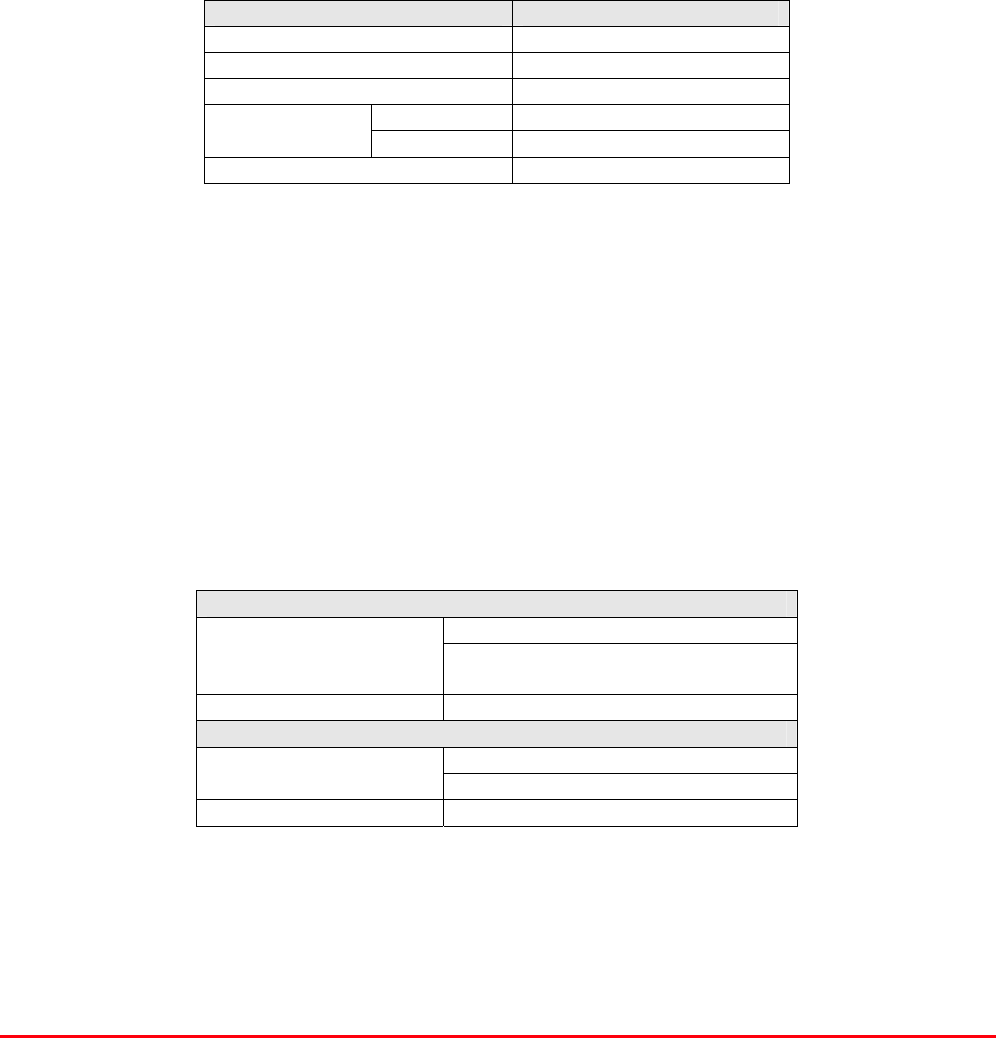
STTRS DOCUMENTATION
Document Number 80-330501HBKM – Issue A - Draft Page 135 of 500
9.4.3.11. Dual Diode Assembly (94-100004)
The purpose of these dual diode assemblies is to allow two DC voltage sources to be combined, so
that the main DC rail within the equipment can be sourced from either a mains driven PSU, or
externally through an XLR connector or from dual mains driven PSUs . They are very heavy-duty
diodes and they prevent any reverse current from flowing back to their source or the alternative
supply rail. Combining diodes such as these will also be used if the equipment is to be powered from
external back-up batteries.
9.4.3.12. DC/DC Converter 96-200047
96-200047 is an O.E.M. high power device with a wide input range and 12.5 amp @ 12V (150Watts)
output capability used to derive a 12V fixed voltage power supply rail from a higher voltage supply, in
this case 12V. In the event of failure this unit should not be repaired, only replaced.
96-200047 Specification
PARAMETER SPECIFICATION
DC Input Voltage range 19 to 36V
DC Output voltage 12V ± 1%
Max. current load 12.5Amps
Operation -10°C to +60°C Temperature
range Storage -20°C to +85°C
Working Humidity 20 to 90% RHNC
9.4.3.12. 12V Switch-Mode PSU (96-300052)
No routine maintenance of the PSU is required. If a fault is suspected, then the output voltage from
the power supply may be measured on its output terminals. This is typically set to 12.2V. The
adjustment potentiometer will be found close to the DC output terminals.
All the PSUs used in AFL Cell Enhancers are capable of operation from either 110 or 220V nominal
AC supplies. The line voltage is sensed automatically, so no adjustment or link setting is needed by
the operator.
96-300052 Specification
AC Input Supply 110 or 220V nominal
Voltage 85 - 265V AC
(absolute limits)
Frequency 47 to 63Hz
DC Output Supply 12V DC (nominal)
Voltage 10.5-13.8V (absolute limits)
Current 12.5A
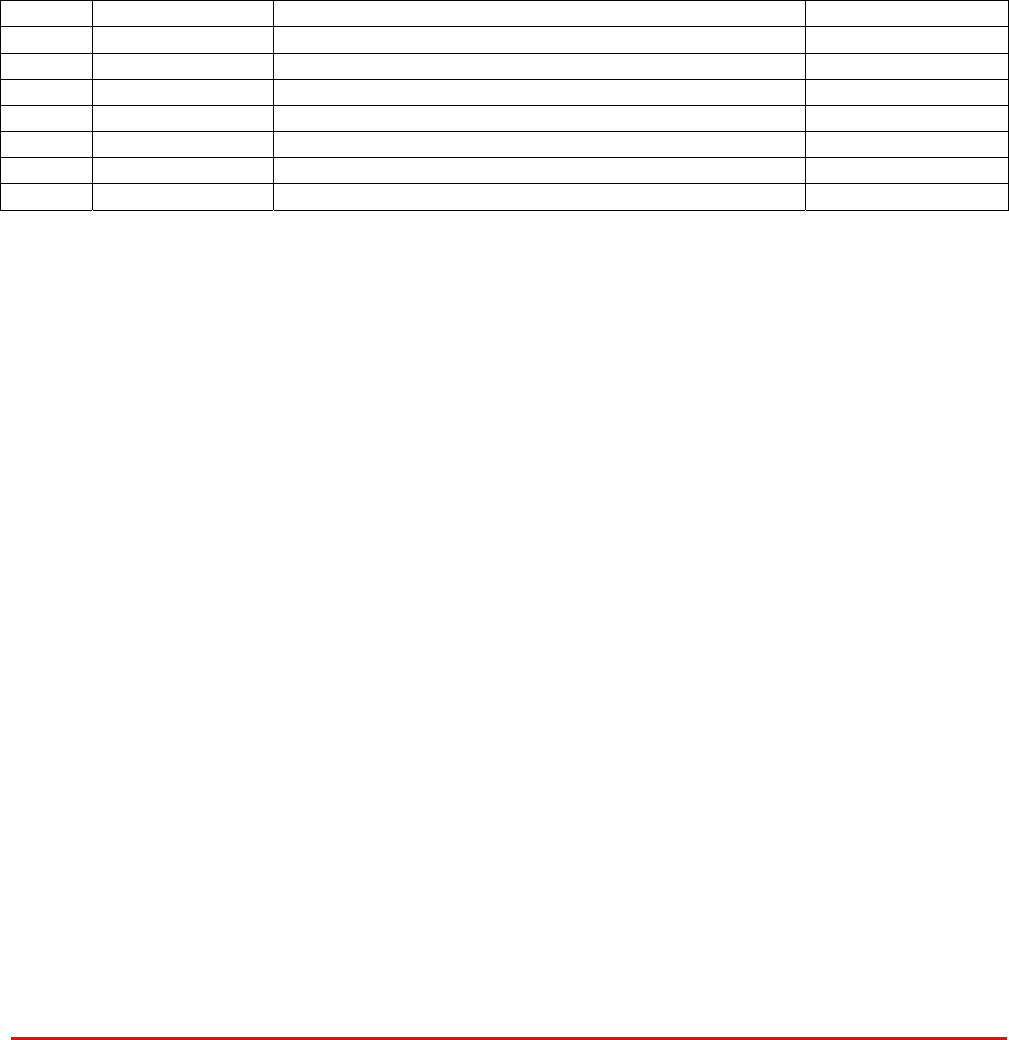
STTRS DOCUMENTATION
Document Number 80-330501HBKM – Issue A - Draft Page 136 of 500
10. UNIVERSITY STATION MASTER SITE 1 (80-330552-1)
Rack C05-CR-06
55-165601
55-165602
55-165502
98-800001
98-700002
55-165507
55-165601
55-165602
55-165711
University Station Master Site 1 (80-330552-1) list of major components
section Component Part Component Part Description Qty. Per Assembly
10.4.1. 55-165502 800MHz FO HUB Splitter/Combiner 1
10.4.2. 55-165507 Fibre Optic Splitter 1
10.4.3. 55-165601 800MHz FO Hub Amplifier + Filters 2
10.4.4. 55-165602 700MHz FO Hub Amplifier 2
10.4.5. 55-165711 UNIVERSITY ST. SPLITTER 1 1
10.4.6. 98-700002 Optical A/B Switch FC/APC 1
10.4.7. 98-800001 F/O Link Subsystem 1
800MHz FO Hub Amplifier (55-165601)
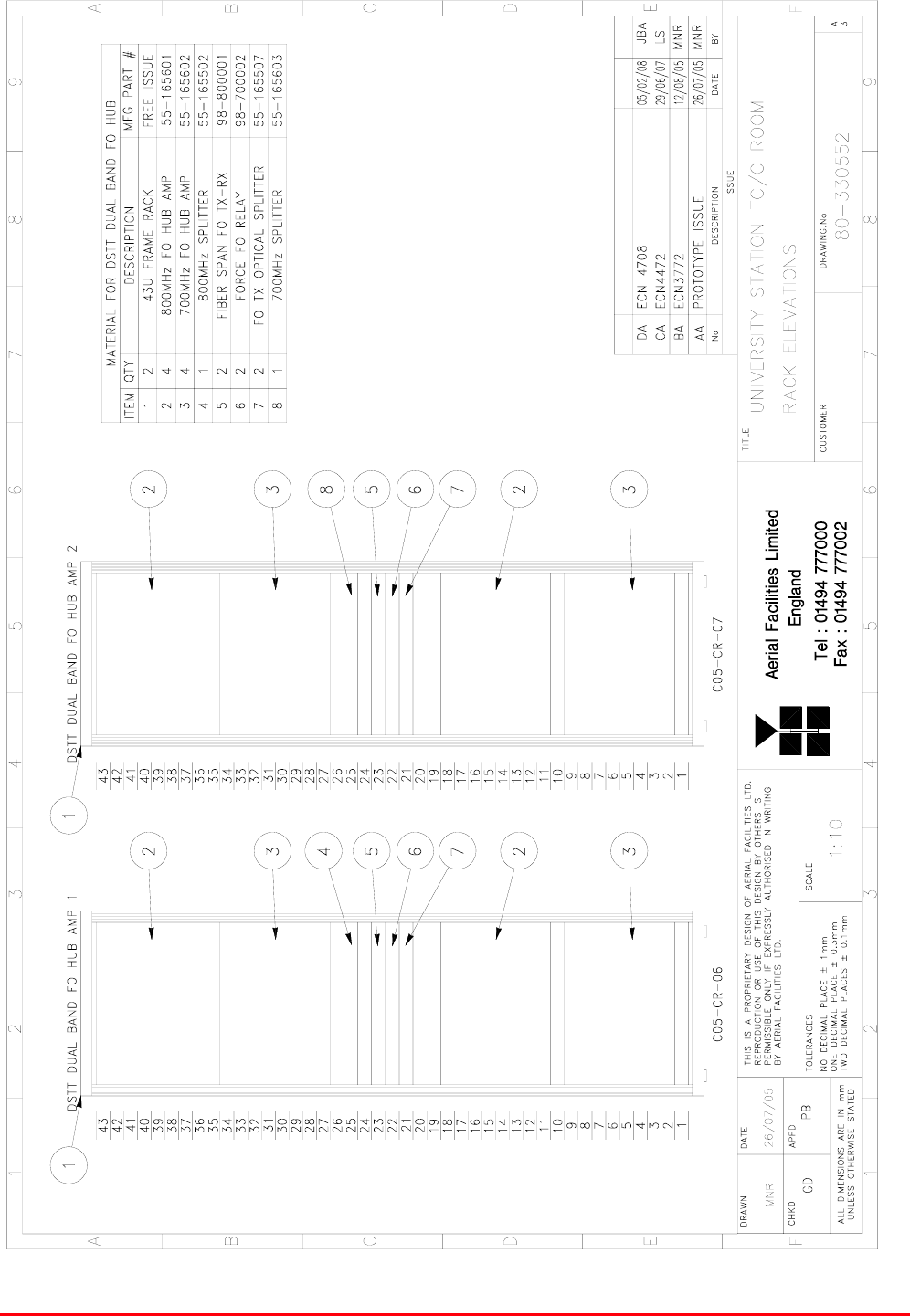
STTRS DOCUMENTATION
Document Number 80-330501HBKM – Issue A - Draft Page 137 of 500
10.1. University Station Master Site 1 (80-330552-1) Rack elevation
Drawing number 80-330552
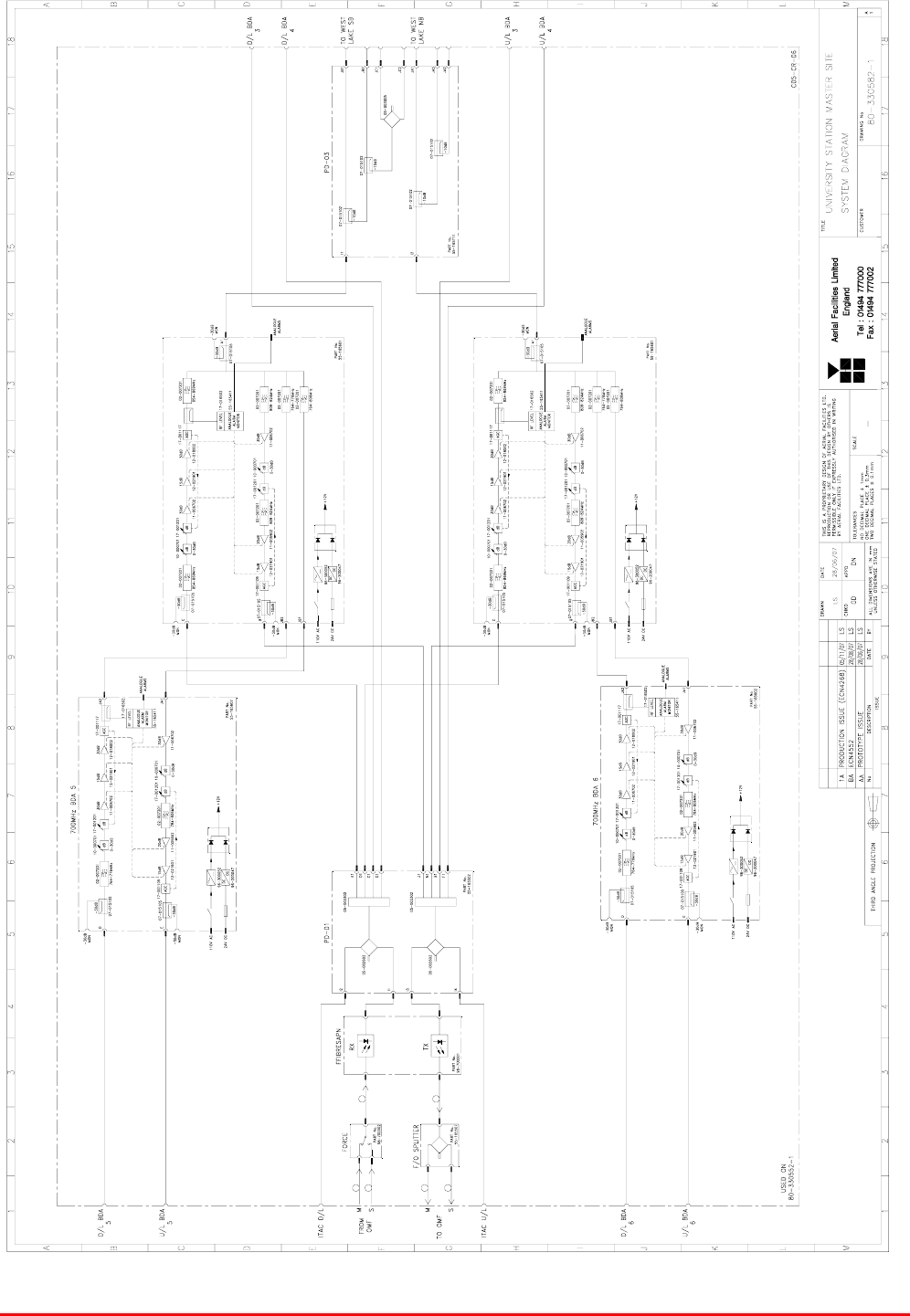
STTRS DOCUMENTATION
Document Number 80-330501HBKM – Issue A - Draft Page 138 of 500
10.2. University Station Master Site 1 (80-330552-1) system diagram
Drawing number 80-330582-1
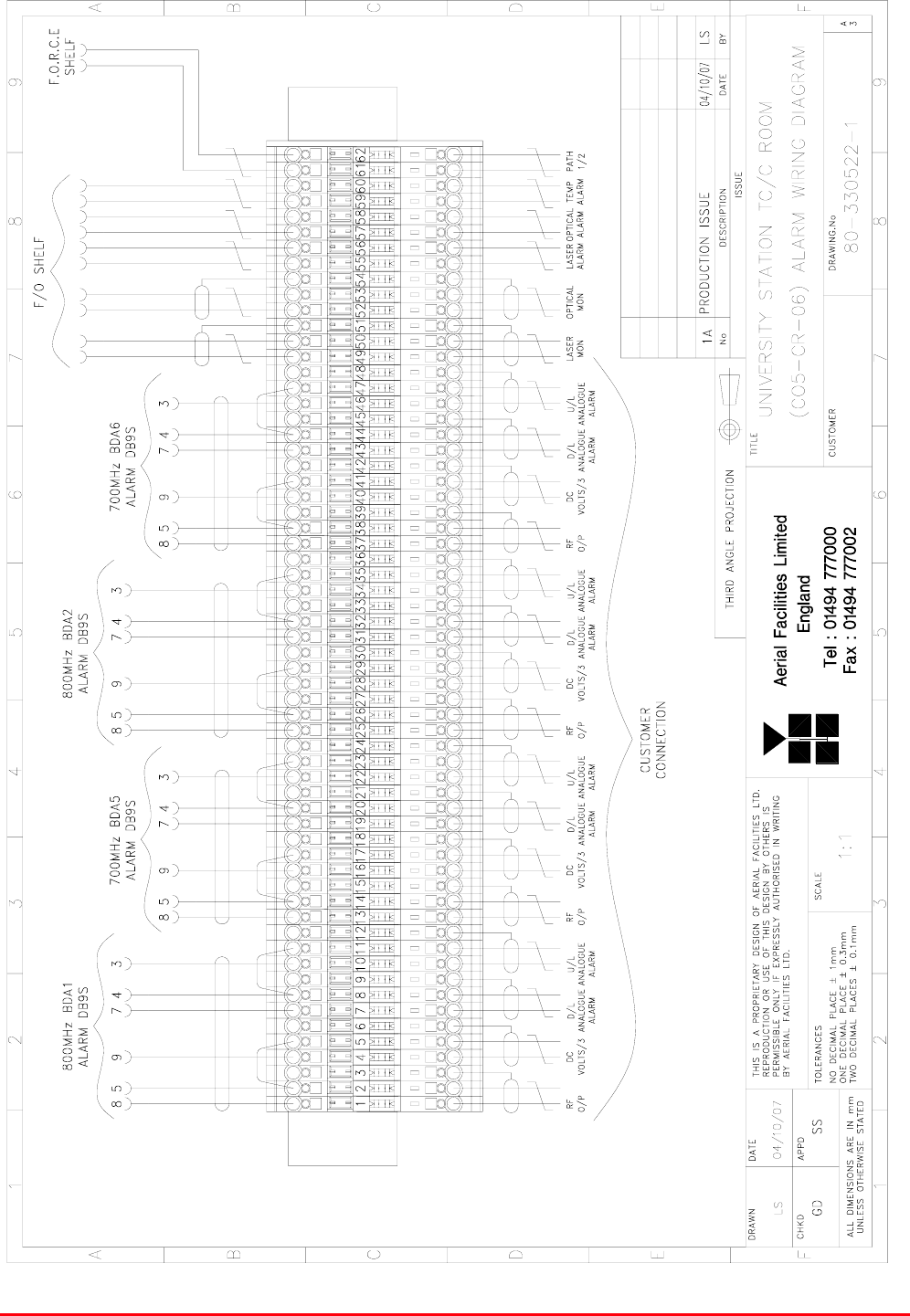
STTRS DOCUMENTATION
Document Number 80-330501HBKM – Issue A - Draft Page 139 of 500
10.3. University Station Master Site 1 (80-330552-1) Alarm Wiring Diagram
Drawing number 80-330522-1

STTRS DOCUMENTATION
Document Number 80-330501HBKM – Issue A - Draft Page 140 of 500
10.4 University Station Master Site 1 (80-330552-1) Major Components
10.4.1. 800MHz FO HUB Splitter/Combiner (55-165502)
800MHz FO HUB SPLITTER/COMB (55-165502) List of major components
section Component
Part Component Part Description Qty. Per
Assembly
10.4.1.3. 05-002602 900MHZ SPLITTER/COMBINER, 20W 2
10.4.1.4. 05-003302 Four Way Splitter/Combiner 2
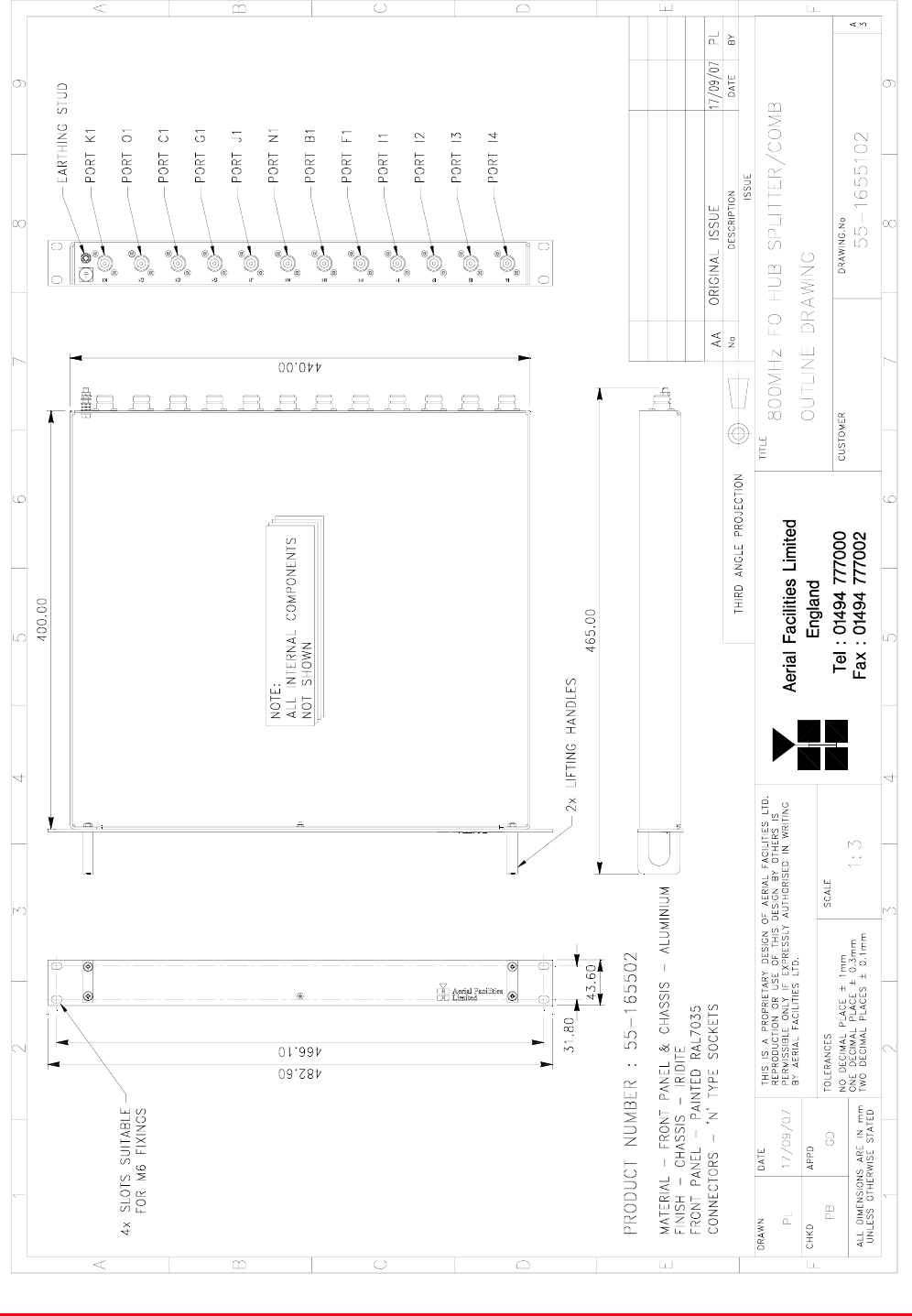
STTRS DOCUMENTATION
Document Number 80-330501HBKM – Issue A - Draft Page 141 of 500
10.4.1.1. 800MHz FO HUB SPLITTER/COMB (55-165502) Outline Drawing
Drawing number 55-1655102
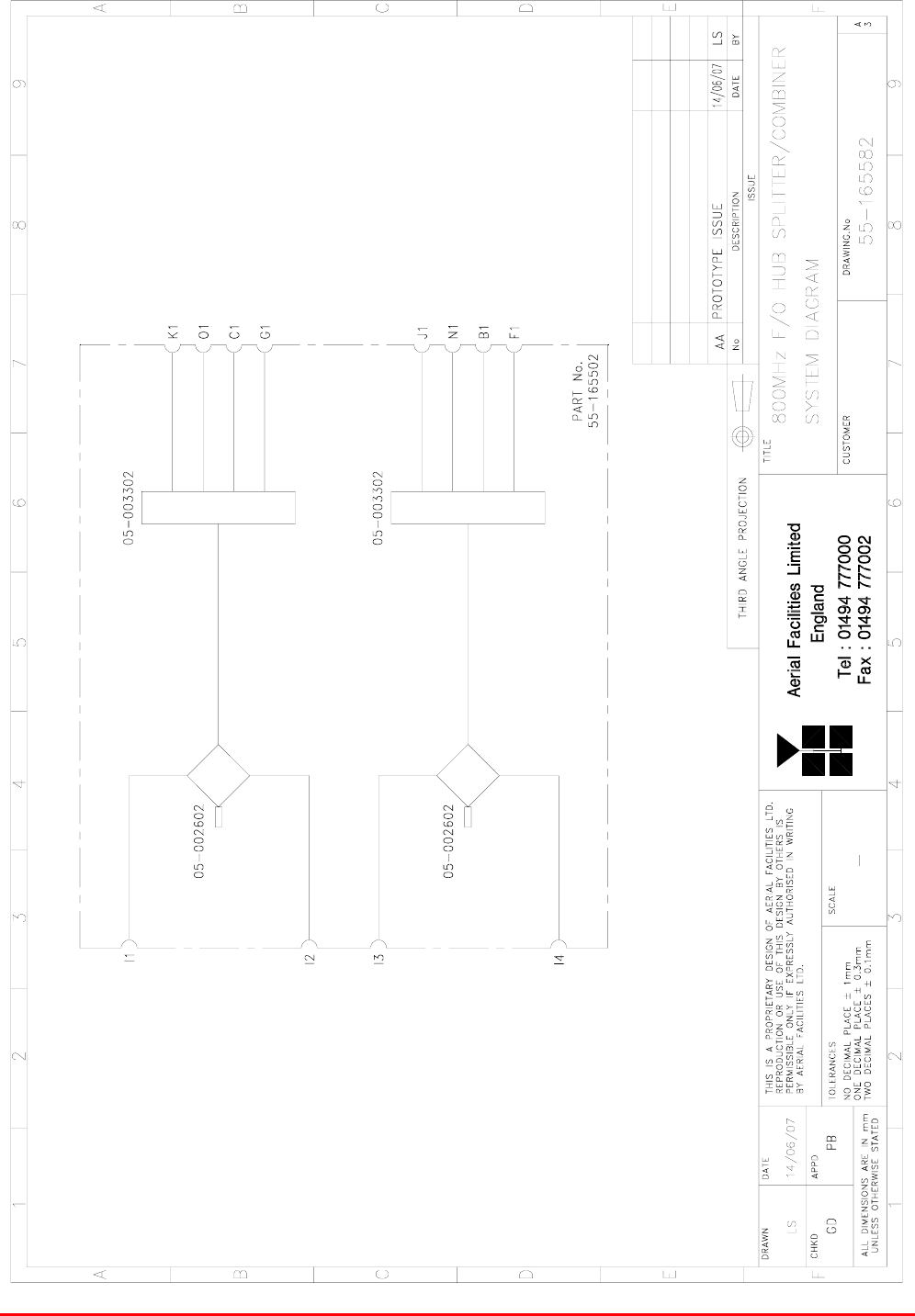
STTRS DOCUMENTATION
Document Number 80-330501HBKM – Issue A - Draft Page 142 of 500
10.4.1.2. 800MHz FO HUB SPLITTER/COMB (55-165502) System Diagram
Drawing number 55-165582
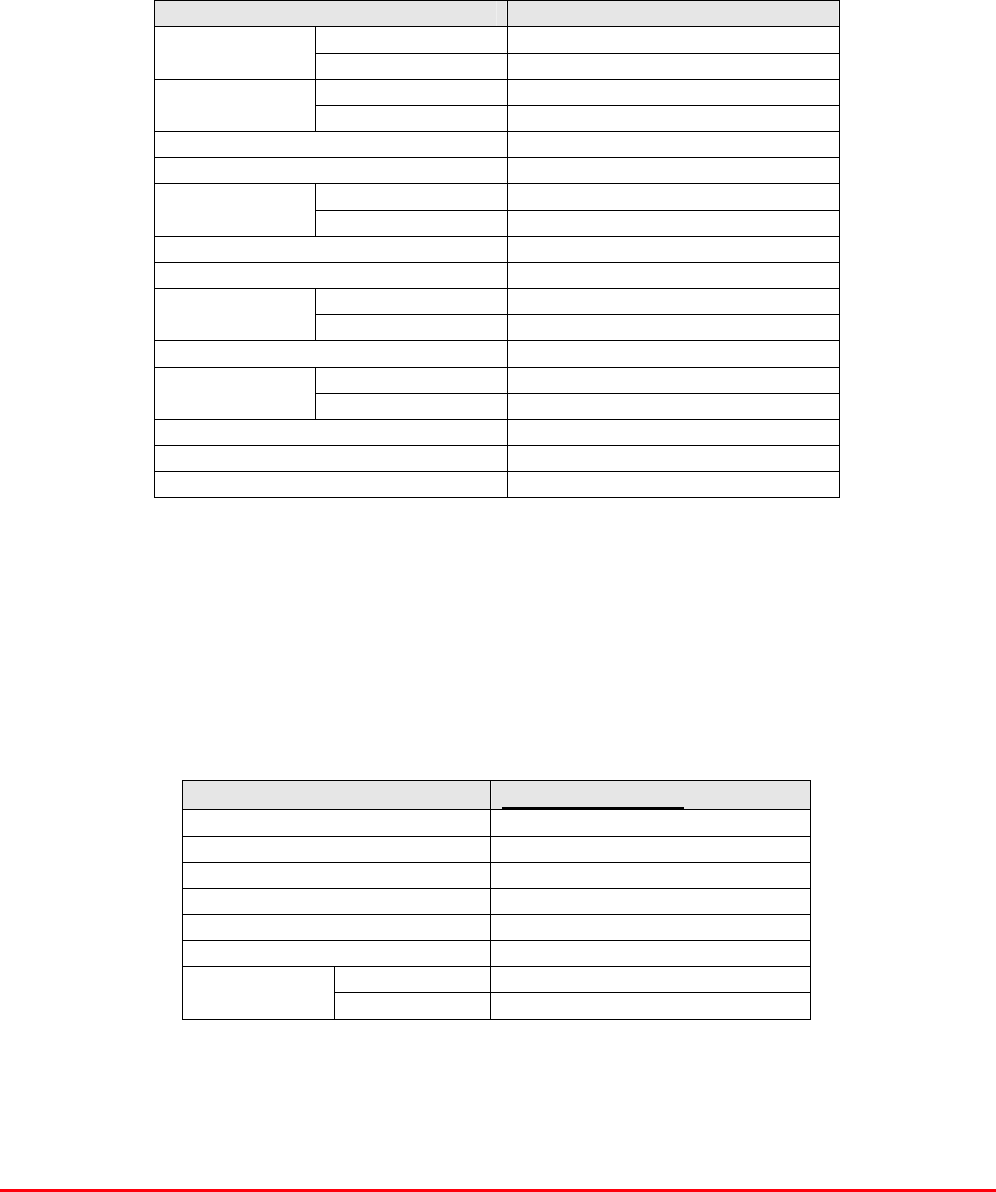
STTRS DOCUMENTATION
Document Number 80-330501HBKM – Issue A - Draft Page 143 of 500
10.4.1.3. 900MHz Splitter/Combiner (05-002602)
The Splitter/Combiner used is a device for accurately matching two or more RF signals to single or
multiple ports, whilst maintaining an accurate 50Ω load to all inputs/outputs and ensuring that the
VSWR and insertion losses are kept to a minimum. Any unused ports should be terminated with an
appropriate 50Ω load.
Being passive devices, the splitters should have an extremely long operational life and require no
maintenance. Should a unit be suspect, it is usually most time efficient to replace the whole module
rather than attempt repair or re-tuning.
05-002602 Specification
PARAMETER SPECIFICATION
Narrowband: 815 – 960MHz Frequency
range: Broadband: 800 – 1200MHz
Narrowband: 145MHz
Bandwidth: Broadband: 400MHz
Input ports: 1
Output ports: 2
Narrowband: 3.3dB
Insertion loss: Broadband: 3.5dB
Return loss input & output: 1.3:1
Impedance: 50Ω
Narrowband: >20dB
Isolation: Broadband: >18dB
MTFB: >180,000 hours
Splitting: 20Watts
Power rating: Combining: 0.5Watt
Connectors: SMA female
Weight: 200g (approximately)
Size: 54 x 44 x 21mm
10.4.1.4. Four Way Splitter/Combiner (05-003302)
The Splitter/Combiner used is a device for accurately matching two or more RF signals to single or
multiple ports, whilst maintaining an accurate 50Ω load to all inputs/outputs and ensuring that the
VSWR and insertion losses are kept to a minimum. Any unused ports should be terminated with an
appropriate 50Ω load.
Four Way Splitter (05-003302) Specification
PARAMETER SPECIFICATION
Frequency range 700-980MHz
Bandwidth 180MHz
Rejection >14dB
Insertion loss <7.0dB (in band)
Connectors N type, female
Weight <1.5kg
operational -20%C to +60%C Temperature
range storage -40%C to +70%C
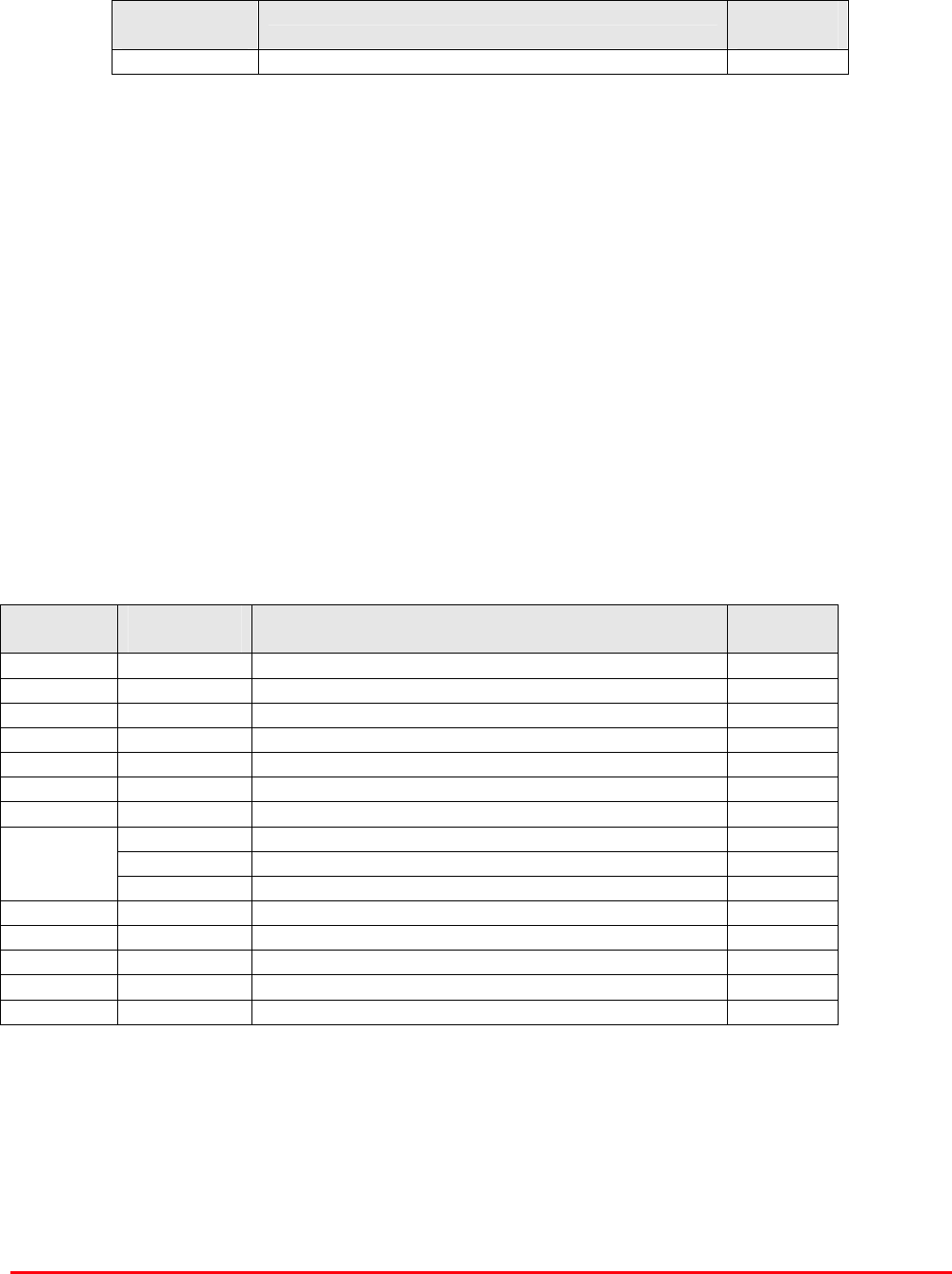
STTRS DOCUMENTATION
Document Number 80-330501HBKM – Issue A - Draft Page 144 of 500
10.4.2. Fibre Optic Splitter (55-165507)
Fibre Optic Splitter (55-165507) is a 1U rack mount tray containing an optical splitter/coupler
Fibre Optic Splitter (55-165507) List of Major Sub Components
Component
Part Component Part Description Qty. Per
Assembly
98-100001 Single Mode Optical Splitter/Coupler 1
10.4.2.1. Single Mode Optical Splitter/Coupler (98-100001)
Single Mode Optical Splitter/Couplers are used whenever it is necessary to split or combine outputs
from optical transmitters or inputs to receivers. Operators should be aware that a small insertion loss
(typically 3-4dB) is common with these type of couplers.
Single Mode Optical Splitter/Coupler (98-100001) It is an O.E.M unit featuring almost negligible
insertion loss to the F/O signal. Extreme caution should be exercised when handling these devices.
Special attention should be shown to the connectors; repair of a broken Splitter/Coupler is not
possible; replacement is the only option.
In the Fibre Optic Splitter (55-165507) in University Station Master Site 1 (80-330552-1), Single Mode
Optical Splitter/Coupler (98-100001) is used to split the optical signal from the FO TX module in F/O
Link Subsystem (98-700001) into two equal paths.
10.4.3. 800MHz FO Hub Amplifier + Filters (55-165601)
Section Component
Part Component Part Description Qty. Per
Assembly
10.4.3.3. 02-007206 900MHZ 8POLE 25MHz+ B/W "SMA" 6
10.4.3.4. 07-015105 ASYMMETRIC CPLR 30dB 800-2500MHz GA 3
10.4.3.5. 10-000701 SW ATT 0-30dB 0.25W SMA F 2
10.4.3.6. 11-005902K 900MHz LOW NOISE AMP WITH RELAY KIT 1
10.4.3.7. 11-006702K 800-1000MHz LNA 29dB (cw RELAY) KIT 2
10.4.3.8. 12-018002K PA 800-960MHz 20W CLASS A KIT 1
10.4.3.9. 12-021901 Low Power Amplifier 2
17-001109* AGC Detector Assembly (Logarithmic) 1
17-001117* AGC Detector Assembly 1
10.4.3.10.
17-001201* AGC Attenuator Assembly 2
10.4.3.11. 20-001601 12V RELAY BOARD 1
10.4.3.12. 80-008901 12V RELAY PCB ASSEMBLY 1
10.4.3.13. 94-100004 STPS12045TV 60A DUAL DIODE 1
10.4.3.14. 96-200047 DC/DC Converter 1
10.4.3.15. 96-300052 JWS150-12/A PSU (COUTANT LAMBDA) 1
*The sub components 17-001109, 17-001117 & 17-001201 are parts of the Automatic Gain Control
(AGC) system used in 800MHz FO Hub Amplifier + Filters (55-165601); 17-001117 and 17-001201
are paired for use in the uplink and 17-001109 and 17-001201 are paired for use in the down link
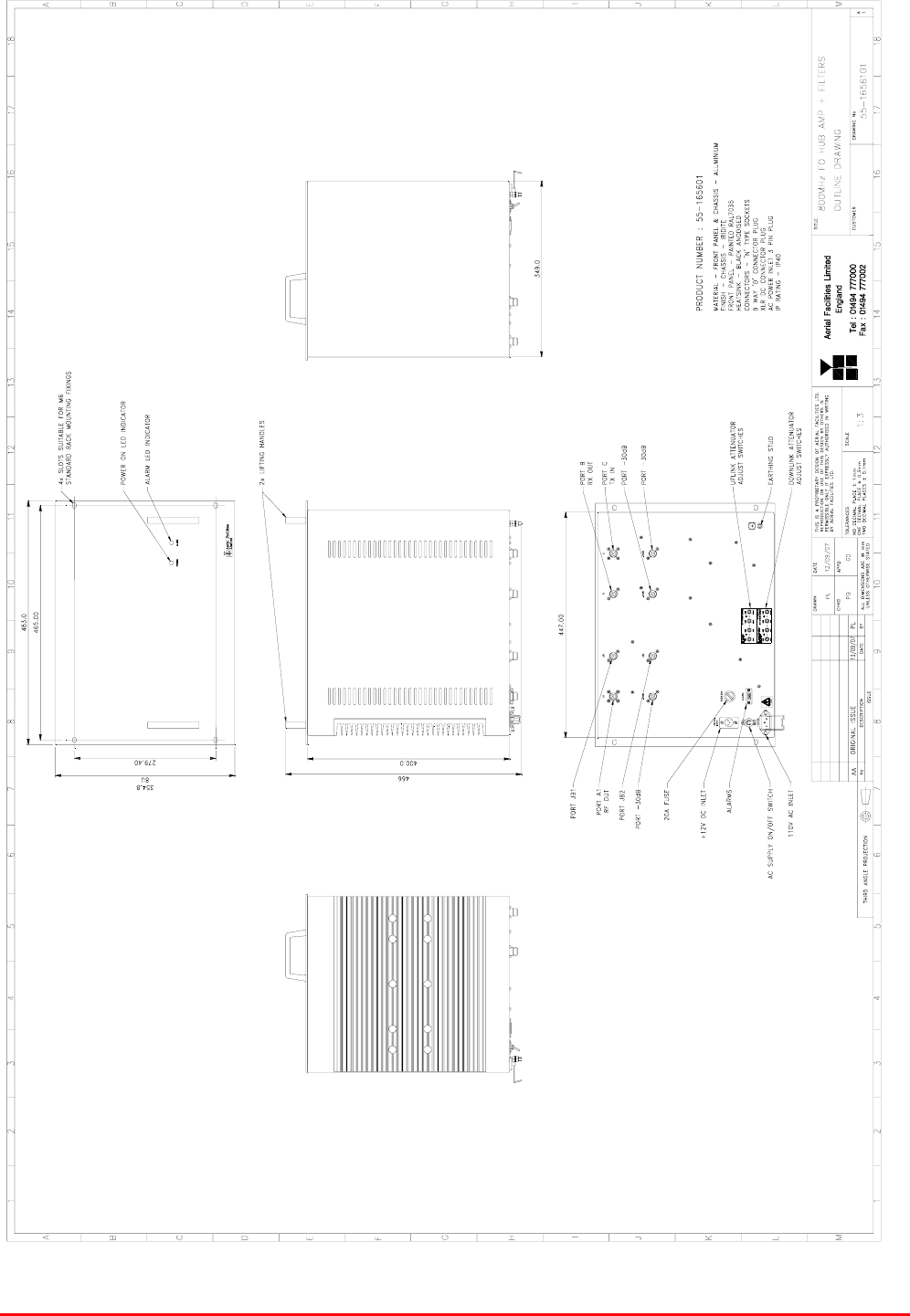
STTRS DOCUMENTATION
Document Number 80-330501HBKM – Issue A - Draft Page 145 of 500
10.4.3.1. 800MHz FO Hub Amplifier + Filters (55-165601) outline drawing
drawing number 55-1656101
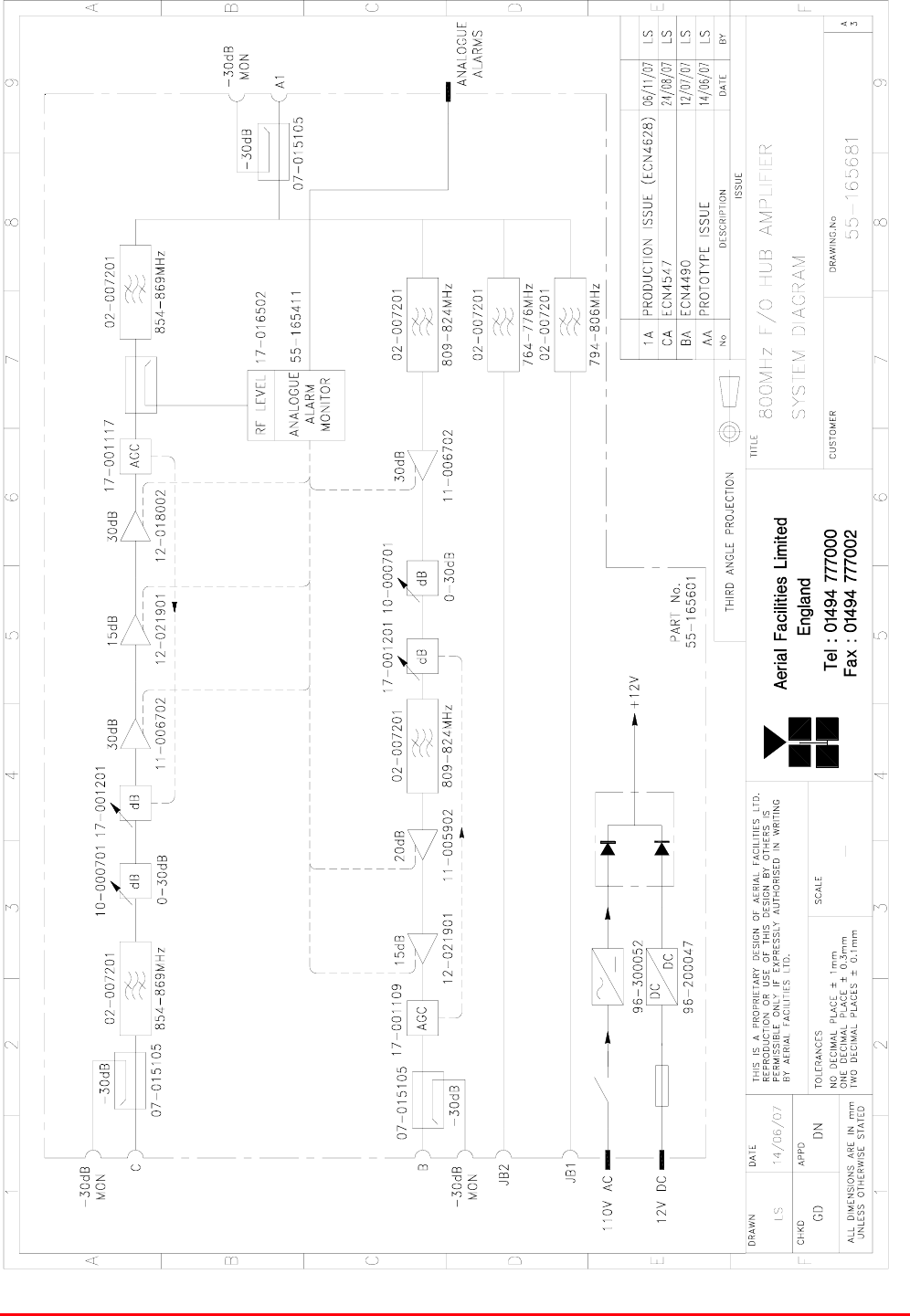
STTRS DOCUMENTATION
Document Number 80-330501HBKM – Issue A - Draft Page 146 of 500
10.4.3.2. 800MHz FO Hub Amplifier + Filters (55-165601) system diagram
drawing number 55-165681

STTRS DOCUMENTATION
Document Number 80-330501HBKM – Issue A - Draft Page 147 of 500
10.4.3.3. Bandpass Filter (02-007206)
The bandpass filters are multi-section designs with a bandwidth dependent upon the passband
frequencies, (both tuned to customer requirements). The response shape is basically Chebyshev with
a passband design ripple of 0.1dB. The filters are of slot coupled, folded combline design, and are
carefully aligned during manufacture in order to optimise the insertion loss, VSWR and
intermodulation characteristics of the unit. The tuned elements are silver-plated to reduce surface
ohmic losses and maintain a good VSWR figure and 50Ω load at the input and output ports.
Being passive devices, the bandpass filters should have an extremely long operational life and require
no maintenance. Should a filter be suspect, it is usually most time efficient to replace the module
rather than attempt repair or re-tuning.
No adjustments should be attempted without full network sweep analysis facilities to monitor both
insertion loss and VSWR simultaneously.
02-007206 Specification
PARAMETER SPECIFICATION
Response type Chebyshev
Frequency range 800 - 950MHz *
Bandwidth 25MHz *
Number of sections 8
Insertion loss 1.2 dB
VSWR better than 1.2:1
Connectors SMA female
Power handling 100W max
operation -20°C to +60°C Temperature
range storage -40°C to +70°C
Weight 3 kg (typical) *tuned to Customer's specification
10.4.3.4. Wideband Asymmetric Coupler (07-015105)
The purpose of Wideband Asymmetric Coupler (07-015105) is to tap off a known portion (in this case
30dB) of RF signal from transmission lines and to combine them, for example through splitter units for
different purposes (alarms/monitoring etc.), whilst maintaining an accurate 50Ω load to all
ports/interfaces throughout the specified frequency range. They are known formally as directional
couplers as they couple power from the RF mainline in one direction only.
07-015105 Specification
PARAMETER SPECIFICATION
Construction Inductive air gap
Frequency 800-2500MHz
Through loss 0.4dB (typical)
Coupling level -30dB ±0.5dB
Isolation N/A
Weight <1.0kg
Connectors SMA, female
operation -20°C to +60°C
Temperature
range storage -40°C to +70°C
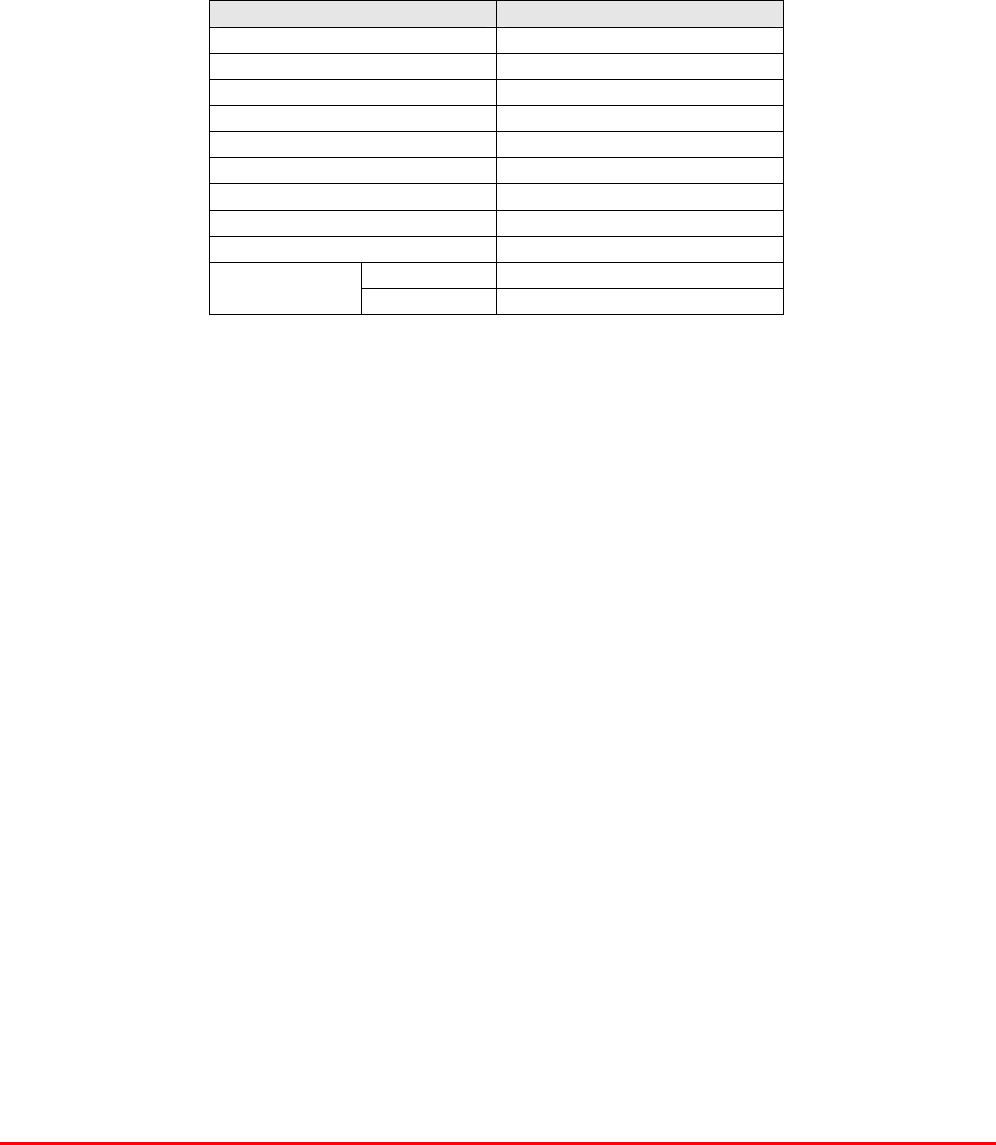
STTRS DOCUMENTATION
Document Number 80-330501HBKM – Issue A - Draft Page 148 of 500
10.4.3.5. Switched Attenuator 0.25Watt, 0 - 30dB (10-000701)
In many practical applications for Cell Enhancers etc., the gain in each path is found to be excessive.
Therefore, provision is made within the unit for the setting of attenuation in each path, to reduce the
gain.
Switched Attenuator 10-000701 provides attenuation from 0 to 30dB in 2 dB steps The attenuation is
simply set using the four miniature toggle switches on the top of each unit. Each switch is clearly
marked with the attenuation it provides, and the total attenuation in line is the sum of the values
switched in. They are designed to maintain an accurate 50Ω impedance over their operating
frequency at both input and output.
10-000701 Specification
PARAMETER SPECIFICATION
Attenuation Values 0-30dB
Attenuation Steps 2, 4, 8 and 16dB
Power Handling 0.25 Watt
Attenuation Accuracy ± 1.0 dB
Frequency Range DC to 1GHz
Impedance 50Ω
Connectors SMA
VSWR 1.3:1
Weight 0.2kg
operation -20°C to +60°C Temperature
range storage -40°C to +70°C
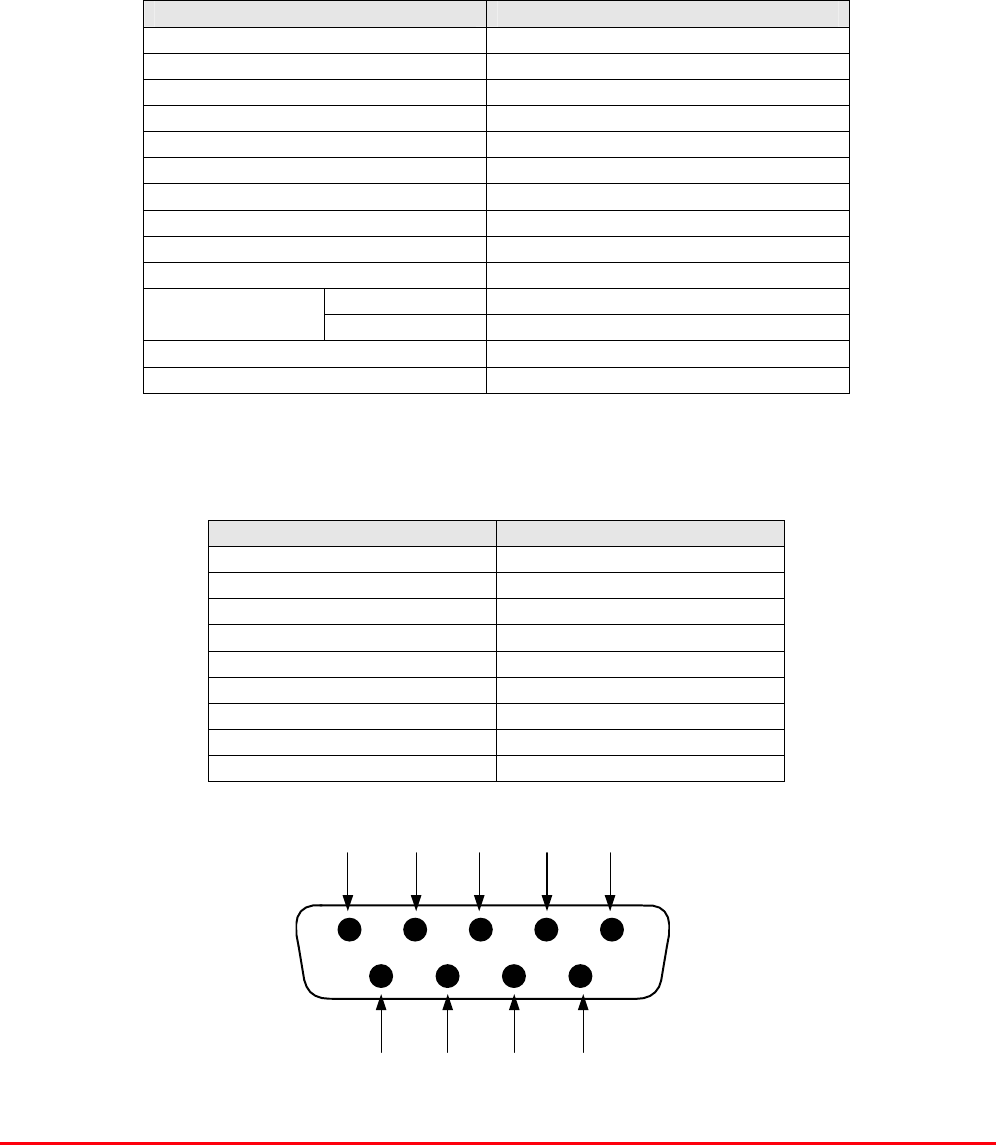
STTRS DOCUMENTATION
Document Number 80-330501HBKM – Issue A - Draft Page 149 of 500
10.4.3.6. Low Noise Amplifier (11-005902)
The Gallium-Arsenide low noise amplifier used in the unit is a double stage, solid-state low noise
amplifier. Class A circuitry is used throughout the units to ensure excellent linearity and extremely low
noise over a very wide dynamic range. The active devices are very moderately rated to provide a long
trouble-free working life. There are no adjustments on these amplifiers, and in the unlikely event of a
failure, then the complete amplifier should be replaced. This amplifier features its own in-built alarm
system which gives a volt-free relay contact type alarm that is easily integrated into any alarm system.
There is a Current Fault Alarm Function, which indicates failure of each one or both RF transistors by
a various alarm output options. The amplifier is housed in an aluminium case (Iridite NCP finish) with
SMA connectors for the RF input/output and a 9way D-type for DC and alarm outputs.
11-005902 Specification
PARAMETER SPECIFICATION
Frequency range: 800 – 960MHz *
Bandwidth: <170MHz
Gain: 19.5dB (typical)
1dB compression point: 21dBm
OIP3: 33dBm
Input/output return loss: >20dB
Noise figure: 1dB (typical)
Power consumption: 190mA @ 24V DC
Supply voltage: 10-24V DC
Connectors: SMA female
operational: -10°C to +60°C Temperature
range storage: -40°C to +70°C
Size: 90 x 55 x 30.2mm
Weight: 0.28kg *tuned to Customer's specification
LNA ‘D’ Connector Pin-out details
Connector pin Signal
1 +Ve input (10-24V)
2 GND
3 Alarm relay O/P bad
4 Alarm relay common
5 Alarm relay good
6 No connection
7 TTL voltage set
8 TTL alarm/0V (good)
9 O/C good/0V bad
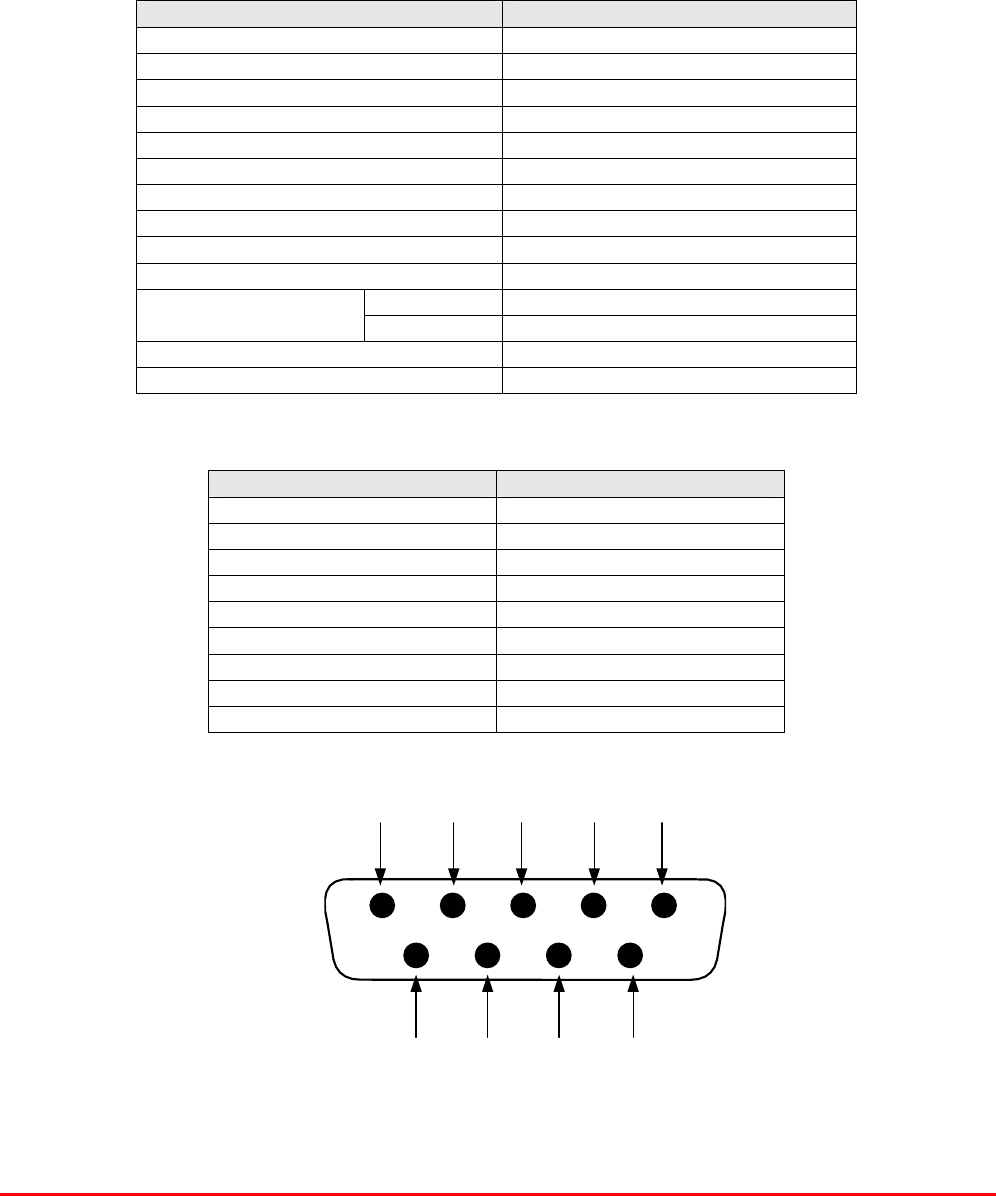
STTRS DOCUMENTATION
Document Number 80-330501HBKM – Issue A - Draft Page 150 of 500
7 8 96
1 2 3 4 5
9-Way Pin-Out Graphical Representation
10.4.3.7. Low Noise Amplifier (11-006702)
The Gallium-Arsenide low noise amplifiers used in 800MHz Line Amplifier (55-165703) are double
stage, solid-state low noise amplifiers. Class A circuitry is used throughout the units to ensure
excellent linearity and extremely low noise over a very wide dynamic range. The active devices are
very moderately rated to provide a long trouble-free working life. There are no adjustments on these
amplifiers, and in the unlikely event of a failure, then the complete amplifier should be replaced. This
amplifier features its own in-built alarm system which gives a volt-free relay contact type alarm that is
easily integrated into the main alarm system.
11-006702 Specification
PARAMETER SPECIFICATION
Frequency range: 800 – 1000MHz
Bandwidth: <200MHz
Gain: 29dB (typical)
1dB Compression point: 20dBm
OIP3: 33dBm
Input/Output return loss: >18dB
Noise figure: 1.3dB (typical)
Power consumption: 180mA @ 24V DC
Supply voltage: 10-24V DC
Connectors: SMA female
operational: -10°C to +60°C
Temperature range: storage: -20°C to +70°C
Size: 90 x 55 x 30.2mm
Weight: 290gms (approximately)
Low Noise Amplifier (11-006702) ‘D’ Connector Pin-out details
Connector pin Signal
1 +Ve input (10-24V)
2 GND
3 Alarm RelayO/P bad
4 Alarm Relay common
5 Alarm Relay good
6 No connection
7 TTL voltage set
8 TTL alarm/0V (good)
9 O/C good/0V bad
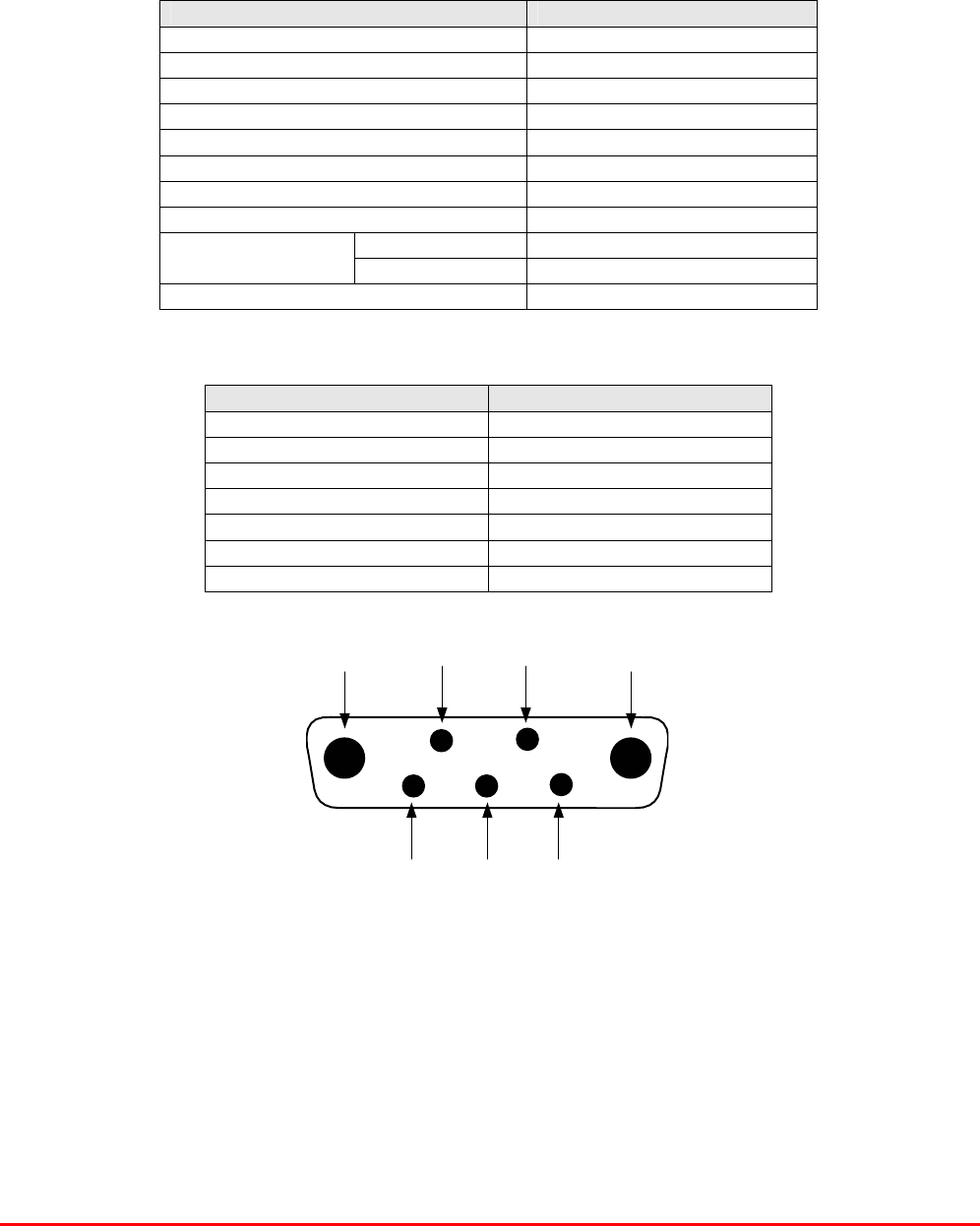
STTRS DOCUMENTATION
Document Number 80-330501HBKM – Issue A - Draft Page 151 of 500
10.4.3.8. Power Amplifier (12-018002)
This amplifier is a Class A 20W power amplifier from 800-960MHz in a 1 stage balanced
configuration. It demonstrates a very high linearity and a very good input/output return loss (RL). It
has built in a Current Fault Alarm Function.
Its housing is an aluminium case (Iridite NCP finish) with SMA connectors for the RF input/output and
a D-Type connector for the power supply and the Current Fault Alarm Function.
12-018002 Specification
PARAMETER SPECIFICATION
Frequency range: 800-960MHz
Small signal gain: 30dB
Gain flatness: ±1.2dB
I/O Return loss: >18dB
1dB compression point: 42.8dBm
OIP3: 56dBm
Supply voltage: 24V DC
Supply current: 5.0Amps (Typical)
operational: -10°C to +60°C Temperature
range storage: -20°C to +70°C
Weight: <2kg (no heatsink)
Power Amplifier (12-018002) 7-Way Connector Pin-outs
Connector Pin Signal
A1 (large pin) +24V DC
A2 (large pin) GND
1 Alarm relay common
2 TTL alarm/0V good
3 Alarm relay contact (bad)
4 Alarm relay contact (good)
5 O/C good/0V bad (TTL)
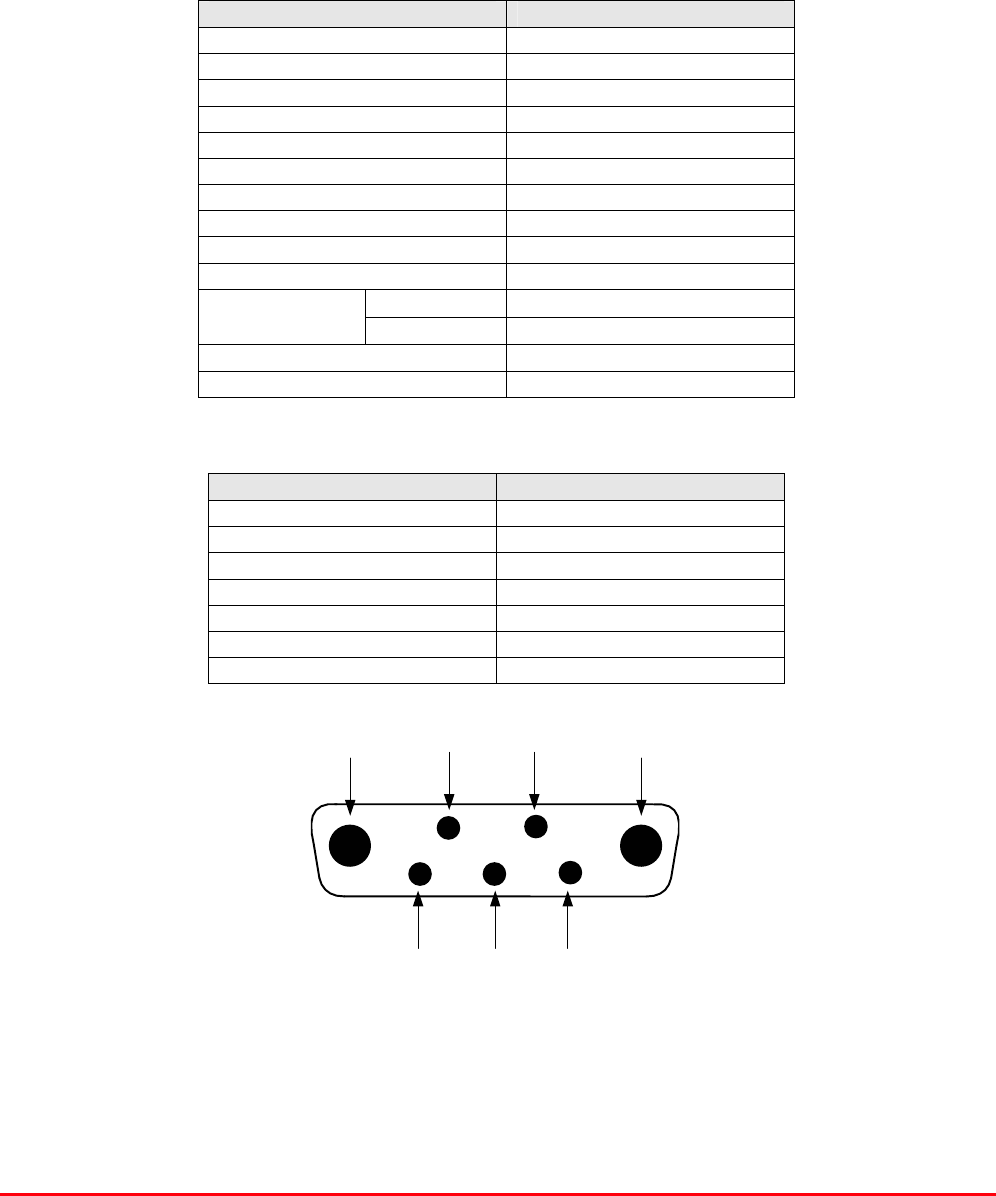
STTRS DOCUMENTATION
Document Number 80-330501HBKM – Issue A - Draft Page 152 of 500
10.4.3.9. Low Power Amplifier (12-021901)
The low power amplifier used is a triple stage solid-state low-noise amplifier. Class A circuitry is used
in the unit to ensure excellent linearity over a very wide dynamic range. The three active devices are
very moderately rated to provide a long trouble-free working life.
Its housing is an aluminium case (Iridite NCP finish) with SMA connectors for the RF input/output and
a D-Type connector for the power supply and the Current Fault Alarm Function.
There are no adjustments on this amplifier, and in the unlikely event of failure then the entire amplifier
should be replaced.
Low Power Amplifier (12-021901) Specification
PARAMETER SPECIFICATION
Frequency range 800-960MHz*
Bandwidth 20MHz *
Maximum RF output >1.0 Watt
Gain 15dB
1dB compression point +30.5dBm
3rd order intercept point +43dBm
Noise Figure <6dB
VSWR better than 1.5:1
Connectors SMA female
Supply 500mA @ 10-15V DC
operational -10°C to +60°C
Temperature
range storage -20°C to +70°C
Weight 0.5 kg
Size 167x52x25mm
* Tuned to Customer’s specification
Low Power Amplifier (12-021901) 7-Way Connector Pin-outs
Connector Pin Signal
A1 (large pin) +24V DC
A2 (large pin) GND
1 Alarm relay common
2 TTL alarm/0V good
3 Alarm relay contact (bad)
4 Alarm relay contact (good)
5 O/C good/0V bad (TTL)

STTRS DOCUMENTATION
Document Number 80-330501HBKM – Issue A - Draft Page 153 of 500
10.4.3.10. Automatic Gain Control
17-001109 AGC Detector Assembly (Logarithmic)
17-001117 AGC Detector Assembly
17-001201 AGC Attenuator Assembly
The sub components 17-001109, 17-001117 & 17-001201 are parts of the Automatic Gain Control
(AGC) system used in 800MHz FO Hub Amplifier + Filters (55-165601); 17-001117 and 17-001201
are paired for use in the uplink and 17-001109 and 17-001201 are paired for use in the down link
800MHz FO Hub Amplifier + Filters (55-165601) is fitted with two differing types of Automatic Gain
Control (AGC) system, one linear, and one logarithmic. The AGC with logarithmic detector (17-
001117) is fitted in the uplink path and the AGC with linear detector (17-001109) is fitted in the
downlink path
The AFL Automatic Gain Control system consists of two units, a detector/amplifier and an attenuator.
The detector/amplifier unit is inserted in the RF path on the output of the power amplifier, and the
attenuator is situated in the RF path between the 1st and 2nd stages of amplification.
17-001117 and 17-001201 are paired for use in the uplink and 17-001109 and 17-001201 are paired
for use in the down link
The attenuator comprises a 50Ω P.I.N diode, voltage-variable attenuator with a range of 3 to 30dB.
The attenuation is controlled by a DC voltage which is derived from the associated detector controller
board.
Normally the attenuator is at minimum attenuation. The detector/amplifier unit monitors the RF level
being delivered by the power amplifier, and when a certain threshold is reached it begins to increase
the value of the attenuator to limit the RF output to the (factory set) threshold. Therefore overloading
of the power amplifier is avoided.
The factory set threshold is 1dB below the Enhancer 1dB compression point. Some adjustment of this
AGC threshold level is possible, a 10dB range is mostly achieved. It is not recommended under any
circumstances to adjust the AGC threshold to a level greater than the 1dB compression point as
system degradation will occur.
The detector comprises of a 50Ω transmission line with a resistive tap which samples a small portion
of the mainline power. The sampled signal is amplified and fed to a conventional half wave diode
rectifier, the output of which is a DC voltage proportional to the RF input signal.
This DC voltage is passed via an inverting DC amplifier with integrating characteristics, to the output,
which drives the attenuation control line of the corresponding AGC attenuator. This unit is fitted at
some earlier point in the RF circuit.
For small signals, below AGC onset, the output control line will be close to 12V and the AGC
attenuator will have minimum attenuation. As the signal level increases the control line voltage will
fall, increasing the attenuator value and keeping the system output level at a constant value.
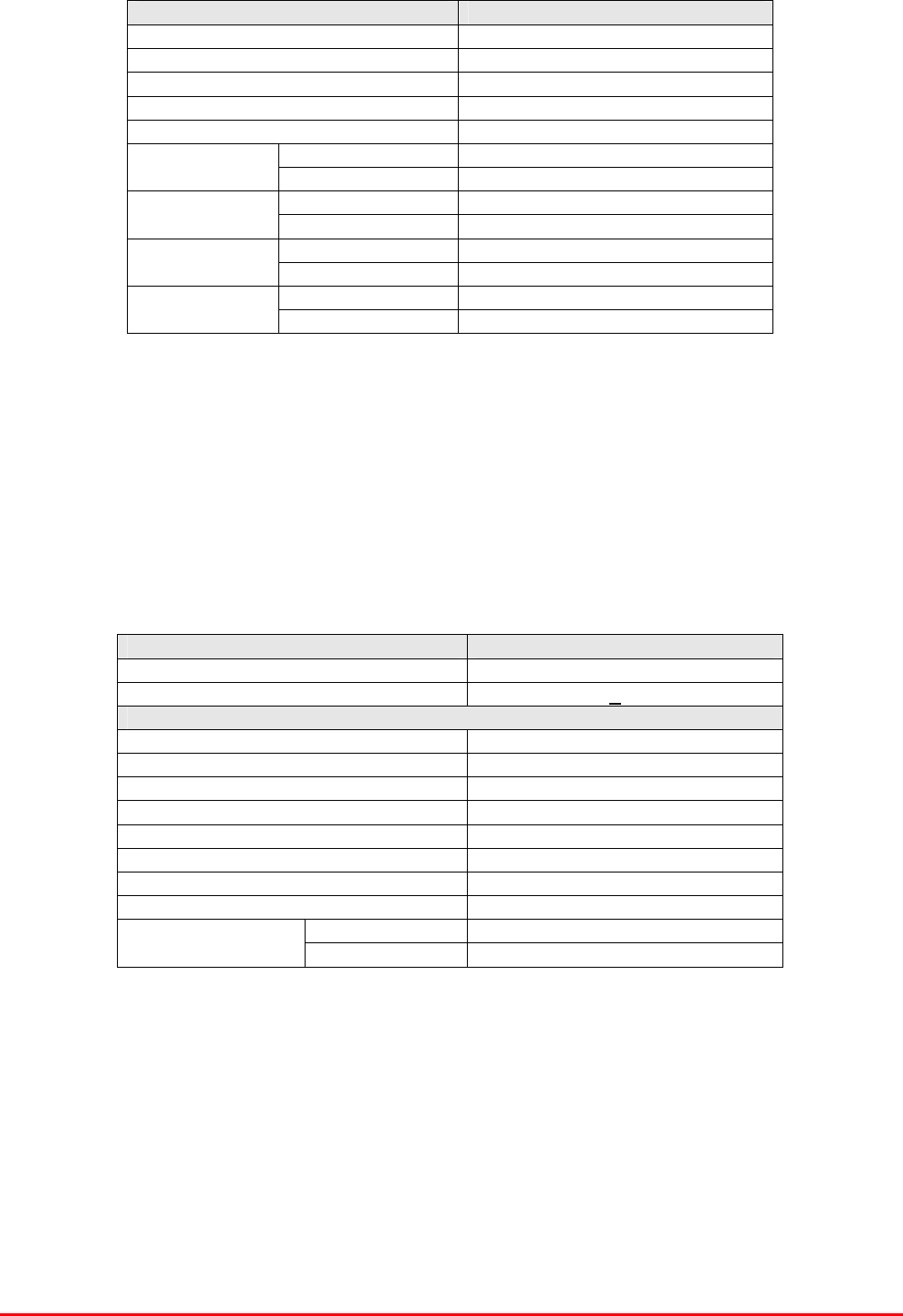
STTRS DOCUMENTATION
Document Number 80-330501HBKM – Issue A - Draft Page 154 of 500
AGC Specification (both types)
PARAMETER SPECIFICATION
Frequency range up to 1000MHz
Attenuation range 3 to 30dB
Attenuation steps continuously variable
VSWR better than 1.2:1
RF Connectors SMA female
attenuator 1W Power
handling detector/amp >30W (or as required)
operation -10°C to +60°C Temperature
range storage -20°C to +70°C
attenuator pcb 50 x 42 x 21mm
Size detector/amp pcb 54 x 42 x 21mm
attenuator 90grams
Weight detector/amp 100grams
10.4.3.11. 12V (Dual) Relay Board (20-001601)
The General Purpose Relay Board allows the inversion of signals and the isolation of circuits. It is
equipped with two dual pole change-over relays with completely isolated wiring, accessed via screw
terminals. Both relays are provided with polarity protection diodes and diodes for suppressing the
transients caused by "flywheel effect" which can destroy switching transistors or induce spikes on
neighbouring circuits. It’s common use is to amalgamate all the alarm signals into one, volts-free relay
contact pair for the main alarm system.
20-001601 Specification
PARAMETER SPECIFICATION
Operating voltage: 8 to 30V (floating earth)
Alarm threshold: Vcc - 1.20 volt +15%
Alarm output relay contacts:
Max. switch current: 1.0Amp
Max. switch volts: 120Vdc/60VA
Max. switch power: 24W/60VA
Min. switch load: 10.0µA/10.0mV
Relay isolation: 1.5kV
Mechanical life: >2x107 operations
Relay approval: BT type 56
Connector details: Screw terminals
operational: -10°C to +60°C Temperature
range storage: -20°C to +70°C
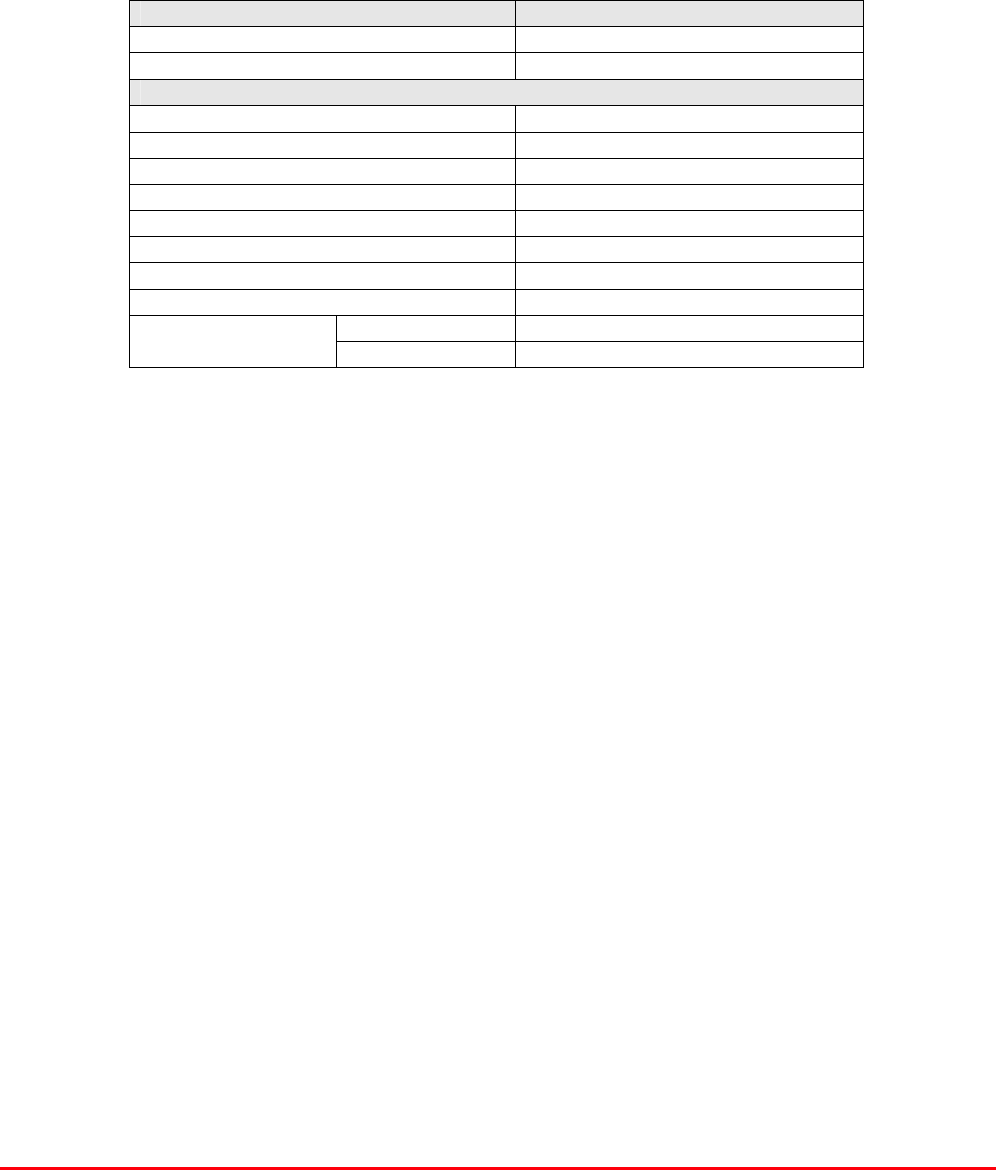
STTRS DOCUMENTATION
Document Number 80-330501HBKM – Issue A - Draft Page 155 of 500
10.4.3.12. 12V (Single) Relay Board (80-008901)
The General Purpose Relay Board allows the inversion of signals and the isolation of circuits. It is
equipped with a single dual pole change-over relay RL1, with completely isolated wiring, accessed
via a 15 way in-line connector.
The relay is provided with polarity protection diodes and diodes for suppressing the transients caused
by "flywheel effect" which can destroy switching transistors or induce spikes on neighbouring circuits.
It’s common use is to amalgamate all the alarm signals into one, volts-free relay contact pair for the
main alarm system.
80-008901 Specification
PARAMETER SPECIFICATION
Operating voltage 8 to 30V (floating earth)
Alarm threshold Vcc - 1.20 volt +15%
Alarm output relay contacts:
Max. switch current 1.0Amp
Max. switch volts 120Vdc/60VA
Max. switch power 24W/60VA
Min. switch load 10.0µA/10.0mV
Relay isolation 1.5kV
Mechanical life >2x107 operations
Relay approval BT type 56
Connector details Screw terminals
operational -10°C to +60°C Temperature
range storage -20°C to +70°C
10.4.3.13. Dual Diode Assembly (94-100004)
The purpose of these dual diode assemblies is to allow two DC voltage sources to be combined, so
that the main DC rail within the equipment can be sourced from either a mains driven PSU, or
externally through an XLR connector or from dual mains driven PSUs. They are very heavy-duty
diodes and they prevent any reverse current from flowing back to their source or the alternative
supply rail. Combining diodes such as these will also be used if the equipment is to be powered from
external back-up batteries.
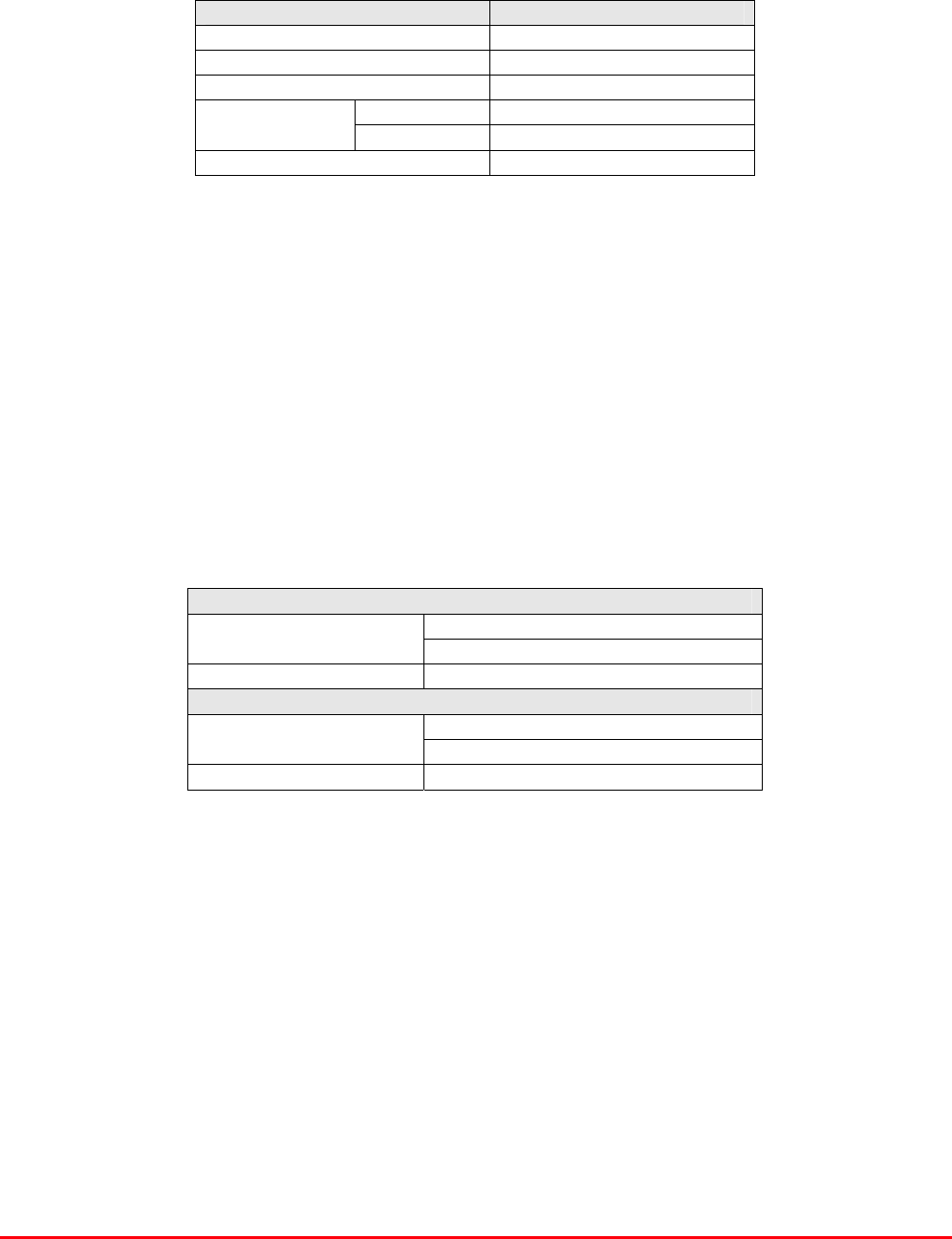
STTRS DOCUMENTATION
Document Number 80-330501HBKM – Issue A - Draft Page 156 of 500
10.4.3.14. DC/DC Converter 96-200047
96-200047 is an O.E.M. high power device with a wide input range and 12.5 amp @ 12V (150Watts)
output capability used to derive a 12V fixed voltage power supply rail from a higher voltage supply, in
this case 12V. In the event of failure this unit should not be repaired, only replaced.
96-200047 Specification
PARAMETER SPECIFICATION
DC Input Voltage range 19 to 36V
DC Output voltage 12V ± 1%
Max. current load 12.5Amps
Operation -10°C to +60°C Temperature
range Storage -20°C to +85°C
Working Humidity 20 to 90% RHNC
10.4.3.15. 12V Switch-Mode PSU (96-300052)
No routine maintenance of the PSU is required. If a fault is suspected, then the output voltage from
the power supply may be measured on its output terminals. This is typically set to 12.2V. The
adjustment potentiometer will be found close to the DC output terminals.
All the PSUs used in AFL Cell Enhancers are capable of operation from either 110 or 220V nominal
AC supplies. The line voltage is sensed automatically, so no adjustment or link setting is needed by
the operator.
96-300052 Specification
AC Input Supply 110 or 220V nominal
Voltage 85 - 265V AC (absolute limits)
Frequency 47 to 63Hz
DC Output Supply 12V DC (nominal)
Voltage 10.5-13.8V (absolute limits)
Current 12.5A
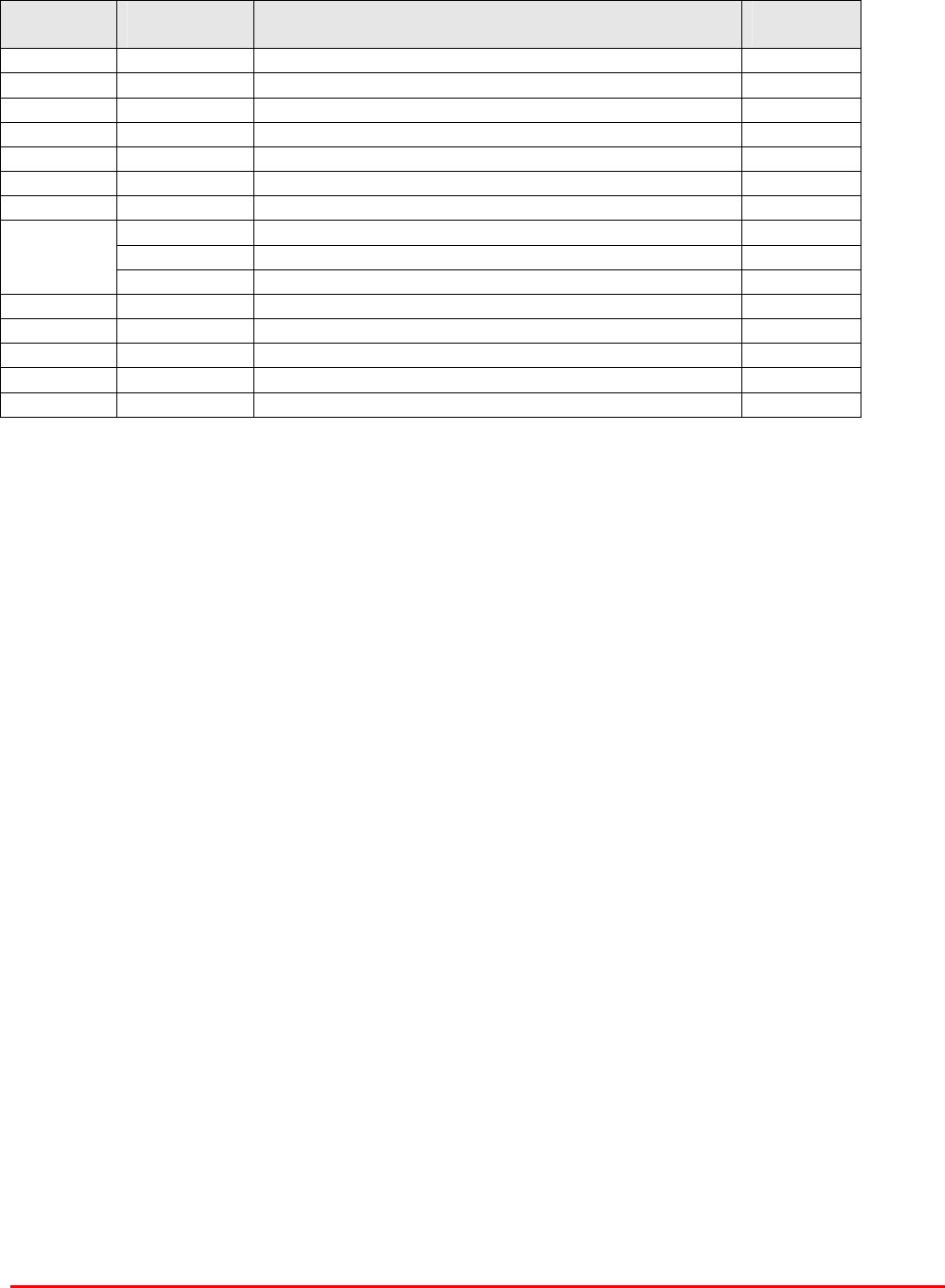
STTRS DOCUMENTATION
Document Number 80-330501HBKM – Issue A - Draft Page 157 of 500
10.4.4. 700MHz FO Hub Amplifier (55-165602)
700MHz FO Hub Amplifier (55-165602) List of major components
Section Component
Part Component Part Description Qty. Per
Assembly
10.4.4.3. 02-007206 900MHZ 8POLE 25MHz+ B/W "SMA" 2
10.4.4.4. 07-015105 ASYMMETRIC CPLR 30dB 800-2500MHz GA 2
10.4.4.5. 10-000701 SW ATT 0-30dB 0.25W SMA F 2
10.4.4.6. 11-005902 900MHz LOW NOISE AMP WITH RELAY KIT 1
10.4.4.7. 11-006702 800-1000MHz LNA 29dB (cw RELAY) KIT 2
10.4.4.8. 12-018002 PA 800-960MHz 20W CLASS A KIT 1
10.4.4.9. 12-021901 Low Power Amplifier 2
17-001109 AGC Detector Assembly (Logarithmic) 1
17-001117 AGC Detector Assembly 1
10.4.4.10.
17-001201 AGC Attenuator Assembly 2
10.4.4.11. 20-001601 12V RELAY BOARD 1
10.4.4.12. 80-008901 12V RELAY PCB ASSEMBLY 1
10.4.4.13. 94-100004 STPS12045TV 60A DUAL DIODE 1
10.4.4.14. 96-200047 DC/DC Converter 1
10.4.4.15. 96-300052 JWS150-12/A PSU (COUTANT LAMBDA) 1
*The sub components 17-001109, 17-001117 & 17-001201 are parts of the Automatic Gain Control
(AGC) system used in 700MHz FO Hub Amplifier (55-165602); 17-001117 and 17-001201 are paired
for use in the uplink and 17-001109 and 17-001201 are paired for use in the downlink
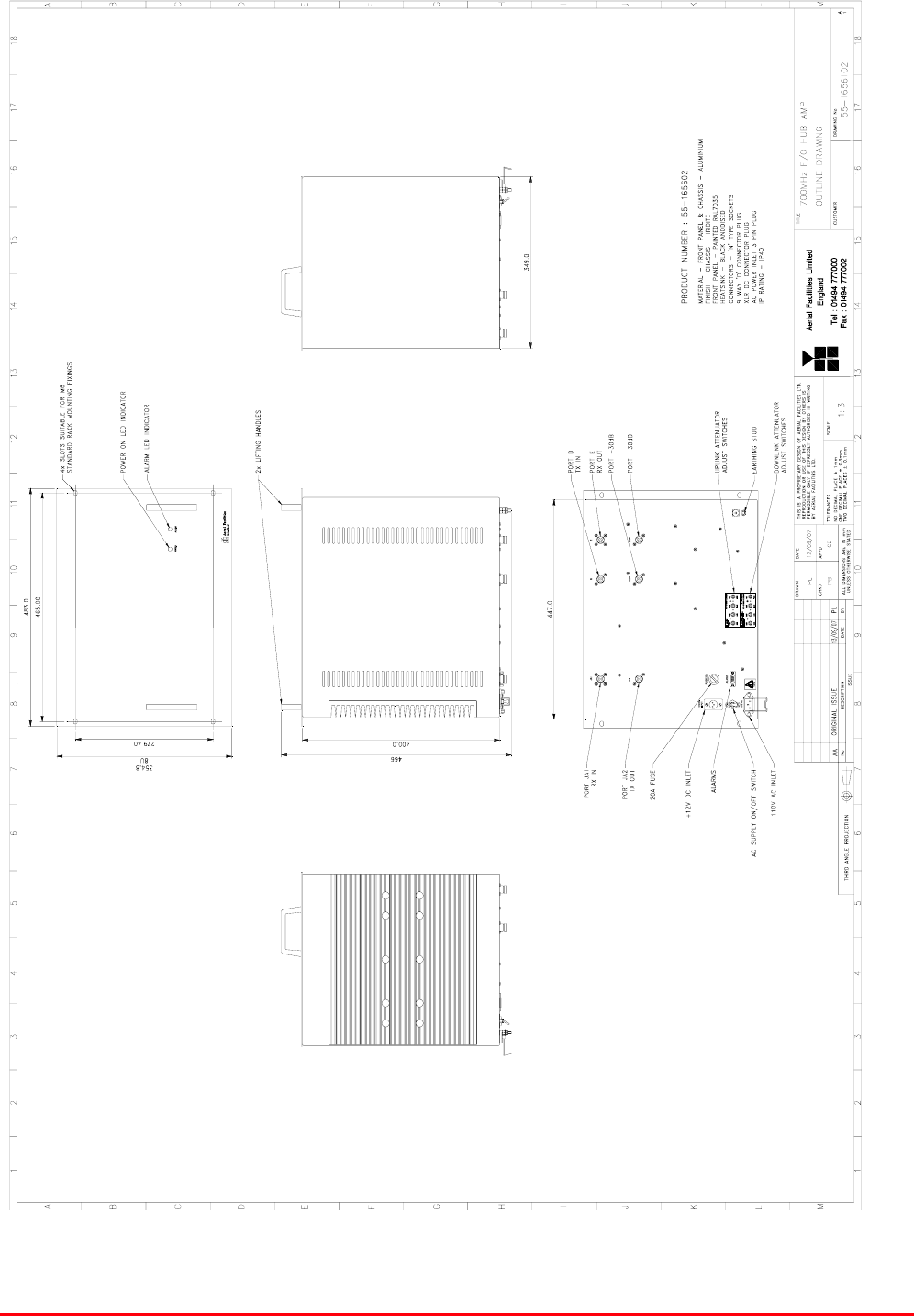
STTRS DOCUMENTATION
Document Number 80-330501HBKM – Issue A - Draft Page 158 of 500
10.4.4.1. 700MHz FO Hub Amplifier (55-165602) Outline Drawing
drawing number 55-1656102
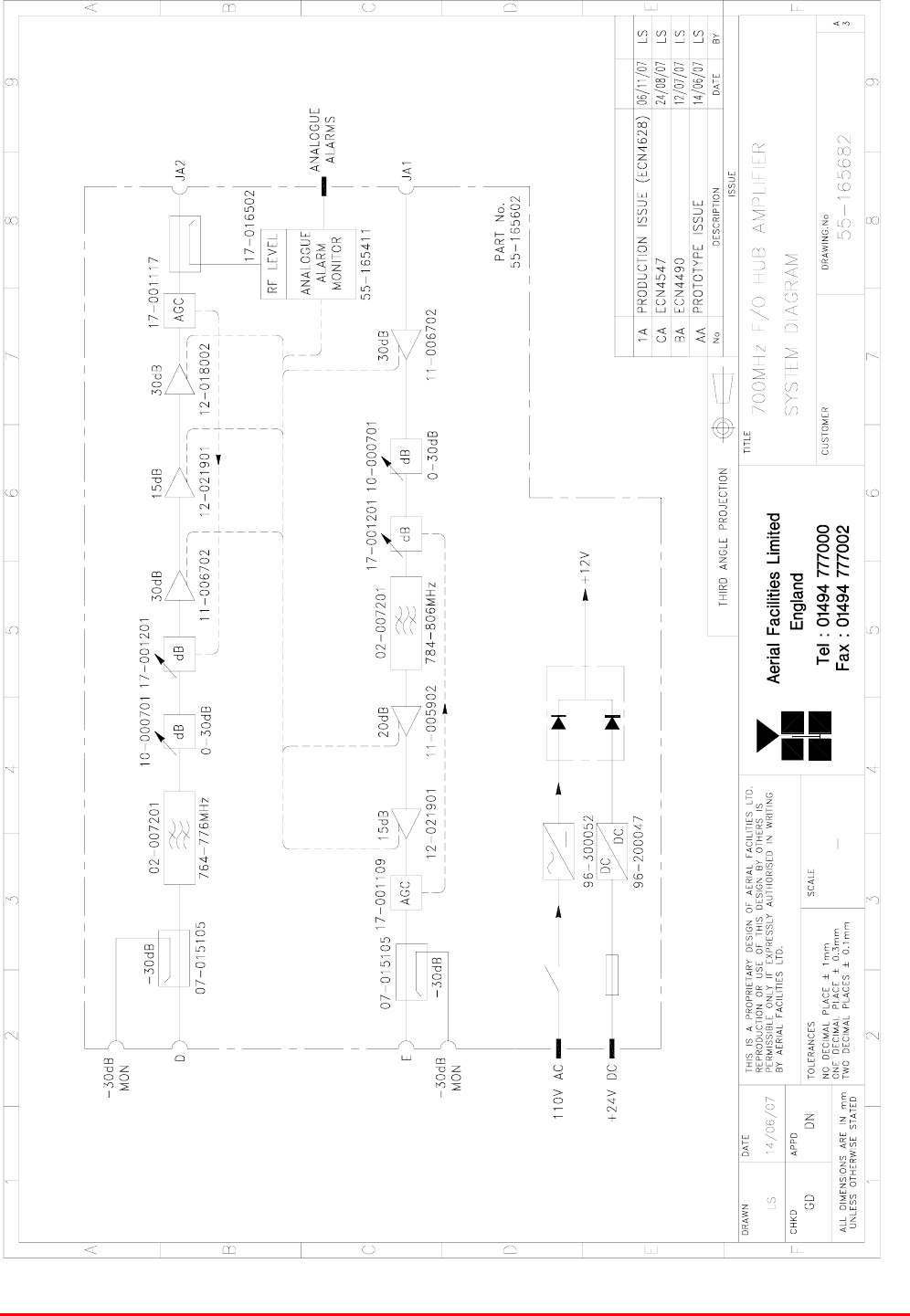
STTRS DOCUMENTATION
Document Number 80-330501HBKM – Issue A - Draft Page 159 of 500
10.4.4.2. 700MHz FO Hub Amplifier (55-165602) system diagram
drawing number 55-165682

STTRS DOCUMENTATION
Document Number 80-330501HBKM – Issue A - Draft Page 160 of 500
10.4.4.3. Bandpass Filter (02-007206)
The bandpass filters are multi-section designs with a bandwidth dependent upon the passband
frequencies, (both tuned to customer requirements). The response shape is basically Chebyshev with
a passband design ripple of 0.1dB. The filters are of slot coupled, folded combline design, and are
carefully aligned during manufacture in order to optimise the insertion loss, VSWR and
intermodulation characteristics of the unit. The tuned elements are silver-plated to reduce surface
ohmic losses and maintain a good VSWR figure and 50Ω load at the input and output ports.
Being passive devices, the bandpass filters should have an extremely long operational life and require
no maintenance. Should a filter be suspect, it is usually most time efficient to replace the module
rather than attempt repair or re-tuning.
No adjustments should be attempted without full network sweep analysis facilities to monitor both
insertion loss and VSWR simultaneously.
02-007206 Specification
PARAMETER SPECIFICATION
Response type Chebyshev
Frequency range 800 - 950MHz *
Bandwidth 25MHz *
Number of sections 8
Insertion loss 1.2 dB
VSWR better than 1.2:1
Connectors SMA female
Power handling 100W max
operation -20°C to +60°C Temperature
range storage -40°C to +70°C
Weight 3 kg (typical) *tuned to Customer's specification
10.4.4.4. Wideband Asymmetric Coupler (07-015105)
The purpose of Wideband Asymmetric Coupler (07-015105) is to tap off a known portion (in this case
30dB) of RF signal from transmission lines and to combine them, for example through splitter units for
different purposes (alarms/monitoring etc.), whilst maintaining an accurate 50Ω load to all
ports/interfaces throughout the specified frequency range. They are known formally as directional
couplers as they couple power from the RF mainline in one direction only.
07-015105 Specification
PARAMETER SPECIFICATION
Construction Inductive air gap
Frequency 800-2500MHz
Through loss 0.4dB (typical)
Coupling level -30dB ±0.5dB
Isolation N/A
Weight <1.0kg
Connectors SMA, female
operation -20°C to +60°C
Temperature
range storage -40°C to +70°C
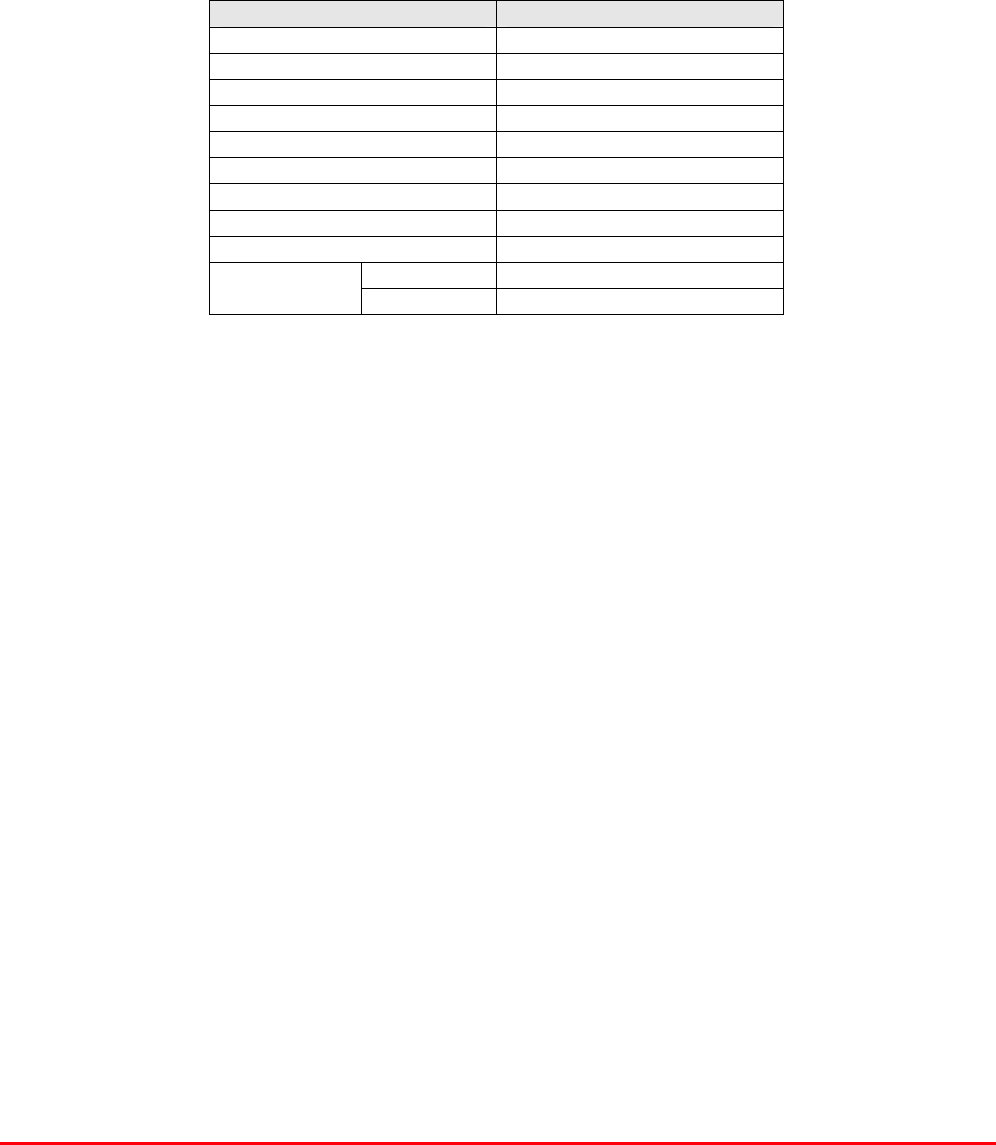
STTRS DOCUMENTATION
Document Number 80-330501HBKM – Issue A - Draft Page 161 of 500
10.4.4.5. Switched Attenuator 0.25Watt, 0 - 30dB (10-000701)
In many practical applications for Cell Enhancers etc., the gain in each path is found to be excessive.
Therefore, provision is made within the unit for the setting of attenuation in each path, to reduce the
gain.
Switched Attenuator 10-000701 provides attenuation from 0 to 30dB in 2 dB steps The attenuation is
simply set using the four miniature toggle switches on the top of each unit. Each switch is clearly
marked with the attenuation it provides, and the total attenuation in line is the sum of the values
switched in. They are designed to maintain an accurate 50Ω impedance over their operating
frequency at both input and output.
10-000701 Specification
PARAMETER SPECIFICATION
Attenuation Values 0-30dB
Attenuation Steps 2, 4, 8 and 16dB
Power Handling 0.25 Watt
Attenuation Accuracy ± 1.0 dB
Frequency Range DC to 1GHz
Impedance 50Ω
Connectors SMA
VSWR 1.3:1
Weight 0.2kg
operation -20°C to +60°C Temperature
range storage -40°C to +70°C
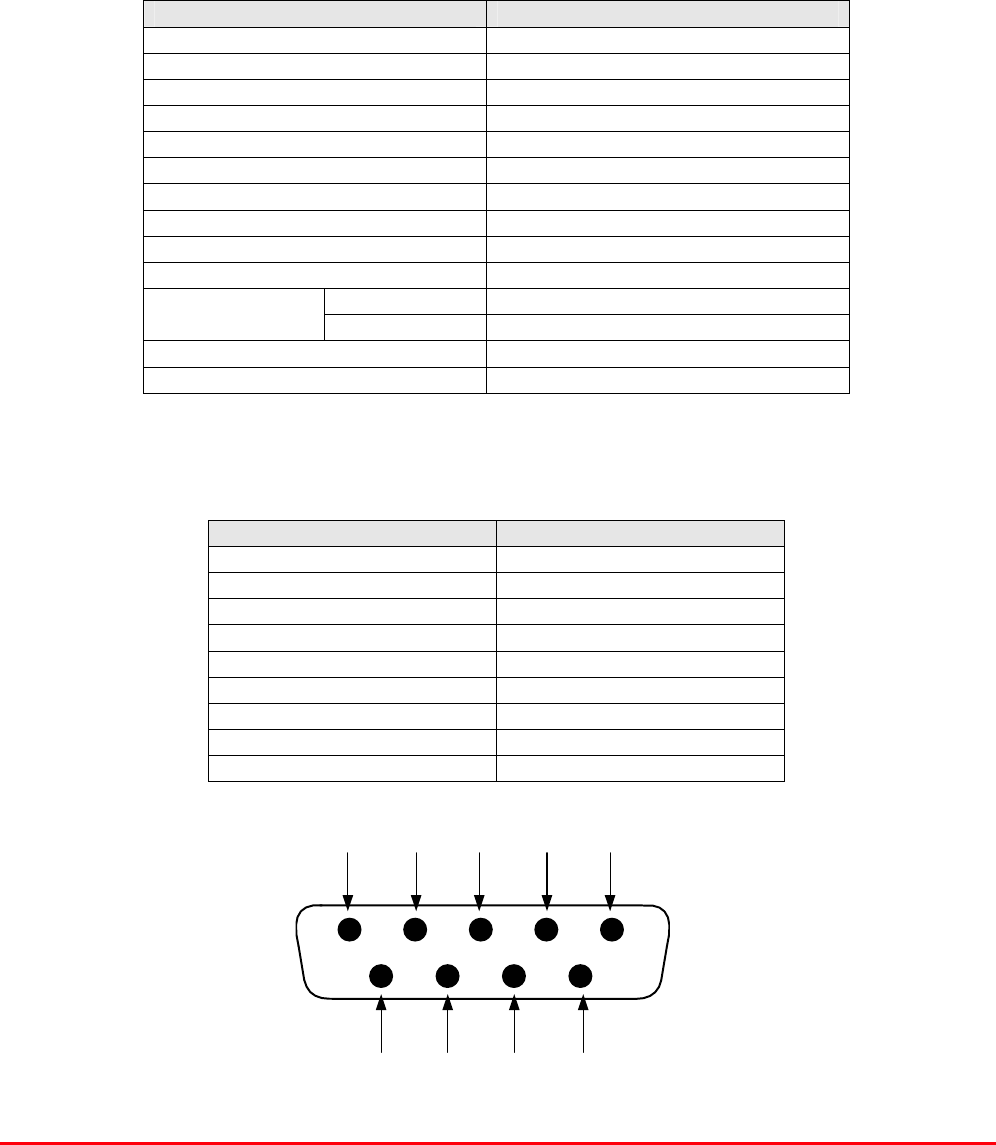
STTRS DOCUMENTATION
Document Number 80-330501HBKM – Issue A - Draft Page 162 of 500
10.4.4.6. Low Noise Amplifier (11-005902)
The Gallium-Arsenide low noise amplifier used in the unit is a double stage, solid-state low noise
amplifier. Class A circuitry is used throughout the units to ensure excellent linearity and extremely low
noise over a very wide dynamic range. The active devices are very moderately rated to provide a long
trouble-free working life. There are no adjustments on these amplifiers, and in the unlikely event of a
failure, then the complete amplifier should be replaced. This amplifier features its own in-built alarm
system which gives a volt-free relay contact type alarm that is easily integrated into any alarm system.
There is a Current Fault Alarm Function, which indicates failure of each one or both RF transistors by
a various alarm output options. The amplifier is housed in an aluminium case (Iridite NCP finish) with
SMA connectors for the RF input/output and a 9way D-type for DC and alarm outputs.
11-005902 Specification
PARAMETER SPECIFICATION
Frequency range: 800 – 960MHz *
Bandwidth: <170MHz
Gain: 19.5dB (typical)
1dB compression point: 21dBm
OIP3: 33dBm
Input/output return loss: >20dB
Noise figure: 1dB (typical)
Power consumption: 190mA @ 24V DC
Supply voltage: 10-24V DC
Connectors: SMA female
operational: -10°C to +60°C Temperature
range storage: -40°C to +70°C
Size: 90 x 55 x 30.2mm
Weight: 0.28kg *tuned to Customer's specification
LNA ‘D’ Connector Pin-out details
Connector pin Signal
1 +Ve input (10-24V)
2 GND
3 Alarm relay O/P bad
4 Alarm relay common
5 Alarm relay good
6 No connection
7 TTL voltage set
8 TTL alarm/0V (good)
9 O/C good/0V bad
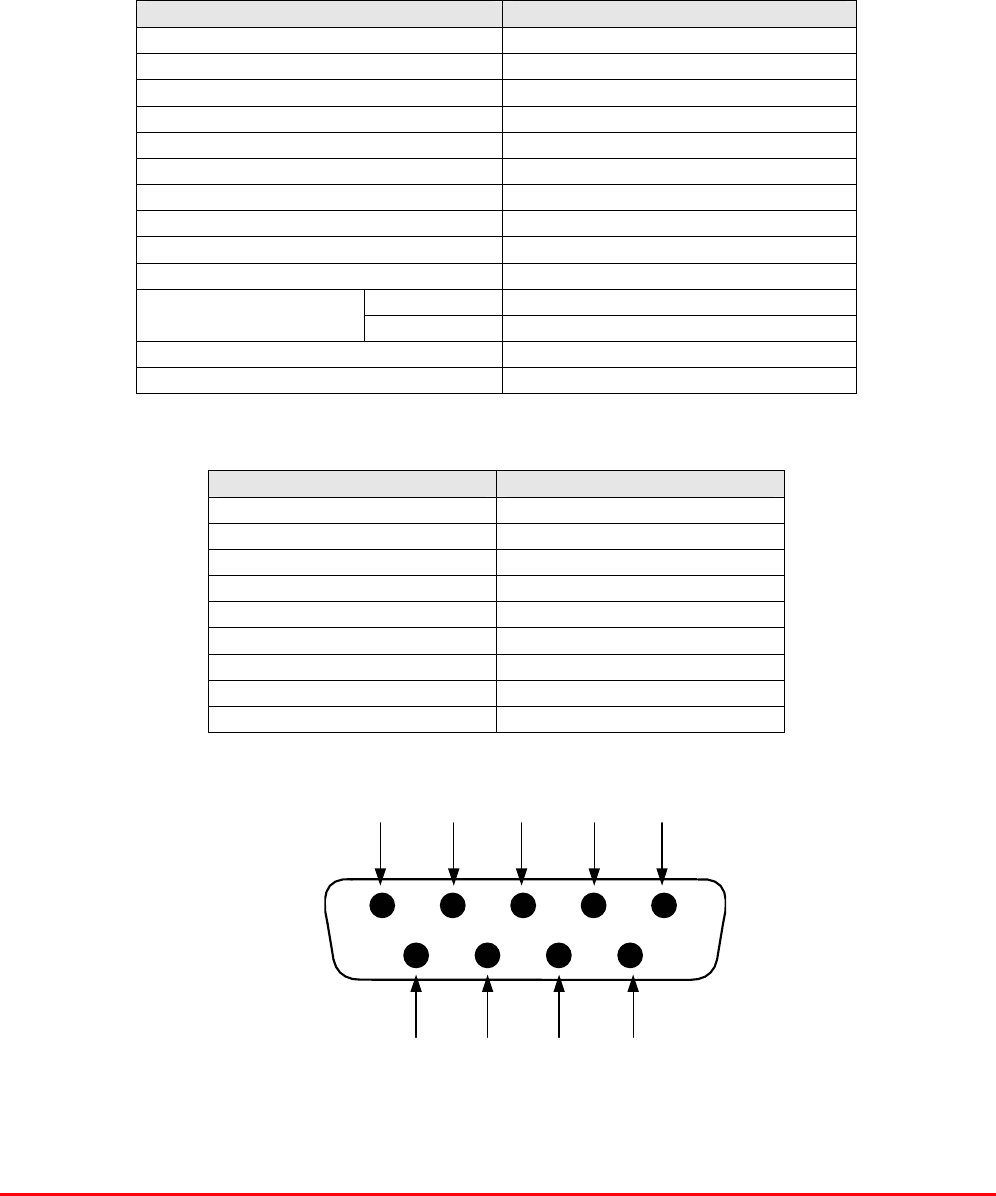
STTRS DOCUMENTATION
Document Number 80-330501HBKM – Issue A - Draft Page 163 of 500
7 8 96
1 2 3 4 5
9-Way Pin-Out Graphical Representation
10.4.4.7. Low Noise Amplifier (11-006702)
The Gallium-Arsenide low noise amplifiers used in 800MHz Line Amplifier (55-165703) are double
stage, solid-state low noise amplifiers. Class A circuitry is used throughout the units to ensure
excellent linearity and extremely low noise over a very wide dynamic range. The active devices are
very moderately rated to provide a long trouble-free working life. There are no adjustments on these
amplifiers, and in the unlikely event of a failure, then the complete amplifier should be replaced. This
amplifier features its own in-built alarm system which gives a volt-free relay contact type alarm that is
easily integrated into the main alarm system.
11-006702 Specification
PARAMETER SPECIFICATION
Frequency range: 800 – 1000MHz
Bandwidth: <200MHz
Gain: 29dB (typical)
1dB Compression point: 20dBm
OIP3: 33dBm
Input/Output return loss: >18dB
Noise figure: 1.3dB (typical)
Power consumption: 180mA @ 24V DC
Supply voltage: 10-24V DC
Connectors: SMA female
operational: -10°C to +60°C
Temperature range: storage: -20°C to +70°C
Size: 90 x 55 x 30.2mm
Weight: 290gms (approximately)
Low Noise Amplifier (11-006702) ‘D’ Connector Pin-out details
Connector pin Signal
1 +Ve input (10-24V)
2 GND
3 Alarm RelayO/P bad
4 Alarm Relay common
5 Alarm Relay good
6 No connection
7 TTL voltage set
8 TTL alarm/0V (good)
9 O/C good/0V bad
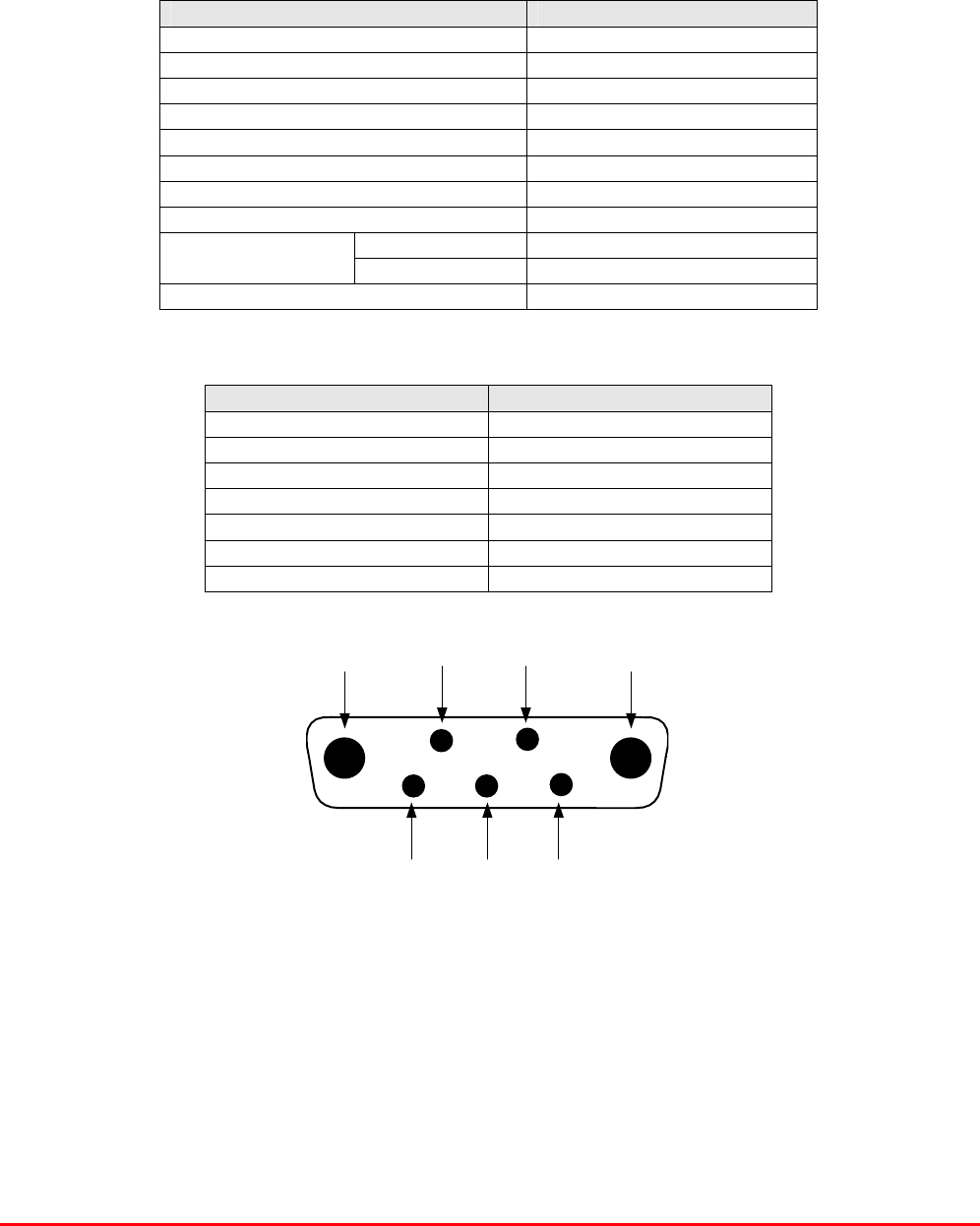
STTRS DOCUMENTATION
Document Number 80-330501HBKM – Issue A - Draft Page 164 of 500
10.4.4.8. Power Amplifier (12-018002)
This amplifier is a Class A 20W power amplifier from 800-960MHz in a 1 stage balanced
configuration. It demonstrates a very high linearity and a very good input/output return loss (RL). It
has built in a Current Fault Alarm Function.
Its housing is an aluminium case (Iridite NCP finish) with SMA connectors for the RF input/output and
a D-Type connector for the power supply and the Current Fault Alarm Function.
12-018002 Specification
PARAMETER SPECIFICATION
Frequency range: 800-960MHz
Small signal gain: 30dB
Gain flatness: ±1.2dB
I/O Return loss: >18dB
1dB compression point: 42.8dBm
OIP3: 56dBm
Supply voltage: 24V DC
Supply current: 5.0Amps (Typical)
operational: -10°C to +60°C Temperature
range storage: -20°C to +70°C
Weight: <2kg (no heatsink)
Power Amplifier (12-018002) 7-Way Connector Pin-outs
Connector Pin Signal
A1 (large pin) +24V DC
A2 (large pin) GND
1 Alarm relay common
2 TTL alarm/0V good
3 Alarm relay contact (bad)
4 Alarm relay contact (good)
5 O/C good/0V bad (TTL)
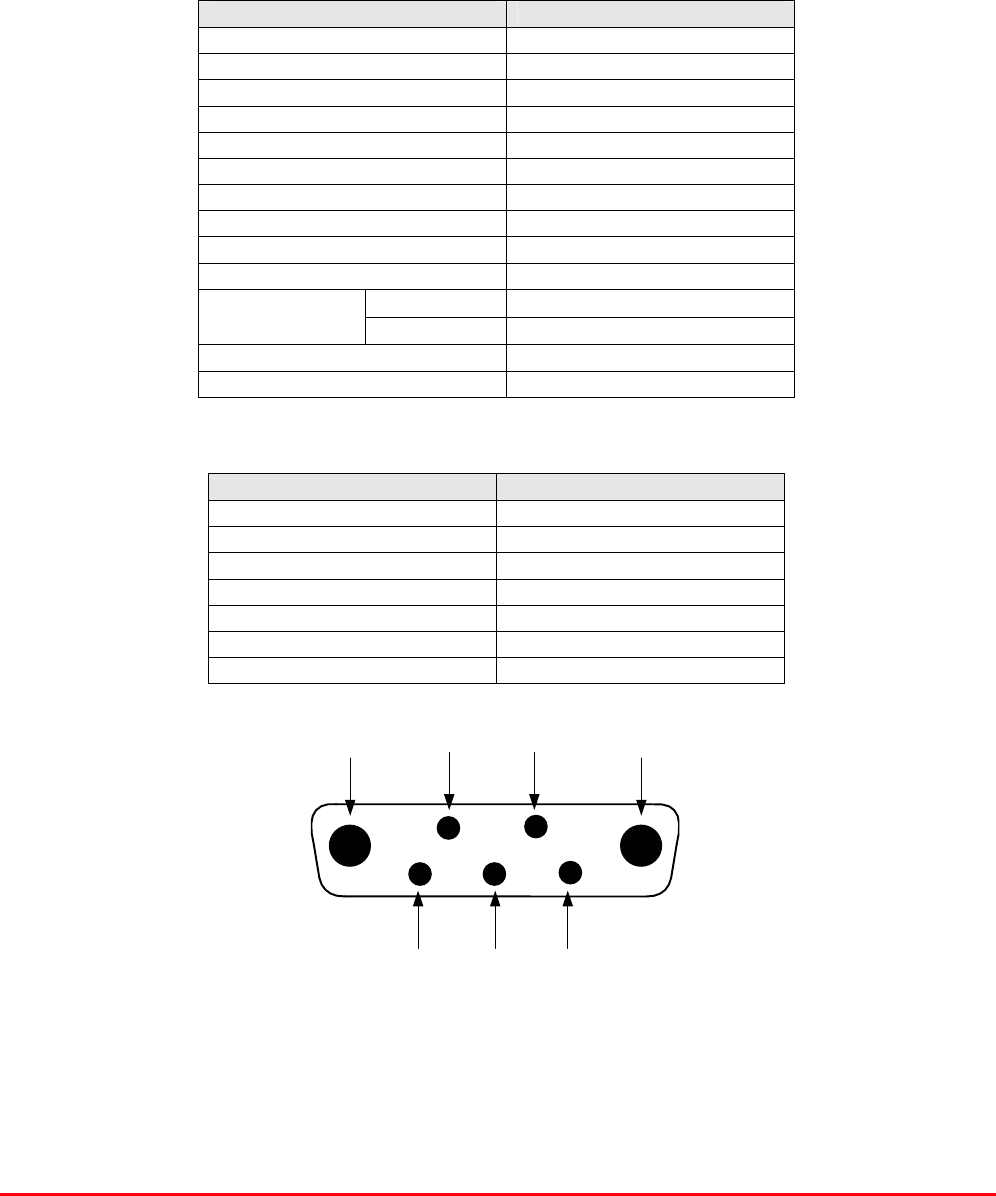
STTRS DOCUMENTATION
Document Number 80-330501HBKM – Issue A - Draft Page 165 of 500
10.4.4.9. Low Power Amplifier (12-021901)
The low power amplifier used is a triple stage solid-state low-noise amplifier. Class A circuitry is used
in the unit to ensure excellent linearity over a very wide dynamic range. The three active devices are
very moderately rated to provide a long trouble-free working life.
Its housing is an aluminium case (Iridite NCP finish) with SMA connectors for the RF input/output and
a D-Type connector for the power supply and the Current Fault Alarm Function.
There are no adjustments on this amplifier, and in the unlikely event of failure then the entire amplifier
should be replaced.
Low Power Amplifier (12-021901) Specification
PARAMETER SPECIFICATION
Frequency range 800-960MHz*
Bandwidth 20MHz *
Maximum RF output >1.0 Watt
Gain 15dB
1dB compression point +30.5dBm
3rd order intercept point +43dBm
Noise Figure <6dB
VSWR better than 1.5:1
Connectors SMA female
Supply 500mA @ 10-15V DC
operational -10°C to +60°C
Temperature
range storage -20°C to +70°C
Weight 0.5 kg
Size 167x52x25mm
* Tuned to Customer’s specification
Low Power Amplifier (12-021901) 7-Way Connector Pin-outs
Connector Pin Signal
A1 (large pin) +24V DC
A2 (large pin) GND
1 Alarm relay common
2 TTL alarm/0V good
3 Alarm relay contact (bad)
4 Alarm relay contact (good)
5 O/C good/0V bad (TTL)

STTRS DOCUMENTATION
Document Number 80-330501HBKM – Issue A - Draft Page 166 of 500
10.4.4.10. Automatic Gain Control
17-001109 AGC Detector Assembly (Logarithmic)
17-001117 AGC Detector Assembly
17-001201 AGC Attenuator Assembly
The sub components 17-001109, 17-001117 & 17-001201 are parts of the Automatic Gain Control
(AGC) system used in 700MHz FO Hub Amplifier (55-165602); 17-001117 and 17-001201 are paired
for use in the uplink and 17-001109 and 17-001201 are paired for use in the downlink
700MHz FO Hub Amplifier (55-165602) is fitted with two differing types of Automatic Gain Control
(AGC) system, one linear, and one logarithmic. The AGC with logarithmic detector (17-001117) is
fitted in the uplink path and the AGC with linear detector (17-001109) is fitted in the downlink path
The AFL Automatic Gain Control system consists of two units, a detector/amplifier and an attenuator.
The detector/amplifier unit is inserted in the RF path on the output of the power amplifier, and the
attenuator is situated in the RF path between the 1st and 2nd stages of amplification.
17-001117 and 17-001201 are paired for use in the uplink and 17-001109 and 17-001201 are paired
for use in the downlink
The attenuator comprises a 50Ω P.I.N diode, voltage-variable attenuator with a range of 3 to 30dB.
The attenuation is controlled by a DC voltage which is derived from the associated detector controller
board.
Normally the attenuator is at minimum attenuation. The detector/amplifier unit monitors the RF level
being delivered by the power amplifier, and when a certain threshold is reached it begins to increase
the value of the attenuator to limit the RF output to the (factory set) threshold. Therefore overloading
of the power amplifier is avoided.
The factory set threshold is 1dB below the Enhancer 1dB compression point. Some adjustment of this
AGC threshold level is possible, a 10dB range is mostly achieved. It is not recommended under any
circumstances to adjust the AGC threshold to a level greater than the 1dB compression point as
system degradation will occur.
The detector comprises of a 50Ω transmission line with a resistive tap which samples a small portion
of the mainline power. The sampled signal is amplified and fed to a conventional half wave diode
rectifier, the output of which is a DC voltage proportional to the RF input signal.
This DC voltage is passed via an inverting DC amplifier with integrating characteristics, to the output,
which drives the attenuation control line of the corresponding AGC attenuator. This unit is fitted at
some earlier point in the RF circuit.
For small signals, below AGC onset, the output control line will be close to 12V and the AGC
attenuator will have minimum attenuation. As the signal level increases the control line voltage will
fall, increasing the attenuator value and keeping the system output level at a constant value.
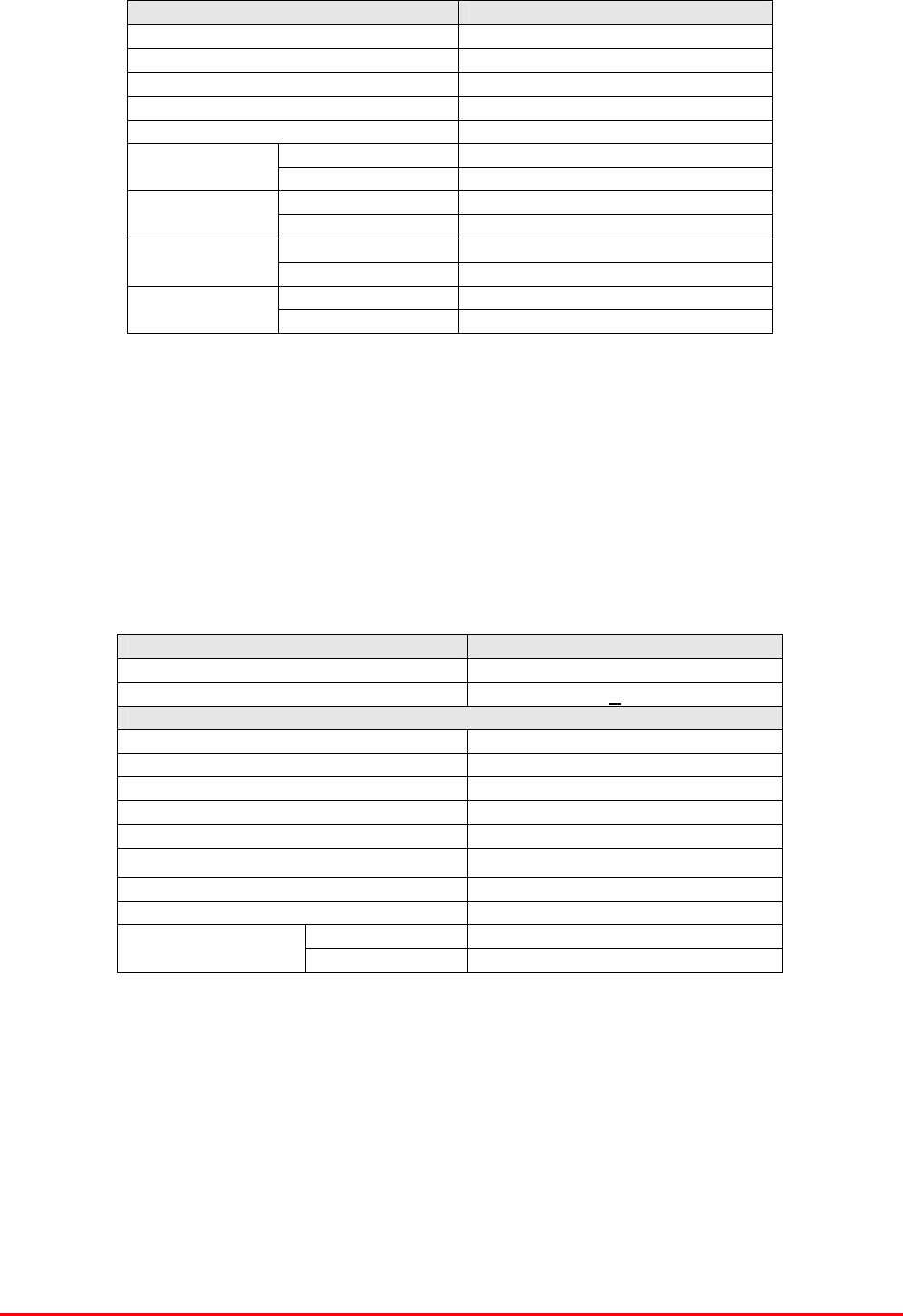
STTRS DOCUMENTATION
Document Number 80-330501HBKM – Issue A - Draft Page 167 of 500
AGC Specification (both types)
PARAMETER SPECIFICATION
Frequency range up to 1000MHz
Attenuation range 3 to 30dB
Attenuation steps continuously variable
VSWR better than 1.2:1
RF Connectors SMA female
attenuator 1W Power
handling detector/amp >30W (or as required)
operation -10°C to +60°C Temperature
range storage -20°C to +70°C
attenuator pcb 50 x 42 x 21mm
Size detector/amp pcb 54 x 42 x 21mm
attenuator 90grams
Weight detector/amp 100grams
10.4.4.11. 12V (Dual) Relay Board (20-001601)
The General Purpose Relay Board allows the inversion of signals and the isolation of circuits. It is
equipped with two dual pole change-over relays with completely isolated wiring, accessed via screw
terminals. Both relays are provided with polarity protection diodes and diodes for suppressing the
transients caused by "flywheel effect" which can destroy switching transistors or induce spikes on
neighbouring circuits. It’s common use is to amalgamate all the alarm signals into one, volts-free relay
contact pair for the main alarm system.
20-001601 Specification
PARAMETER SPECIFICATION
Operating voltage: 8 to 30V (floating earth)
Alarm threshold: Vcc - 1.20 volt +15%
Alarm output relay contacts:
Max. switch current: 1.0Amp
Max. switch volts: 120Vdc/60VA
Max. switch power: 24W/60VA
Min. switch load: 10.0µA/10.0mV
Relay isolation: 1.5kV
Mechanical life: >2x107 operations
Relay approval: BT type 56
Connector details: Screw terminals
operational: -10°C to +60°C Temperature
range storage: -20°C to +70°C
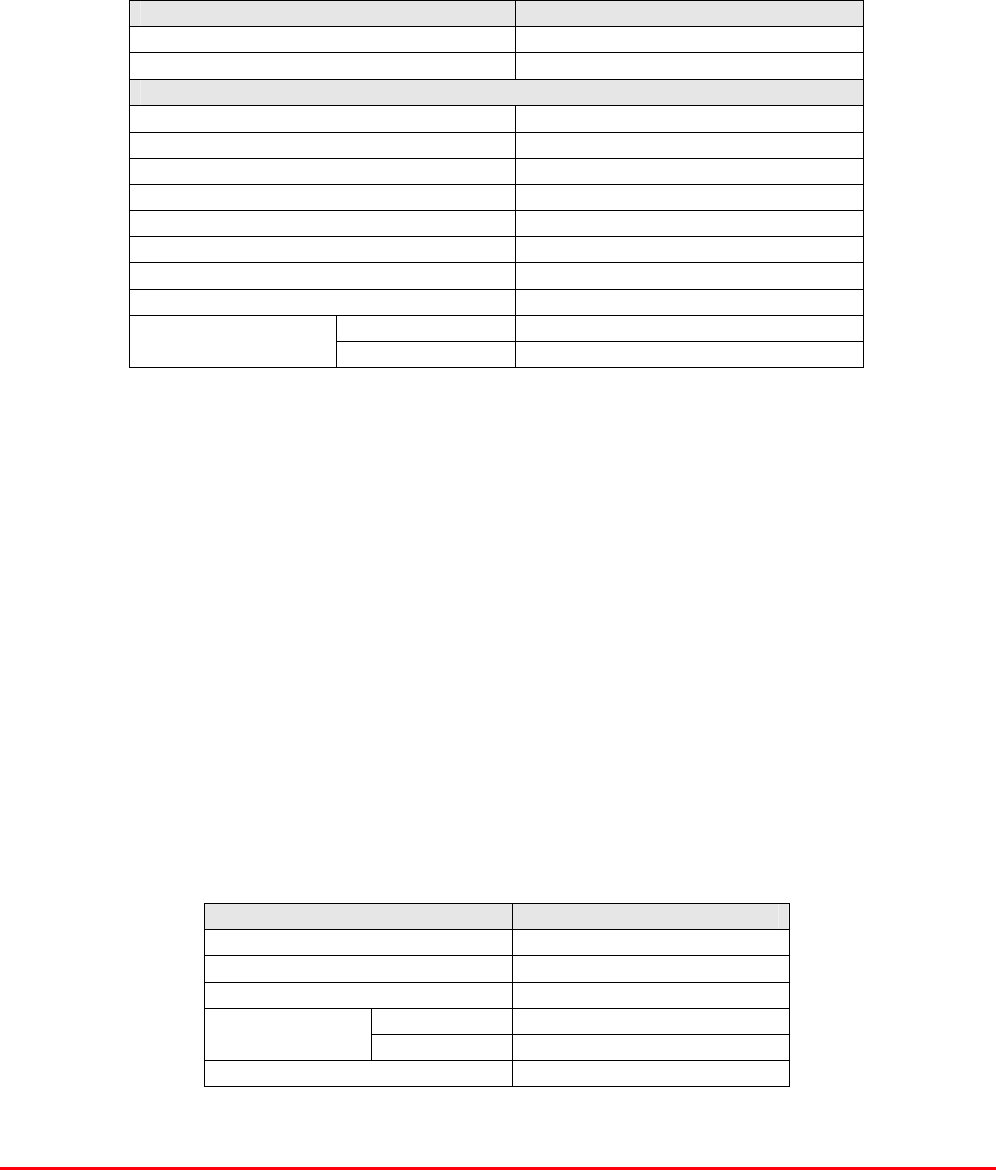
STTRS DOCUMENTATION
Document Number 80-330501HBKM – Issue A - Draft Page 168 of 500
10.4.4.12. 12V (Single) Relay Board (80-008901)
The General Purpose Relay Board allows the inversion of signals and the isolation of circuits. It is
equipped with a single dual pole change-over relay RL1, with completely isolated wiring, accessed
via a 15 way in-line connector.
The relay is provided with polarity protection diodes and diodes for suppressing the transients caused
by "flywheel effect" which can destroy switching transistors or induce spikes on neighbouring circuits.
It’s common use is to amalgamate all the alarm signals into one, volts-free relay contact pair for the
main alarm system.
80-008901 Specification
PARAMETER SPECIFICATION
Operating voltage 8 to 30V (floating earth)
Alarm threshold Vcc - 1.20 volt +15%
Alarm output relay contacts:
Max. switch current 1.0Amp
Max. switch volts 120Vdc/60VA
Max. switch power 24W/60VA
Min. switch load 10.0µA/10.0mV
Relay isolation 1.5kV
Mechanical life >2x107 operations
Relay approval BT type 56
Connector details Screw terminals
operational -10°C to +60°C Temperature
range storage -20°C to +70°C
10.4.4.13. Dual Diode Assembly (94-100004)
The purpose of these dual diode assemblies is to allow two DC voltage sources to be combined, so
that the main DC rail within the equipment can be sourced from either a mains driven PSU, or
externally through an XLR connector or from dual mains driven PSUs. They are very heavy-duty
diodes and they prevent any reverse current from flowing back to their source or the alternative
supply rail. Combining diodes such as these will also be used if the equipment is to be powered from
external back-up batteries.
10.4.4.14. DC/DC Converter 96-200047
96-200047 is an O.E.M. high power device with a wide input range and 12.5 amp @ 12V (150Watts)
output capability used to derive a 12V fixed voltage power supply rail from a higher voltage supply, in
this case 12V. In the event of failure this unit should not be repaired, only replaced.
96-200047 Specification
PARAMETER SPECIFICATION
DC Input Voltage range 19 to 36V
DC Output voltage 12V ± 1%
Max. current load 12.5Amps
Operation -10°C to +60°C Temperature
range Storage -20°C to +85°C
Working Humidity 20 to 90% RHNC
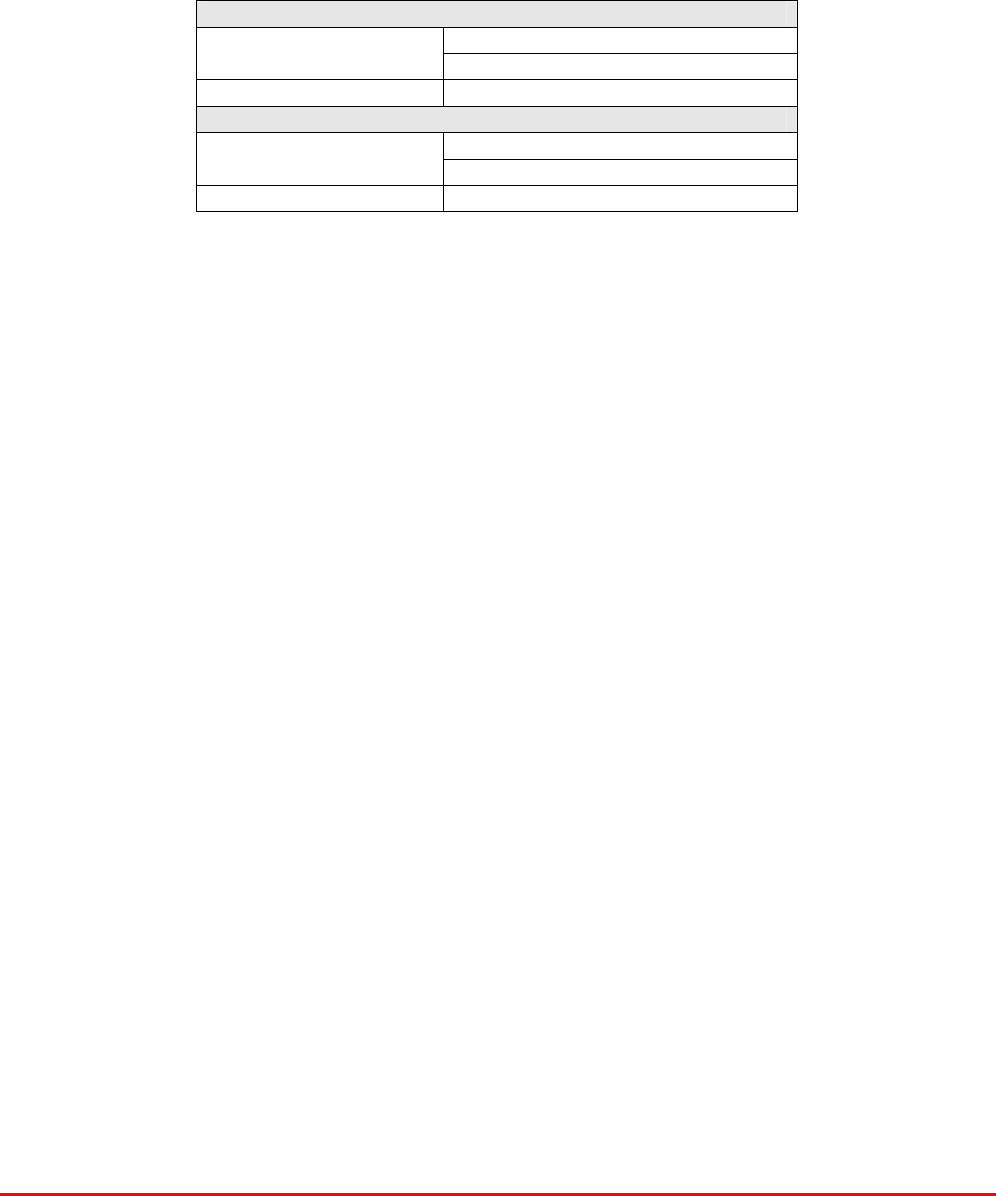
STTRS DOCUMENTATION
Document Number 80-330501HBKM – Issue A - Draft Page 169 of 500
10.4.4.15. 12V Switch-Mode PSU (96-300052)
No routine maintenance of the PSU is required. If a fault is suspected, then the output voltage from
the power supply may be measured on its output terminals. This is typically set to 12.2V. The
adjustment potentiometer will be found close to the DC output terminals.
All the PSUs used in AFL Cell Enhancers are capable of operation from either 110 or 220V nominal
AC supplies. The line voltage is sensed automatically, so no adjustment or link setting is needed by
the operator.
96-300052 Specification
AC Input Supply 110 or 220V nominal
Voltage 85 - 265V AC (absolute limits)
Frequency 47 to 63Hz
DC Output Supply 12V DC (nominal)
Voltage 10.5-13.8V (absolute limits)
Current 12.5A

STTRS DOCUMENTATION
Document Number 80-330501HBKM – Issue A - Draft Page 170 of 500
10.4.5. University Station Splitter 1 (55-165711)
University Station Splitter 1 (55-165711) list of major components
section Component
Part Component Part Description Qty. Per
Assembly
10.4.5.3. 05-003005 3 PORT THC 900MHz 1
10.4.5.4. 07-015102 ASYMMETRIC CPLR 10dB 800-2500MHz GA 4
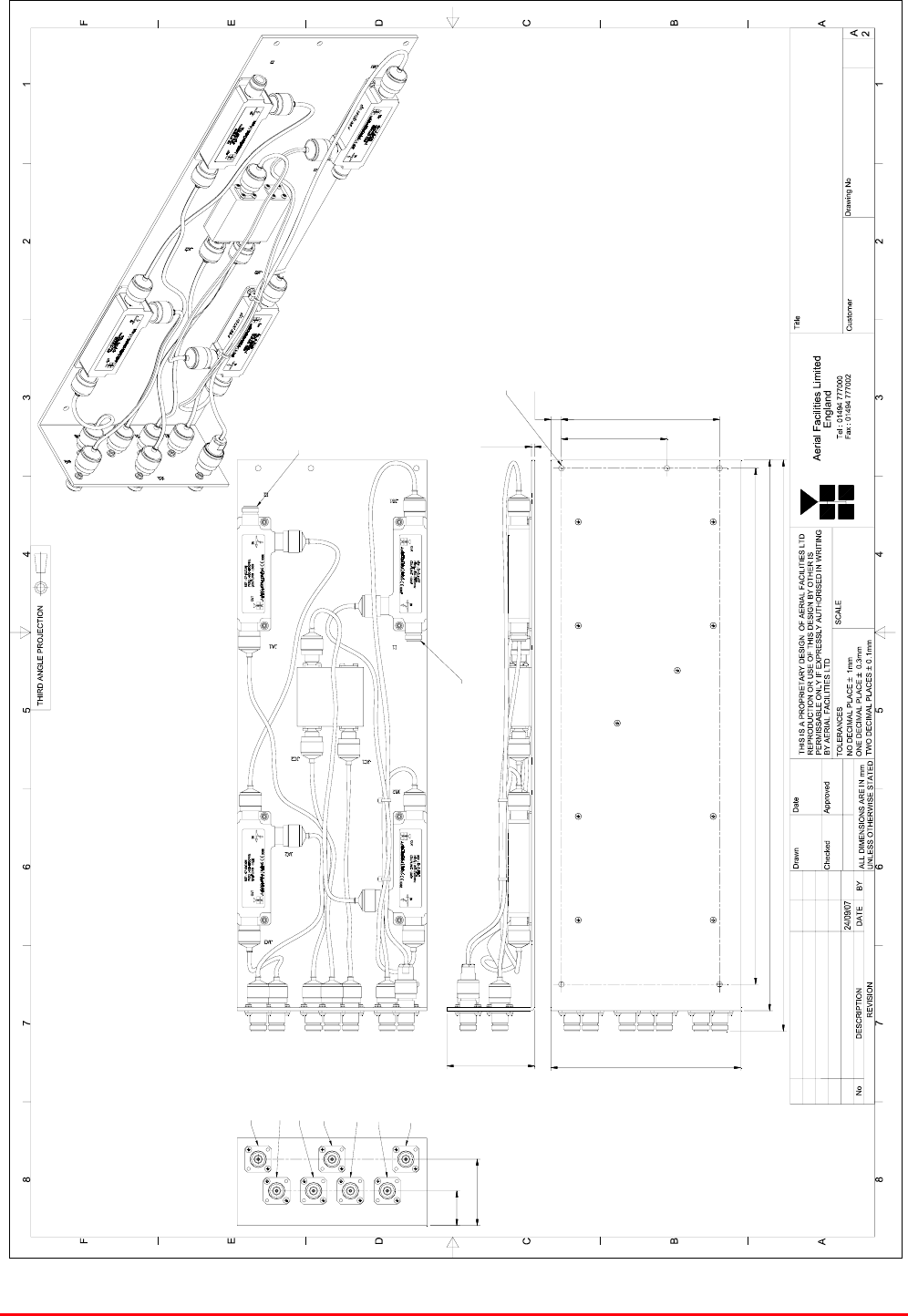
STTRS DOCUMENTATION
Document Number 80-330501HBKM – Issue A - Draft Page 171 of 500
UNIVERSITY STATION. SPLITTER 1
1:2 55-1657111
PB
17/10/2007
GD
17/10/2007
AA
24/09/07
OUTLINE DRAWING
PL
490.00
150.00
100.00
PORT JA2
PORT JA3
PORT JA1
PORT JC2
PORT JC1
PORT JB2
PORT JB1
PORT I1
PORT I2
5x HOLES SUITABLE FOR M5 FIXINGS
10.0
83.0
543
523.0
PRODUCT NUMBER : 55-165711
MATERIAL : CHASSIS - ALUMINIUM
FINISH : IRIDITE
CONNECTORS : 'N' TYPE SOCKET
180.0
AA ORIGINAL ISSUE PL
3.00
33.0
63.0
10.4.5.1. University Station Splitter 1 (55-165711) outline drawing
drawing number 55-1657111
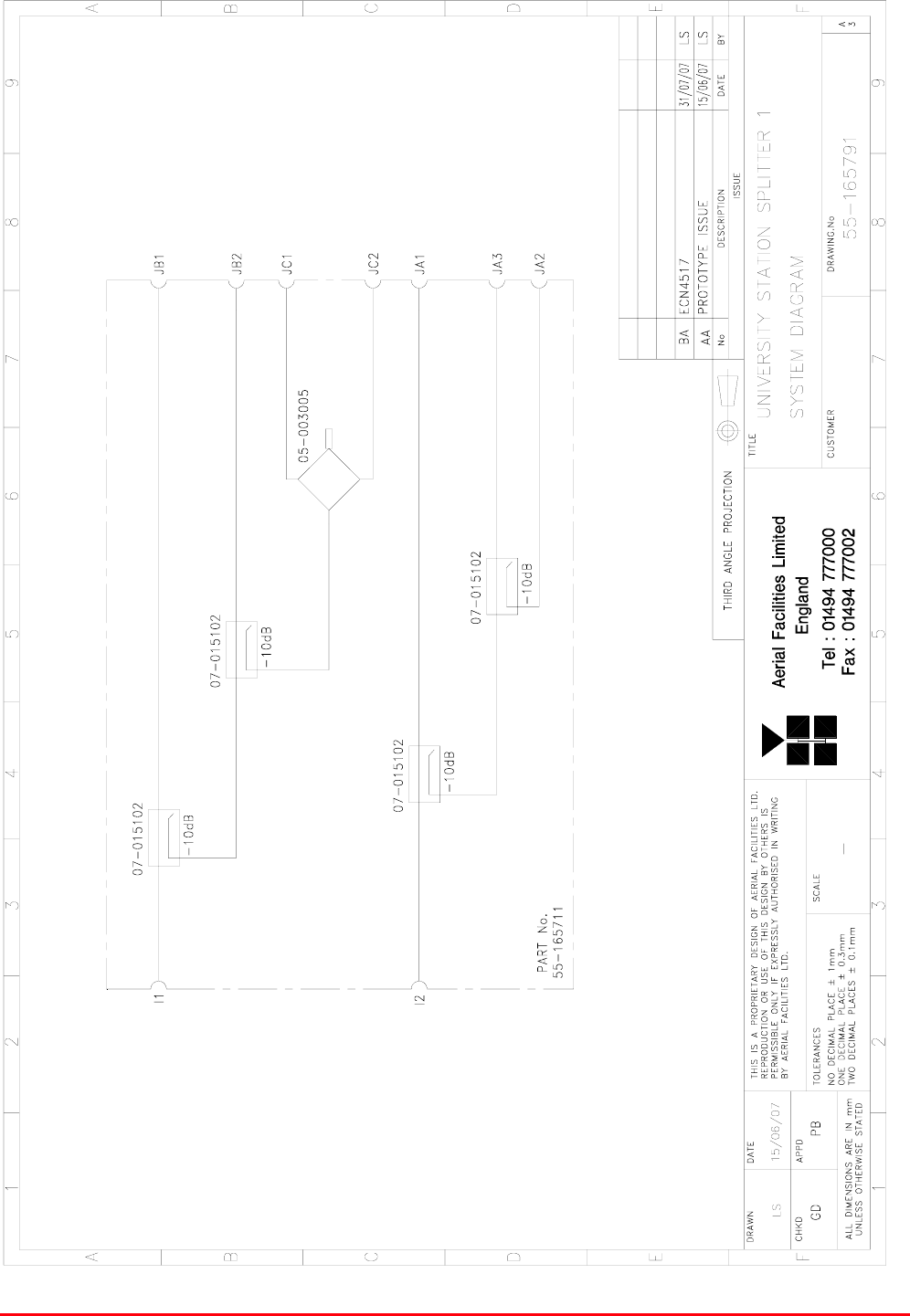
STTRS DOCUMENTATION
Document Number 80-330501HBKM – Issue A - Draft Page 172 of 500
10.4.5.2. University Station Splitter 1 (55-165711) system diagram
drawing number 55-165791
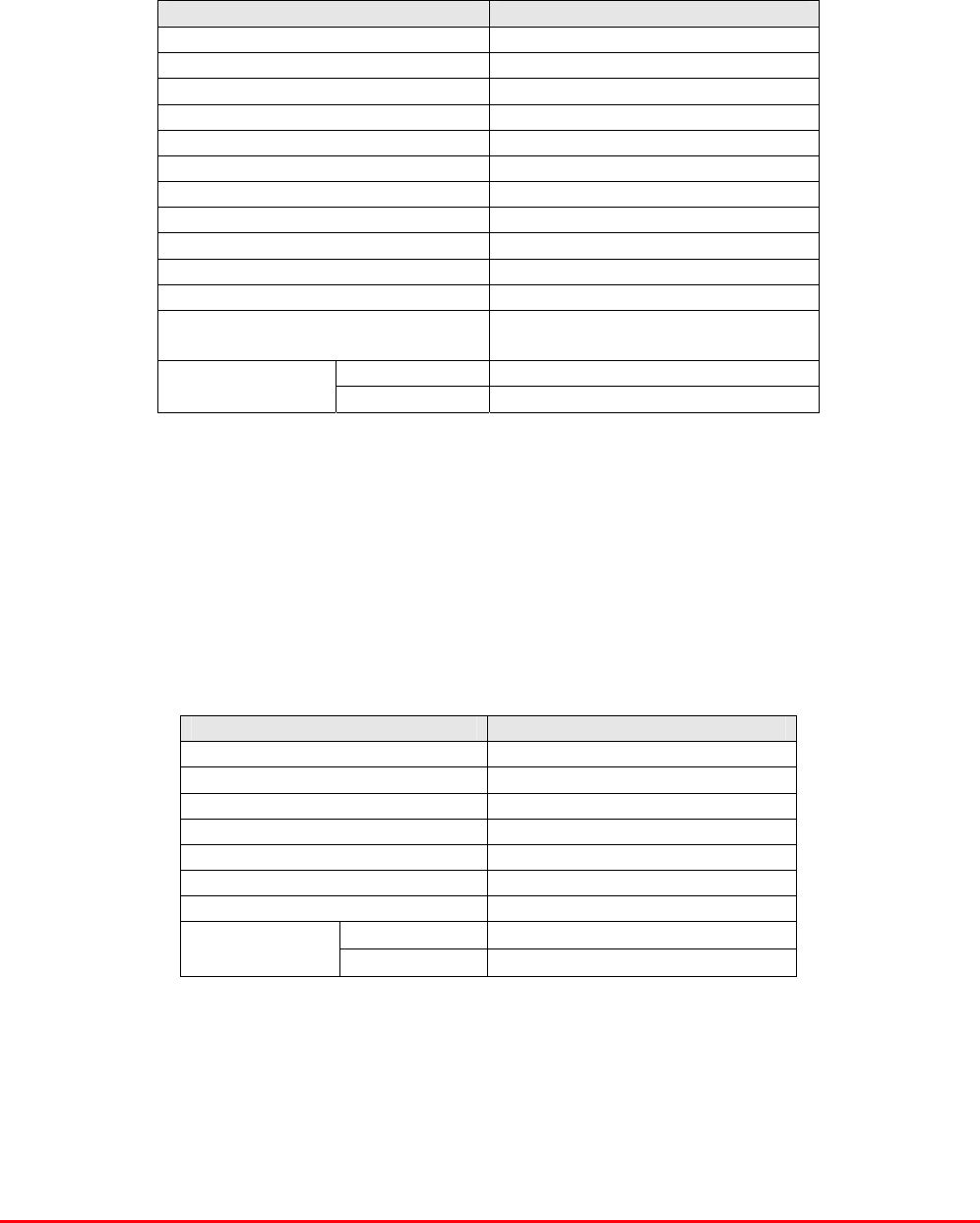
STTRS DOCUMENTATION
Document Number 80-330501HBKM – Issue A - Draft Page 173 of 500
10.4.5.3. 2-Way Splitter/Combiner (05-003005)
This printed circuit based Splitter/Combiner is a device for accurately matching two or more RF
signals to single or multiple ports, whilst maintaining an accurate 50Ω load to all inputs/outputs and
ensuring that the VSWR and insertion losses are kept to a minimum. Any unused ports should be
terminated with an appropriate 50Ω load.
(05-003005) Specification
PARAMETER SPECIFICATION
Frequency Range 800 - 1000 MHz
Input Ports 2
Output Ports 1
Insertion Loss <3.3 dB
Isolation >18 dB
VSWR 1.3:1
Power Rating as a Splitter 50 Watts
Power Rating as a Combiner 5 Watts
Mechanical Wall mount case
Weight <1.5kg
RF Connectors ‘N’ female
Dimensions 70mm x 63mm x 21mm
(excludes connectors)
operational -20%C to +60%C Temperature
range: storage -40%C to +70%C
10.4.5.4. Wideband Asymmetric Coupler (07-015102)
The purpose of Wideband Asymmetric Coupler (07-015102) is to tap off a known portion (in this case
10dB) of RF signal from transmission lines and to combine them, for example through splitter units for
different purposes (alarms/monitoring etc.), whilst maintaining an accurate 50Ω load to all
ports/interfaces throughout the specified frequency range. They are known formally as directional
couplers as they couple power from the RF mainline in one direction only.
07-015102 Specification
PARAMETER SPECIFICATION
Frequency Range 800 - 2500 MHz
Coupling Value 10 dB ± 1.0 dB
Main Line Insertion Loss <1.6 dB
VSWR 1.4:1
Directivity >18 dB
Power Rating 200 Watts
RF Connectors ‘N’ female
operation -20°C to +60°C
Temperature
range storage -40°C to +70°C

STTRS DOCUMENTATION
Document Number 80-330501HBKM – Issue A - Draft Page 174 of 500
10.4.6. Optical AB Switch FC/APC (98-700002)
Optical A/B Switch FC/APC (98-700002) an O.E.M. sourced Fibre Optic relay supplied as a 1U rack
mount tray. 98-700002 allows for the automatic switching between two optical inputs to provide a
common optical output. Manual selection of the input is also possible via toggle switches on the front
panel.
98-700002 Specification
PARAMETER SPECIFICATION
Electrical Characteristics
Power Supply Voltage 100 - 240 VAC
Power Supply Frequency 50 - 60 Hz
Optical Characteristics
Operating Wavelength 1200 – 1610nm
Optical Input Range +20 dBm
Optical Insertion Loss 2.0 dB
Optical Trip Threshold/Meter Range -35 - +20 dBm
Optical Switch Speed 15ms
Backreflection Tolerance -50dB
Environmental and Physical Characteristics
Optical Connectors FC/APC
Operating Temp. Range +10 to +40°C
Storage Temp. Range -40 to +80 °C
Humidity 5 to 90 % RHNC
Weight 2.2 kg (6 lbs)
Dimensions 483 x 361 x 44mm (19.0 x 14.2 x 1.72 in.)
10.4.7. F/O Link Subsystem (98-800001)
F/O Link Subsystem (98-800001) is an O.E.M. sourced Optical Tranceiver package containing
discreet TX and RX modules and supplied as a 1U rack mount tray
Parameter Specification
Optical Output Power 4 mW
Wavelength, peak 1310 1550 nm
Frequency Response, 50 to 2.2 GHz ± 1.5 dB
Input and Output VSWR 1.5:1
Link Gain (2) 0 dB
Output Noise Floor (1) -137 dBm/Hz
Input 3rd Order Intercept (1) 30 dBm
Operating Temperature −30 to +75°C
Storage Temperature −40 to +85°C
Maximum RF Input to Transmitter +20 dBm
Maximum Optical Input to Receiver 6 mW
A.C. Supply Voltage 90 – 265 VAC
Dimensions 483 x 457 x 44mm (19.0 x 18 x 1.72 in.)
(1) SFDR, Noise and IP3 specified with 5 dB optical loss.
(2) Link Gain specified with 1 meter fiber.
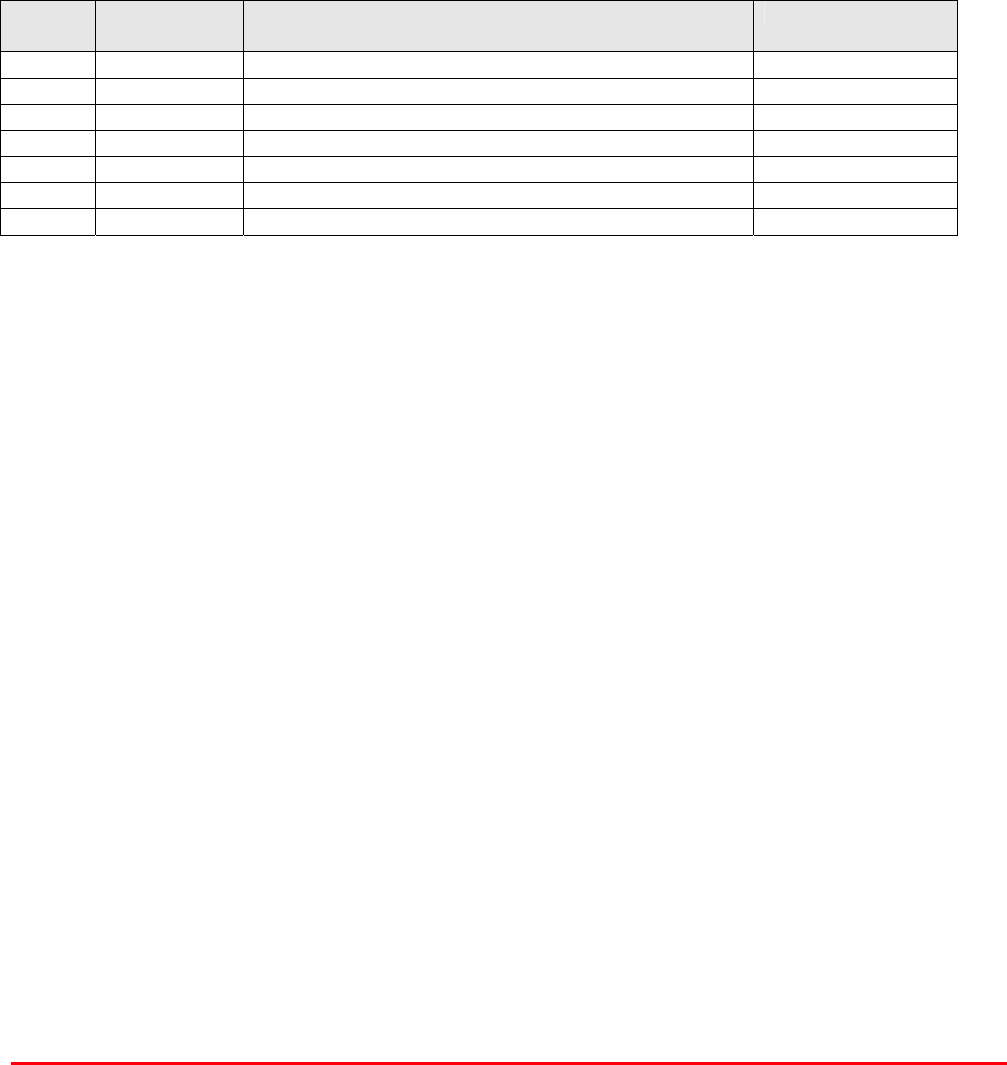
STTRS DOCUMENTATION
Document Number 80-330501HBKM – Issue A - Draft Page 175 of 500
11. UNIVERSITY STATION MASTER SITE 2 (80-330552-2)
Rack C05-CR-07
55-165601
55-165602
55-165603
98-800001
98-700002
55-165507
55-165601
55-165602
55-165711
University Station Master Site 2 (80-330552-2) list of major components
Section Component
Part Component Part Description Qty. Per Assembly
11.4.1. 55-165507 Fibre Optic Splitter 1
11.4.2. 55-165601 800MHz FO HUB AMP + FILTERS 2
11.4.3. 55-165602 700MHz FO Hub Amplifier 2
11.4.4. 55-165603 700MHz FO HUB Splitter/Combiner 1
11.4.5. 55-165712 UNIVERSITY ST. SPLITTER 2 1
11.4.6. 98-700002 Optical A/B Switch FC/APC 1
11.4.7. 98-800001 F/O Link Subsystem 1
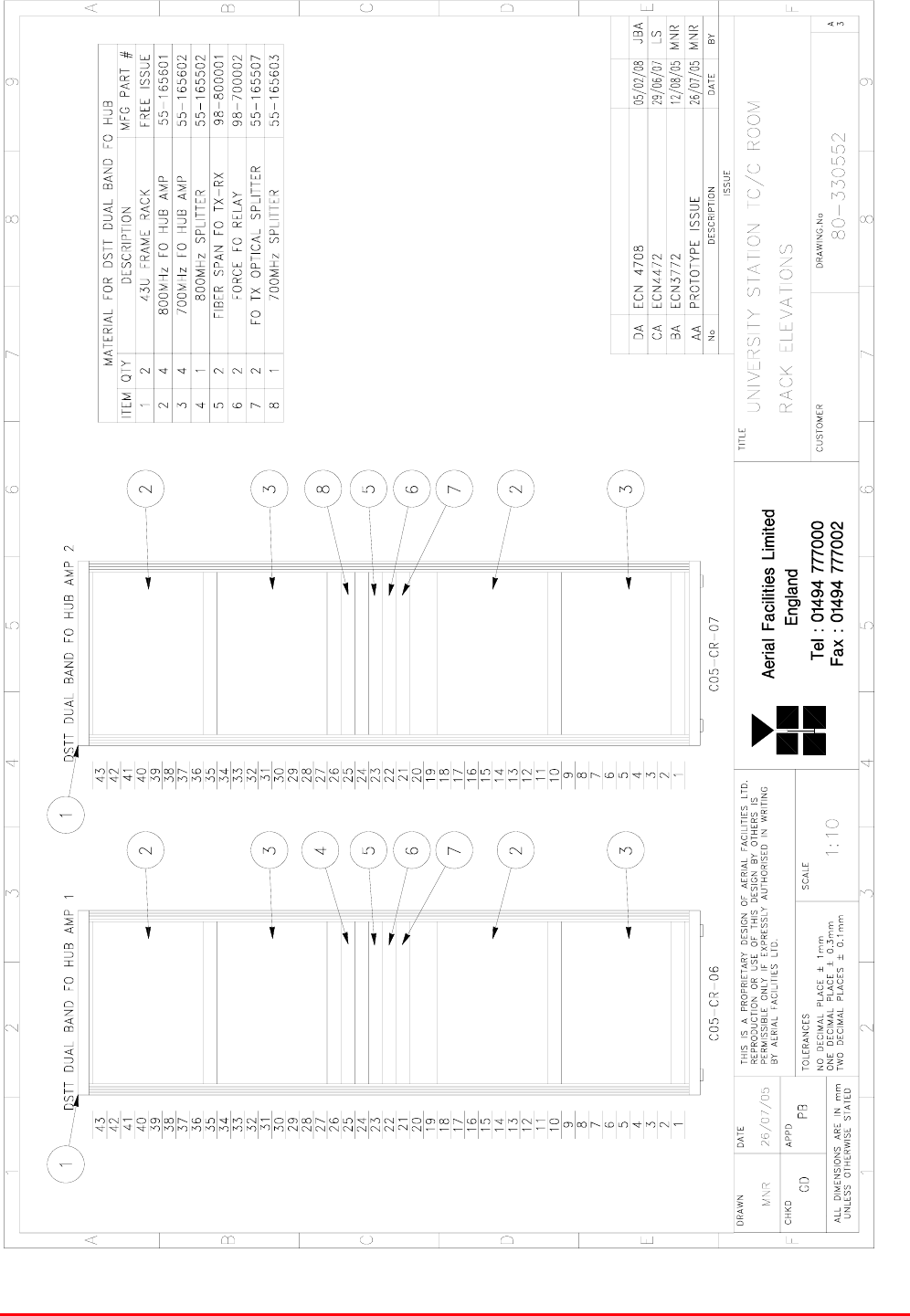
STTRS DOCUMENTATION
Document Number 80-330501HBKM – Issue A - Draft Page 176 of 500
11.1. University Station Master Site 2 (80-330552-1) Rack elevation
Drawing number 80-330552
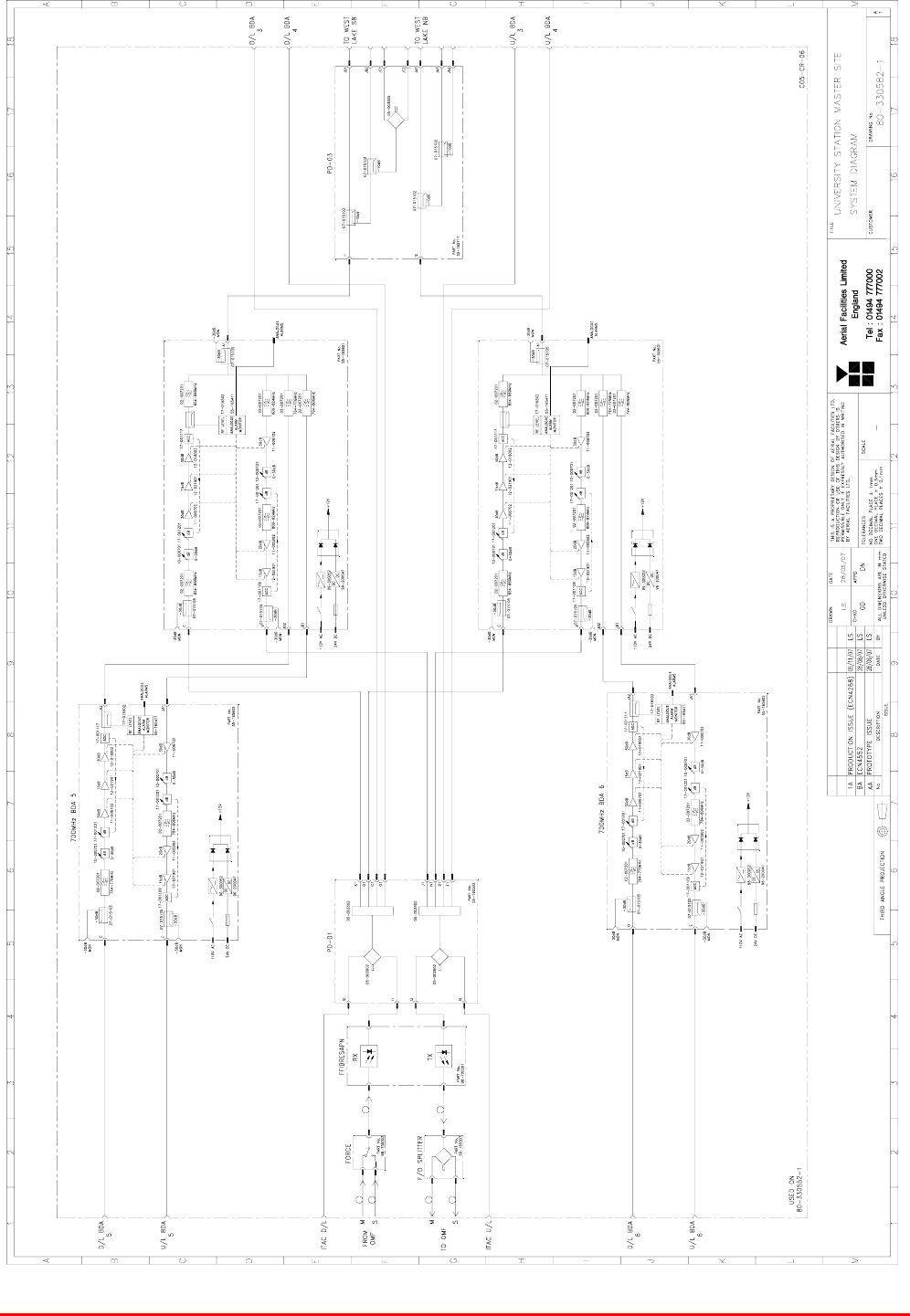
STTRS DOCUMENTATION
Document Number 80-330501HBKM – Issue A - Draft Page 177 of 500
11.2. University Station Master Site 2 (80-330552-1) system diagram
Drawing number 80-330582-1
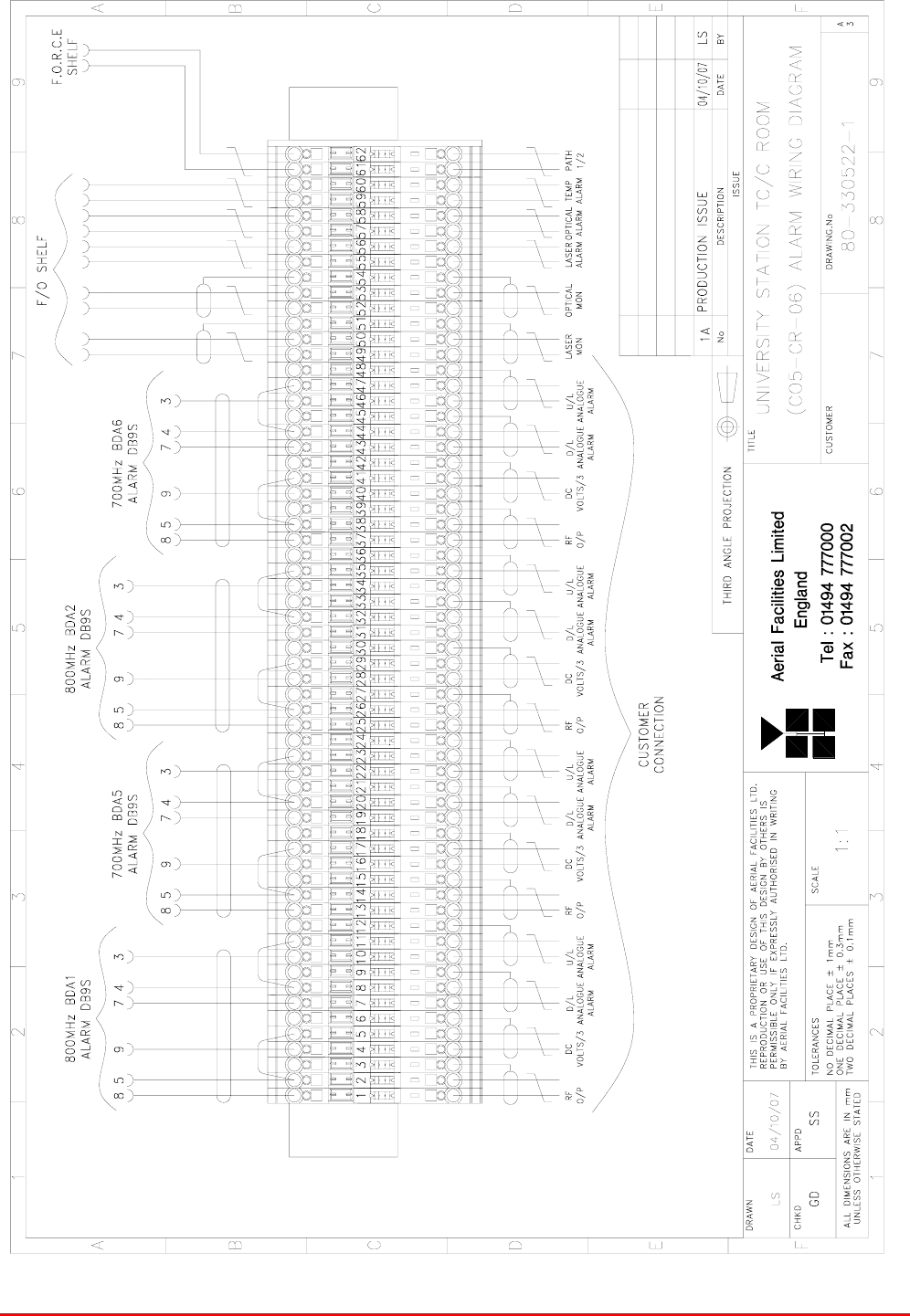
STTRS DOCUMENTATION
Document Number 80-330501HBKM – Issue A - Draft Page 178 of 500
11.3. University Station Master Site 2 (80-330552-1) Alarm Wiring Diagram
Drawing number 80-330522-1

STTRS DOCUMENTATION
Document Number 80-330501HBKM – Issue A - Draft Page 179 of 500
11.4 University Station Master Site 2 (80-330552-1) Major Components
11.4.1. Fibre Optic Splitter (55-165507)
Fibre Optic Splitter (55-165507) is a 1U rack mount tray containing an optical splitter/coupler
Fibre Optic Splitter (55-165507) List of Major Sub Components
Component
Part Component Part Description Qty. Per
Assembly
98-100001 Single Mode Optical Splitter/Coupler 1
11.4.1.1. Single Mode Optical Splitter/Coupler (98-100001)
Single Mode Optical Splitter/Couplers are used whenever it is necessary to split or combine outputs
from optical transmitters or inputs to receivers. Operators should be aware that a small insertion loss
(typically 3-4dB) is common with these type of couplers.
Single Mode Optical Splitter/Coupler (98-100001) It is an O.E.M unit featuring almost negligible
insertion loss to the F/O signal. Extreme caution should be exercised when handling these devices.
Special attention should be shown to the connectors; repair of a broken Splitter/Coupler is not
possible; replacement is the only option.
In the Fibre Optic Splitter (55-165507) in University Station Master Site 1 (80-330552-1), Single Mode
Optical Splitter/Coupler (98-100001) is used to split the optical signal from the FO TX module in F/O
Link Subsystem (98-700001) into two equal paths.

STTRS DOCUMENTATION
Document Number 80-330501HBKM – Issue A - Draft Page 180 of 500
11.4.2. 800MHz FO Hub Amplifier + Filters (55-165601)
Section Component
Part Component Part Description Qty. Per
Assembly
11.4.2.3. 02-007206 900MHZ 8POLE 25MHz+ B/W "SMA" 6
11.4.2.4. 07-015105 ASYMMETRIC CPLR 30dB 800-2500MHz GA 3
11.4.2.5. 10-000701 SW ATT 0-30dB 0.25W SMA F 2
11.4.2.6. 11-005902K 900MHz LOW NOISE AMP WITH RELAY KIT 1
11.4.2.7. 11-006702K 800-1000MHz LNA 29dB (cw RELAY) KIT 2
11.4.2.8. 12-018002K PA 800-960MHz 20W CLASS A KIT 1
11.4.2.9. 12-021901 Low Power Amplifier 2
17-001109* AGC Detector Assembly (Logarithmic) 1
17-001117* AGC Detector Assembly 1
11.4.2.10.
17-001201* AGC Attenuator Assembly 2
11.4.2.11. 20-001601 12V RELAY BOARD 1
11.4.2.12. 80-008901 12V RELAY PCB ASSEMBLY 1
11.4.2.13. 94-100004 STPS12045TV 60A DUAL DIODE 1
11.4.2.14. 96-200047 DC/DC Converter
11.4.2.15. 96-300052 JWS150-12/A PSU (COUTANT LAMBDA) 1
*The sub components 17-001109, 17-001117 & 17-001201 are parts of the Automatic Gain Control
(AGC) system used in 800MHz FO Hub Amplifier + Filters (55-165601); 17-001117 and 17-001201
are paired for use in the uplink and 17-001109 and 17-001201 are paired for use in the down link
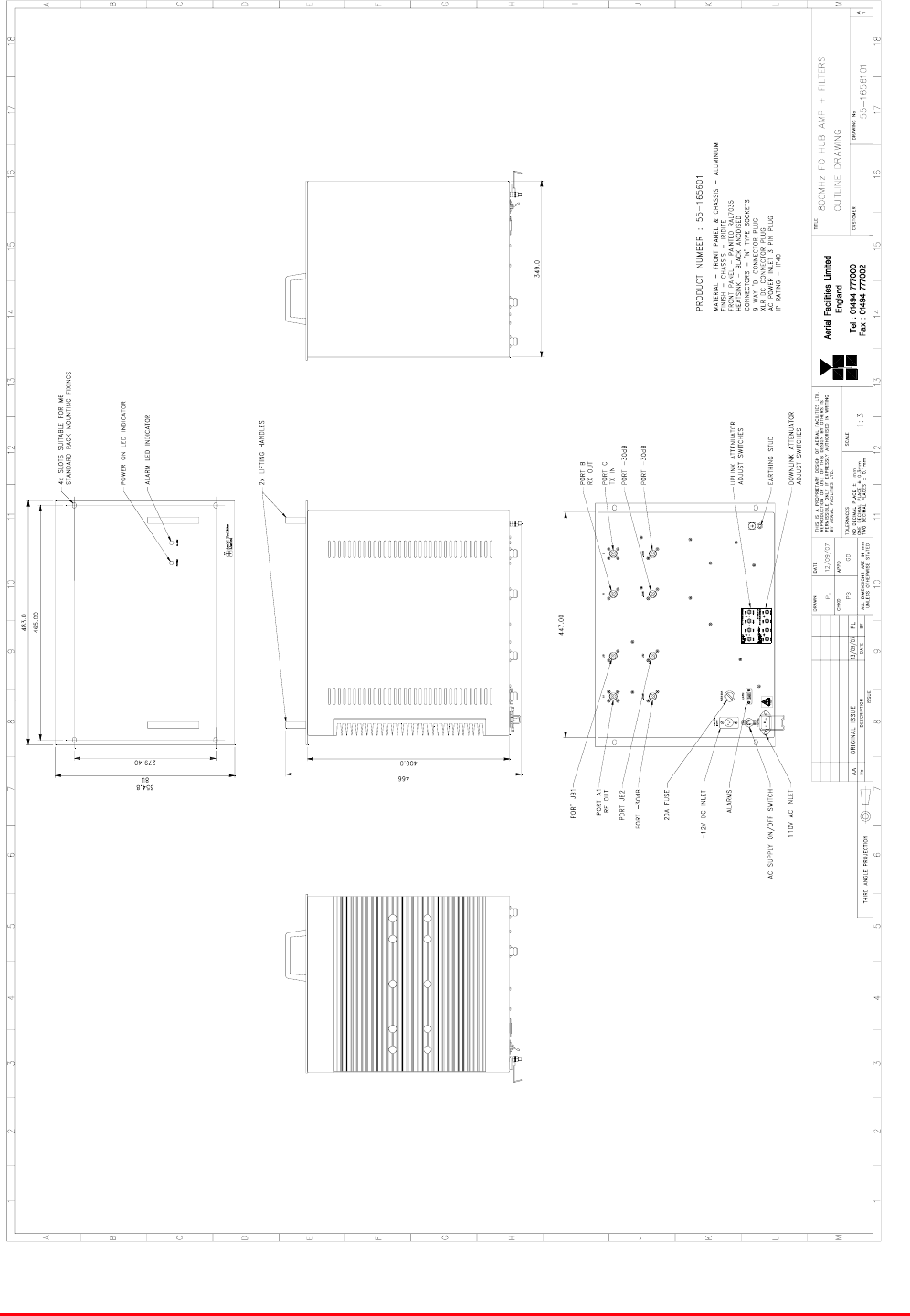
STTRS DOCUMENTATION
Document Number 80-330501HBKM – Issue A - Draft Page 181 of 500
11.4.2.1. 800MHz FO Hub Amplifier + Filters (55-165601) outline drawing
drawing number 55-1656101
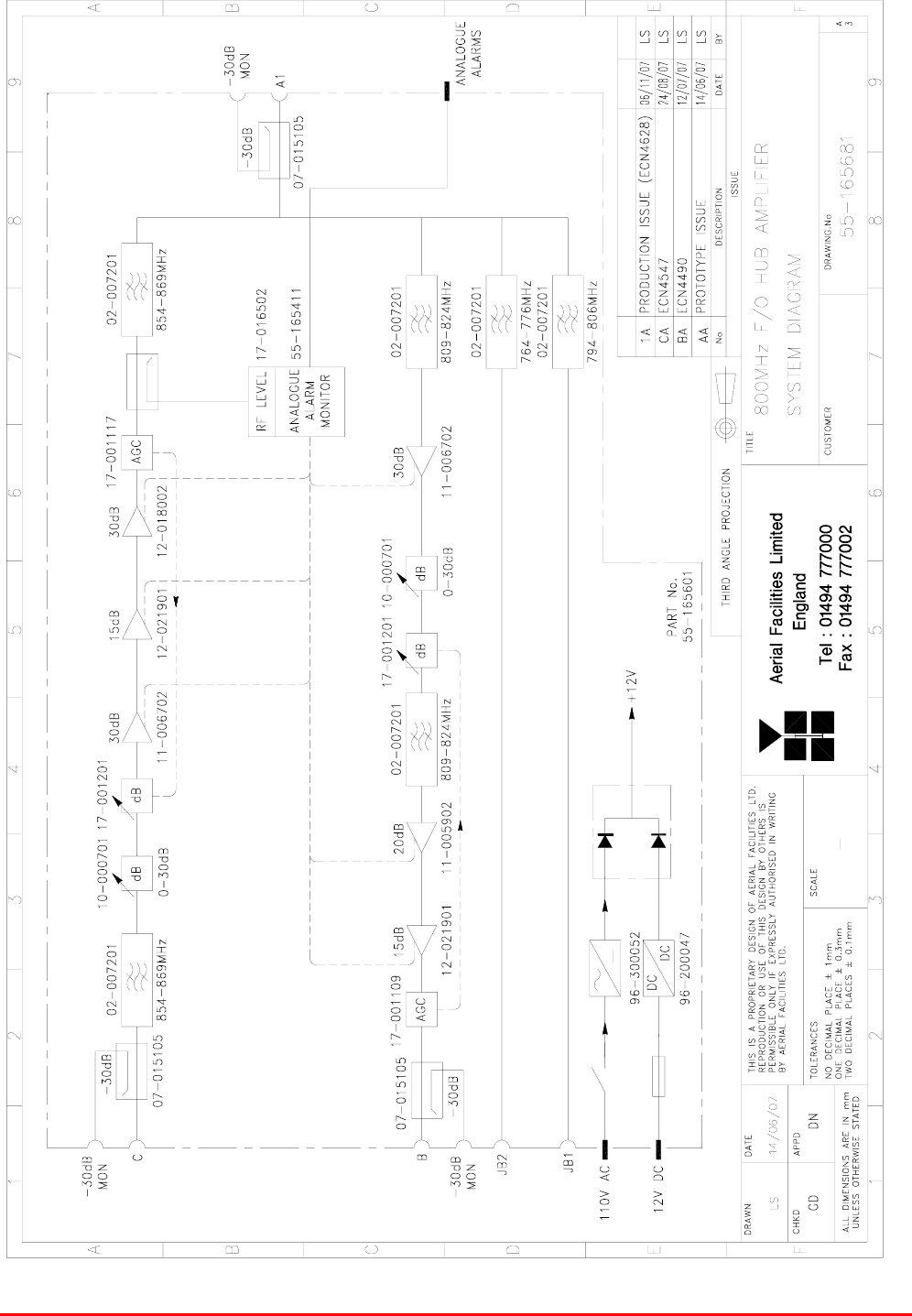
STTRS DOCUMENTATION
Document Number 80-330501HBKM – Issue A - Draft Page 182 of 500
11.4.2.2. 800MHz FO Hub Amplifier + Filters (55-165601) system diagram
drawing number 55-165681

STTRS DOCUMENTATION
Document Number 80-330501HBKM – Issue A - Draft Page 183 of 500
11.4.2.3. Bandpass Filter (02-007206)
The bandpass filters are multi-section designs with a bandwidth dependent upon the passband
frequencies, (both tuned to customer requirements). The response shape is basically Chebyshev with
a passband design ripple of 0.1dB. The filters are of slot coupled, folded combline design, and are
carefully aligned during manufacture in order to optimise the insertion loss, VSWR and
intermodulation characteristics of the unit. The tuned elements are silver-plated to reduce surface
ohmic losses and maintain a good VSWR figure and 50Ω load at the input and output ports.
Being passive devices, the bandpass filters should have an extremely long operational life and require
no maintenance. Should a filter be suspect, it is usually most time efficient to replace the module
rather than attempt repair or re-tuning.
No adjustments should be attempted without full network sweep analysis facilities to monitor both
insertion loss and VSWR simultaneously.
02-007206 Specification
PARAMETER SPECIFICATION
Response type Chebyshev
Frequency range 800 - 950MHz *
Bandwidth 25MHz *
Number of sections 8
Insertion loss 1.2 dB
VSWR better than 1.2:1
Connectors SMA female
Power handling 100W max
operation -20°C to +60°C Temperature
range storage -40°C to +70°C
Weight 3 kg (typical) *tuned to Customer's specification
11.4.2.4. Wideband Asymmetric Coupler (07-015105)
The purpose of Wideband Asymmetric Coupler (07-015105) is to tap off a known portion (in this case
30dB) of RF signal from transmission lines and to combine them, for example through splitter units for
different purposes (alarms/monitoring etc.), whilst maintaining an accurate 50Ω load to all
ports/interfaces throughout the specified frequency range. They are known formally as directional
couplers as they couple power from the RF mainline in one direction only.
07-015105 Specification
PARAMETER SPECIFICATION
Construction Inductive air gap
Frequency 800-2500MHz
Through loss 0.4dB (typical)
Coupling level -30dB ±0.5dB
Isolation N/A
Weight <1.0kg
Connectors SMA, female
operation -20°C to +60°C
Temperature
range storage -40°C to +70°C
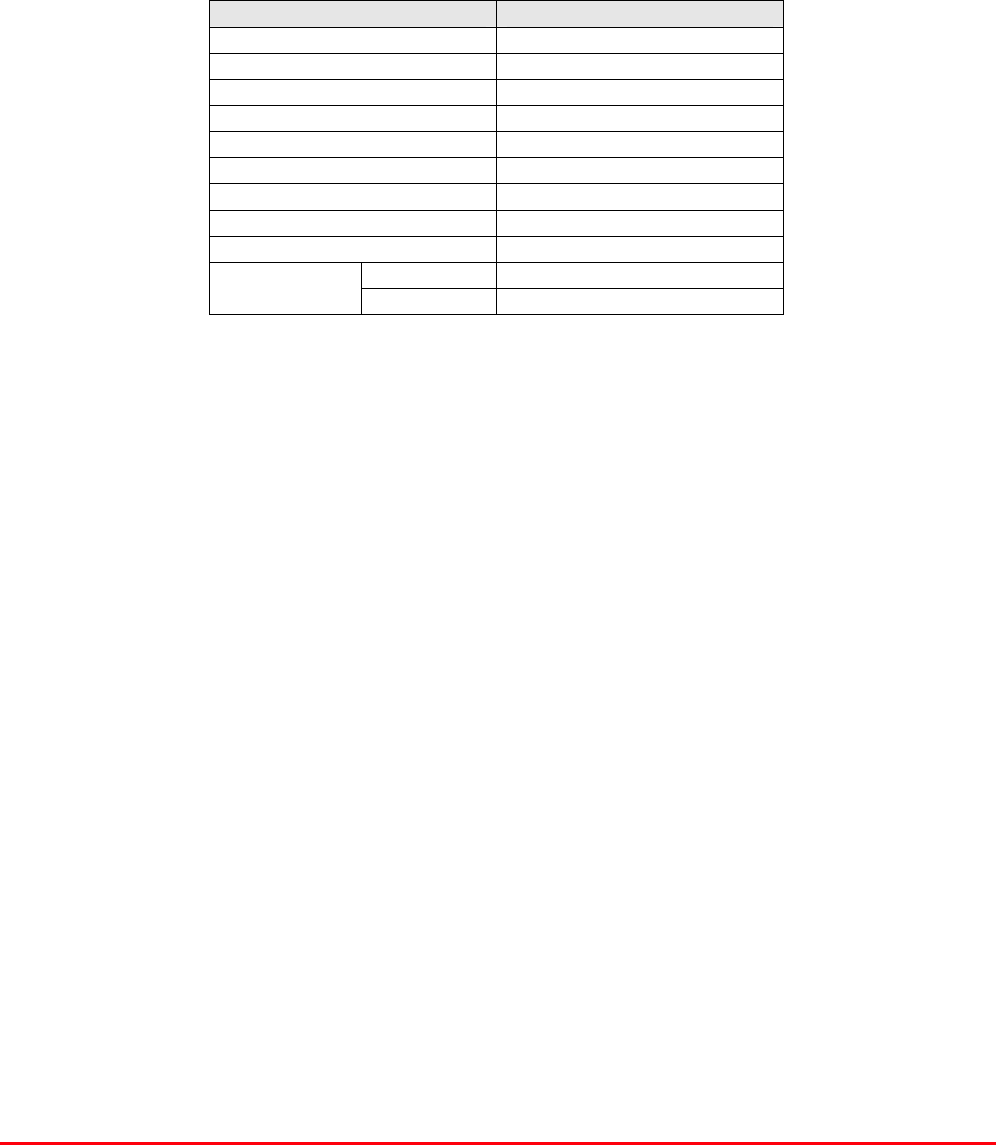
STTRS DOCUMENTATION
Document Number 80-330501HBKM – Issue A - Draft Page 184 of 500
11.4.2.5. Switched Attenuator 0.25Watt, 0 - 30dB (10-000701)
In many practical applications for Cell Enhancers etc., the gain in each path is found to be excessive.
Therefore, provision is made within the unit for the setting of attenuation in each path, to reduce the
gain.
Switched Attenuator 10-000701 provides attenuation from 0 to 30dB in 2 dB steps The attenuation is
simply set using the four miniature toggle switches on the top of each unit. Each switch is clearly
marked with the attenuation it provides, and the total attenuation in line is the sum of the values
switched in. They are designed to maintain an accurate 50Ω impedance over their operating
frequency at both input and output.
10-000701 Specification
PARAMETER SPECIFICATION
Attenuation Values 0-30dB
Attenuation Steps 2, 4, 8 and 16dB
Power Handling 0.25 Watt
Attenuation Accuracy ± 1.0 dB
Frequency Range DC to 1GHz
Impedance 50Ω
Connectors SMA
VSWR 1.3:1
Weight 0.2kg
operation -20°C to +60°C Temperature
range storage -40°C to +70°C
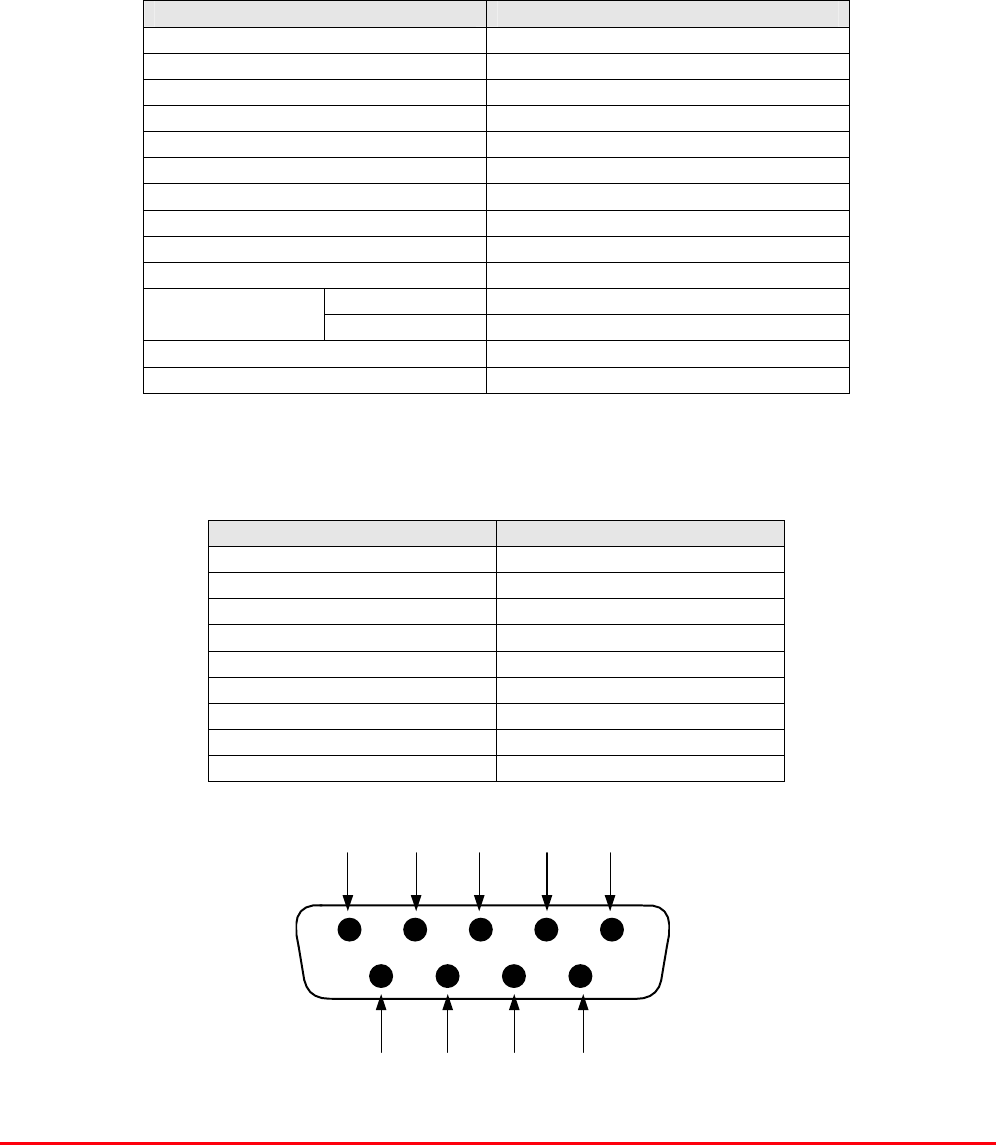
STTRS DOCUMENTATION
Document Number 80-330501HBKM – Issue A - Draft Page 185 of 500
11.4.2.6. Low Noise Amplifier (11-005902)
The Gallium-Arsenide low noise amplifier used in the unit is a double stage, solid-state low noise
amplifier. Class A circuitry is used throughout the units to ensure excellent linearity and extremely low
noise over a very wide dynamic range. The active devices are very moderately rated to provide a long
trouble-free working life. There are no adjustments on these amplifiers, and in the unlikely event of a
failure, then the complete amplifier should be replaced. This amplifier features its own in-built alarm
system which gives a volt-free relay contact type alarm that is easily integrated into any alarm system.
There is a Current Fault Alarm Function, which indicates failure of each one or both RF transistors by
a various alarm output options. The amplifier is housed in an aluminium case (Iridite NCP finish) with
SMA connectors for the RF input/output and a 9way D-type for DC and alarm outputs.
11-005902 Specification
PARAMETER SPECIFICATION
Frequency range: 800 – 960MHz *
Bandwidth: <170MHz
Gain: 19.5dB (typical)
1dB compression point: 21dBm
OIP3: 33dBm
Input/output return loss: >20dB
Noise figure: 1dB (typical)
Power consumption: 190mA @ 24V DC
Supply voltage: 10-24V DC
Connectors: SMA female
operational: -10°C to +60°C Temperature
range storage: -40°C to +70°C
Size: 90 x 55 x 30.2mm
Weight: 0.28kg *tuned to Customer's specification
LNA ‘D’ Connector Pin-out details
Connector pin Signal
1 +Ve input (10-24V)
2 GND
3 Alarm relay O/P bad
4 Alarm relay common
5 Alarm relay good
6 No connection
7 TTL voltage set
8 TTL alarm/0V (good)
9 O/C good/0V bad
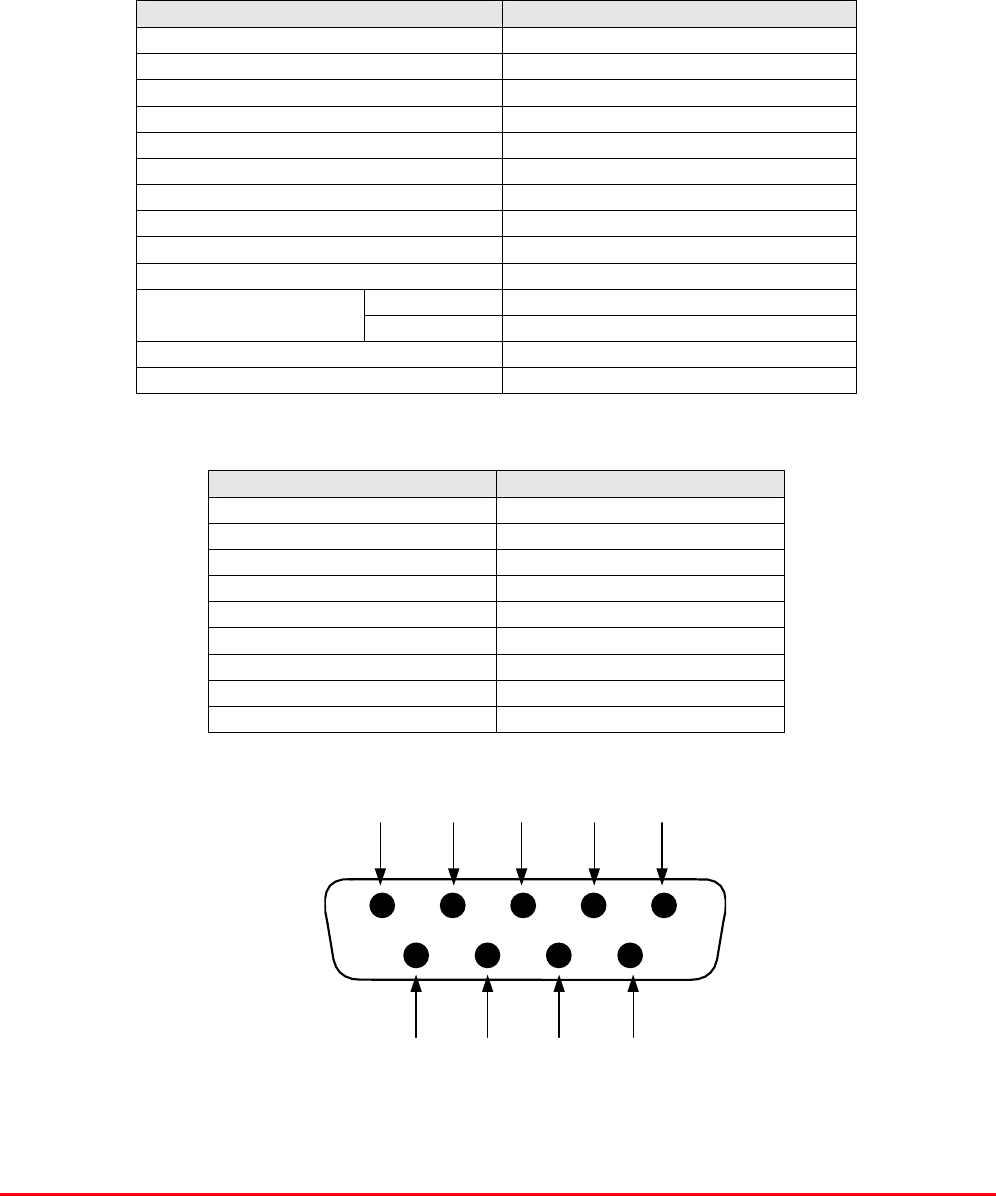
STTRS DOCUMENTATION
Document Number 80-330501HBKM – Issue A - Draft Page 186 of 500
7 8 96
1 2 3 4 5
9-Way Pin-Out Graphical Representation
11.4.2.7. Low Noise Amplifier (11-006702)
The Gallium-Arsenide low noise amplifiers used in 800MHz Line Amplifier (55-165703) are double
stage, solid-state low noise amplifiers. Class A circuitry is used throughout the units to ensure
excellent linearity and extremely low noise over a very wide dynamic range. The active devices are
very moderately rated to provide a long trouble-free working life. There are no adjustments on these
amplifiers, and in the unlikely event of a failure, then the complete amplifier should be replaced. This
amplifier features its own in-built alarm system which gives a volt-free relay contact type alarm that is
easily integrated into the main alarm system.
11-006702 Specification
PARAMETER SPECIFICATION
Frequency range: 800 – 1000MHz
Bandwidth: <200MHz
Gain: 29dB (typical)
1dB Compression point: 20dBm
OIP3: 33dBm
Input/Output return loss: >18dB
Noise figure: 1.3dB (typical)
Power consumption: 180mA @ 24V DC
Supply voltage: 10-24V DC
Connectors: SMA female
operational: -10°C to +60°C
Temperature range: storage: -20°C to +70°C
Size: 90 x 55 x 30.2mm
Weight: 290gms (approximately)
Low Noise Amplifier (11-006702) ‘D’ Connector Pin-out details
Connector pin Signal
1 +Ve input (10-24V)
2 GND
3 Alarm RelayO/P bad
4 Alarm Relay common
5 Alarm Relay good
6 No connection
7 TTL voltage set
8 TTL alarm/0V (good)
9 O/C good/0V bad
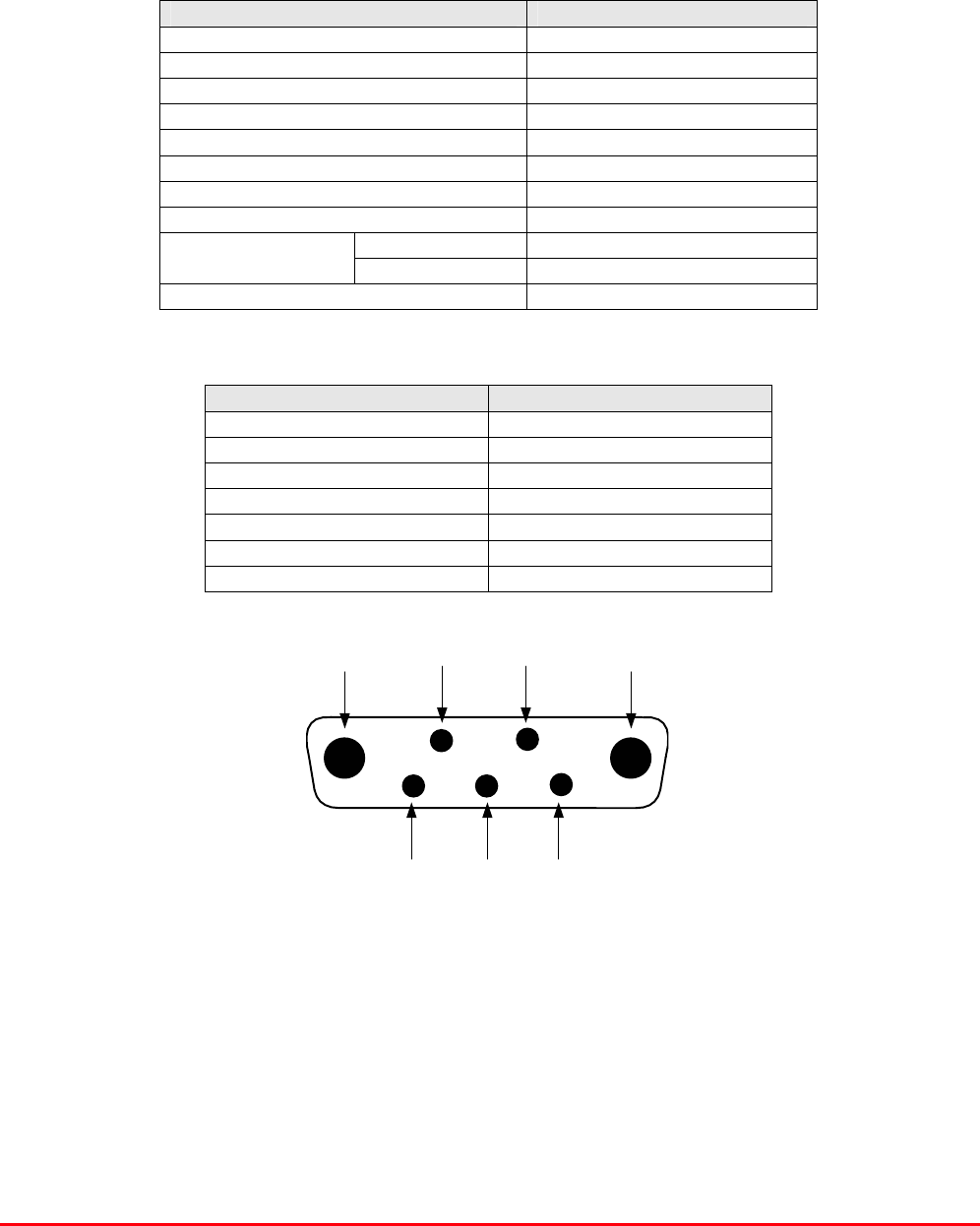
STTRS DOCUMENTATION
Document Number 80-330501HBKM – Issue A - Draft Page 187 of 500
11.4.2.8. Power Amplifier (12-018002)
This amplifier is a Class A 20W power amplifier from 800-960MHz in a 1 stage balanced
configuration. It demonstrates a very high linearity and a very good input/output return loss (RL). It
has built in a Current Fault Alarm Function.
Its housing is an aluminium case (Iridite NCP finish) with SMA connectors for the RF input/output and
a D-Type connector for the power supply and the Current Fault Alarm Function.
12-018002 Specification
PARAMETER SPECIFICATION
Frequency range: 800-960MHz
Small signal gain: 30dB
Gain flatness: ±1.2dB
I/O Return loss: >18dB
1dB compression point: 42.8dBm
OIP3: 56dBm
Supply voltage: 24V DC
Supply current: 5.0Amps (Typical)
operational: -10°C to +60°C Temperature
range storage: -20°C to +70°C
Weight: <2kg (no heatsink)
Power Amplifier (12-018002) 7-Way Connector Pin-outs
Connector Pin Signal
A1 (large pin) +24V DC
A2 (large pin) GND
1 Alarm relay common
2 TTL alarm/0V good
3 Alarm relay contact (bad)
4 Alarm relay contact (good)
5 O/C good/0V bad (TTL)
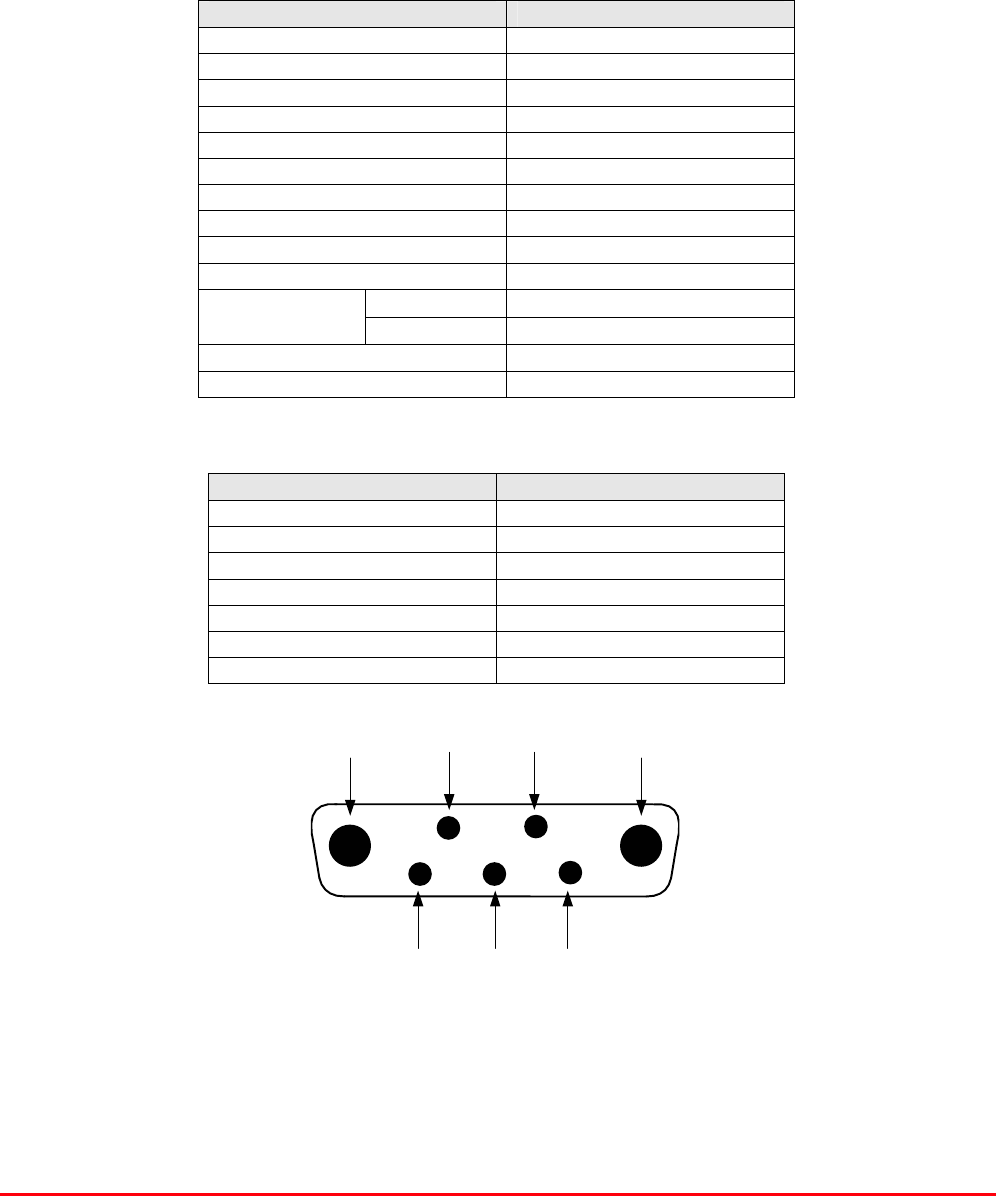
STTRS DOCUMENTATION
Document Number 80-330501HBKM – Issue A - Draft Page 188 of 500
11.4.2.9. Low Power Amplifier (12-021901)
The low power amplifier used is a triple stage solid-state low-noise amplifier. Class A circuitry is used
in the unit to ensure excellent linearity over a very wide dynamic range. The three active devices are
very moderately rated to provide a long trouble-free working life.
Its housing is an aluminium case (Iridite NCP finish) with SMA connectors for the RF input/output and
a D-Type connector for the power supply and the Current Fault Alarm Function.
There are no adjustments on this amplifier, and in the unlikely event of failure then the entire amplifier
should be replaced.
Low Power Amplifier (12-021901) Specification
PARAMETER SPECIFICATION
Frequency range 800-960MHz*
Bandwidth 20MHz *
Maximum RF output >1.0 Watt
Gain 15dB
1dB compression point +30.5dBm
3rd order intercept point +43dBm
Noise Figure <6dB
VSWR better than 1.5:1
Connectors SMA female
Supply 500mA @ 10-15V DC
operational -10°C to +60°C
Temperature
range storage -20°C to +70°C
Weight 0.5 kg
Size 167x52x25mm
* Tuned to Customer’s specification
Low Power Amplifier (12-021901) 7-Way Connector Pin-outs
Connector Pin Signal
A1 (large pin) +24V DC
A2 (large pin) GND
1 Alarm relay common
2 TTL alarm/0V good
3 Alarm relay contact (bad)
4 Alarm relay contact (good)
5 O/C good/0V bad (TTL)

STTRS DOCUMENTATION
Document Number 80-330501HBKM – Issue A - Draft Page 189 of 500
11.4.2.10. Automatic Gain Control
17-001109 AGC Detector Assembly (Logarithmic)
17-001117 AGC Detector Assembly
17-001201 AGC Attenuator Assembly
The sub components 17-001109, 17-001117 & 17-001201 are parts of the Automatic Gain Control
(AGC) system used in 800MHz FO Hub Amplifier + Filters (55-165601); 17-001117 and 17-001201
are paired for use in the uplink and 17-001109 and 17-001201 are paired for use in the down link
800MHz FO Hub Amplifier + Filters (55-165601) is fitted with two differing types of Automatic Gain
Control (AGC) system, one linear, and one logarithmic. The AGC with logarithmic detector (17-
001117) is fitted in the uplink path and the AGC with linear detector (17-001109) is fitted in the
downlink path
The AFL Automatic Gain Control system consists of two units, a detector/amplifier and an attenuator.
The detector/amplifier unit is inserted in the RF path on the output of the power amplifier, and the
attenuator is situated in the RF path between the 1st and 2nd stages of amplification.
17-001117 and 17-001201 are paired for use in the uplink and 17-001109 and 17-001201 are paired
for use in the down link
The attenuator comprises a 50Ω P.I.N diode, voltage-variable attenuator with a range of 3 to 30dB.
The attenuation is controlled by a DC voltage which is derived from the associated detector controller
board.
Normally the attenuator is at minimum attenuation. The detector/amplifier unit monitors the RF level
being delivered by the power amplifier, and when a certain threshold is reached it begins to increase
the value of the attenuator to limit the RF output to the (factory set) threshold. Therefore overloading
of the power amplifier is avoided.
The factory set threshold is 1dB below the Enhancer 1dB compression point. Some adjustment of this
AGC threshold level is possible, a 10dB range is mostly achieved. It is not recommended under any
circumstances to adjust the AGC threshold to a level greater than the 1dB compression point as
system degradation will occur.
The detector comprises of a 50Ω transmission line with a resistive tap which samples a small portion
of the mainline power. The sampled signal is amplified and fed to a conventional half wave diode
rectifier, the output of which is a DC voltage proportional to the RF input signal.
This DC voltage is passed via an inverting DC amplifier with integrating characteristics, to the output,
which drives the attenuation control line of the corresponding AGC attenuator. This unit is fitted at
some earlier point in the RF circuit.
For small signals, below AGC onset, the output control line will be close to 12V and the AGC
attenuator will have minimum attenuation. As the signal level increases the control line voltage will
fall, increasing the attenuator value and keeping the system output level at a constant value.
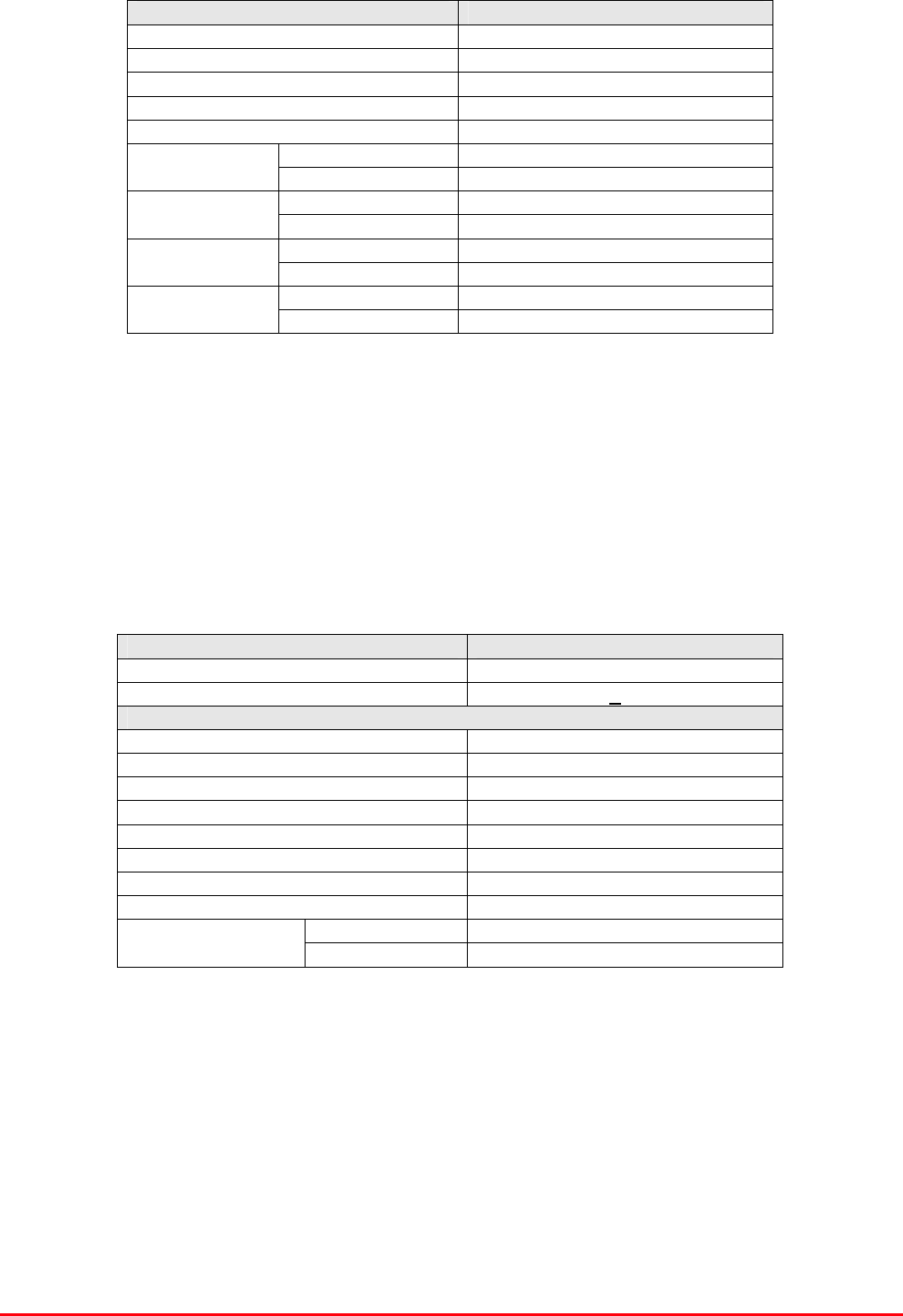
STTRS DOCUMENTATION
Document Number 80-330501HBKM – Issue A - Draft Page 190 of 500
AGC Specification (both types)
PARAMETER SPECIFICATION
Frequency range up to 1000MHz
Attenuation range 3 to 30dB
Attenuation steps continuously variable
VSWR better than 1.2:1
RF Connectors SMA female
attenuator 1W Power
handling detector/amp >30W (or as required)
operation -10°C to +60°C Temperature
range storage -20°C to +70°C
attenuator pcb 50 x 42 x 21mm
Size detector/amp pcb 54 x 42 x 21mm
attenuator 90grams
Weight detector/amp 100grams
11.4.2.11. 12V (Dual) Relay Board (20-001601)
The General Purpose Relay Board allows the inversion of signals and the isolation of circuits. It is
equipped with two dual pole change-over relays with completely isolated wiring, accessed via screw
terminals. Both relays are provided with polarity protection diodes and diodes for suppressing the
transients caused by "flywheel effect" which can destroy switching transistors or induce spikes on
neighbouring circuits. It’s common use is to amalgamate all the alarm signals into one, volts-free relay
contact pair for the main alarm system.
20-001601 Specification
PARAMETER SPECIFICATION
Operating voltage: 8 to 30V (floating earth)
Alarm threshold: Vcc - 1.20 volt +15%
Alarm output relay contacts:
Max. switch current: 1.0Amp
Max. switch volts: 120Vdc/60VA
Max. switch power: 24W/60VA
Min. switch load: 10.0µA/10.0mV
Relay isolation: 1.5kV
Mechanical life: >2x107 operations
Relay approval: BT type 56
Connector details: Screw terminals
operational: -10°C to +60°C Temperature
range storage: -20°C to +70°C
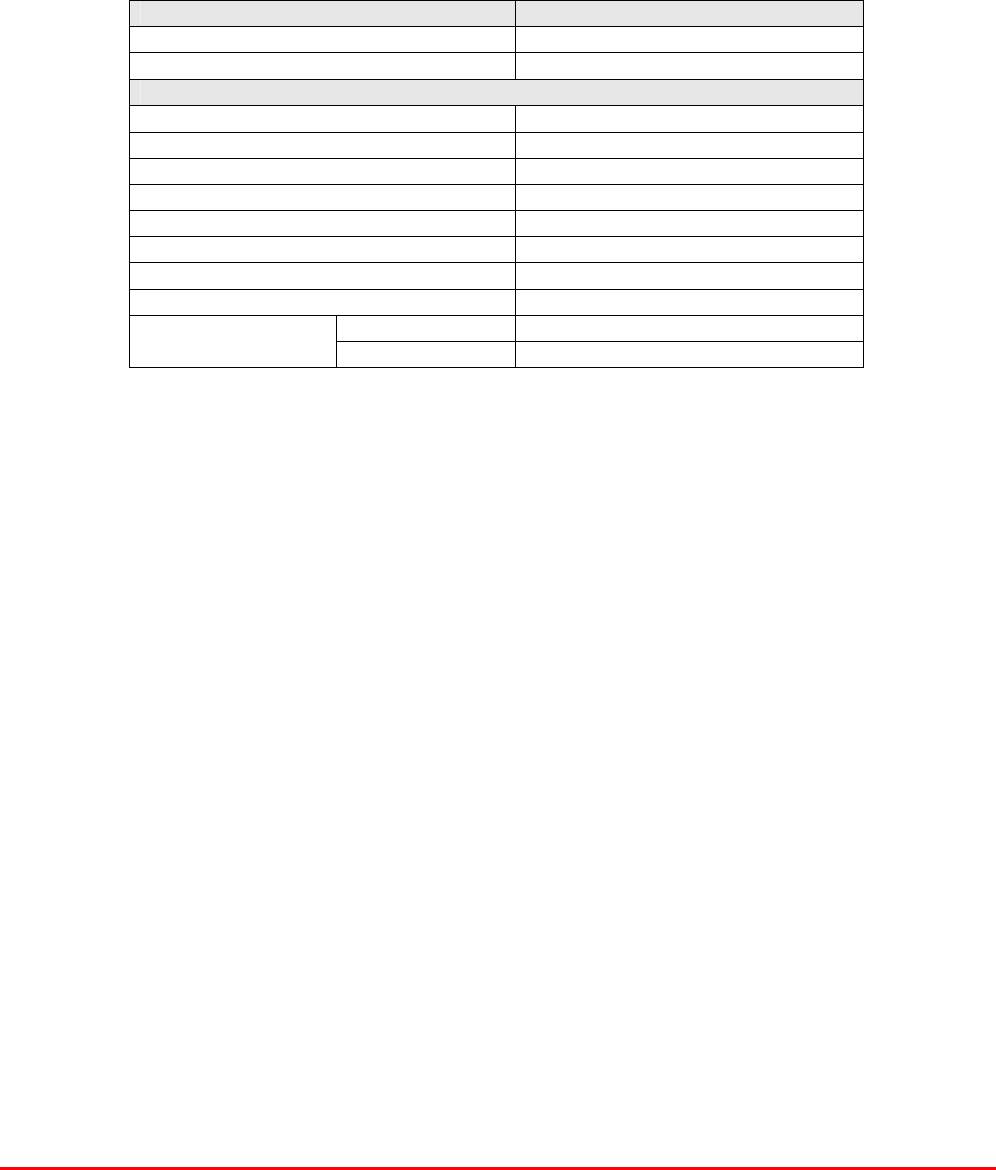
STTRS DOCUMENTATION
Document Number 80-330501HBKM – Issue A - Draft Page 191 of 500
11.4.2.12. 12V (Single) Relay Board (80-008901)
The General Purpose Relay Board allows the inversion of signals and the isolation of circuits. It is
equipped with a single dual pole change-over relay RL1, with completely isolated wiring, accessed
via a 15 way in-line connector.
The relay is provided with polarity protection diodes and diodes for suppressing the transients caused
by "flywheel effect" which can destroy switching transistors or induce spikes on neighbouring circuits.
It’s common use is to amalgamate all the alarm signals into one, volts-free relay contact pair for the
main alarm system.
80-008901 Specification
PARAMETER SPECIFICATION
Operating voltage 8 to 30V (floating earth)
Alarm threshold Vcc - 1.20 volt +15%
Alarm output relay contacts:
Max. switch current 1.0Amp
Max. switch volts 120Vdc/60VA
Max. switch power 24W/60VA
Min. switch load 10.0µA/10.0mV
Relay isolation 1.5kV
Mechanical life >2x107 operations
Relay approval BT type 56
Connector details Screw terminals
operational -10°C to +60°C Temperature
range storage -20°C to +70°C
11.4.2.13. Dual Diode Assembly (94-100004)
The purpose of these dual diode assemblies is to allow two DC voltage sources to be combined, so
that the main DC rail within the equipment can be sourced from either a mains driven PSU, or
externally through an XLR connector or from dual mains driven PSUs. They are very heavy-duty
diodes and they prevent any reverse current from flowing back to their source or the alternative
supply rail. Combining diodes such as these will also be used if the equipment is to be powered from
external back-up batteries.
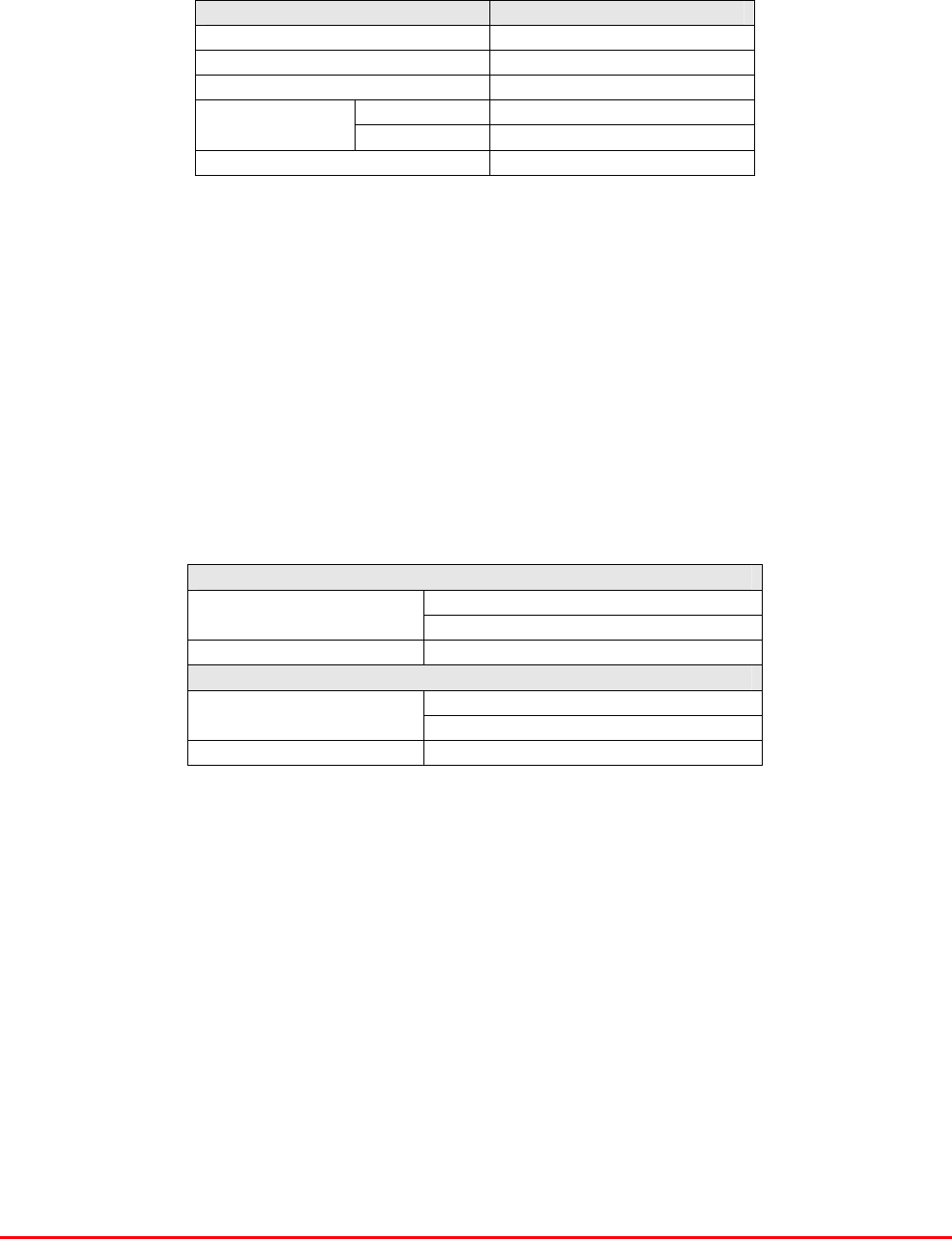
STTRS DOCUMENTATION
Document Number 80-330501HBKM – Issue A - Draft Page 192 of 500
11.4.2.14. DC/DC Converter 96-200047
96-200047 is an O.E.M. high power device with a wide input range and 12.5 amp @ 12V (150Watts)
output capability used to derive a 12V fixed voltage power supply rail from a higher voltage supply, in
this case 12V. In the event of failure this unit should not be repaired, only replaced.
96-200047 Specification
PARAMETER SPECIFICATION
DC Input Voltage range 19 to 36V
DC Output voltage 12V ± 1%
Max. current load 12.5Amps
Operation -10°C to +60°C Temperature
range Storage -20°C to +85°C
Working Humidity 20 to 90% RHNC
11.4.2.15. 12V Switch-Mode PSU (96-300052)
No routine maintenance of the PSU is required. If a fault is suspected, then the output voltage from
the power supply may be measured on its output terminals. This is typically set to 12.2V. The
adjustment potentiometer will be found close to the DC output terminals.
All the PSUs used in AFL Cell Enhancers are capable of operation from either 110 or 220V nominal
AC supplies. The line voltage is sensed automatically, so no adjustment or link setting is needed by
the operator.
96-300052 Specification
AC Input Supply 110 or 220V nominal
Voltage 85 - 265V AC (absolute limits)
Frequency 47 to 63Hz
DC Output Supply 12V DC (nominal)
Voltage 10.5-13.8V (absolute limits)
Current 12.5A
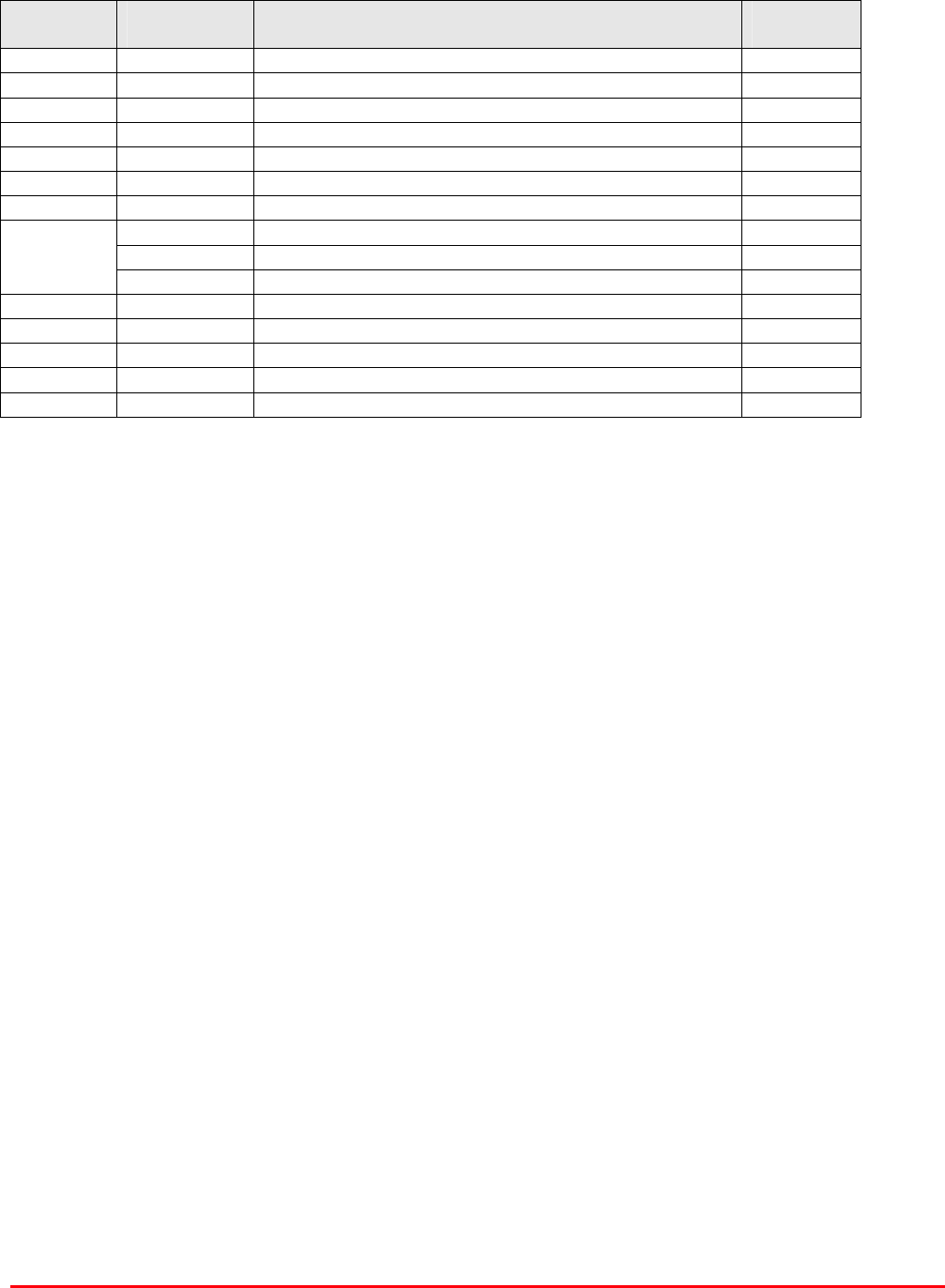
STTRS DOCUMENTATION
Document Number 80-330501HBKM – Issue A - Draft Page 193 of 500
11.4.3. 700MHz FO Hub Amplifier (55-165602)
700MHz FO Hub Amplifier (55-165602) List of major components
Section Component
Part Component Part Description Qty. Per
Assembly
11.4.3.3. 02-007206 900MHZ 8POLE 25MHz+ B/W "SMA" 2
11.4.3.4. 07-015105 ASYMMETRIC CPLR 30dB 800-2500MHz GA 2
11.4.3.5. 10-000701 SW ATT 0-30dB 0.25W SMA F 2
11.4.3.6. 11-005902 900MHz LOW NOISE AMP WITH RELAY KIT 1
11.4.3.7. 11-006702 800-1000MHz LNA 29dB (cw RELAY) KIT 2
11.4.3.8. 12-018002 PA 800-960MHz 20W CLASS A KIT 1
11.4.3.9. 12-021901 Low Power Amplifier 2
17-001109 AGC Detector Assembly (Logarithmic) 1
17-001117 AGC Detector Assembly 1
11.4.3.10.
17-001201 AGC Attenuator Assembly 2
11.4.3.11. 20-001601 12V RELAY BOARD 1
11.4.3.12. 80-008901 12V RELAY PCB ASSEMBLY 1
11.4.3.13. 94-100004 STPS12045TV 60A DUAL DIODE 1
11.4.3.14. 96-200047 DC/DC Converter
11.4.3.15. 96-300052 JWS150-12/A PSU (COUTANT LAMBDA) 1
*The sub components 17-001109, 17-001117 & 17-001201 are parts of the Automatic Gain Control
(AGC) system used in 700MHz FO Hub Amplifier (55-165602); 17-001117 and 17-001201 are paired
for use in the uplink and 17-001109 and 17-001201 are paired for use in the downlink
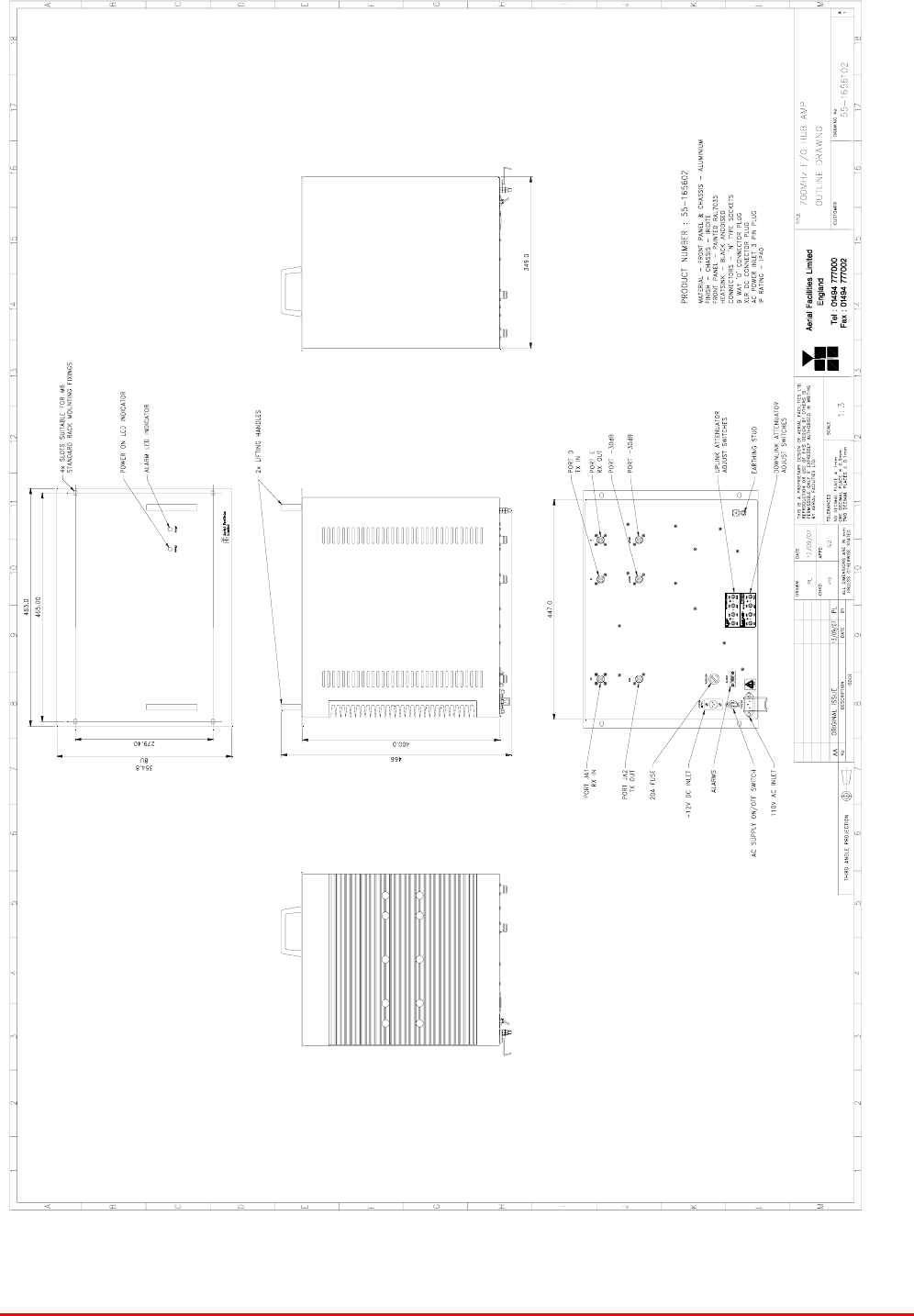
STTRS DOCUMENTATION
Document Number 80-330501HBKM – Issue A - Draft Page 194 of 500
11.4.3.1. 700MHz FO Hub Amplifier (55-165602) outline drawing
drawing number 55-1656102
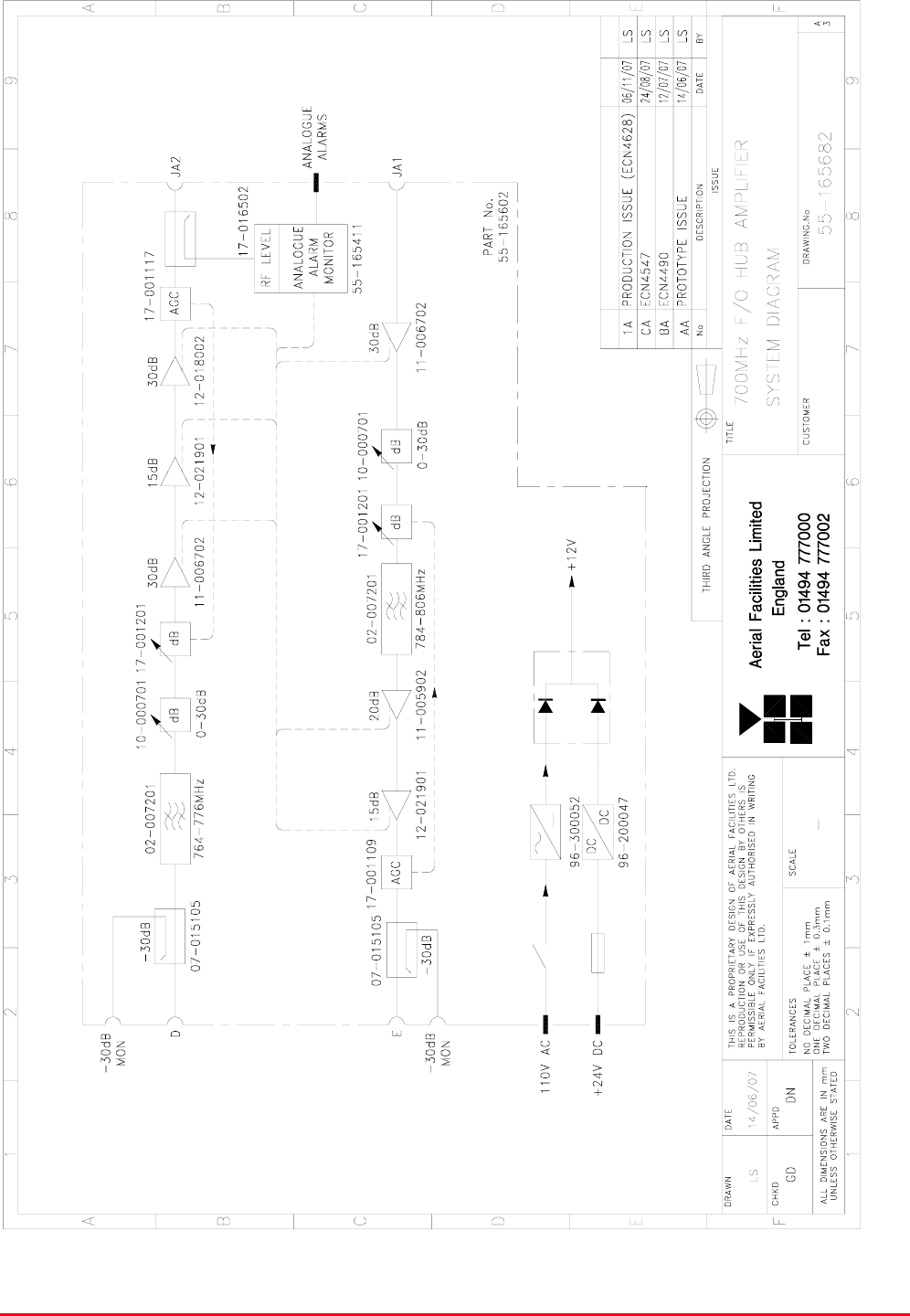
STTRS DOCUMENTATION
Document Number 80-330501HBKM – Issue A - Draft Page 195 of 500
11.4.3.2. 700MHz FO Hub Amplifier (55-165602) system diagram
drawing number 55-165682

STTRS DOCUMENTATION
Document Number 80-330501HBKM – Issue A - Draft Page 196 of 500
11.4.3.3. Bandpass Filter (02-007206)
The bandpass filters are multi-section designs with a bandwidth dependent upon the passband
frequencies, (both tuned to customer requirements). The response shape is basically Chebyshev with
a passband design ripple of 0.1dB. The filters are of slot coupled, folded combline design, and are
carefully aligned during manufacture in order to optimise the insertion loss, VSWR and
intermodulation characteristics of the unit. The tuned elements are silver-plated to reduce surface
ohmic losses and maintain a good VSWR figure and 50Ω load at the input and output ports.
Being passive devices, the bandpass filters should have an extremely long operational life and require
no maintenance. Should a filter be suspect, it is usually most time efficient to replace the module
rather than attempt repair or re-tuning.
No adjustments should be attempted without full network sweep analysis facilities to monitor both
insertion loss and VSWR simultaneously.
02-007206 Specification
PARAMETER SPECIFICATION
Response type Chebyshev
Frequency range 800 - 950MHz *
Bandwidth 25MHz *
Number of sections 8
Insertion loss 1.2 dB
VSWR better than 1.2:1
Connectors SMA female
Power handling 100W max
operation -20°C to +60°C Temperature
range storage -40°C to +70°C
Weight 3 kg (typical) *tuned to Customer's specification
11.4.3.4. Wideband Asymmetric Coupler (07-015105)
The purpose of Wideband Asymmetric Coupler (07-015105) is to tap off a known portion (in this case
30dB) of RF signal from transmission lines and to combine them, for example through splitter units for
different purposes (alarms/monitoring etc.), whilst maintaining an accurate 50Ω load to all
ports/interfaces throughout the specified frequency range. They are known formally as directional
couplers as they couple power from the RF mainline in one direction only.
07-015105 Specification
PARAMETER SPECIFICATION
Construction Inductive air gap
Frequency 800-2500MHz
Through loss 0.4dB (typical)
Coupling leve: -30dB ±0.5dB
Isolation N/A
Weight <1.0kg
Connectors SMA, female
operation -20°C to +60°C
Temperature
range storage -40°C to +70°C
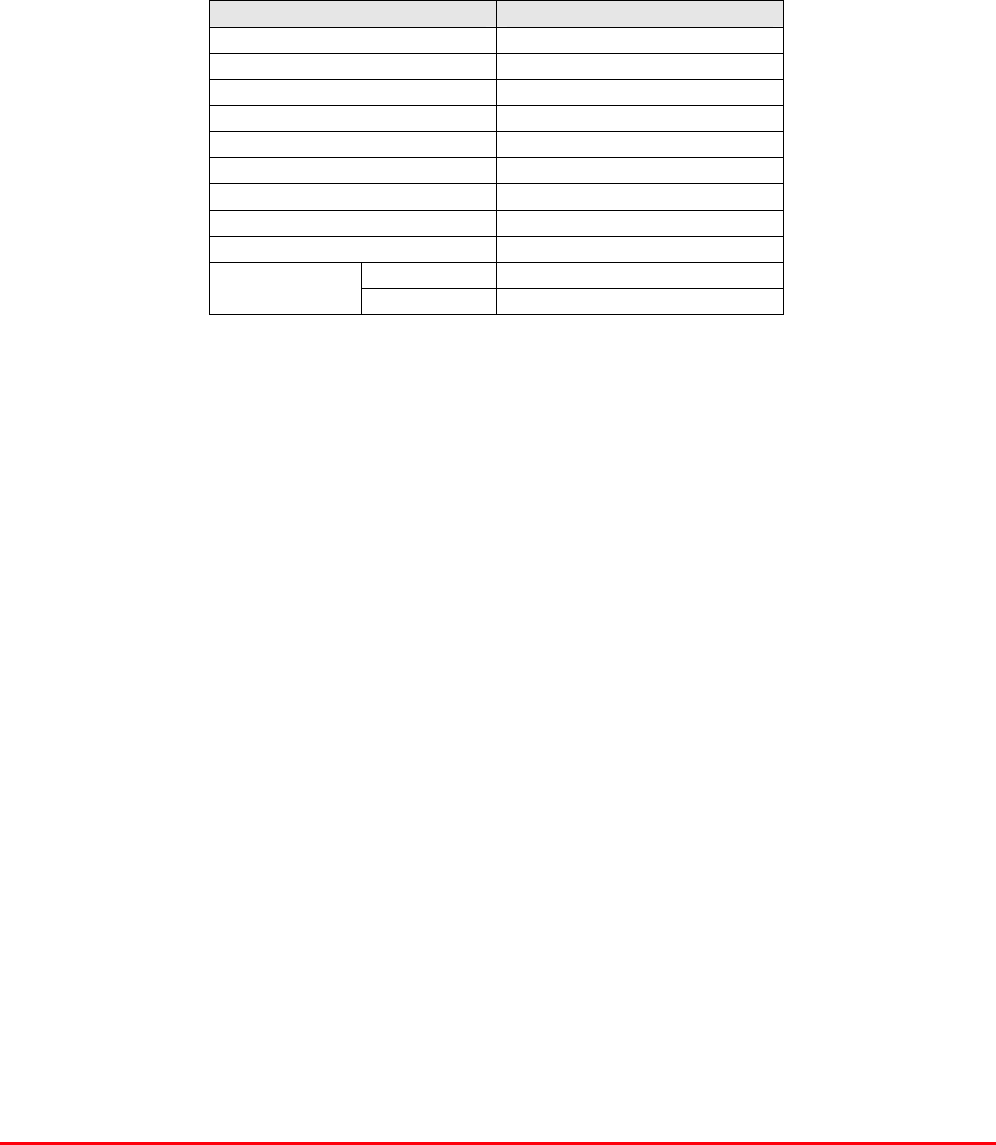
STTRS DOCUMENTATION
Document Number 80-330501HBKM – Issue A - Draft Page 197 of 500
11.4.3.5. Switched Attenuator 0.25Watt, 0 - 30dB (10-000701)
In many practical applications for Cell Enhancers etc., the gain in each path is found to be excessive.
Therefore, provision is made within the unit for the setting of attenuation in each path, to reduce the
gain.
Switched Attenuator 10-000701 provides attenuation from 0 to 30dB in 2 dB steps The attenuation is
simply set using the four miniature toggle switches on the top of each unit. Each switch is clearly
marked with the attenuation it provides, and the total attenuation in line is the sum of the values
switched in. They are designed to maintain an accurate 50Ω impedance over their operating
frequency at both input and output.
10-000701 Specification
PARAMETER SPECIFICATION
Attenuation Values 0-30dB
Attenuation Steps 2, 4, 8 and 16dB
Power Handling 0.25 Watt
Attenuation Accuracy ± 1.0 dB
Frequency Range DC to 1GHz
Impedance 50Ω
Connectors SMA
VSWR 1.3:1
Weight 0.2kg
operation -20°C to +60°C Temperature
range storage -40°C to +70°C
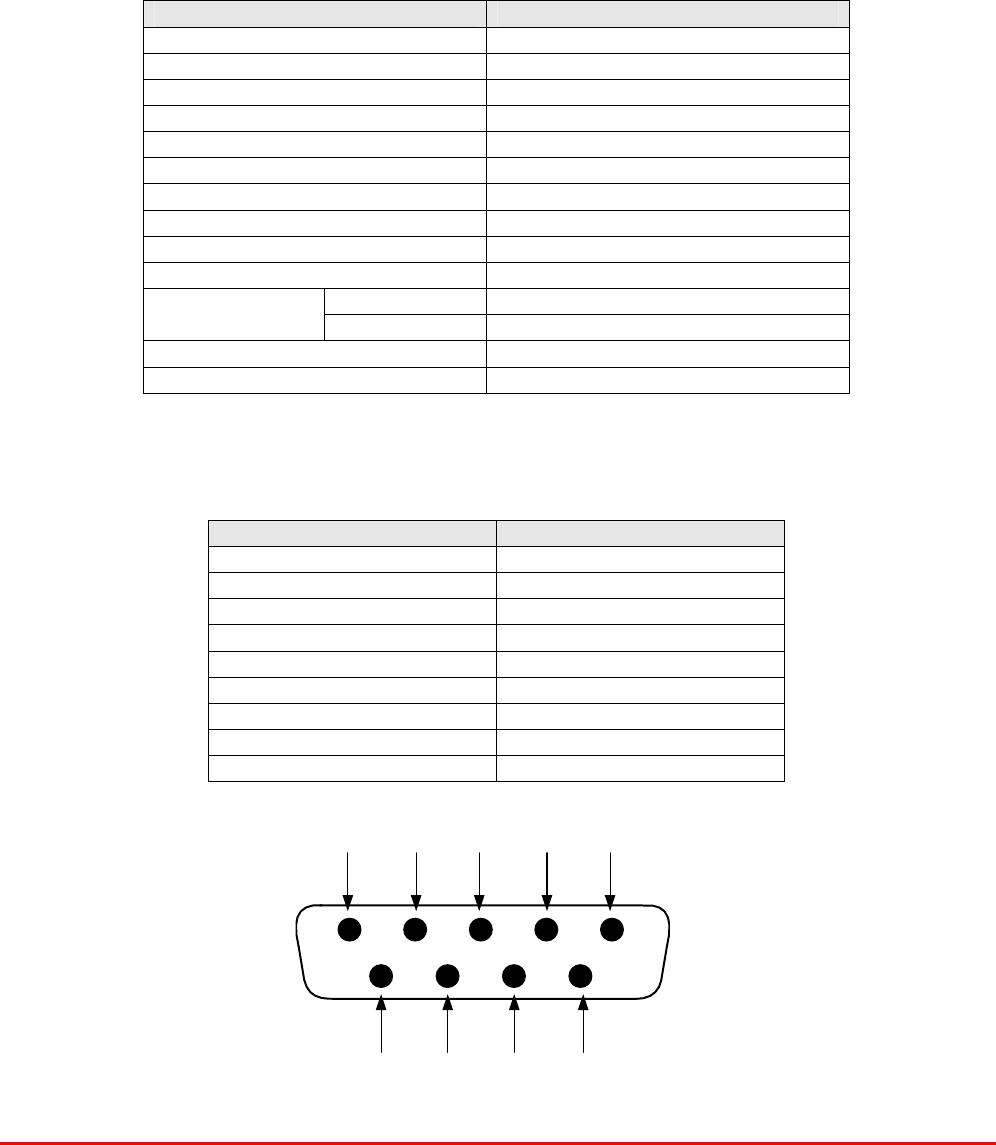
STTRS DOCUMENTATION
Document Number 80-330501HBKM – Issue A - Draft Page 198 of 500
11.4.3.6. Low Noise Amplifier (11-005902)
The Gallium-Arsenide low noise amplifier used in the unit is a double stage, solid-state low noise
amplifier. Class A circuitry is used throughout the units to ensure excellent linearity and extremely low
noise over a very wide dynamic range. The active devices are very moderately rated to provide a long
trouble-free working life. There are no adjustments on these amplifiers, and in the unlikely event of a
failure, then the complete amplifier should be replaced. This amplifier features its own in-built alarm
system which gives a volt-free relay contact type alarm that is easily integrated into any alarm system.
There is a Current Fault Alarm Function, which indicates failure of each one or both RF transistors by
a various alarm output options. The amplifier is housed in an aluminium case (Iridite NCP finish) with
SMA connectors for the RF input/output and a 9way D-type for DC and alarm outputs.
11-005902 Specification
PARAMETER SPECIFICATION
Frequency range: 800 – 960MHz *
Bandwidth: <170MHz
Gain: 19.5dB (typical)
1dB compression point: 21dBm
OIP3: 33dBm
Input/output return loss: >20dB
Noise figure: 1dB (typical)
Power consumption: 190mA @ 24V DC
Supply voltage: 10-24V DC
Connectors: SMA female
operational: -10°C to +60°C Temperature
range storage: -40°C to +70°C
Size: 90 x 55 x 30.2mm
Weight: 0.28kg *tuned to Customer's specification
LNA ‘D’ Connector Pin-out details
Connector pin Signal
1 +Ve input (10-24V)
2 GND
3 Alarm relay O/P bad
4 Alarm relay common
5 Alarm relay good
6 No connection
7 TTL voltage set
8 TTL alarm/0V (good)
9 O/C good/0V bad
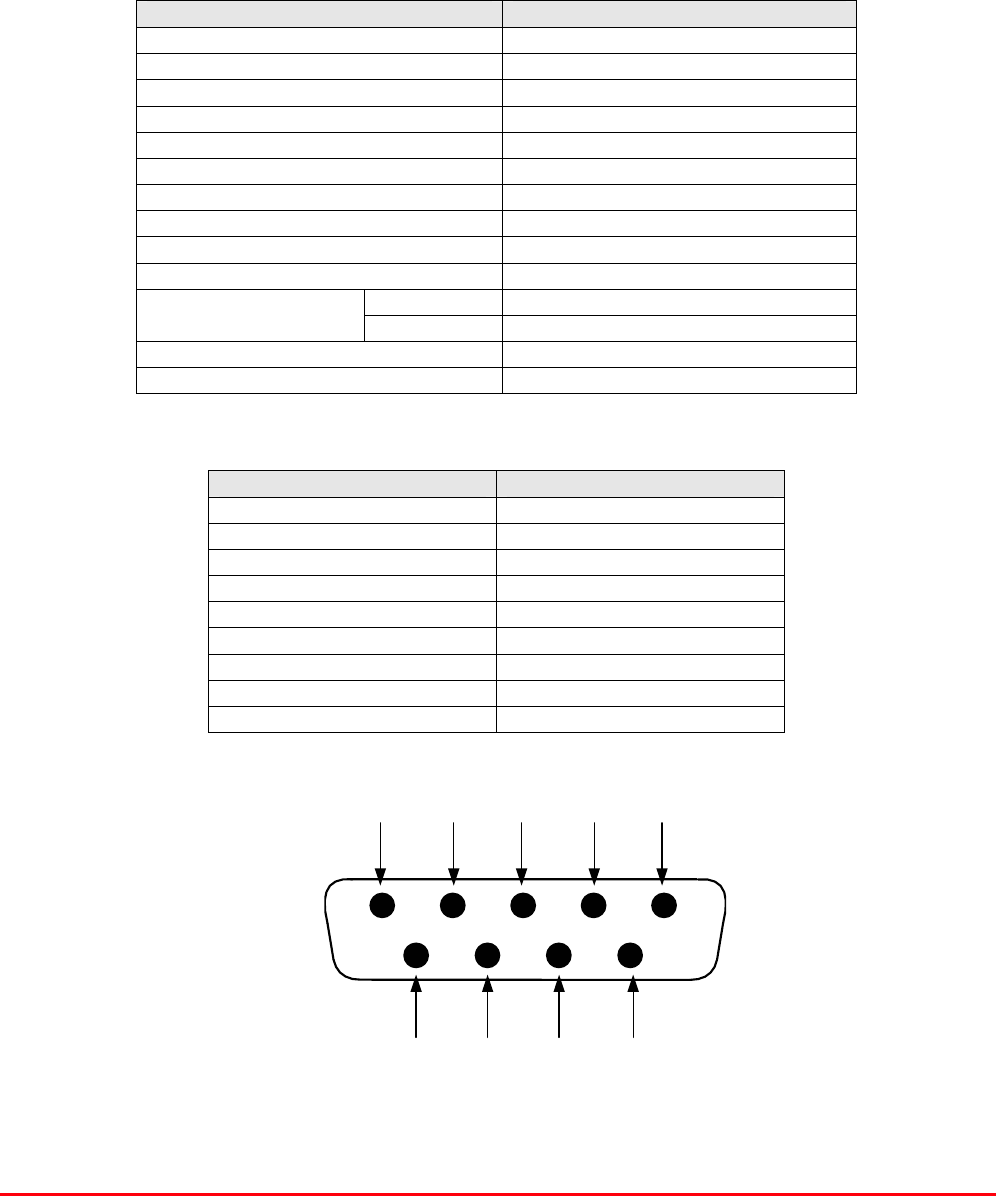
STTRS DOCUMENTATION
Document Number 80-330501HBKM – Issue A - Draft Page 199 of 500
7 8 96
1 2 3 4 5
9-Way Pin-Out Graphical Representation
11.4.3.7. Low Noise Amplifier (11-006702)
The Gallium-Arsenide low noise amplifiers used in 800MHz Line Amplifier (55-165703) are double
stage, solid-state low noise amplifiers. Class A circuitry is used throughout the units to ensure
excellent linearity and extremely low noise over a very wide dynamic range. The active devices are
very moderately rated to provide a long trouble-free working life. There are no adjustments on these
amplifiers, and in the unlikely event of a failure, then the complete amplifier should be replaced. This
amplifier features its own in-built alarm system which gives a volt-free relay contact type alarm that is
easily integrated into the main alarm system.
11-006702 Specification
PARAMETER SPECIFICATION
Frequency range: 800 – 1000MHz
Bandwidth: <200MHz
Gain: 29dB (typical)
1dB Compression point: 20dBm
OIP3: 33dBm
Input/Output return loss: >18dB
Noise figure: 1.3dB (typical)
Power consumption: 180mA @ 24V DC
Supply voltage: 10-24V DC
Connectors: SMA female
operational: -10°C to +60°C
Temperature range: storage: -20°C to +70°C
Size: 90 x 55 x 30.2mm
Weight: 290gms (approximately)
Low Noise Amplifier (11-006702) ‘D’ Connector Pin-out details
Connector pin Signal
1 +Ve input (10-24V)
2 GND
3 Alarm RelayO/P bad
4 Alarm Relay common
5 Alarm Relay good
6 No connection
7 TTL voltage set
8 TTL alarm/0V (good)
9 O/C good/0V bad
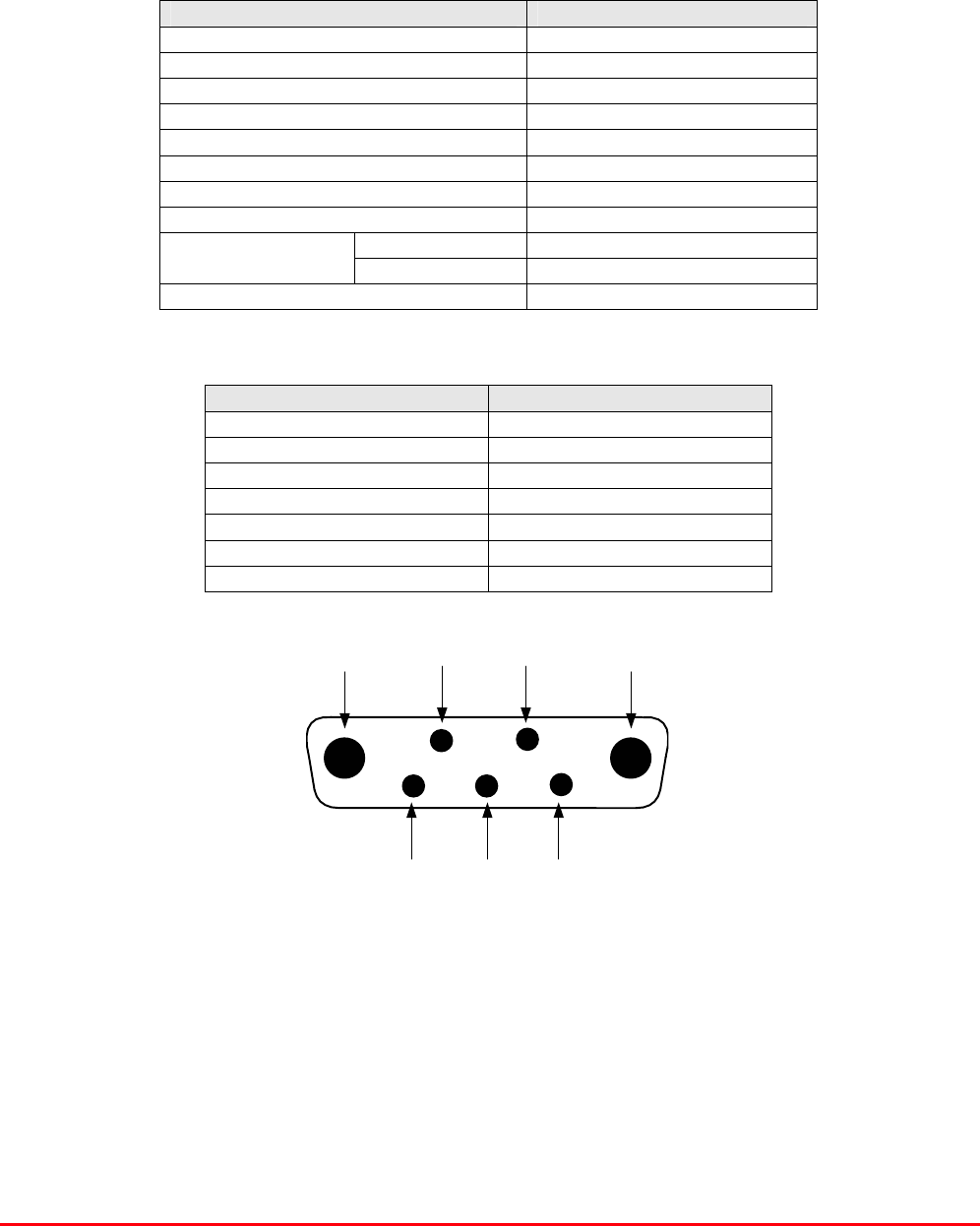
STTRS DOCUMENTATION
Document Number 80-330501HBKM – Issue A - Draft Page 200 of 500
11.4.3.8. Power Amplifier (12-018002)
This amplifier is a Class A 20W power amplifier from 800-960MHz in a 1 stage balanced
configuration. It demonstrates a very high linearity and a very good input/output return loss (RL). It
has built in a Current Fault Alarm Function.
Its housing is an aluminium case (Iridite NCP finish) with SMA connectors for the RF input/output and
a D-Type connector for the power supply and the Current Fault Alarm Function.
12-018002 Specification
PARAMETER SPECIFICATION
Frequency range: 800-960MHz
Small signal gain: 30dB
Gain flatness: ±1.2dB
I/O Return loss: >18dB
1dB compression point: 42.8dBm
OIP3: 56dBm
Supply voltage: 24V DC
Supply current: 5.0Amps (Typical)
operational: -10°C to +60°C Temperature
range storage: -20°C to +70°C
Weight: <2kg (no heatsink)
Power Amplifier (12-018002) 7-Way Connector Pin-outs
Connector Pin Signal
A1 (large pin) +24V DC
A2 (large pin) GND
1 Alarm relay common
2 TTL alarm/0V good
3 Alarm relay contact (bad)
4 Alarm relay contact (good)
5 O/C good/0V bad (TTL)
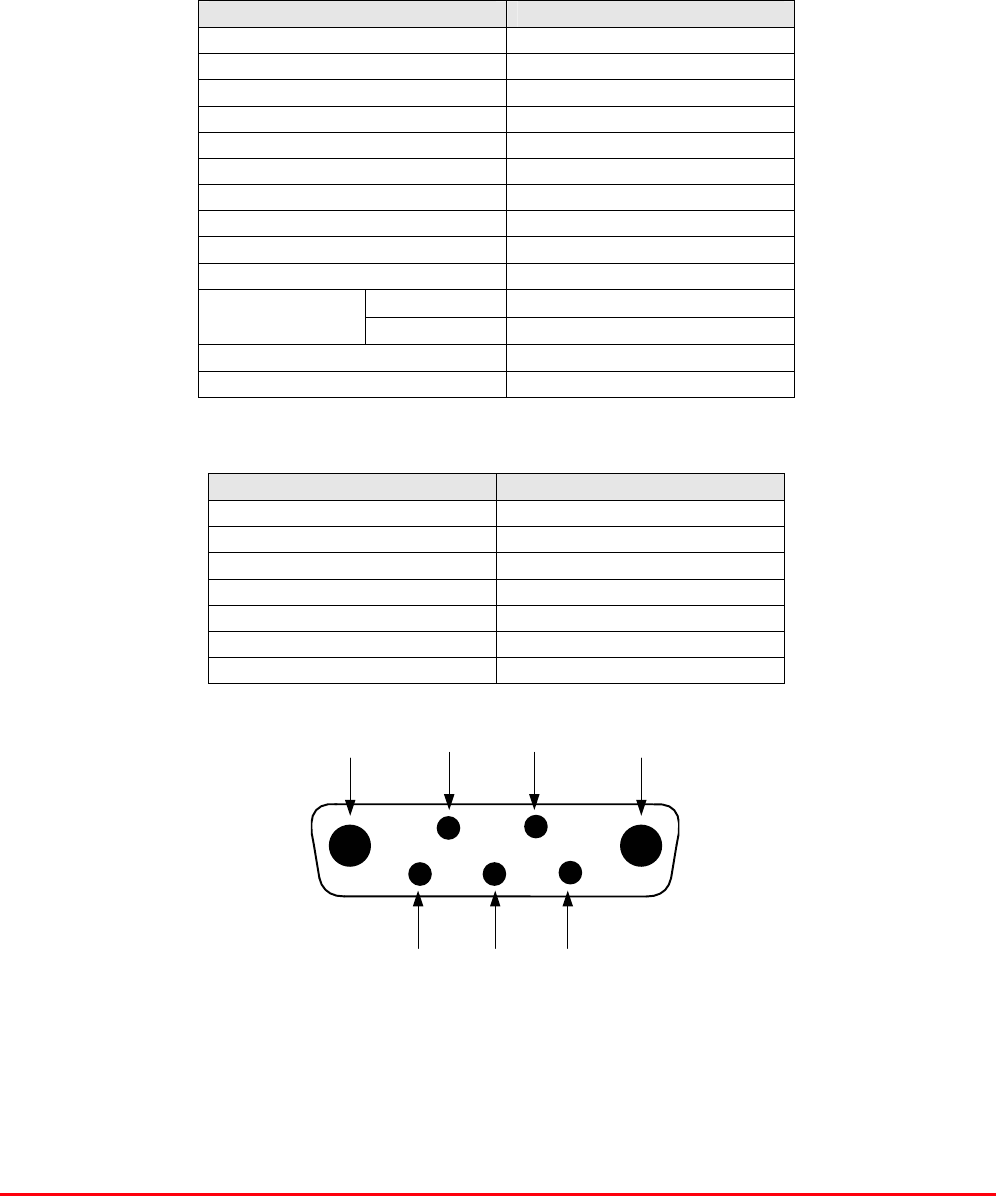
STTRS DOCUMENTATION
Document Number 80-330501HBKM – Issue A - Draft Page 201 of 500
111.4.3.9. Low Power Amplifier (12-021901)
The low power amplifier used is a triple stage solid-state low-noise amplifier. Class A circuitry is used
in the unit to ensure excellent linearity over a very wide dynamic range. The three active devices are
very moderately rated to provide a long trouble-free working life.
Its housing is an aluminium case (Iridite NCP finish) with SMA connectors for the RF input/output and
a D-Type connector for the power supply and the Current Fault Alarm Function.
There are no adjustments on this amplifier, and in the unlikely event of failure then the entire amplifier
should be replaced.
Low Power Amplifier (12-021901) Specification
PARAMETER SPECIFICATION
Frequency range 800-960MHz*
Bandwidth 20MHz *
Maximum RF output >1.0 Watt
Gain 15dB
1dB compression point +30.5dBm
3rd order intercept point +43dBm
Noise Figure <6dB
VSWR better than 1.5:1
Connectors SMA female
Supply 500mA @ 10-15V DC
operational -10°C to +60°C
Temperature
range storage -20°C to +70°C
Weight 0.5 kg
Size 167x52x25mm
* Tuned to Customer’s specification
Low Power Amplifier (12-021901) 7-Way Connector Pin-outs
Connector Pin Signal
A1 (large pin) +24V DC
A2 (large pin) GND
1 Alarm relay common
2 TTL alarm/0V good
3 Alarm relay contact (bad)
4 Alarm relay contact (good)
5 O/C good/0V bad (TTL)

STTRS DOCUMENTATION
Document Number 80-330501HBKM – Issue A - Draft Page 202 of 500
11.4.3.10. Automatic Gain Control
17-001109 AGC Detector Assembly (Logarithmic)
17-001117 AGC Detector Assembly
17-001201 AGC Attenuator Assembly
The sub components 17-001109, 17-001117 & 17-001201 are parts of the Automatic Gain Control
(AGC) system used in 700MHz FO Hub Amplifier (55-165602); 17-001117 and 17-001201 are paired
for use in the uplink and 17-001109 and 17-001201 are paired for use in the downlink
700MHz FO Hub Amplifier (55-165602) is fitted with two differing types of Automatic Gain Control
(AGC) system, one linear, and one logarithmic. The AGC with logarithmic detector (17-001117) is
fitted in the uplink path and the AGC with linear detector (17-001109) is fitted in the downlink path
The AFL Automatic Gain Control system consists of two units, a detector/amplifier and an attenuator.
The detector/amplifier unit is inserted in the RF path on the output of the power amplifier, and the
attenuator is situated in the RF path between the 1st and 2nd stages of amplification.
17-001117 and 17-001201 are paired for use in the uplink and 17-001109 and 17-001201 are paired
for use in the downlink
The attenuator comprises a 50Ω P.I.N diode, voltage-variable attenuator with a range of 3 to 30dB.
The attenuation is controlled by a DC voltage which is derived from the associated detector controller
board.
Normally the attenuator is at minimum attenuation. The detector/amplifier unit monitors the RF level
being delivered by the power amplifier, and when a certain threshold is reached it begins to increase
the value of the attenuator to limit the RF output to the (factory set) threshold. Therefore overloading
of the power amplifier is avoided.
The factory set threshold is 1dB below the Enhancer 1dB compression point. Some adjustment of this
AGC threshold level is possible, a 10dB range is mostly achieved. It is not recommended under any
circumstances to adjust the AGC threshold to a level greater than the 1dB compression point as
system degradation will occur.
The detector comprises of a 50Ω transmission line with a resistive tap which samples a small portion
of the mainline power. The sampled signal is amplified and fed to a conventional half wave diode
rectifier, the output of which is a DC voltage proportional to the RF input signal.
This DC voltage is passed via an inverting DC amplifier with integrating characteristics, to the output,
which drives the attenuation control line of the corresponding AGC attenuator. This unit is fitted at
some earlier point in the RF circuit.
For small signals, below AGC onset, the output control line will be close to 12V and the AGC
attenuator will have minimum attenuation. As the signal level increases the control line voltage will
fall, increasing the attenuator value and keeping the system output level at a constant value.
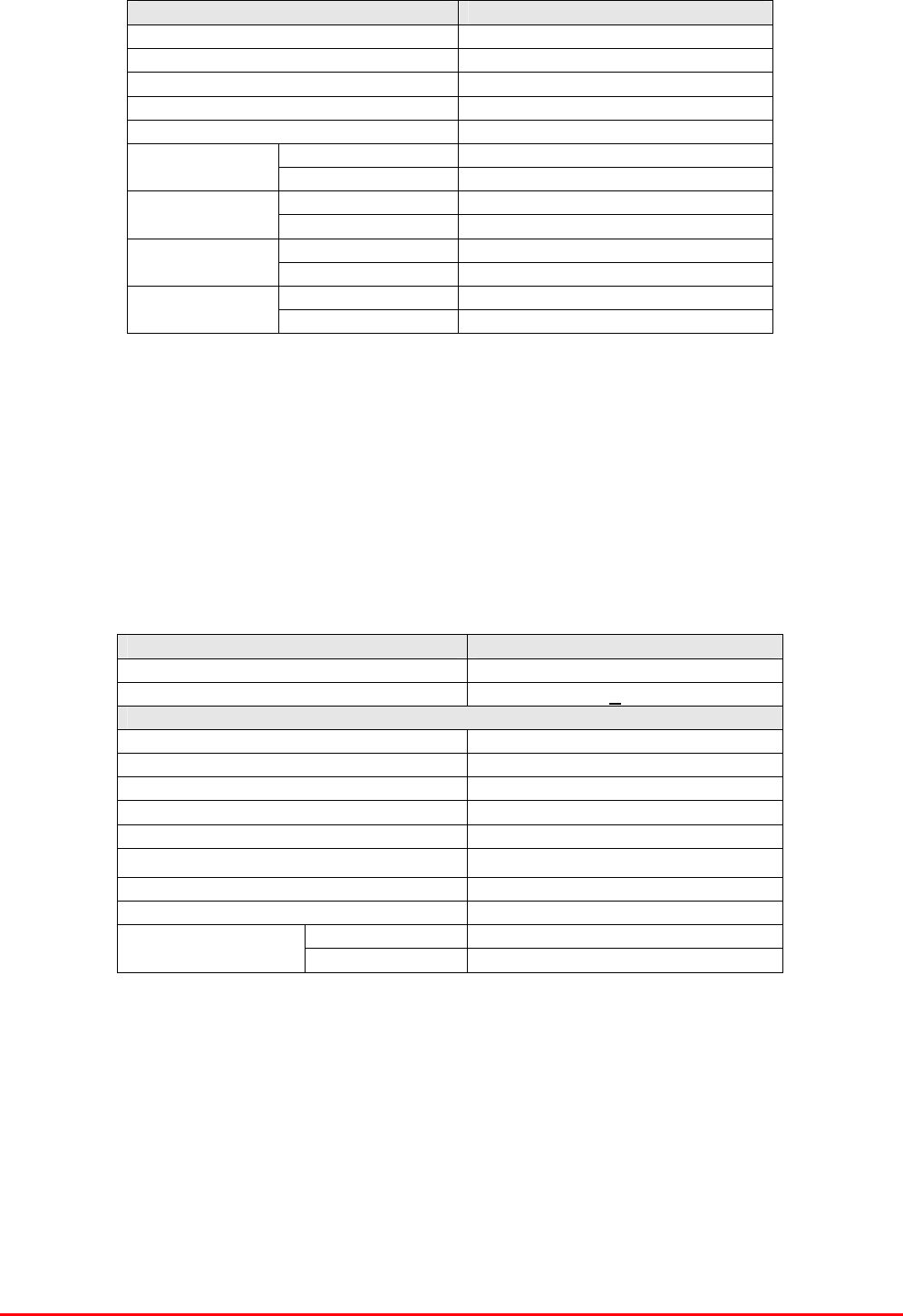
STTRS DOCUMENTATION
Document Number 80-330501HBKM – Issue A - Draft Page 203 of 500
AGC Specification (both types)
PARAMETER SPECIFICATION
Frequency range up to 1000MHz
Attenuation range 3 to 30dB
Attenuation steps continuously variable
VSWR better than 1.2:1
RF Connectors SMA female
attenuator 1W Power
handling detector/amp >30W (or as required)
operation -10°C to +60°C Temperature
range storage -20°C to +70°C
attenuator pcb 50 x 42 x 21mm
Size detector/amp pcb 54 x 42 x 21mm
attenuator 90grams
Weight detector/amp 100grams
11.4.3.11. 12V (Dual) Relay Board (20-001601)
The General Purpose Relay Board allows the inversion of signals and the isolation of circuits. It is
equipped with two dual pole change-over relays with completely isolated wiring, accessed via screw
terminals. Both relays are provided with polarity protection diodes and diodes for suppressing the
transients caused by "flywheel effect" which can destroy switching transistors or induce spikes on
neighbouring circuits. It’s common use is to amalgamate all the alarm signals into one, volts-free relay
contact pair for the main alarm system.
20-001601 Specification
PARAMETER SPECIFICATION
Operating voltage: 8 to 30V (floating earth)
Alarm threshold: Vcc - 1.20 volt +15%
Alarm output relay contacts:
Max. switch current: 1.0Amp
Max. switch volts: 120Vdc/60VA
Max. switch power: 24W/60VA
Min. switch load: 10.0µA/10.0mV
Relay isolation: 1.5kV
Mechanical life: >2x107 operations
Relay approval: BT type 56
Connector details: Screw terminals
operational: -10°C to +60°C Temperature
range storage: -20°C to +70°C
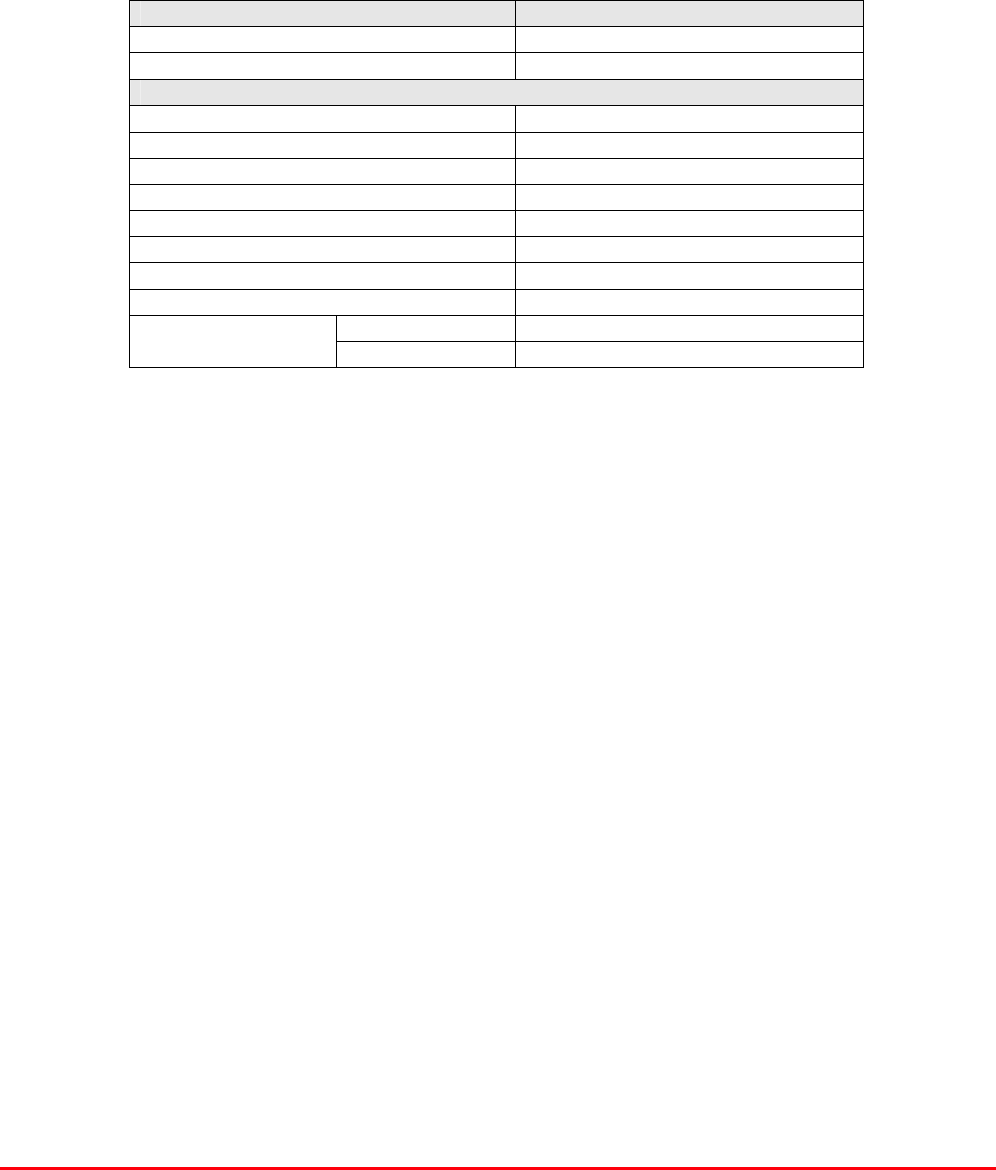
STTRS DOCUMENTATION
Document Number 80-330501HBKM – Issue A - Draft Page 204 of 500
11.4.3.12. 12V (Single) Relay Board (80-008901)
The General Purpose Relay Board allows the inversion of signals and the isolation of circuits. It is
equipped with a single dual pole change-over relay RL1, with completely isolated wiring, accessed
via a 15 way in-line connector.
The relay is provided with polarity protection diodes and diodes for suppressing the transients caused
by "flywheel effect" which can destroy switching transistors or induce spikes on neighbouring circuits.
It’s common use is to amalgamate all the alarm signals into one, volts-free relay contact pair for the
main alarm system.
80-008901 Specification
PARAMETER SPECIFICATION
Operating voltage 8 to 30V (floating earth)
Alarm threshold Vcc - 1.20 volt +15%
Alarm output relay contacts:
Max. switch current 1.0Amp
Max. switch volts 120Vdc/60VA
Max. switch power 24W/60VA
Min. switch load 10.0µA/10.0mV
Relay isolation 1.5kV
Mechanical life >2x107 operations
Relay approval BT type 56
Connector details Screw terminals
operational -10°C to +60°C Temperature
range storage -20°C to +70°C
11.4.3.13. Dual Diode Assembly (94-100004)
The purpose of these dual diode assemblies is to allow two DC voltage sources to be combined, so
that the main DC rail within the equipment can be sourced from either a mains driven PSU, or
externally through an XLR connector or from dual mains driven PSUs. They are very heavy-duty
diodes and they prevent any reverse current from flowing back to their source or the alternative
supply rail. Combining diodes such as these will also be used if the equipment is to be powered from
external back-up batteries.
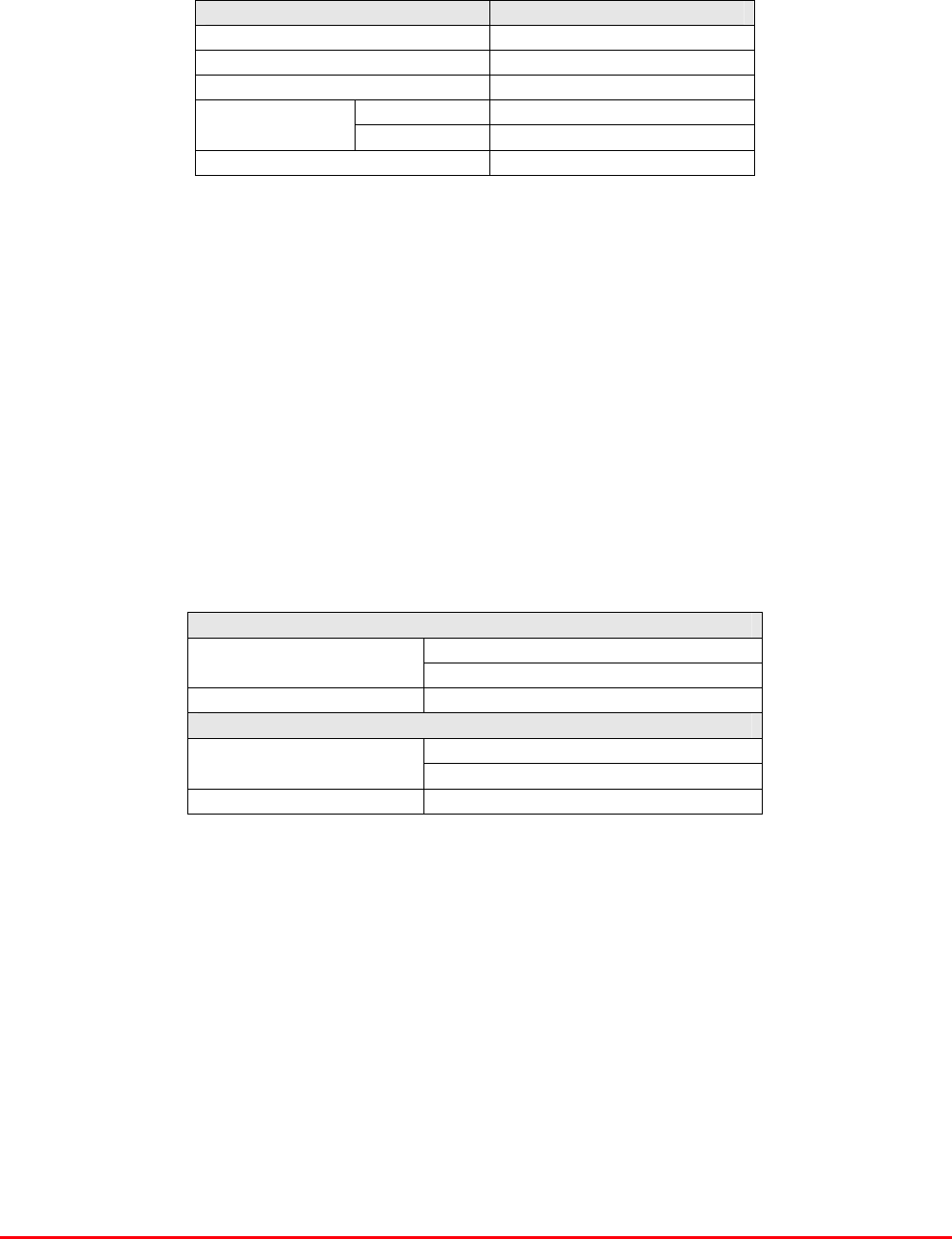
STTRS DOCUMENTATION
Document Number 80-330501HBKM – Issue A - Draft Page 205 of 500
11.4.3.14. DC/DC Converter 96-200047
96-200047 is an O.E.M. high power device with a wide input range and 12.5 amp @ 12V (150Watts)
output capability used to derive a 12V fixed voltage power supply rail from a higher voltage supply, in
this case 12V. In the event of failure this unit should not be repaired, only replaced.
96-200047 Specification
PARAMETER SPECIFICATION
DC Input Voltage range 19 to 36V
DC Output voltage 12V ± 1%
Max. current load 12.5Amps
Operation -10°C to +60°C Temperature
range Storage -20°C to +85°C
Working Humidity 20 to 90% RHNC
11.4.3.15. 12V Switch-Mode PSU (96-300052)
No routine maintenance of the PSU is required. If a fault is suspected, then the output voltage from
the power supply may be measured on its output terminals. This is typically set to 12.2V. The
adjustment potentiometer will be found close to the DC output terminals.
All the PSUs used in AFL Cell Enhancers are capable of operation from either 110 or 220V nominal
AC supplies. The line voltage is sensed automatically, so no adjustment or link setting is needed by
the operator.
96-300052 Specification
AC Input Supply 110 or 220V nominal
Voltage 85 - 265V AC (absolute limits)
Frequency 47 to 63Hz
DC Output Supply 12V DC (nominal)
Voltage 10.5-13.8V (absolute limits)
Current 12.5A
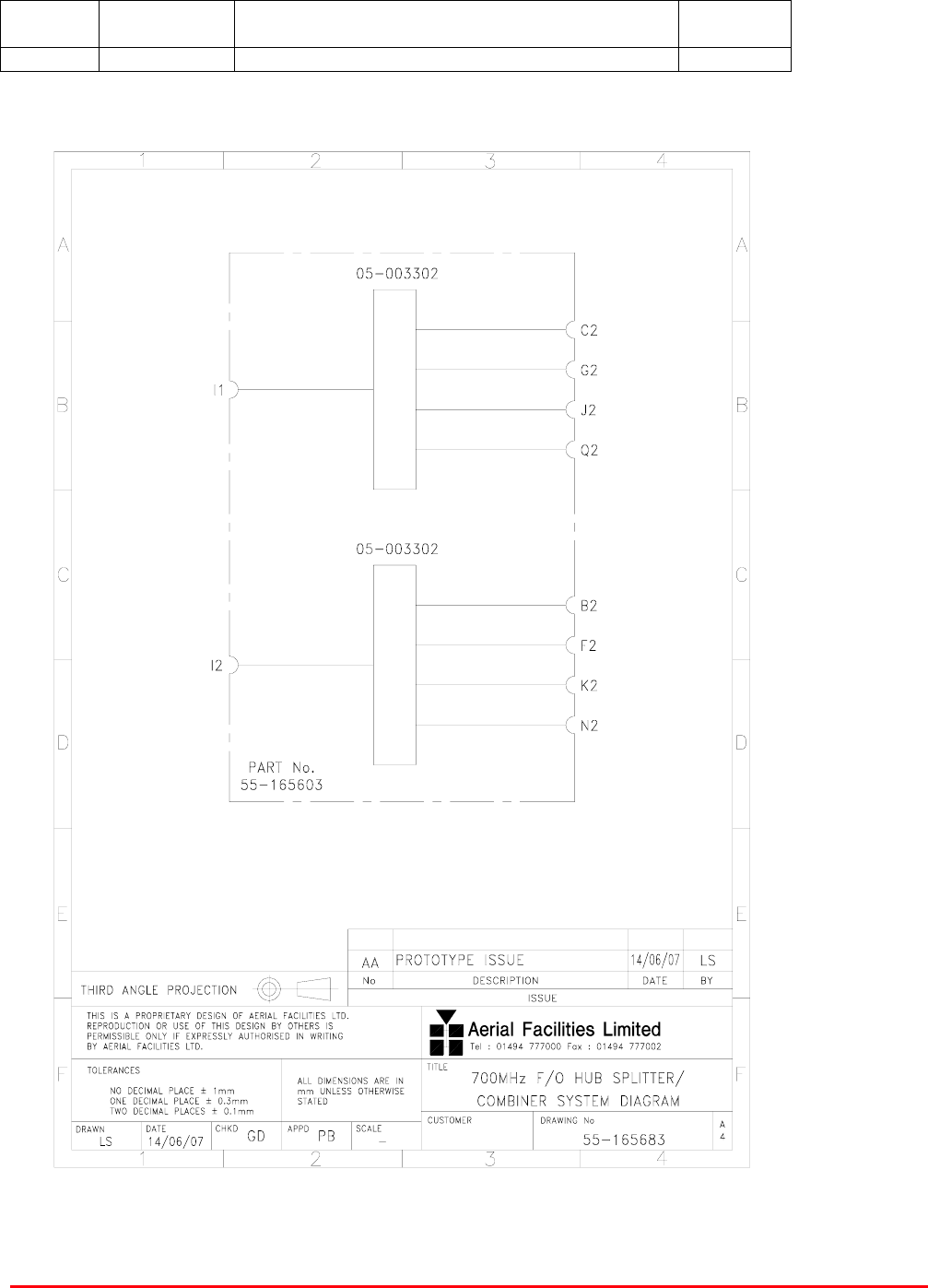
STTRS DOCUMENTATION
Document Number 80-330501HBKM – Issue A - Draft Page 206 of 500
11.4.4. 700MHz FO HUB Splitter/Combiner (55-165603)
700MHz FO HUB Splitter/Combiner (55-165603) list of major components
section Component
Part Component Part Description Qty. Per
Assembly
11.4.4.2. 05-003302 4 WAY SPLITTER GSM 900MHz 2
11.4.4.1. 700MHz FO HUB Splitter/Combiner (55-165603) system diagram
drawing number 55-165683

STTRS DOCUMENTATION
Document Number 80-330501HBKM – Issue A - Draft Page 207 of 500
11.4.4.2. Four Way Splitter/Combiner (05-003302)
The Splitter/Combiner used is a device for accurately matching two or more RF signals to single or
multiple ports, whilst maintaining an accurate 50Ω load to all inputs/outputs and ensuring that the
VSWR and insertion losses are kept to a minimum. Any unused ports should be terminated with an
appropriate 50Ω load.
Four Way Splitter (05-003302) Specification
PARAMETER SPECIFICATION
Frequency range 700-980MHz
Bandwidth 180MHz
Rejection >14dB
Insertion loss <7.0dB (in band)
Connectors N type, female
Weight <1.5kg
operational -20%C to +60%C Temperature
range storage -40%C to +70%C
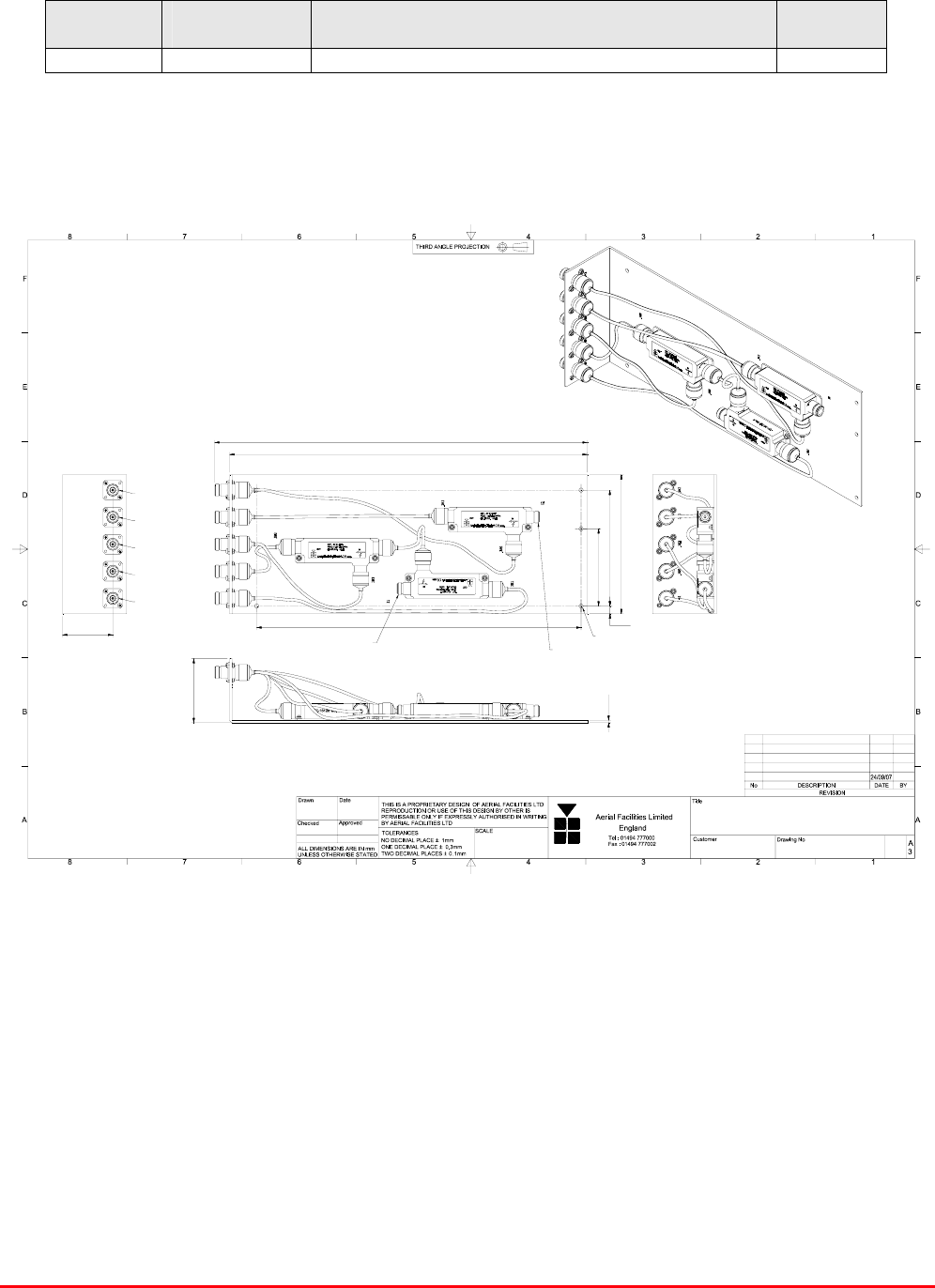
STTRS DOCUMENTATION
Document Number 80-330501HBKM – Issue A - Draft Page 208 of 500
UNIVERSITY STATION. SPLITTER 2
20/09/07
55-1657112
PB
18/10/2007
GD
18/10/2007
1:2
OUTLINE DRAWING
PL
100.00
150.00
420.00
483
463.0
65 5x FIXING HOLES SUITABLE
FOR M5 FIXINGS
180.0
PORT JA2
PORT JA1
PORT JB3
PORT JB2
PORT JB1
PORT I1 PORT I2
3.00
PRODUCT NUMBER : 55-165712
MATERIAL: CHASSIS - ALUMINIUM
FINISH : IRIDITE
CONNECTORS : 'N' TYPE SOCKETS
83.0
10.0
AA ORIGINAL ISSUE PL
11.4.5. UNIVERSITY ST. SPLITTER 2 (55-165712)
UNIVERSITY ST. SPLITTER 2 (55-165712) List of major Components
section Component
Parts Component Part Description Qty. Per
Assembly
11.4.5.3. 07-015102 ASYMMETRIC CPLR 10dB 800-2500MHz GA 3
11.4.5.1. University Station Splitter 2 (55-165712) outline drawing
drawing number 55-1657112
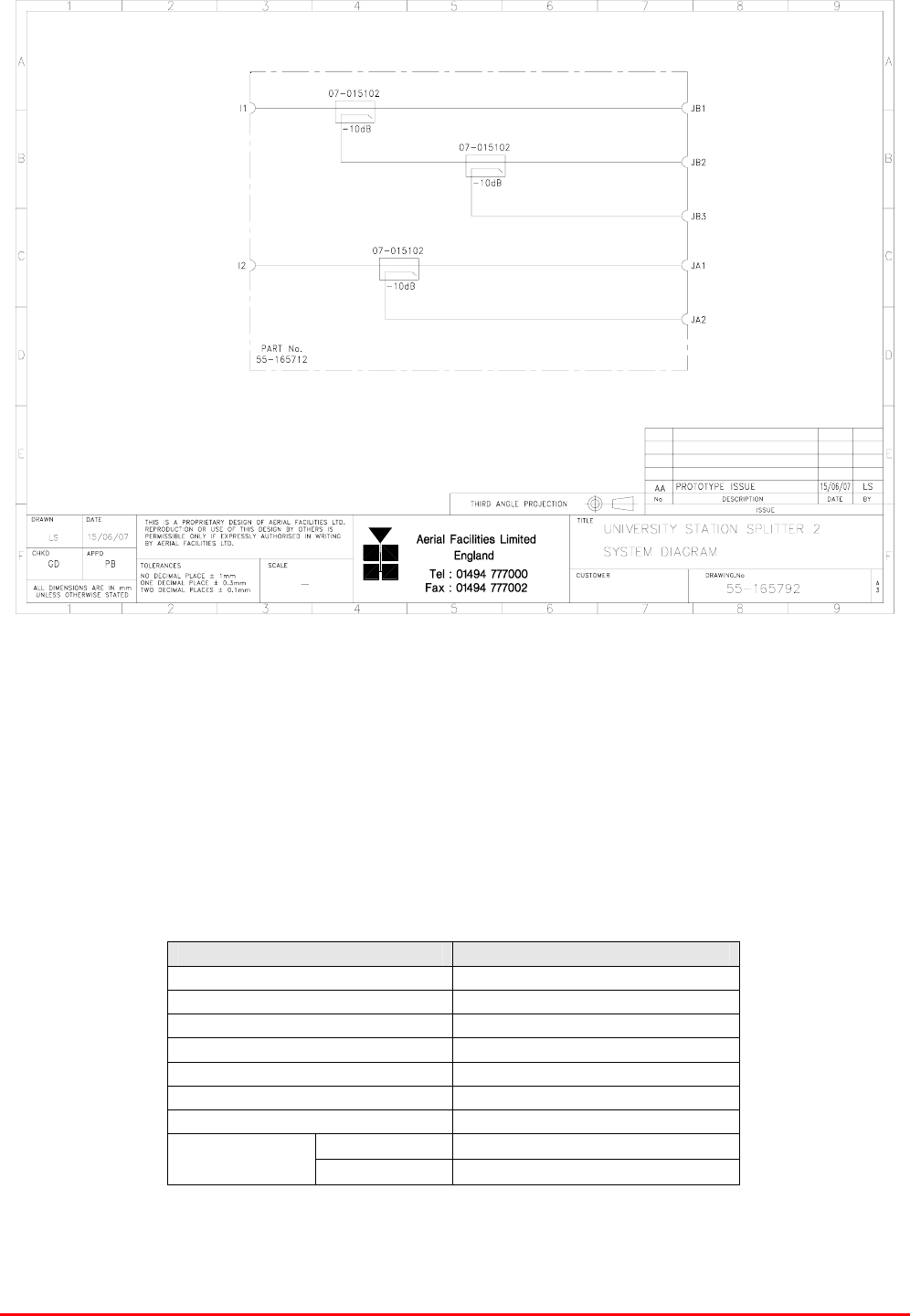
STTRS DOCUMENTATION
Document Number 80-330501HBKM – Issue A - Draft Page 209 of 500
11.4.5.2. University Station Splitter 2 (55-165712) system diagram
drawing number 55-165792
11.4.5.3. Wideband Asymmetric Coupler (07-015102)
The purpose of Wideband Asymmetric Coupler (07-015102) is to tap off a known portion (in this case
10dB) of RF signal from transmission lines and to combine them, for example through splitter units for
different purposes (alarms/monitoring etc.), whilst maintaining an accurate 50Ω load to all
ports/interfaces throughout the specified frequency range. They are known formally as directional
couplers as they couple power from the RF mainline in one direction only.
07-015102 Specification
PARAMETER SPECIFICATION
Frequency Range 800 - 2500 MHz
Coupling Value 10 dB ± 1.0 dB
Main Line Insertion Loss <1.6 dB
VSWR 1.4:1
Directivity >18 dB
Power Rating 200 Watts
RF Connectors ‘N’ female
operation -20°C to +60°C
Temperature
range storage -40°C to +70°C

STTRS DOCUMENTATION
Document Number 80-330501HBKM – Issue A - Draft Page 210 of 500
11.4.6. Optical AB Switch FC/APC (98-700002)
Optical A/B Switch FC/APC (98-700002) an O.E.M. sourced Fibre Optic relay supplied as a 1U rack
mount tray. 98-700002 allows for the automatic switching between two optical inputs to provide a
common optical output. Manual selection of the input is also possible via toggle switches on the front
panel.
98-700002 Specification
PARAMETER SPECIFICATION
Electrical Characteristics
Power Supply Voltage 100 - 240 VAC
Power Supply Frequency 50 - 60 Hz
Optical Characteristics
Operating Wavelength 1200 – 1610nm
Optical Input Range +20 dBm
Optical Insertion Loss 2.0 dB
Optical Trip Threshold/Meter Range -35 - +20 dBm
Optical Switch Speed 15ms
Backreflection Tolerance -50dB
Environmental and Physical Characteristics
Optical Connectors FC/APC
Operating Temp. Range +10 to +40°C
Storage Temp. Range -40 to +80 °C
Humidity 5 to 90 % RHNC
Weight 2.2 kg (6 lbs)
Dimensions 483 x 361 x 44mm (19.0 x 14.2 x 1.72 in.)
11.4.7. F/O Link Subsystem (98-800001)
F/O Link Subsystem (98-800001) is an O.E.M. sourced Optical Tranceiver package containing
discreet TX and RX modules and supplied as a 1U rack mount tray
Parameter Specification
Optical Output Power 4 mW
Wavelength, peak 1310 1550 nm
Frequency Response, 50 to 2.2 GHz ± 1.5 dB
Input and Output VSWR 1.5:1
Link Gain (2) 0 dB
Output Noise Floor (1) -137 dBm/Hz
Input 3rd Order Intercept (1) 30 dBm
Operating Temperature −30 to +75°C
Storage Temperature −40 to +85°C
Maximum RF Input to Transmitter +20 dBm
Maximum Optical Input to Receiver 6 mW
A.C. Supply Voltage 90 – 265 VAC
Dimensions 483 x 457 x 44mm (19.0 x 18 x 1.72 in.)
(1) SFDR, Noise and IP3 specified with 5 dB optical loss.
(2) Link Gain specified with 1 meter fiber.

STTRS DOCUMENTATION
Document Number 80-330501HBKM – Issue A - Draft Page 211 of 500
12. WESTLAKE STATION LINE AMPLIFIER (80-330553)
rack number C03-CR-06
Westlake Station Line Amplifier (80-330553) list of major components
Section Component
Part Component Part Description Qty. Per
Assembly
12.4.1. 55-165703 800MHz LINE AMP + FILTERS (INT AMP) 2
12.4.2. 55-165704 700MHz LINE AMP + FILTERS (INT AMP) 2
12.4.3. 55-165707 WESTLAKE ST. SPLITTER 1
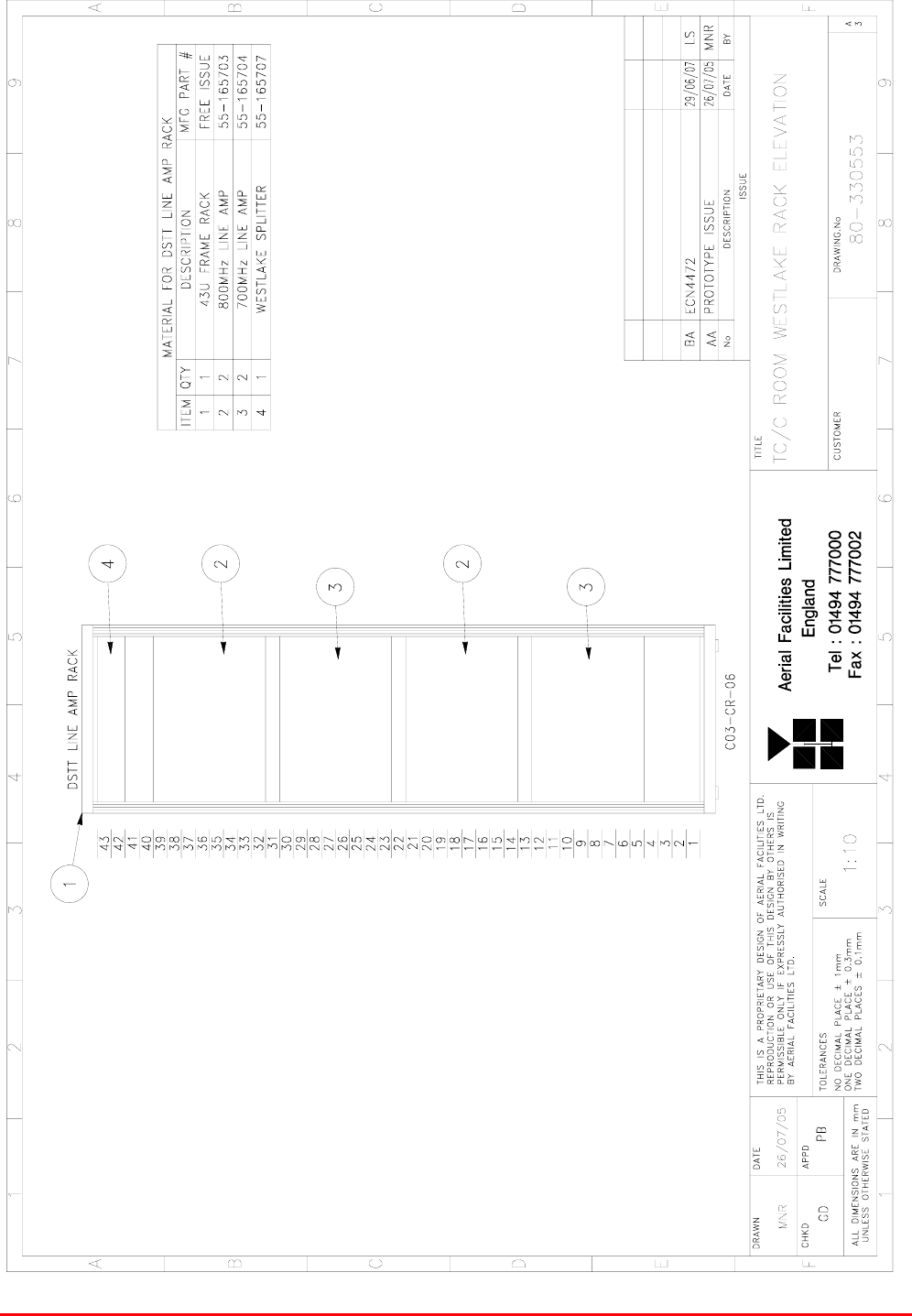
STTRS DOCUMENTATION
Document Number 80-330501HBKM – Issue A - Draft Page 212 of 500
12.1. Westlake Station Line Amplifier (80-330553) rack elevation
drawing number 80-330553
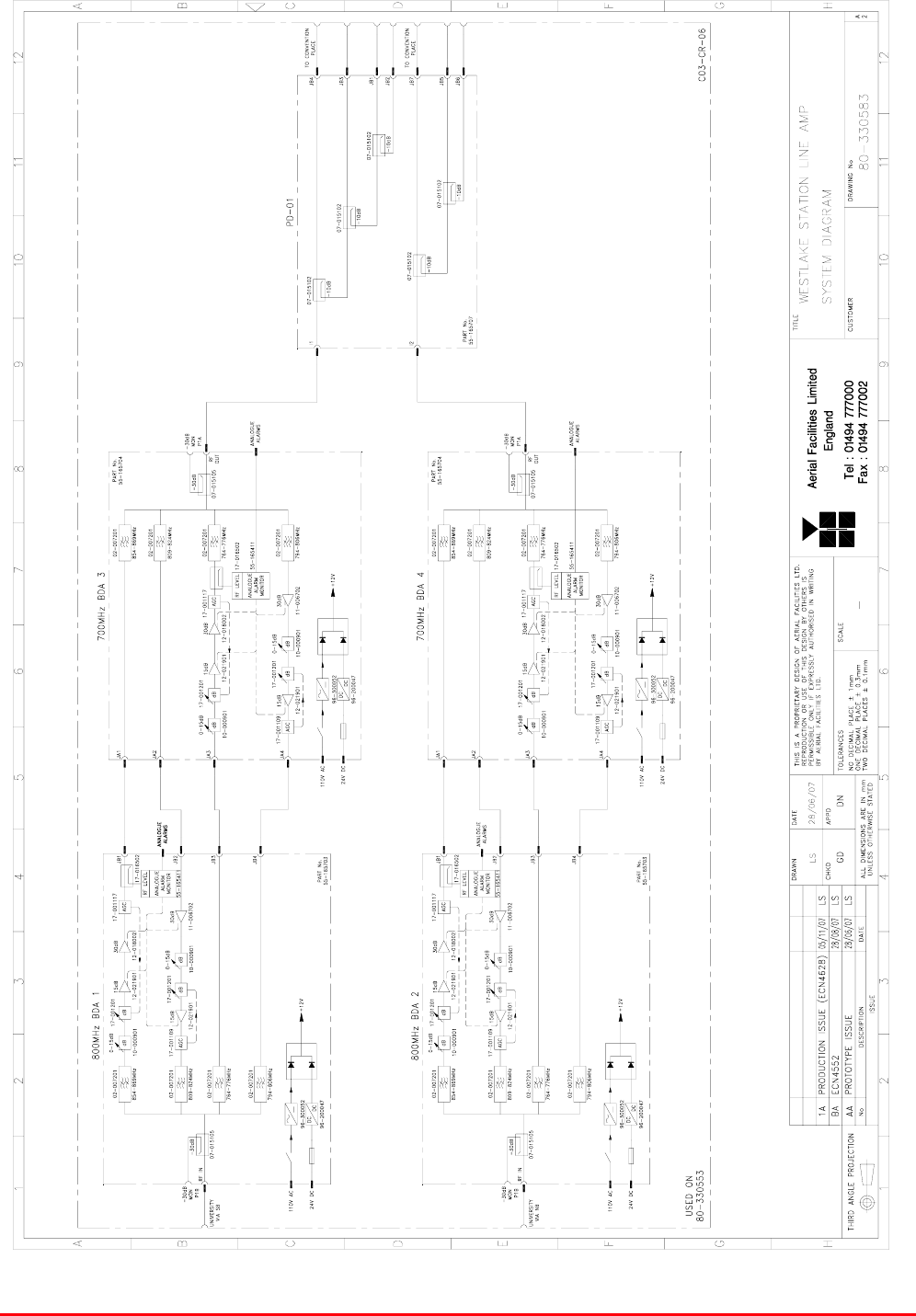
STTRS DOCUMENTATION
Document Number 80-330501HBKM – Issue A - Draft Page 213 of 500
12.2. Westlake Station Line Amplifier (80-330553) system diagram
drawing number 80-330583
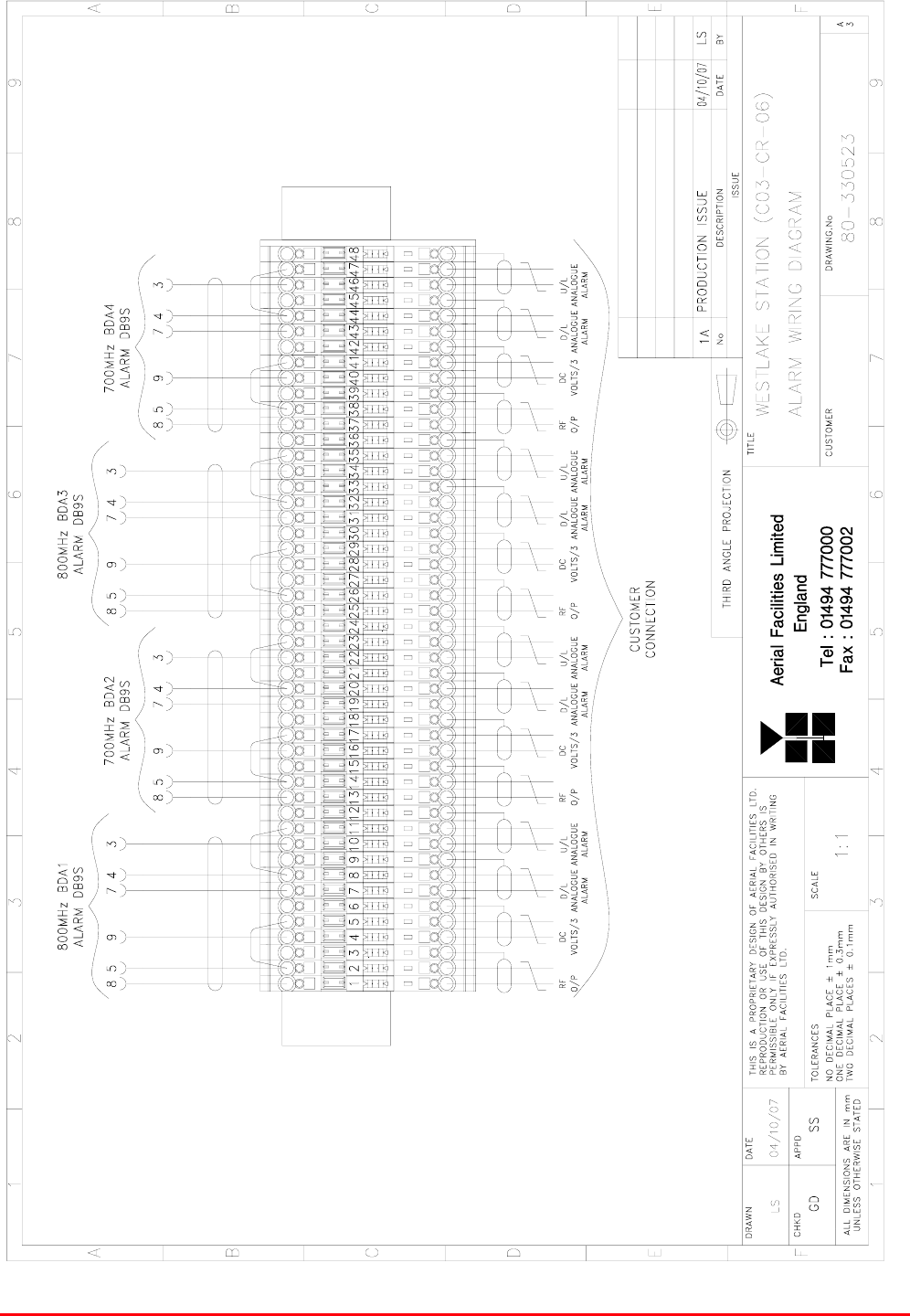
STTRS DOCUMENTATION
Document Number 80-330501HBKM – Issue A - Draft Page 214 of 500
12.3. Westlake Station Line Amplifier (80-330553) alarm wiring diagram
drawing number 80-330523
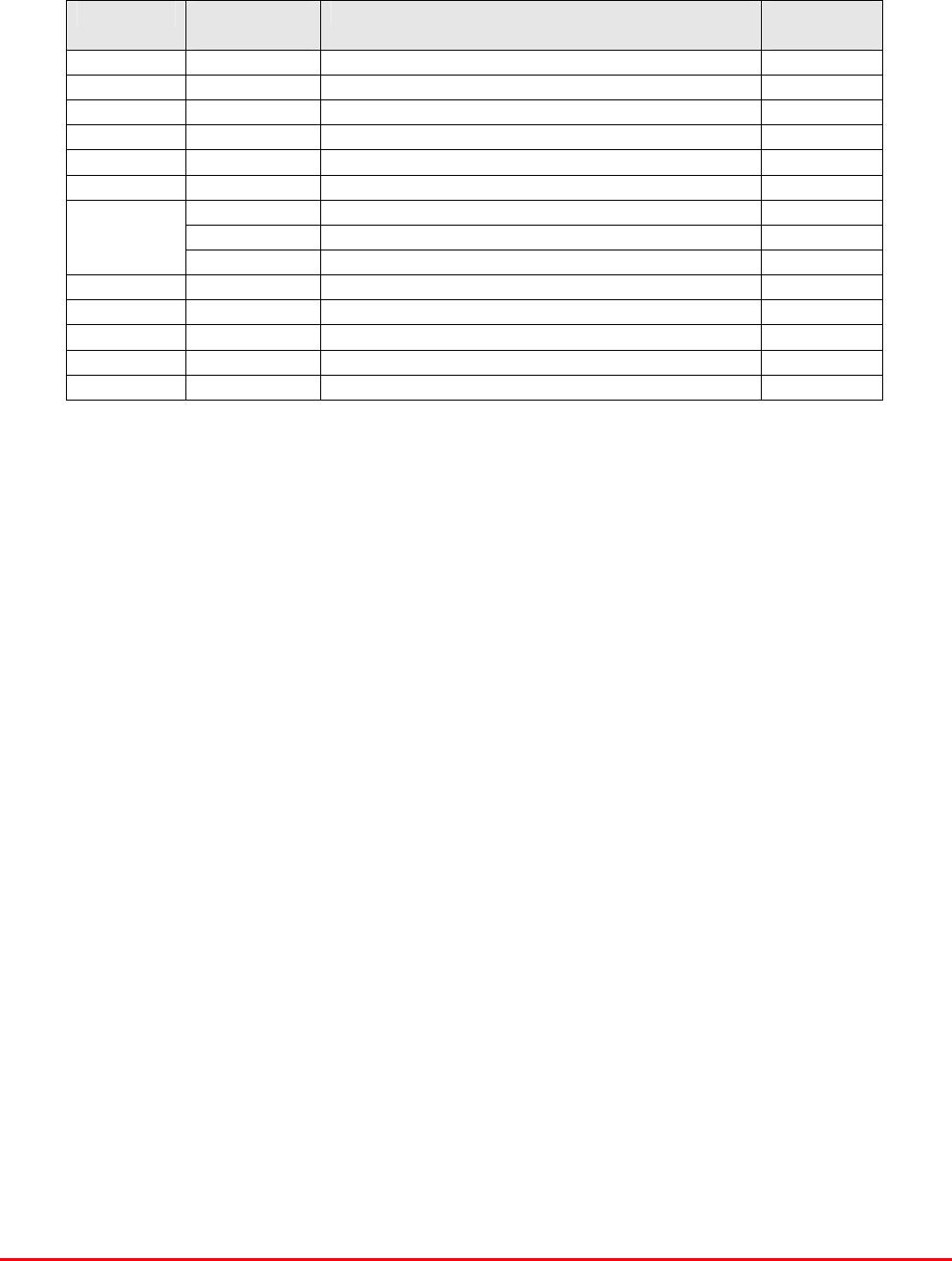
STTRS DOCUMENTATION
Document Number 80-330501HBKM – Issue A - Draft Page 215 of 500
12.4. Westlake Station Line Amplifier (80-330553) Sub Components
12.4.1. 800MHz Line Amplifier (55-165703)
800MHz Line Amplifier (55-165703) List of Major Components
Section Component
Part Component Part Description Qty. Per
Assembly
12.4.1.3. 02-007206 Bandpass Filter 4
12.4.1.4. 07-015105 Wideband Asymmetric Coupler 1
12.4.1.5. 10-000901 Switched Attenuator 0.25W, 0 - 15dB 2
12.4.1.6. 11-006702 Low Noise Amplifier 1
12.4.1.7. 12-018002 Power Amplifier (20W 800MHz ) 1
12.4.1.8. 12-021901 Low Power Amplifier 2
17-001109* AGC Detector Assembly (Logarithmic) 1
17-001117* AGC Detector Assembly 1
12.4.1.9.
17-001201* AGC Attenuator Assembly 2
12.4.1.10. 20-001601 12V (Dual) Relay Board 1
12.4.1.11. 80-008901 12V (Single) Relay Board 1
12.4.1.12. 94-100004 Dual Diode Assembly 1
12.4.1.13. 96-200047 DC/DC Converter 1
12.4.1.14. 96-300052 12V Switch-Mode PSU 1
*The sub components 17-001109, 17-001117 & 17-001201 are parts of the Automatic Gain Control
(AGC) system used in 800MHz Line Amplifier (55-165703); 17-001117 and 17-001201 are paired for
use in the uplink and 17-001109 and 17-001201 are paired for use in the downlink
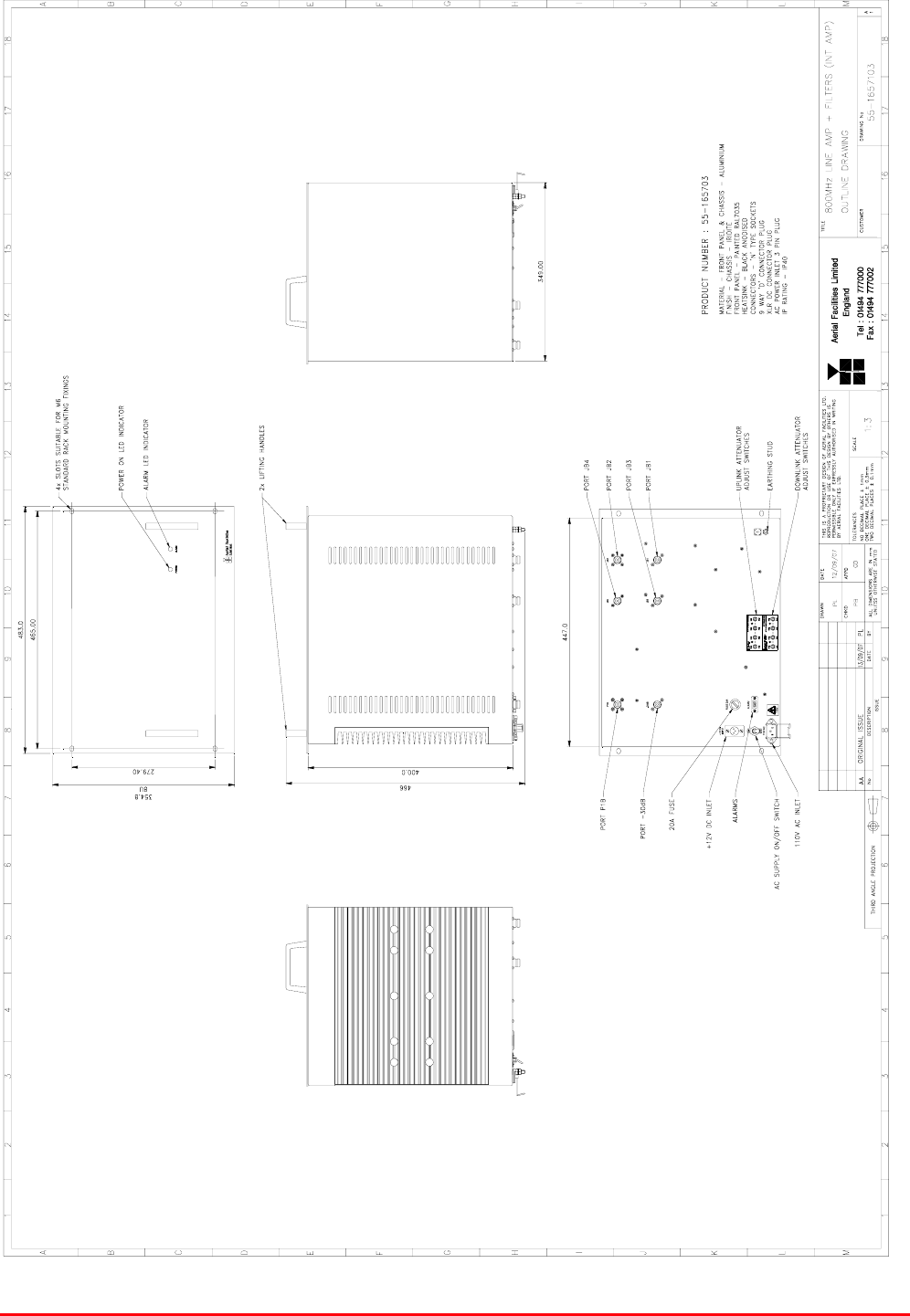
STTRS DOCUMENTATION
Document Number 80-330501HBKM – Issue A - Draft Page 216 of 500
12.4.1.1. 800MHz Line Amplifier (55-165703) Outline Drawing
Drawing number 55-1657103
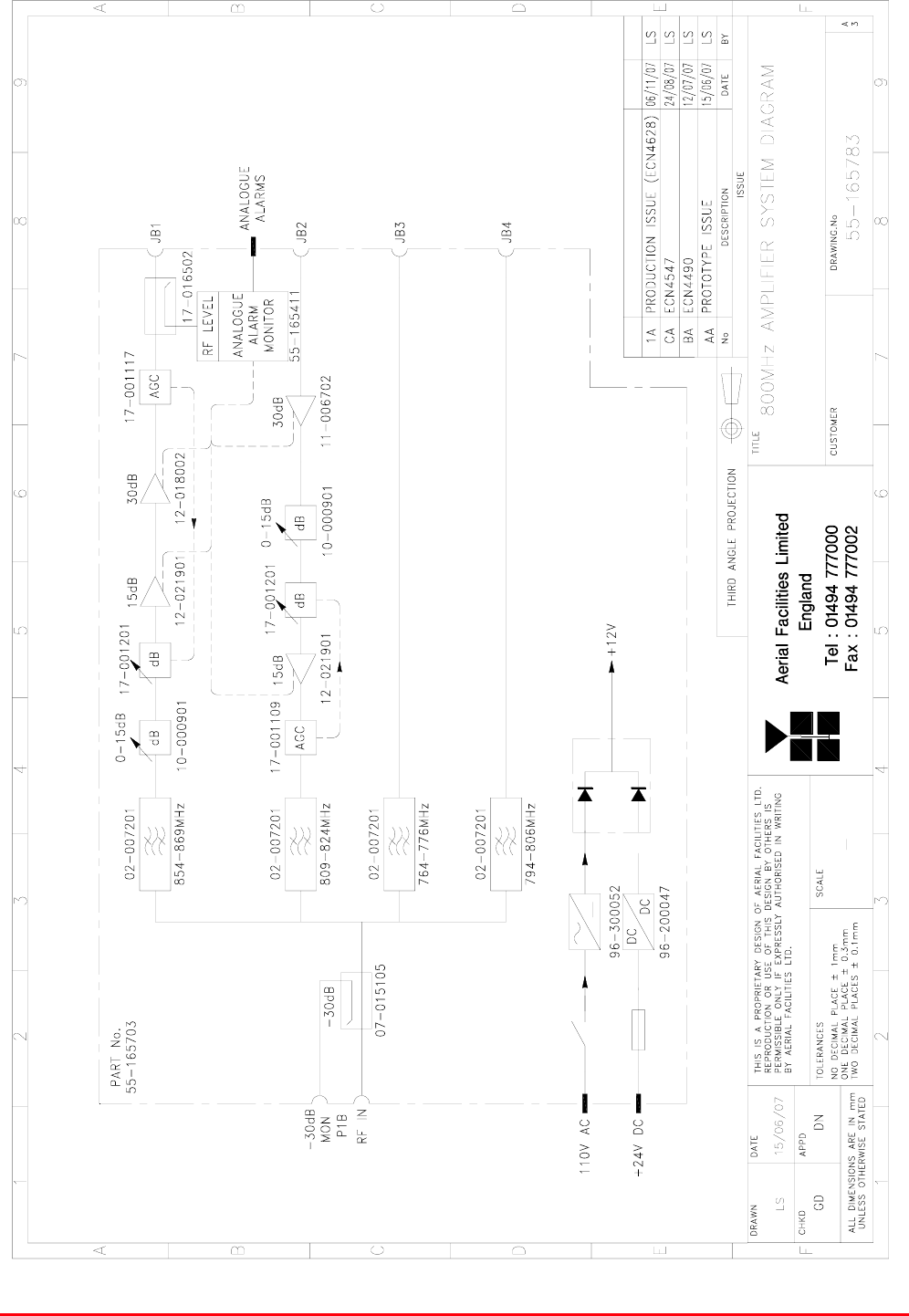
STTRS DOCUMENTATION
Document Number 80-330501HBKM – Issue A - Draft Page 217 of 500
12.4.1.2. 800MHz Line Amplifier (55-165703) System Diagram
Drawing number 55-165783
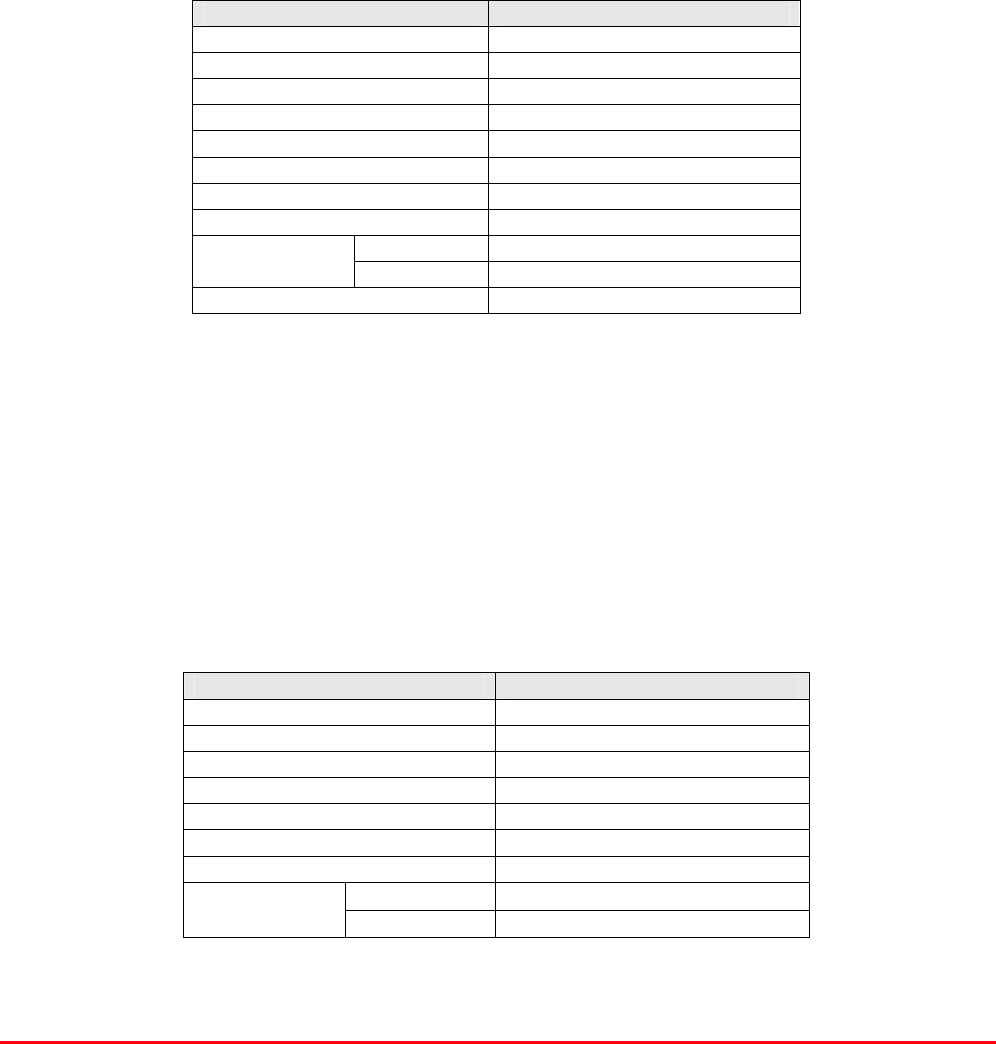
STTRS DOCUMENTATION
Document Number 80-330501HBKM – Issue A - Draft Page 218 of 500
12.4.1.3. Bandpass Filter (02-007206)
The bandpass filters are multi-section designs with a bandwidth dependent upon the passband
frequencies, (both tuned to customer requirements). The response shape is basically Chebyshev with
a passband design ripple of 0.1dB. The filters are of slot coupled, folded combline design, and are
carefully aligned during manufacture in order to optimise the insertion loss, VSWR and
intermodulation characteristics of the unit. The tuned elements are silver-plated to reduce surface
ohmic losses and maintain a good VSWR figure and 50Ω load at the input and output ports.
Being passive devices, the bandpass filters should have an extremely long operational life and require
no maintenance. Should a filter be suspect, it is usually most time efficient to replace the module
rather than attempt repair or re-tuning.
No adjustments should be attempted without full network sweep analysis facilities to monitor both
insertion loss and VSWR simultaneously.
02-007206 Specification
PARAMETER SPECIFICATION
Response type Chebyshev
Frequency range 800 - 950MHz *
Bandwidth 25MHz *
Number of sections 8
Insertion loss 1.2 dB
VSWR better than 1.2:1
Connectors SMA female
Power handling 100W max
operation -20°C to +60°C Temperature
range storage -40°C to +70°C
Weight 3 kg (typical) *tuned to Customer's specification
12.4.1.4. Wideband Asymmetric Coupler (07-015105)
The purpose of Wideband Asymmetric Coupler (07-015105) is to tap off a known portion (in this case
30dB) of RF signal from transmission lines and to combine them, for example through splitter units for
different purposes (alarms/monitoring etc.), whilst maintaining an accurate 50Ω load to all
ports/interfaces throughout the specified frequency range. They are known formally as directional
couplers as they couple power from the RF mainline in one direction only.
07-015105 Specification
PARAMETER SPECIFICATION
Construction Inductive air gap
Frequency 800-2500MHz
Through loss 0.4dB (typical)
Coupling level -30dB ±0.5dB
Isolation N/A
Weight <1.0kg
Connectors SMA, female
operation -20°C to +60°C
Temperature
range storage -40°C to +70°C
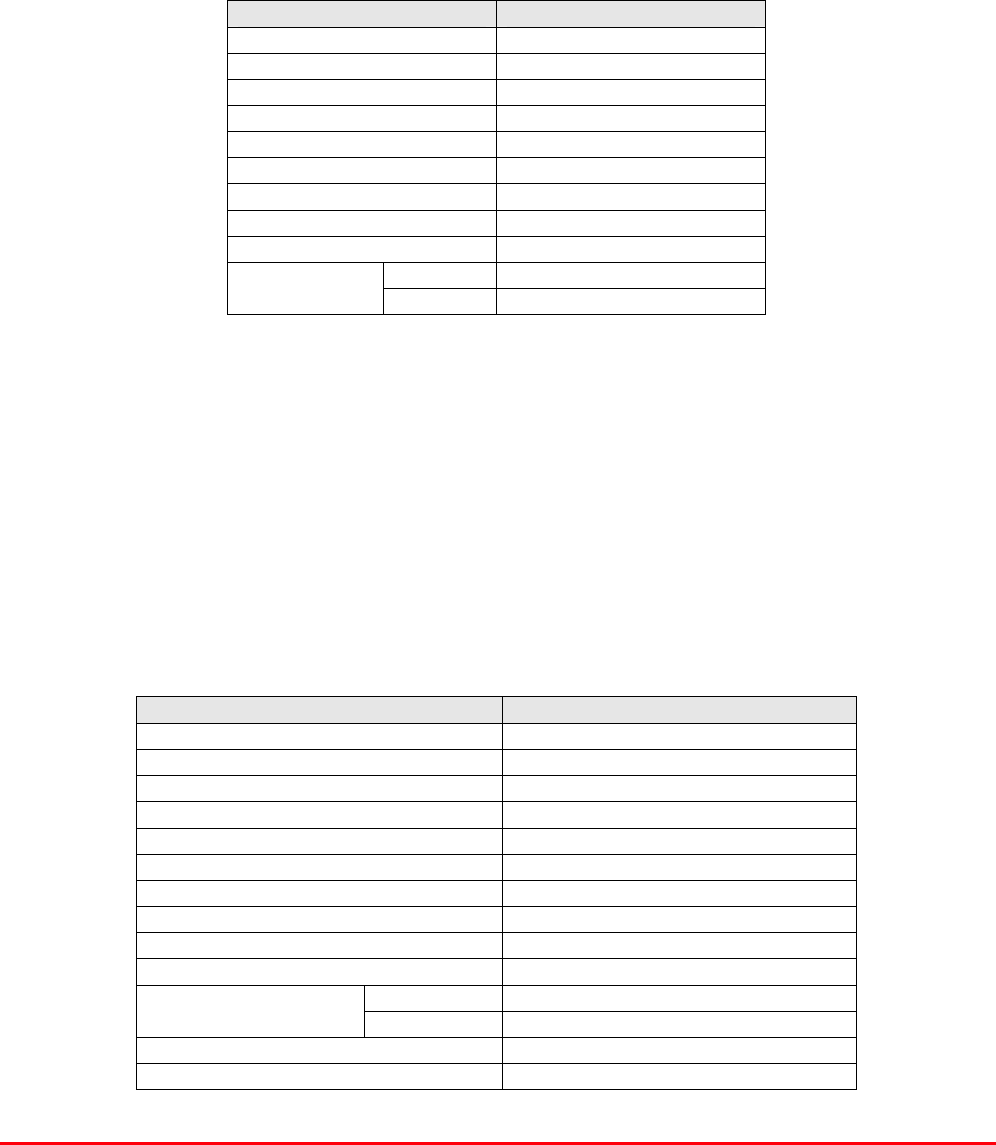
STTRS DOCUMENTATION
Document Number 80-330501HBKM – Issue A - Draft Page 219 of 500
12.4.1.5. Switched Attenuator 0.25W, 0 - 15dB (10-000901)
In many practical applications for Cell Enhancers etc., the gain in each path is found to be excessive.
Therefore, provision is made within the unit for the setting of attenuation in each path, to reduce the
gain.
10-000901 provides attenuation from 0 - 15dB in 2 dB steps The attenuation is simply set using the
four miniature toggle switches on the top of each unit. Each switch is clearly marked with the
attenuation it provides, and the total attenuation in line is the sum of the values switched in. They are
designed to maintain an accurate 50Ω impedance over their operating frequency at both input and
output.
10-000901 Specification
PARAMETER SPECIFICATION
Attenuation Values 0-15dB
Attenuation Steps 1, 2, 4 and 8dB
Power Handling 0.25 Watt
Attenuation Accuracy ± 1.0 dB
Frequency Range DC to 1GHz
Impedance 50Ω
Connectors SMA
VSWR 1.3:1
Weigh 0.2kg
operation -20°C to +60°C Temperature
range storage -40°C to +70°C
12.4.1.6. Low Noise Amplifier (11-006702)
The Gallium-Arsenide low noise amplifiers used in 800MHz Line Amplifier (55-165703) are double
stage, solid-state low noise amplifiers. Class A circuitry is used throughout the units to ensure
excellent linearity and extremely low noise over a very wide dynamic range. The active devices are
very moderately rated to provide a long trouble-free working life. There are no adjustments on these
amplifiers, and in the unlikely event of a failure, then the complete amplifier should be replaced. This
amplifier features its own in-built alarm system which gives a volt-free relay contact type alarm that is
easily integrated into the main alarm system.
11-006702 Specification
PARAMETER SPECIFICATION
Frequency range: 800 – 1000MHz
Bandwidth: <200MHz
Gain: 29dB (typical)
1dB Compression point: 20dBm
OIP3: 33dBm
Input/Output return loss: >18dB
Noise figure: 1.3dB (typical)
Power consumption: 180mA @ 24V DC
Supply voltage: 10-24V DC
Connectors: SMA female
operational: -10°C to +60°C
Temperature range: storage: -20°C to +70°C
Size: 90 x 55 x 30.2mm
Weight: 290gms (approximately)
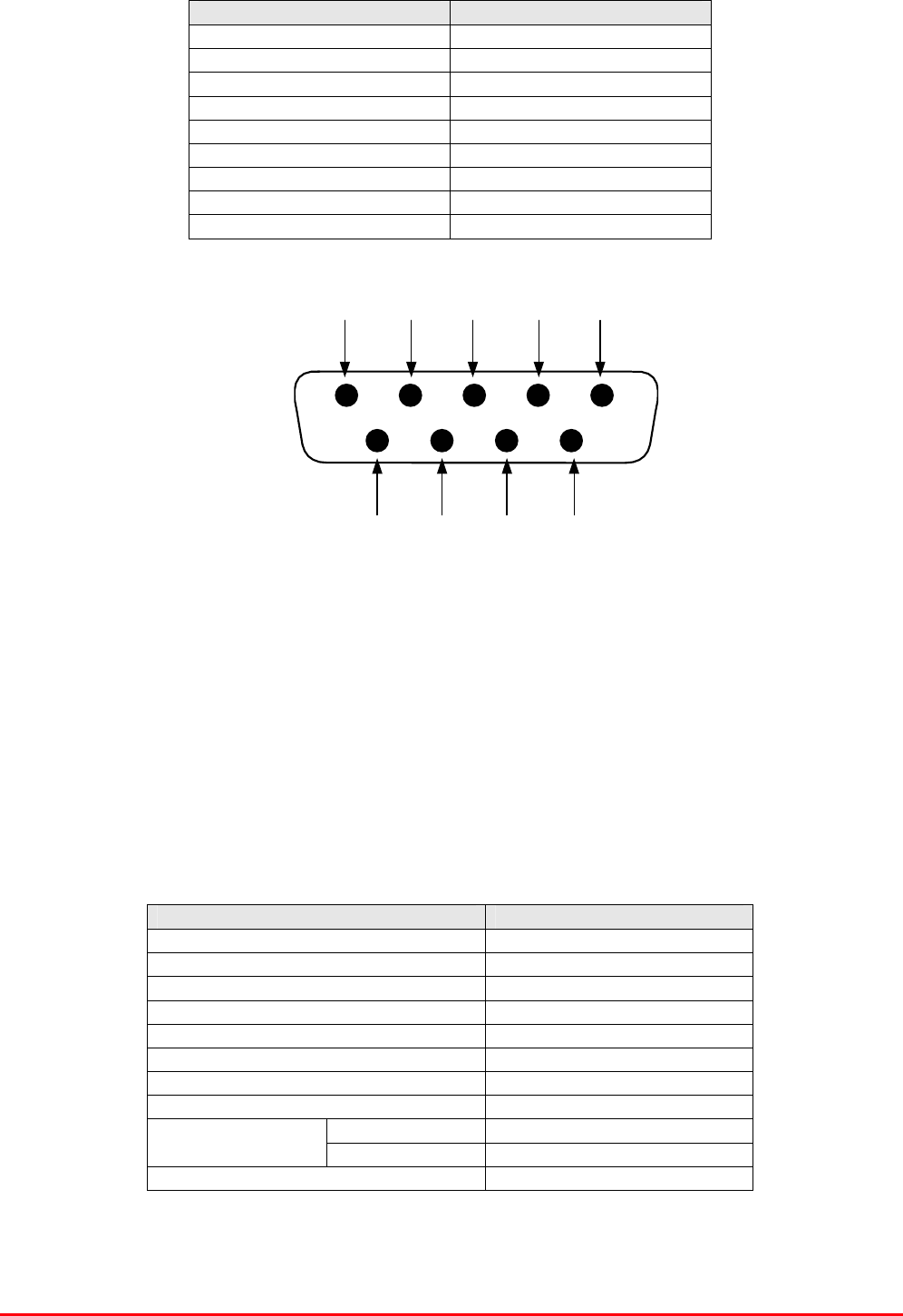
STTRS DOCUMENTATION
Document Number 80-330501HBKM – Issue A - Draft Page 220 of 500
7 8 96
1 2 3 4 5
9-Way Pin-Out Graphical Representation
Low Noise Amplifier (11-006702) ‘D’ Connector Pin-out details
Connector pin Signal
1 +Ve input (10-24V)
2 GND
3 Alarm RelayO/P bad
4 Alarm Relay common
5 Alarm Relay good
6 No connection
7 TTL voltage set
8 TTL alarm/0V (good)
9 O/C good/0V bad
12.4.1.7. Power Amplifier (12-018002)
This amplifier is a Class A 20W power amplifier from 800-960MHz in a 1 stage balanced
configuration. It demonstrates a very high linearity and a very good input/output return loss (RL). It
has built in a Current Fault Alarm Function.
Its housing is an aluminium case (Iridite NCP finish) with SMA connectors for the RF input/output and
a D-Type connector for the power supply and the Current Fault Alarm Function.
12-018002 Specification
PARAMETER SPECIFICATION
Frequency range: 800-960MHz
Small signal gain: 30dB
Gain flatness: ±1.2dB
I/O Return loss: >18dB
1dB compression point: 42.8dBm
OIP3: 56dBm
Supply voltage: 24V DC
Supply current: 5.0Amps (Typical)
operational: -10°C to +60°C Temperature
range storage: -20°C to +70°C
Weight: <2kg (no heatsink)
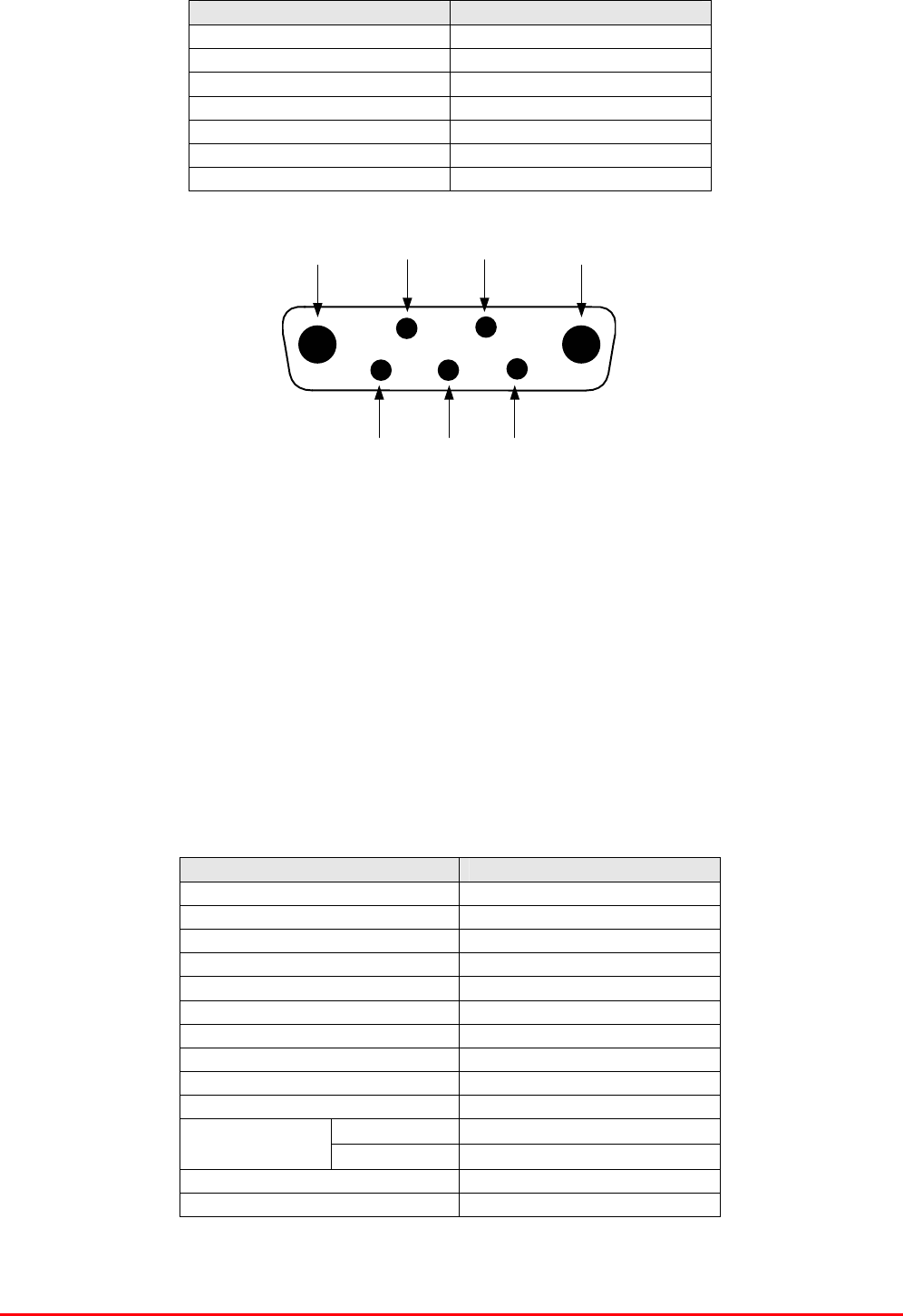
STTRS DOCUMENTATION
Document Number 80-330501HBKM – Issue A - Draft Page 221 of 500
Power Amplifier (12-018002) 7-Way Connector Pin-outs
Connector Pin Signal
A1 (large pin) +24V DC
A2 (large pin) GND
1 Alarm relay common
2 TTL alarm/0V good
3 Alarm relay contact (bad)
4 Alarm relay contact (good)
5 O/C good/0V bad (TTL)
12.4.1.8. Low Power Amplifier (12-021901)
The low power amplifier used is a triple stage solid-state low-noise amplifier. Class A circuitry is used
in the unit to ensure excellent linearity over a very wide dynamic range. The three active devices are
very moderately rated to provide a long trouble-free working life.
Its housing is an aluminium case (Iridite NCP finish) with SMA connectors for the RF input/output and
a D-Type connector for the power supply and the Current Fault Alarm Function.
There are no adjustments on this amplifier, and in the unlikely event of failure then the entire amplifier
should be replaced.
Low Power Amplifier (12-021901) Specification
PARAMETER SPECIFICATION
Frequency range 800-960MHz*
Bandwidth 20MHz *
Maximum RF output >1.0 Watt
Gain 15dB
1dB compression point +30.5dBm
3rd order intercept point +43dBm
Noise Figure <6dB
VSWR better than 1.5:1
Connectors SMA female
Supply 500mA @ 10-15V DC
operational -10°C to +60°C
Temperature
range storage -20°C to +70°C
Weight 0.5 kg
Size 167x52x25mm
* Tuned to Customer’s specification
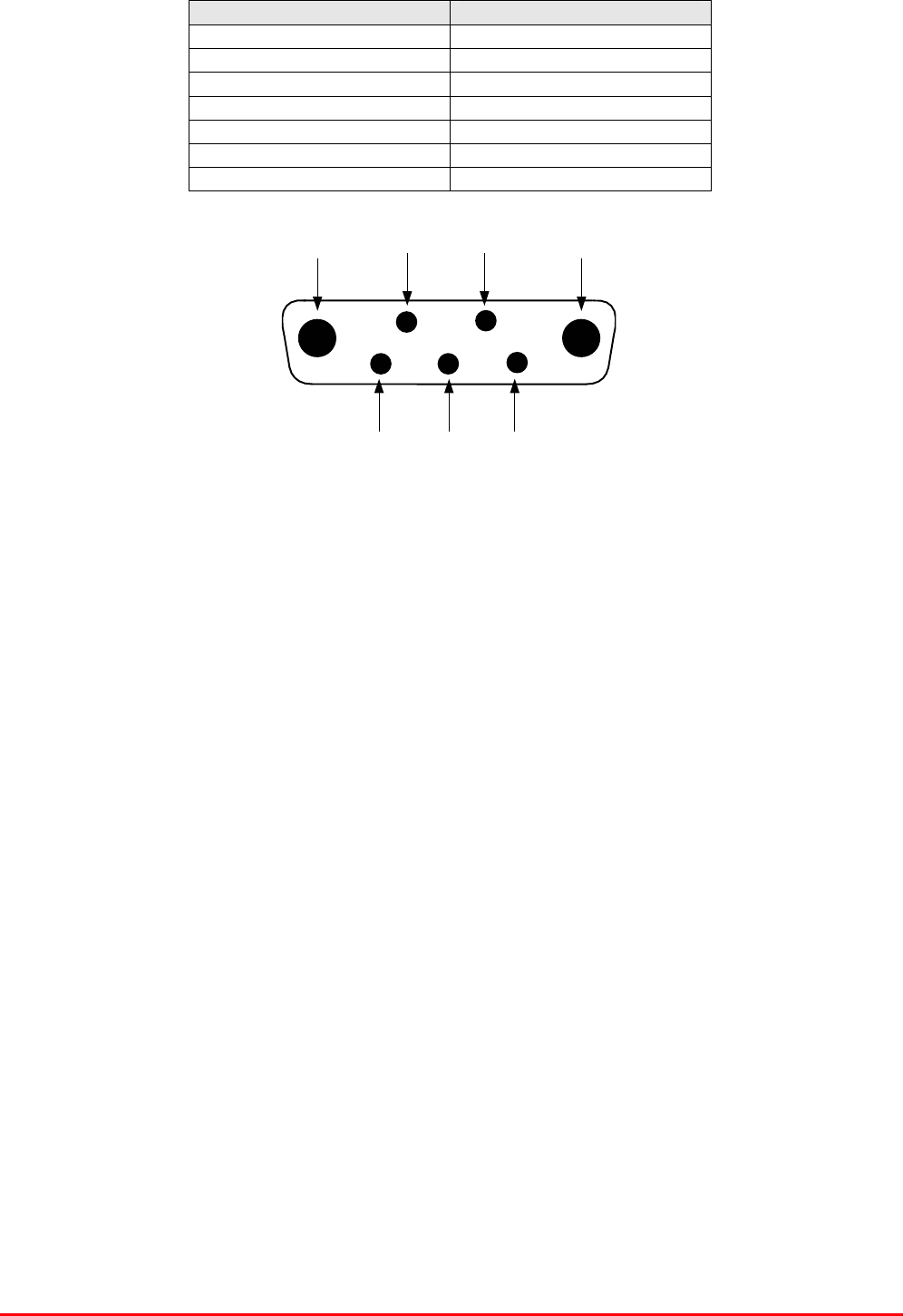
STTRS DOCUMENTATION
Document Number 80-330501HBKM – Issue A - Draft Page 222 of 500
Low Power Amplifier (12-021901) 7-Way Connector Pin-outs
Connector Pin Signal
A1 (large pin) +24V DC
A2 (large pin) GND
1 Alarm relay common
2 TTL alarm/0V good
3 Alarm relay contact (bad)
4 Alarm relay contact (good)
5 O/C good/0V bad (TTL)
12.4.1.9. Automatic Gain Control
17-001109 AGC Detector Assembly (Logarithmic)
17-001117 AGC Detector Assembly
17-001201 AGC Attenuator Assembly
The sub components 17-001109, 17-001117 & 17-001201 are parts of the Automatic Gain Control
(AGC) system used in 800MHz Line Amplifier (55-165703); 17-001117 and 17-001201 are paired for
use in the uplink and 17-001109 and 17-001201 are paired for use in the downlink
800MHz Line Amplifier (55-165703) is fitted with two differing types of Automatic Gain Control (AGC)
system, one linear, and one logarithmic. The AGC with logarithmic detector (17-001117) is fitted in the
uplink path and the AGC with linear detector (17-001109) is fitted in the downlink path
The AFL Automatic Gain Control system consists of two units, a detector/amplifier and an attenuator.
The detector/amplifier unit is inserted in the RF path on the output of the power amplifier, and the
attenuator is situated in the RF path between the 1st and 2nd stages of amplification.
17-001117 and 17-001201 are paired for use in the uplink and 17-001109 and 17-001201 are paired
for use in the downlink
The attenuator comprises a 50Ω P.I.N diode, voltage-variable attenuator with a range of 3 to 30dB.
The attenuation is controlled by a DC voltage which is derived from the associated detector controller
board.
Normally the attenuator is at minimum attenuation. The detector/amplifier unit monitors the RF level
being delivered by the power amplifier, and when a certain threshold is reached it begins to increase
the value of the attenuator to limit the RF output to the (factory set) threshold. Therefore overloading
of the power amplifier is avoided.
The factory set threshold is 1dB below the Enhancer 1dB compression point. Some adjustment of this
AGC threshold level is possible, a 10dB range is mostly achieved. It is not recommended under any
circumstances to adjust the AGC threshold to a level greater than the 1dB compression point as
system degradation will occur.
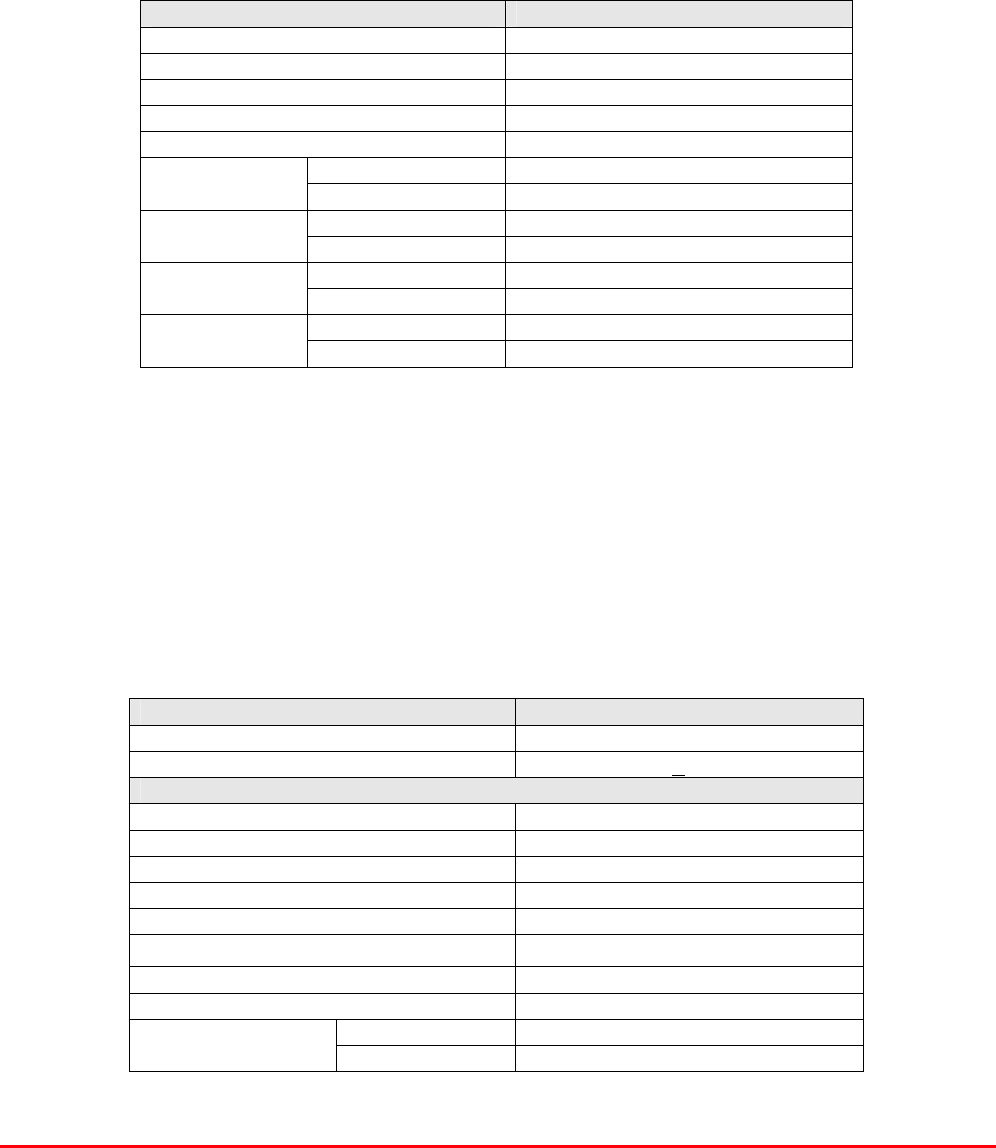
STTRS DOCUMENTATION
Document Number 80-330501HBKM – Issue A - Draft Page 223 of 500
The detector comprises of a 50Ω transmission line with a resistive tap which samples a small portion
of the mainline power. The sampled signal is amplified and fed to a conventional half wave diode
rectifier, the output of which is a DC voltage proportional to the RF input signal.
This DC voltage is passed via an inverting DC amplifier with integrating characteristics, to the output,
which drives the attenuation control line of the corresponding AGC attenuator. This unit is fitted at
some earlier point in the RF circuit.
For small signals, below AGC onset, the output control line will be close to 12V and the AGC
attenuator will have minimum attenuation. As the signal level increases the control line voltage will
fall, increasing the attenuator value and keeping the system output level at a constant value.
AGC Specification (both types)
PARAMETER SPECIFICATION
Frequency range up to 1000MHz
Attenuation range 3 to 30dB
Attenuation steps continuously variable
VSWR better than 1.2:1
RF Connectors SMA female
attenuator 1W Power
handling detector/amp >30W (or as required)
operation -10°C to +60°C Temperature
range storage -20°C to +70°C
attenuator pcb 50 x 42 x 21mm
Size detector/amp pcb 54 x 42 x 21mm
attenuator 90grams
Weight detector/amp 100grams
12.4.1.10. 12V (Dual) Relay Board (20-001601)
The General Purpose Relay Board allows the inversion of signals and the isolation of circuits. It is
equipped with two dual pole change-over relays with completely isolated wiring, accessed via screw
terminals. Both relays are provided with polarity protection diodes and diodes for suppressing the
transients caused by "flywheel effect" which can destroy switching transistors or induce spikes on
neighbouring circuits. It’s common use is to amalgamate all the alarm signals into one, volts-free relay
contact pair for the main alarm system.
20-001601 Specification
PARAMETER SPECIFICATION
Operating voltage: 8 to 30V (floating earth)
Alarm threshold: Vcc - 1.20 volt +15%
Alarm output relay contacts:
Max. switch current: 1.0Amp
Max. switch volts: 120Vdc/60VA
Max. switch power: 24W/60VA
Min. switch load: 10.0µA/10.0mV
Relay isolation: 1.5kV
Mechanical life: >2x107 operations
Relay approval: BT type 56
Connector details: Screw terminals
operational: -10°C to +60°C Temperature
range storage: -20°C to +70°C
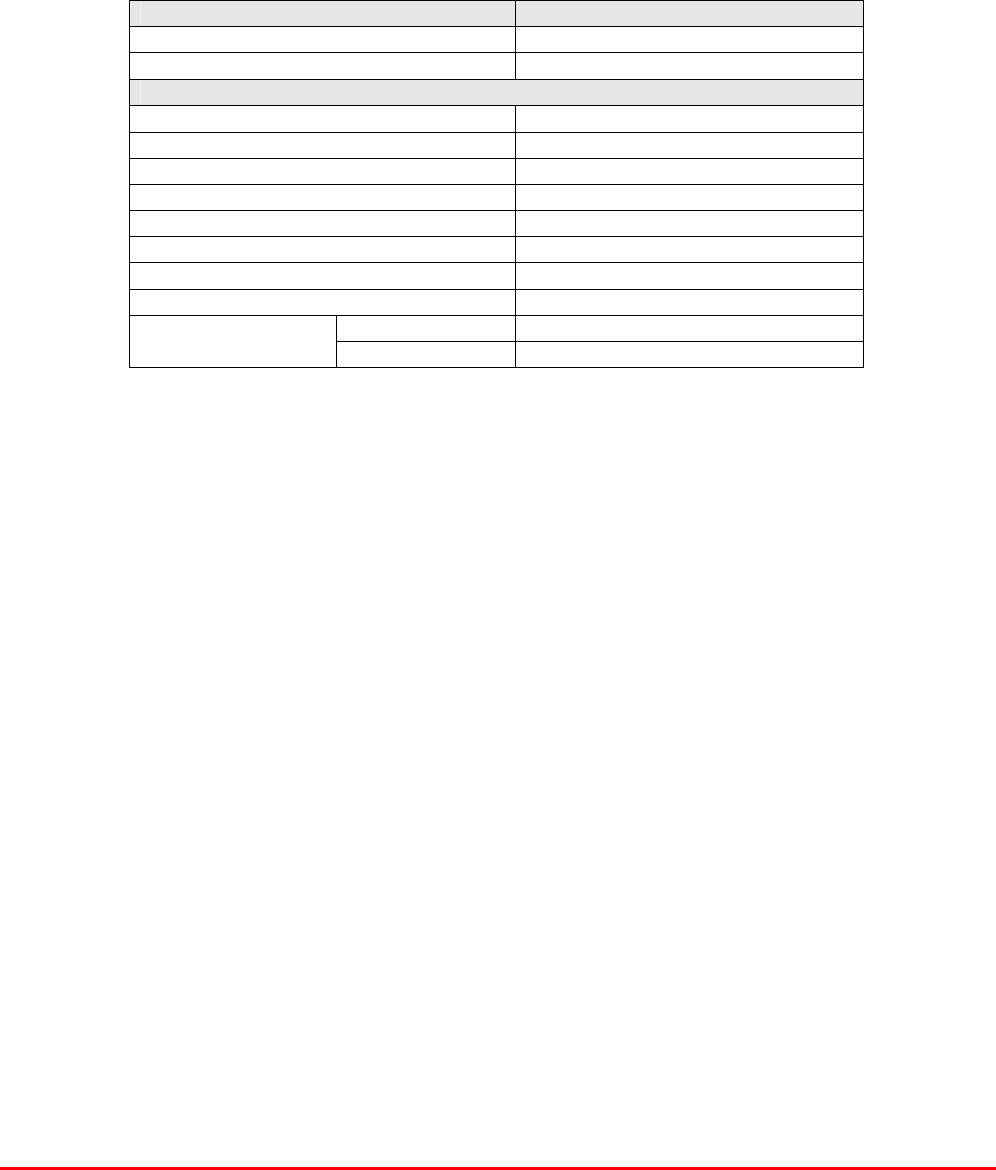
STTRS DOCUMENTATION
Document Number 80-330501HBKM – Issue A - Draft Page 224 of 500
12.4.1.11. 12V (Single) Relay Board (80-008901)
The General Purpose Relay Board allows the inversion of signals and the isolation of circuits. It is
equipped with a single dual pole change-over relay RL1, with completely isolated wiring, accessed
via a 15 way in-line connector.
The relay is provided with polarity protection diodes and diodes for suppressing the transients caused
by "flywheel effect" which can destroy switching transistors or induce spikes on neighbouring circuits.
It’s common use is to amalgamate all the alarm signals into one, volts-free relay contact pair for the
main alarm system.
80-008901 Specification
PARAMETER SPECIFICATION
Operating voltage 8 to 30V (floating earth)
Alarm threshold Vcc - 1.20 volt +15%
Alarm output relay contacts:
Max. switch current 1.0Amp
Max. switch volts 120Vdc/60VA
Max. switch power 24W/60VA
Min. switch load 10.0µA/10.0mV
Relay isolation 1.5kV
Mechanical life >2x107 operations
Relay approval BT type 56
Connector details Screw terminals
operational -10°C to +60°C Temperature
range storage -20°C to +70°C
12.4.1.12. Dual Diode Assembly (94-100004)
The purpose of these dual diode assemblies is to allow two DC voltage sources to be combined, so
that the main DC rail within the equipment can be sourced from either a mains driven PSU, or
externally through an XLR connector or from dual mains driven PSUs . They are very heavy-duty
diodes and they prevent any reverse current from flowing back to their source or the alternative
supply rail. Combining diodes such as these will also be used if the equipment is to be powered from
external back-up batteries.
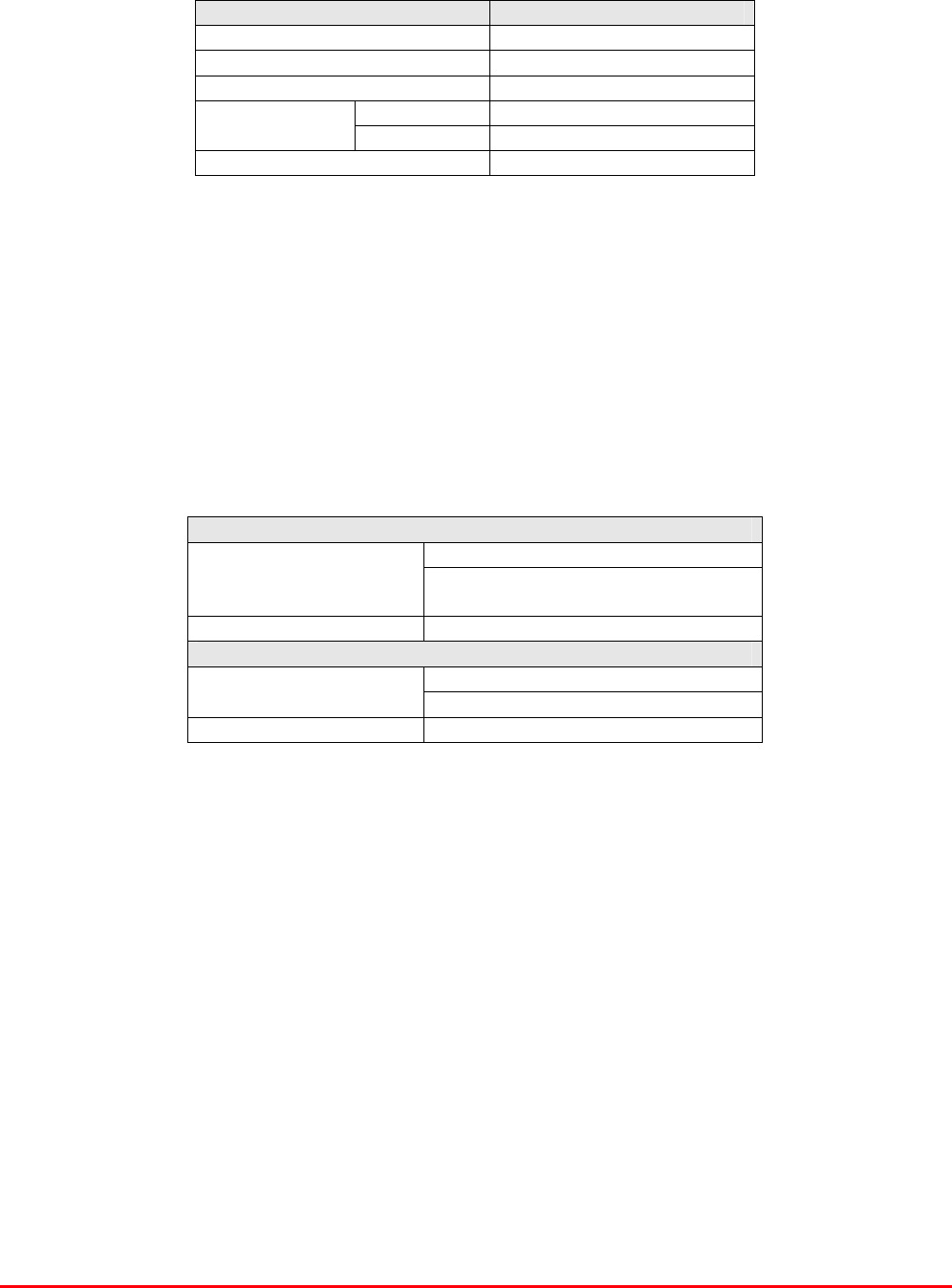
STTRS DOCUMENTATION
Document Number 80-330501HBKM – Issue A - Draft Page 225 of 500
12.4.1.13. DC/DC Converter 96-200047
96-200047 is an O.E.M. high power device with a wide input range and 12.5 amp @ 12V (150Watts)
output capability used to derive a 12V fixed voltage power supply rail from a higher voltage supply, in
this case 12V. In the event of failure this unit should not be repaired, only replaced.
PARAMETER SPECIFICATION
DC Input Voltage range 19 to 36V
DC Output voltage 12V ± 1%
Max. current load 12.5Amps
Operation -10°C to +60°C Temperature
range Storage -20°C to +85°C
Working Humidity 20 to 90% RHNC
12.4.1.14. 12V Switch-Mode PSU (96-300052)
No routine maintenance of the PSU is required. If a fault is suspected, then the output voltage from
the power supply may be measured on its output terminals. This is typically set to 12.2V. The
adjustment potentiometer will be found close to the DC output terminals.
All the PSUs used in AFL Cell Enhancers are capable of operation from either 110 or 220V nominal
AC supplies. The line voltage is sensed automatically, so no adjustment or link setting is needed by
the operator.
96-300052 Specification
AC Input Supply 110 or 220V nominal
Voltage 85 - 265V AC
(absolute limits)
Frequency 47 to 63Hz
DC Output Supply 12V DC (nominal)
Voltage 10.5-13.8V (absolute limits)
Current 12.5A
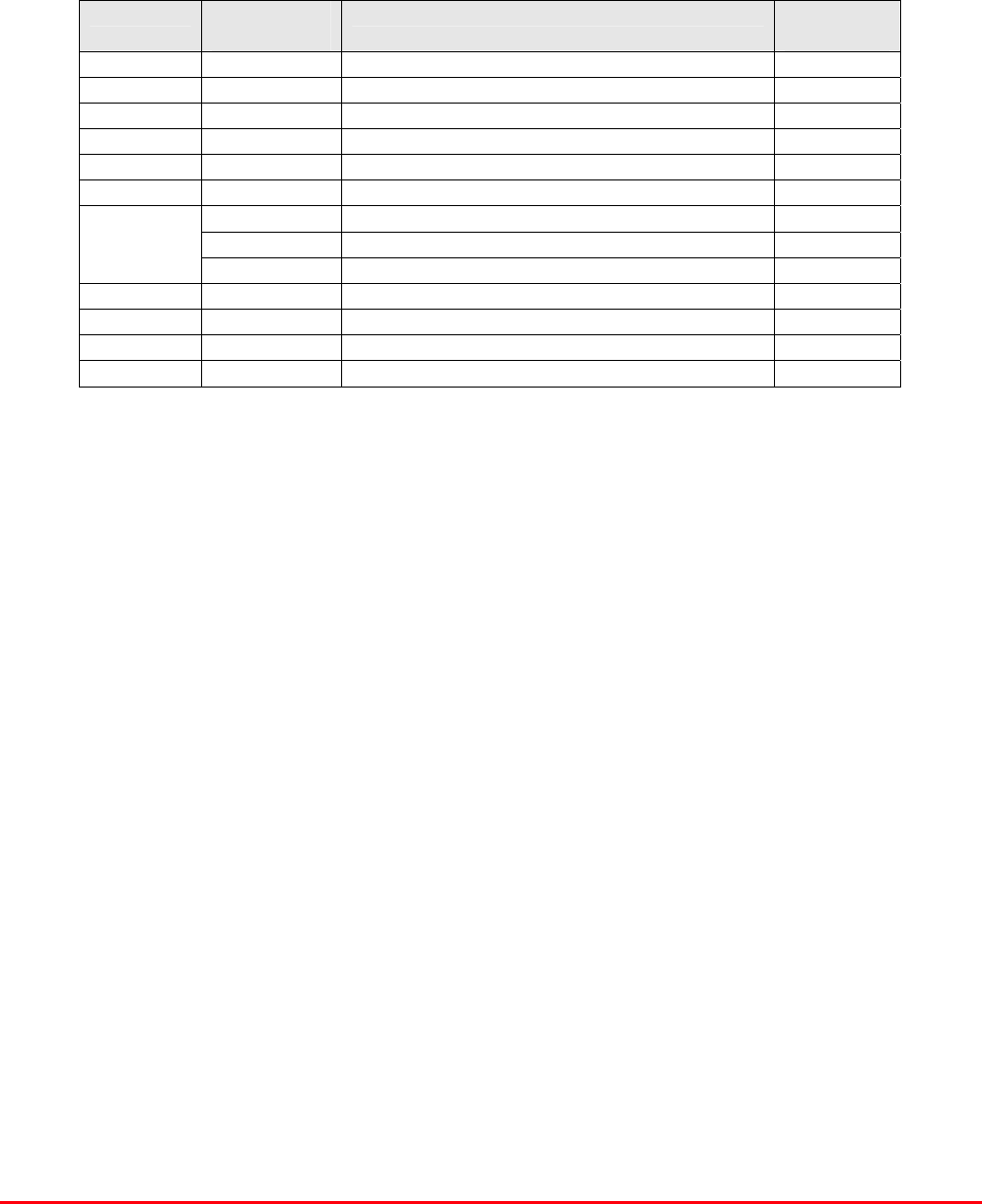
STTRS DOCUMENTATION
Document Number 80-330501HBKM – Issue A - Draft Page 226 of 500
12.4.2 700MHz Line Amplifier (55-165704)
Description of 700MHz Line Amplifier (55-165704)
700MHz Line Amplifier (55-165704) List of Major Components
Section Component
Part Component Part Description Qty. Per
Assembly
12.4.2.3. 02-007206 Bandpass Filter 4
12.4.2.4. 07-015105 Wideband Asymmetric Coupler 1
12.4.2.5. 10-000901 Switched Attenuator 0.25W, 0 - 15dB 2
12.4.2.6. 11-006702 Low Noise Amplifier 1
12.4.2.7. 12-018002 Power Amplifier (20W 800MHz ) 1
12.4.2.8. 12-021901 Low Power Amplifier 2
17-001109* AGC Detector Assembly (Logarithmic) 1
17-001117* AGC Detector Assembly 1
12.4.2.9.
17-001201* AGC Attenuator Assembly 2
12.4.2.10. 80-008901 12V (Single) Relay Board 1
12.4.2.11. 94-100004 Dual Diode Assembly 1
12.4.2.12. 96-200047 DC/DC Converter 1
12.4.2.13. 96-300052 12V Switch-Mode PSU 1
*The sub components 17-001109, 17-001117 & 17-001201 are parts of the Automatic Gain Control
(AGC) system used in 800MHz Line Amplifier (55-165703); 17-001117 and 17-001201 are paired for
use in the uplink and 17-001109 and 17-001201 are paired for use in the downlink
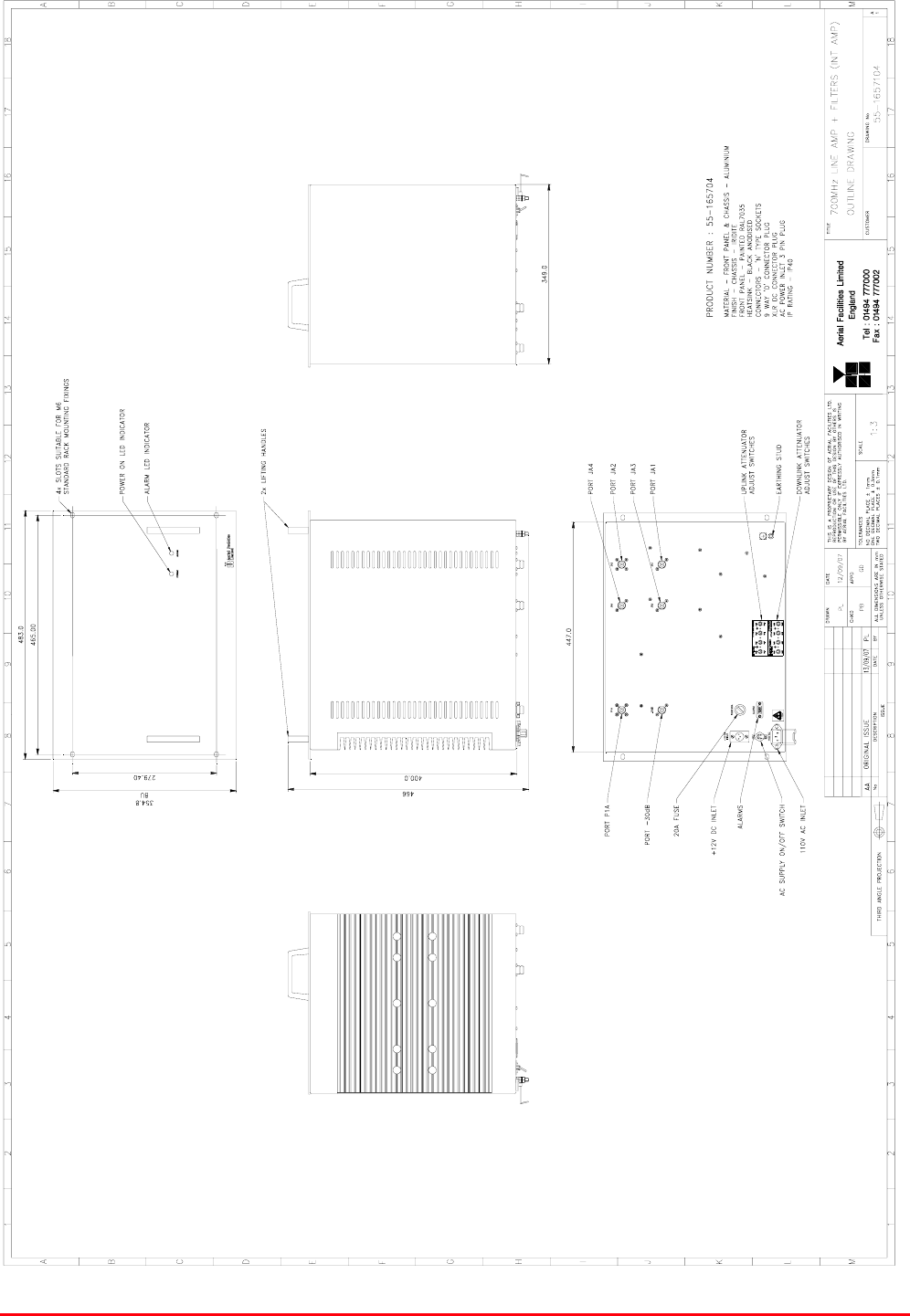
STTRS DOCUMENTATION
Document Number 80-330501HBKM – Issue A - Draft Page 227 of 500
12.4.2.1. 700MHz Line Amplifier (55-165704) Outline Drawing
Drawing number 55-1657104
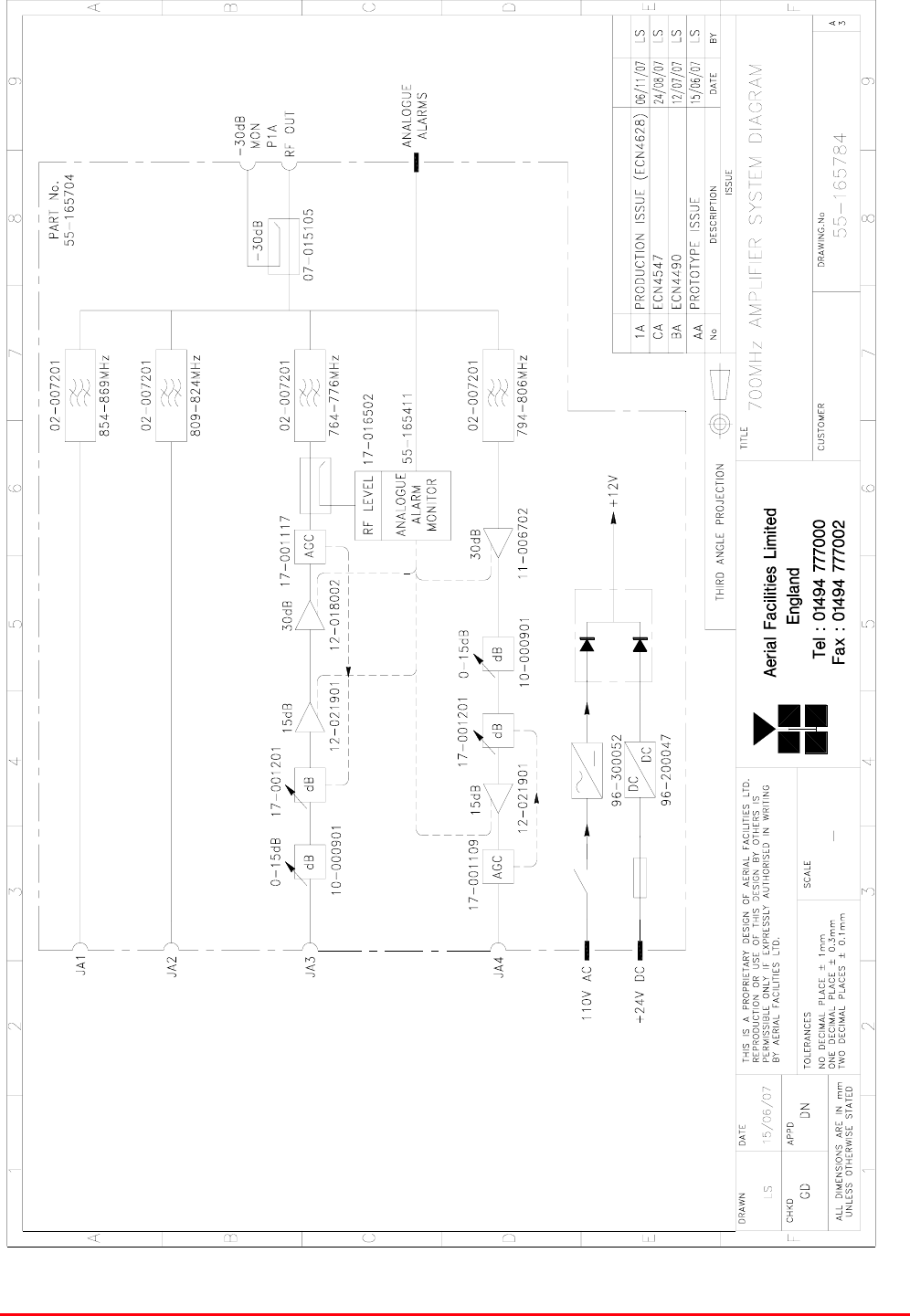
STTRS DOCUMENTATION
Document Number 80-330501HBKM – Issue A - Draft Page 228 of 500
12.4.2.2. 700MHz Line Amplifier (55-165704) System Diagram
Drawing number 55-165784
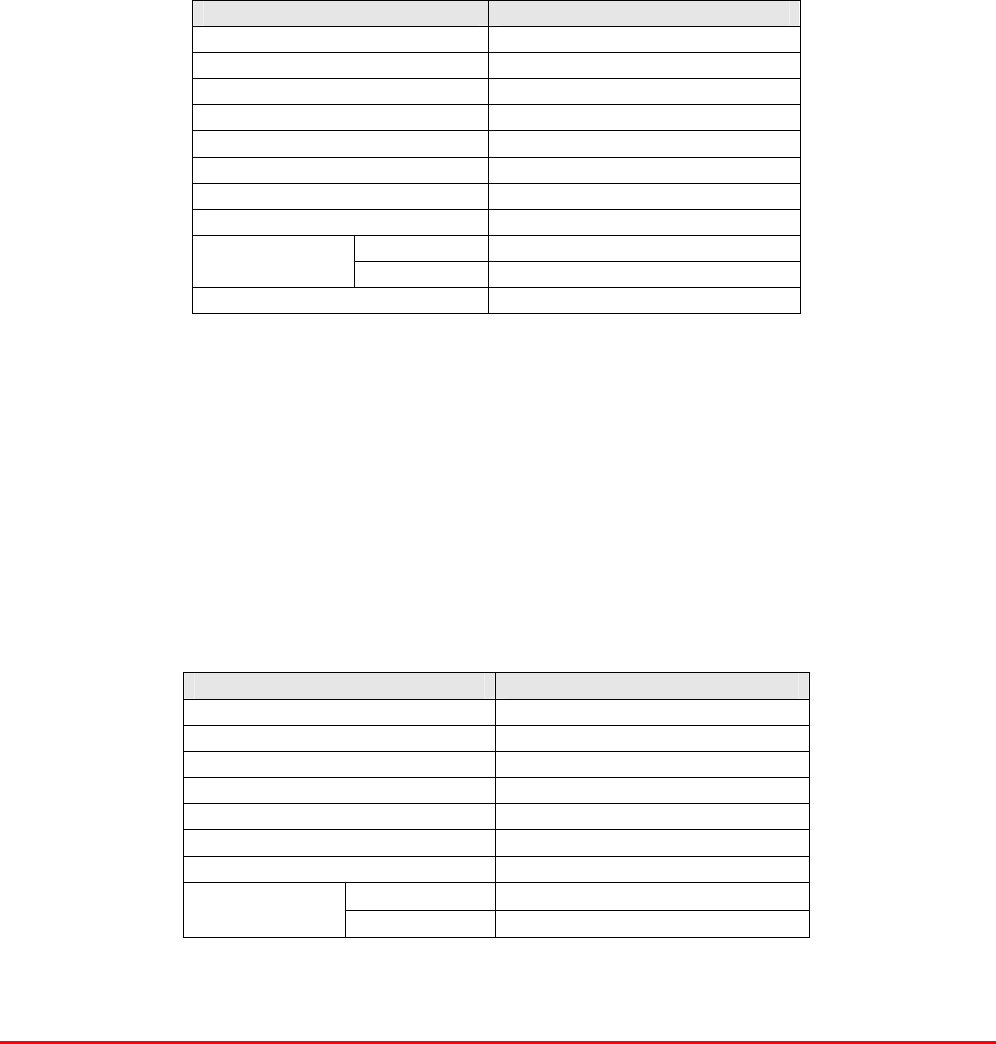
STTRS DOCUMENTATION
Document Number 80-330501HBKM – Issue A - Draft Page 229 of 500
12.4.2.3. Bandpass Filter (02-007206)
The bandpass filters are multi-section designs with a bandwidth dependent upon the passband
frequencies, (both tuned to customer requirements). The response shape is basically Chebyshev with
a passband design ripple of 0.1dB. The filters are of slot coupled, folded combline design, and are
carefully aligned during manufacture in order to optimise the insertion loss, VSWR and
intermodulation characteristics of the unit. The tuned elements are silver-plated to reduce surface
ohmic losses and maintain a good VSWR figure and 50Ω load at the input and output ports.
Being passive devices, the bandpass filters should have an extremely long operational life and require
no maintenance. Should a filter be suspect, it is usually most time efficient to replace the module
rather than attempt repair or re-tuning.
No adjustments should be attempted without full network sweep analysis facilities to monitor both
insertion loss and VSWR simultaneously.
02-007206 Specification
PARAMETER SPECIFICATION
Response type Chebyshev
Frequency range 800 - 950MHz *
Bandwidth 25MHz *
Number of sections 8
Insertion loss 1.2 dB
VSWR better than 1.2:1
Connectors SMA female
Power handling 100W max
operation -20°C to +60°C Temperature
range storage -40°C to +70°C
Weight 3 kg (typical) *tuned to Customer's specification
12.4.2.4. Wideband Asymmetric Coupler (07-015105)
The purpose of Wideband Asymmetric Coupler (07-015105) is to tap off a known portion (in this case
30dB) of RF signal from transmission lines and to combine them, for example through splitter units for
different purposes (alarms/monitoring etc.), whilst maintaining an accurate 50Ω load to all
ports/interfaces throughout the specified frequency range. They are known formally as directional
couplers as they couple power from the RF mainline in one direction only.
07-015105 Specification
PARAMETER SPECIFICATION
Construction Inductive air gap
Frequency 800-2500MHz
Through loss 0.4dB (typical)
Coupling level -30dB ±0.5dB
Isolation N/A
Weight <1.0kg
Connectors SMA, female
operation -20°C to +60°C
Temperature
range storage -40°C to +70°C
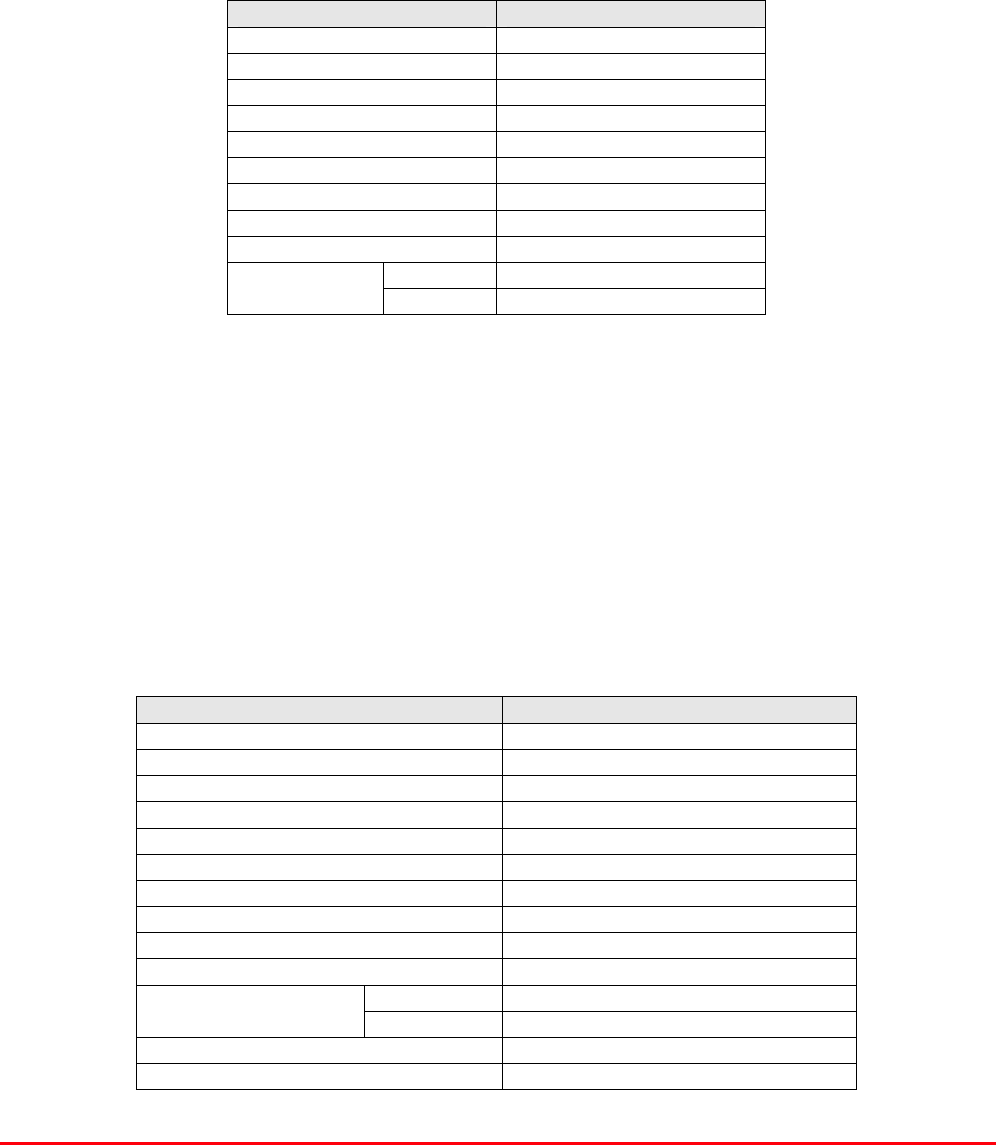
STTRS DOCUMENTATION
Document Number 80-330501HBKM – Issue A - Draft Page 230 of 500
12.4.2.5. Switched Attenuator 0.25W, 0 - 15dB (10-000901)
In many practical applications for Cell Enhancers etc., the gain in each path is found to be excessive.
Therefore, provision is made within the unit for the setting of attenuation in each path, to reduce the
gain.
10-000901 provides attenuation from 0 - 15dB in 2 dB steps The attenuation is simply set using the
four miniature toggle switches on the top of each unit. Each switch is clearly marked with the
attenuation it provides, and the total attenuation in line is the sum of the values switched in. They are
designed to maintain an accurate 50Ω impedance over their operating frequency at both input and
output.
10-000901 Specification
PARAMETER SPECIFICATION
Attenuation Values 0-15dB
Attenuation Steps 1, 2, 4 and 8dB
Power Handling 0.25 Watt
Attenuation Accuracy ± 1.0 dB
Frequency Range DC to 1GHz
Impedance 50Ω
Connectors SMA
VSWR 1.3:1
Weigh 0.2kg
operation -20°C to +60°C Temperature
range storage -40°C to +70°C
12.4.2.6. Low Noise Amplifier (11-006702)
The Gallium-Arsenide low noise amplifiers used in 700MHz Line Amplifier (55-165704) are double
stage, solid-state low noise amplifiers. Class A circuitry is used throughout the units to ensure
excellent linearity and extremely low noise over a very wide dynamic range. The active devices are
very moderately rated to provide a long trouble-free working life. There are no adjustments on these
amplifiers, and in the unlikely event of a failure, then the complete amplifier should be replaced. This
amplifier features its own in-built alarm system which gives a volt-free relay contact type alarm that is
easily integrated into the main alarm system.
11-006702 Specification
PARAMETER SPECIFICATION
Frequency range: 800 – 1000MHz
Bandwidth: <200MHz
Gain: 29dB (typical)
1dB Compression point: 20dBm
OIP3: 33dBm
Input/Output return loss: >18dB
Noise figure: 1.3dB (typical)
Power consumption: 180mA @ 24V DC
Supply voltage: 10-24V DC
Connectors: SMA female
operational: -10°C to +60°C
Temperature range: storage: -20°C to +70°C
Size: 90 x 55 x 30.2mm
Weight: 290gms (approximately)
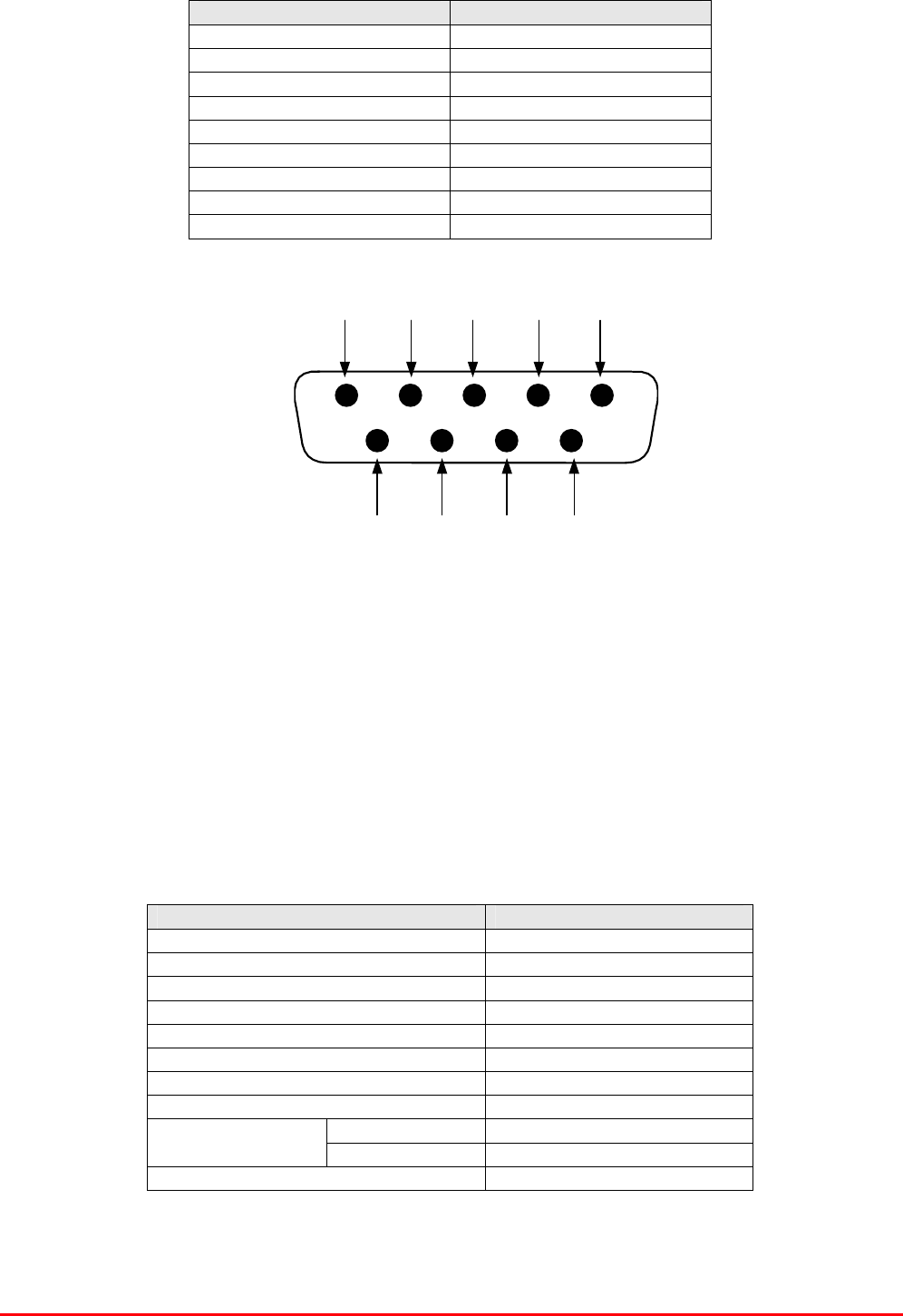
STTRS DOCUMENTATION
Document Number 80-330501HBKM – Issue A - Draft Page 231 of 500
7 8 96
1 2 3 4 5
9-Way Pin-Out Graphical Representation
Low Noise Amplifier (11-006702) ‘D’ Connector Pin-out details
Connector pin Signal
1 +Ve input (10-24V)
2 GND
3 Alarm RelayO/P bad
4 Alarm Relay common
5 Alarm Relay good
6 No connection
7 TTL voltage set
8 TTL alarm/0V (good)
9 O/C good/0V bad
12.4.2.7. Power Amplifier (12-018002)
This amplifier is a Class A 20W power amplifier from 800-960MHz in a 1 stage balanced
configuration. It demonstrates a very high linearity and a very good input/output return loss (RL). It
has built in a Current Fault Alarm Function.
Its housing is an aluminium case (Iridite NCP finish) with SMA connectors for the RF input/output and
a D-Type connector for the power supply and the Current Fault Alarm Function.
Technical Specification
PARAMETER SPECIFICATION
Frequency range: 800-960MHz
Small signal gain: 30dB
Gain flatness: ±1.2dB
I/O Return loss: >18dB
1dB compression point: 42.8dBm
OIP3: 56dBm
Supply voltage: 24V DC
Supply current: 5.0Amps (Typical)
operational: -10°C to +60°C Temperature
range storage: -20°C to +70°C
Weight: <2kg (no heatsink)
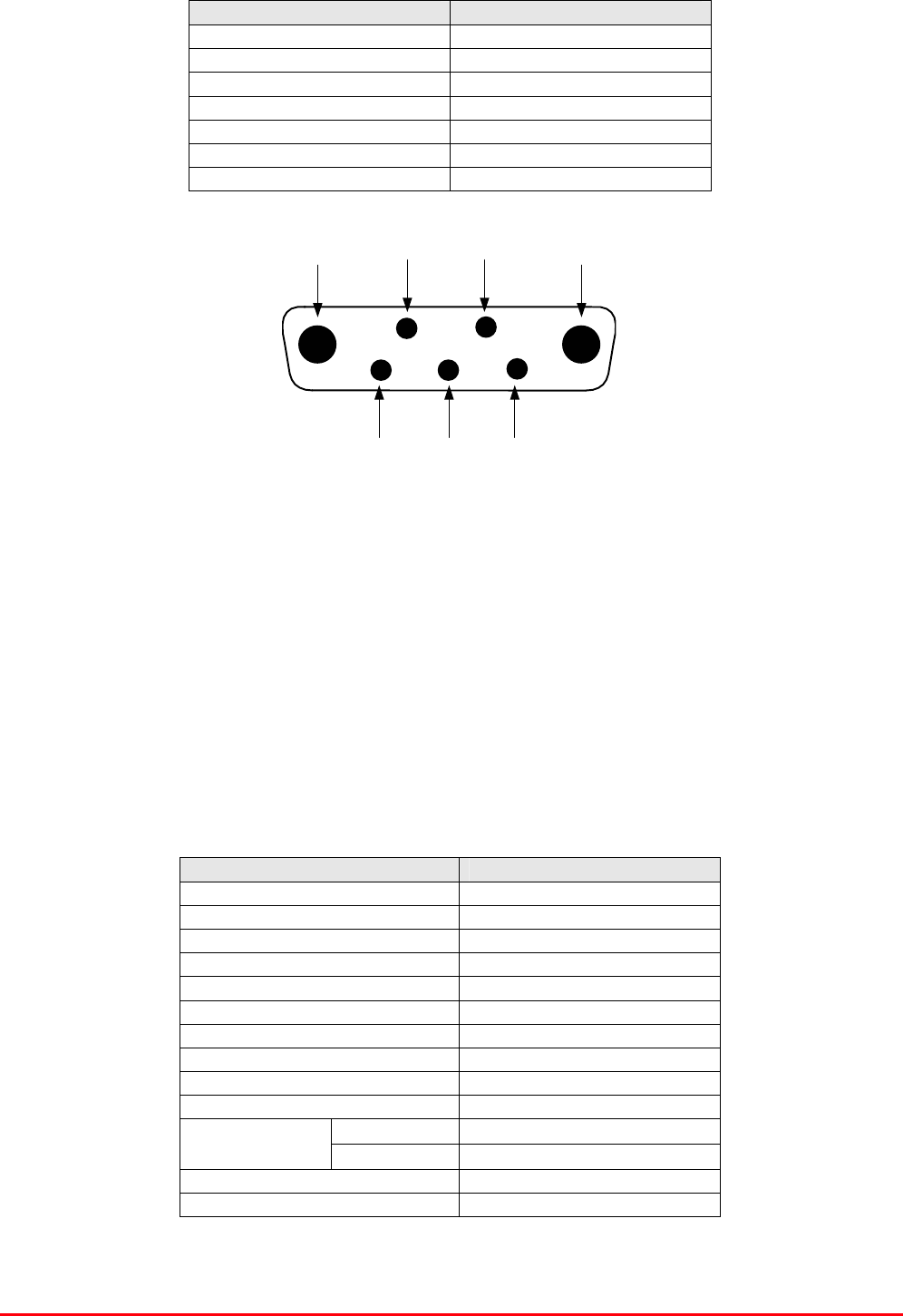
STTRS DOCUMENTATION
Document Number 80-330501HBKM – Issue A - Draft Page 232 of 500
Power Amplifier (12-018002) 7-Way Connector Pin-outs
Connector Pin Signal
A1 (large pin) +24V DC
A2 (large pin) GND
1 Alarm relay common
2 TTL alarm/0V good
3 Alarm relay contact (bad)
4 Alarm relay contact (good)
5 O/C good/0V bad (TTL)
12.4.2.8. Low Power Amplifier (12-021901)
The low power amplifier used is a triple stage solid-state low-noise amplifier. Class A circuitry is used
in the unit to ensure excellent linearity over a very wide dynamic range. The three active devices are
very moderately rated to provide a long trouble-free working life.
Its housing is an aluminium case (Iridite NCP finish) with SMA connectors for the RF input/output and
a D-Type connector for the power supply and the Current Fault Alarm Function.
There are no adjustments on this amplifier, and in the unlikely event of failure then the entire amplifier
should be replaced.
Low Power Amplifier (12-021901) Specification
PARAMETER SPECIFICATION
Frequency range 800-960MHz*
Bandwidth 20MHz *
Maximum RF output >1.0 Watt
Gain 15dB
1dB compression point +30.5dBm
3rd order intercept point +43dBm
Noise Figure <6dB
VSWR better than 1.5:1
Connectors SMA female
Supply 500mA @ 10-15V DC
operational -10°C to +60°C
Temperature
range storage -20°C to +70°C
Weight 0.5 kg
Size 167x52x25mm
* Tuned to Customer’s specification
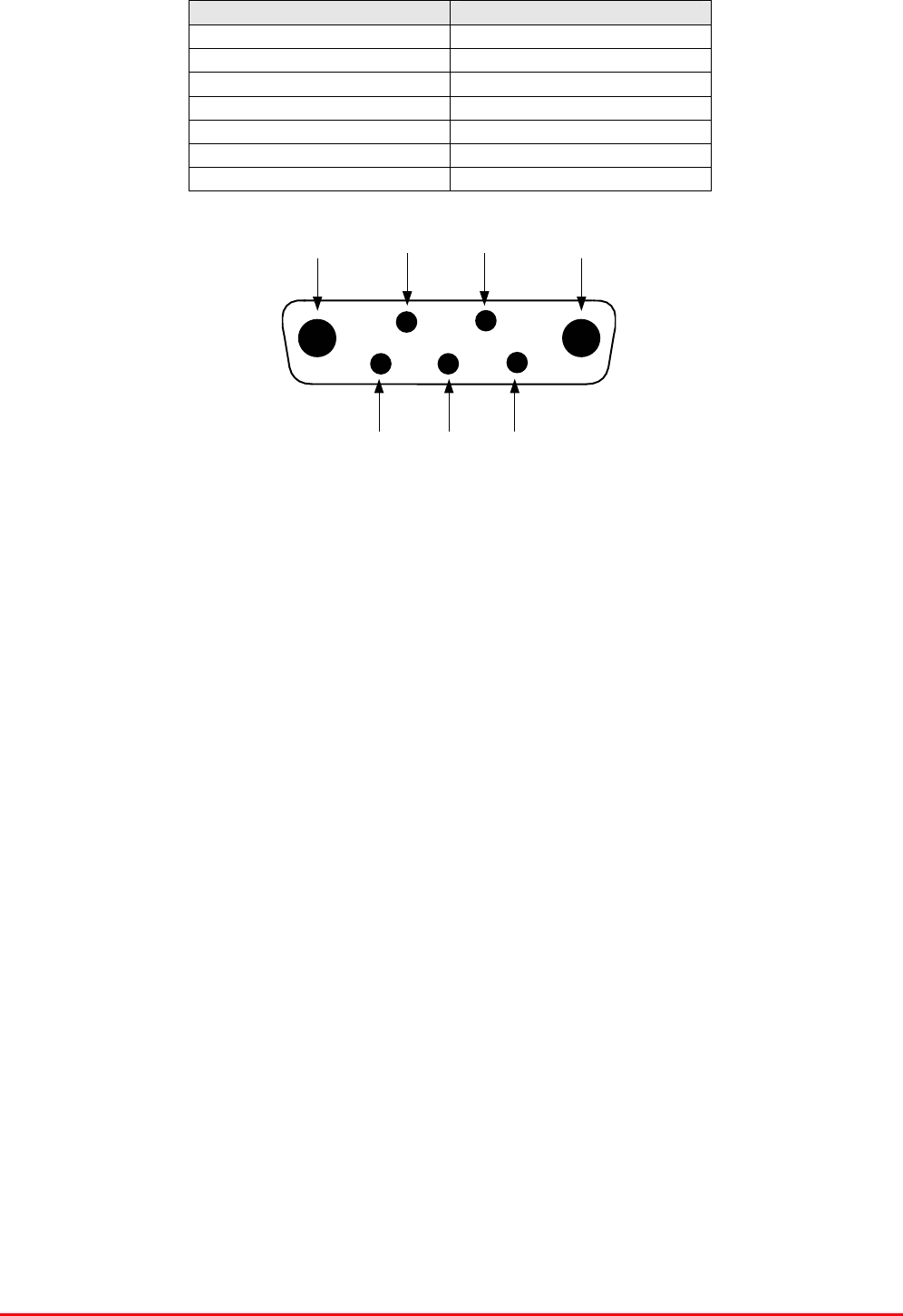
STTRS DOCUMENTATION
Document Number 80-330501HBKM – Issue A - Draft Page 233 of 500
Low Power Amplifier (12-021901) 7-Way Connector Pin-outs
Connector Pin Signal
A1 (large pin) +24V DC
A2 (large pin) GND
1 Alarm relay common
2 TTL alarm/0V good
3 Alarm relay contact (bad)
4 Alarm relay contact (good)
5 O/C good/0V bad (TTL)
12.4.2.9. Automatic Gain Control
17-001109 AGC Detector Assembly (Logarithmic)
17-001117 AGC Detector Assembly
17-001201 AGC Attenuator Assembly
The sub components 17-001109, 17-001117 & 17-001201 are parts of the Automatic Gain Control
(AGC) system used in 700MHz Line Amplifier (55-165704); 17-001117 and 17-001201 are paired for
use in the uplink and 17-001109 and 17-001201 are paired for use in the downlink
700MHz Line Amplifier (55-165704) is fitted with two differing types of Automatic Gain Control (AGC)
system, one linear, and one logarithmic. The AGC with logarithmic detector (17-001117) is fitted in the
uplink path and the AGC with linear detector (17-001109) is fitted in the downlink path
The AFL Automatic Gain Control system consists of two units, a detector/amplifier and an attenuator.
The detector/amplifier unit is inserted in the RF path on the output of the power amplifier, and the
attenuator is situated in the RF path between the 1st and 2nd stages of amplification.
17-001117 and 17-001201 are paired for use in the uplink and 17-001109 and 17-001201 are paired
for use in the downlink
The attenuator comprises a 50Ω P.I.N diode, voltage-variable attenuator with a range of 3 to 30dB.
The attenuation is controlled by a DC voltage which is derived from the associated detector controller
board.
Normally the attenuator is at minimum attenuation. The detector/amplifier unit monitors the RF level
being delivered by the power amplifier, and when a certain threshold is reached it begins to increase
the value of the attenuator to limit the RF output to the (factory set) threshold. Therefore overloading
of the power amplifier is avoided.
The factory set threshold is 1dB below the Enhancer 1dB compression point. Some adjustment of this
AGC threshold level is possible, a 10dB range is mostly achieved. It is not recommended under any
circumstances to adjust the AGC threshold to a level greater than the 1dB compression point as
system degradation will occur.
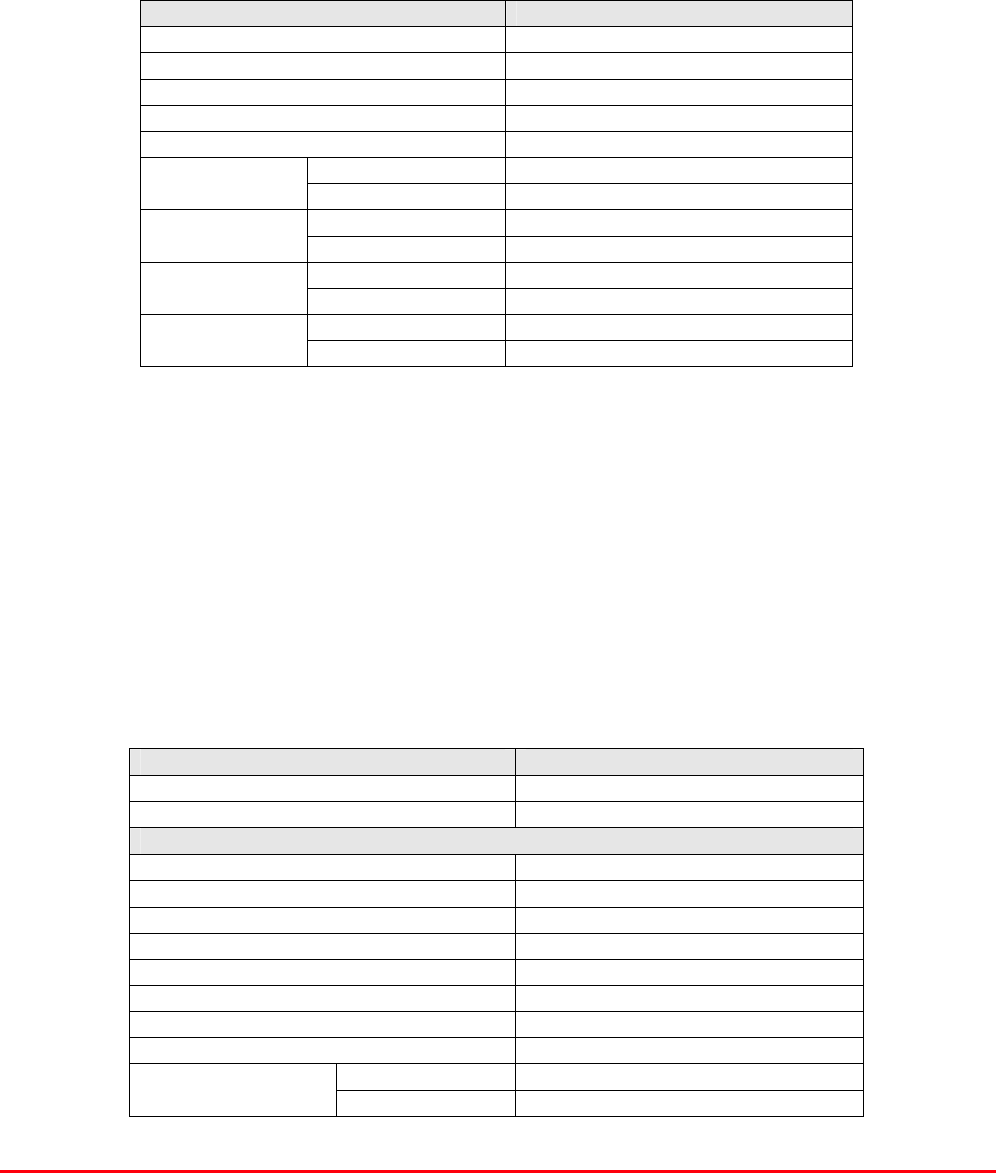
STTRS DOCUMENTATION
Document Number 80-330501HBKM – Issue A - Draft Page 234 of 500
The detector comprises of a 50Ω transmission line with a resistive tap which samples a small portion
of the mainline power. The sampled signal is amplified and fed to a conventional half wave diode
rectifier, the output of which is a DC voltage proportional to the RF input signal.
This DC voltage is passed via an inverting DC amplifier with integrating characteristics, to the output,
which drives the attenuation control line of the corresponding AGC attenuator. This unit is fitted at
some earlier point in the RF circuit.
For small signals, below AGC onset, the output control line will be close to 12V and the AGC
attenuator will have minimum attenuation. As the signal level increases the control line voltage will
fall, increasing the attenuator value and keeping the system output level at a constant value.
AGC Specification (both types)
PARAMETER SPECIFICATION
Frequency range up to 1000MHz
Attenuation range 3 to 30dB
Attenuation steps continuously variable
VSWR better than 1.2:1
RF Connectors SMA female
attenuator 1W Power
handling detector/amp >30W (or as required)
operation -10°C to +60°C Temperature
range storage -20°C to +70°C
attenuator pcb 50 x 42 x 21mm
Size detector/amp pcb 54 x 42 x 21mm
attenuator 90grams
Weight detector/amp 100grams
12.4.2.10. 12V (Single) Relay Board (80-008901)
The General Purpose Relay Board allows the inversion of signals and the isolation of circuits. It is
equipped with a single dual pole change-over relay RL1, with completely isolated wiring, accessed
via a 15 way in-line connector.
The relay is provided with polarity protection diodes and diodes for suppressing the transients caused
by "flywheel effect" which can destroy switching transistors or induce spikes on neighbouring circuits.
It’s common use is to amalgamate all the alarm signals into one, volts-free relay contact pair for the
main alarm system.
80-008901 Specification
PARAMETER SPECIFICATION
Operating voltage 8 to 30V (floating earth)
Alarm threshold Vcc - 1.20 volt +15%
Alarm output relay contacts:
Max. switch current 1.0Amp
Max. switch volts 120Vdc/60VA
Max. switch power 24W/60VA
Min. switch load 10.0µA/10.0mV
Relay isolation 1.5kV
Mechanical life >2x107 operations
Relay approval BT type 56
Connector details Screw terminals
operational -10°C to +60°C Temperature
range storage -20°C to +70°C
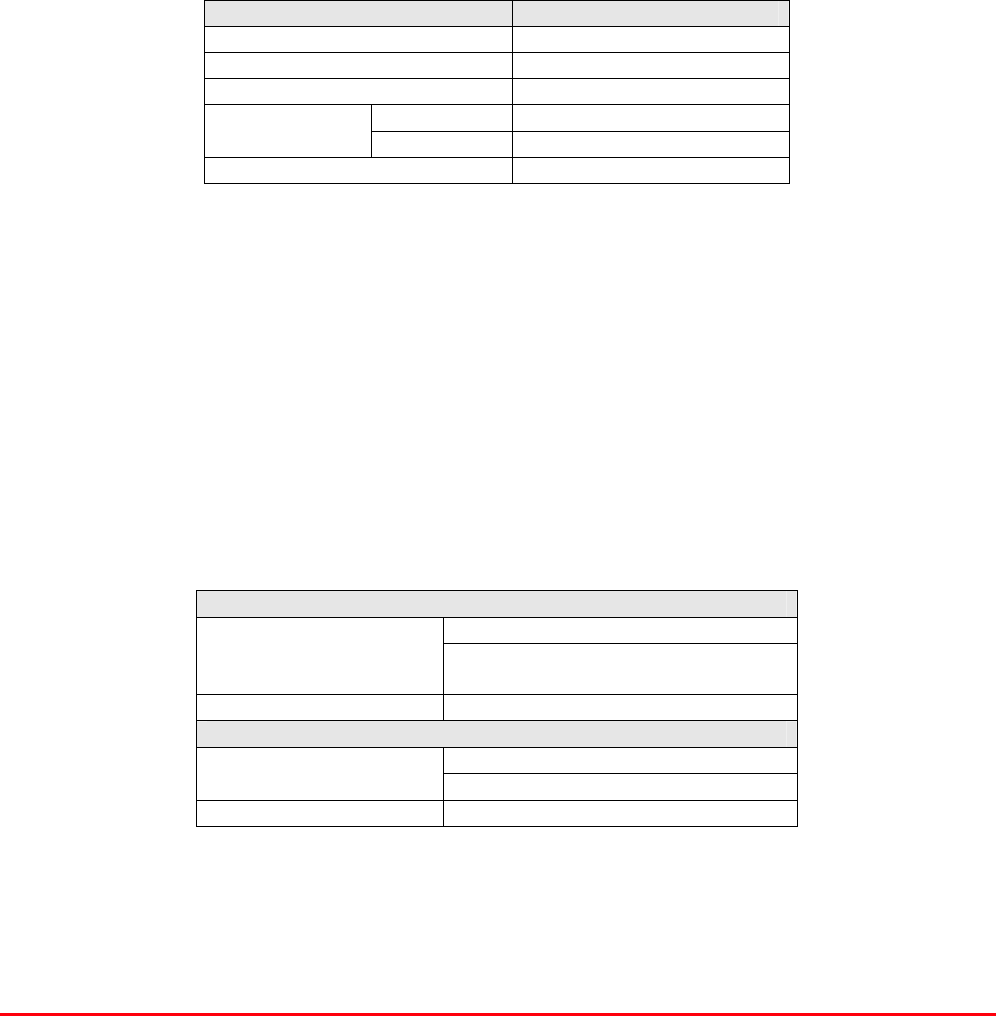
STTRS DOCUMENTATION
Document Number 80-330501HBKM – Issue A - Draft Page 235 of 500
12.4.2.11. Dual Diode Assembly (94-100004)
The purpose of these dual diode assemblies is to allow two DC voltage sources to be combined, so
that the main DC rail within the equipment can be sourced from either a mains driven PSU, or
externally through an XLR connector or from dual mains driven PSUs . They are very heavy-duty
diodes and they prevent any reverse current from flowing back to their source or the alternative
supply rail. Combining diodes such as these will also be used if the equipment is to be powered from
external back-up batteries.
12.4.2.12. DC/DC Converter 96-200047
96-200047 is an O.E.M. high power device with a wide input range and 12.5 amp @ 12V (150Watts)
output capability used to derive a 12V fixed voltage power supply rail from a higher voltage supply, in
this case 12V. In the event of failure this unit should not be repaired, only replaced.
96-200047 Specification
PARAMETER SPECIFICATION
DC Input Voltage range 19 to 36V
DC Output voltage 12V ± 1%
Max. current load 12.5Amps
Operation -10°C to +60°C Temperature
range Storage -20°C to +85°C
Working Humidity 20 to 90% RHNC
12.4.2.13. 12V Switch-Mode PSU (96-300052)
No routine maintenance of the PSU is required. If a fault is suspected, then the output voltage from
the power supply may be measured on its output terminals. This is typically set to 12.2V. The
adjustment potentiometer will be found close to the DC output terminals.
All the PSUs used in AFL Cell Enhancers are capable of operation from either 110 or 220V nominal
AC supplies. The line voltage is sensed automatically, so no adjustment or link setting is needed by
the operator.
96-300052 Specification
AC Input Supply 110 or 220V nominal
Voltage 85 - 265V AC
(absolute limits)
Frequency 47 to 63Hz
DC Output Supply 12V DC (nominal)
Voltage 10.5-13.8V (absolute limits)
Current 12.5A

STTRS DOCUMENTATION
Document Number 80-330501HBKM – Issue A - Draft Page 236 of 500
12.4.3. Westlake Station. Splitter (55-165707)
2U rack mount chassis
Westlake Station. Splitter (55-165707) list of major components
Section Component
Part Component Part Description Qty. Per
Assembly
12.4.3.3. 07-015102 Wideband Asymmetric Coupler 5
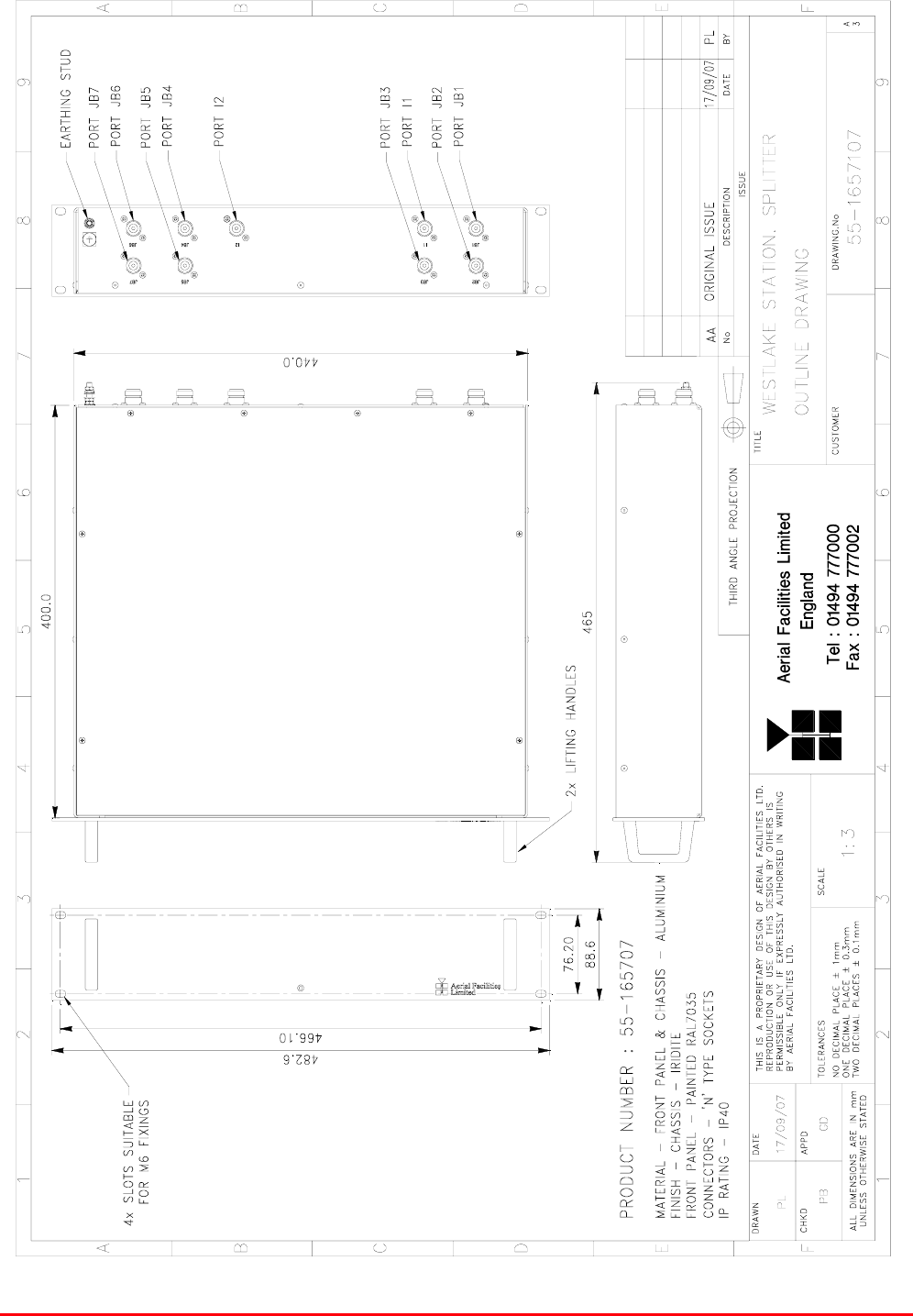
STTRS DOCUMENTATION
Document Number 80-330501HBKM – Issue A - Draft Page 237 of 500
12.4.3.1. Westlake Station. Splitter (55-165707) outline drawing
Drawing number 55-1657107
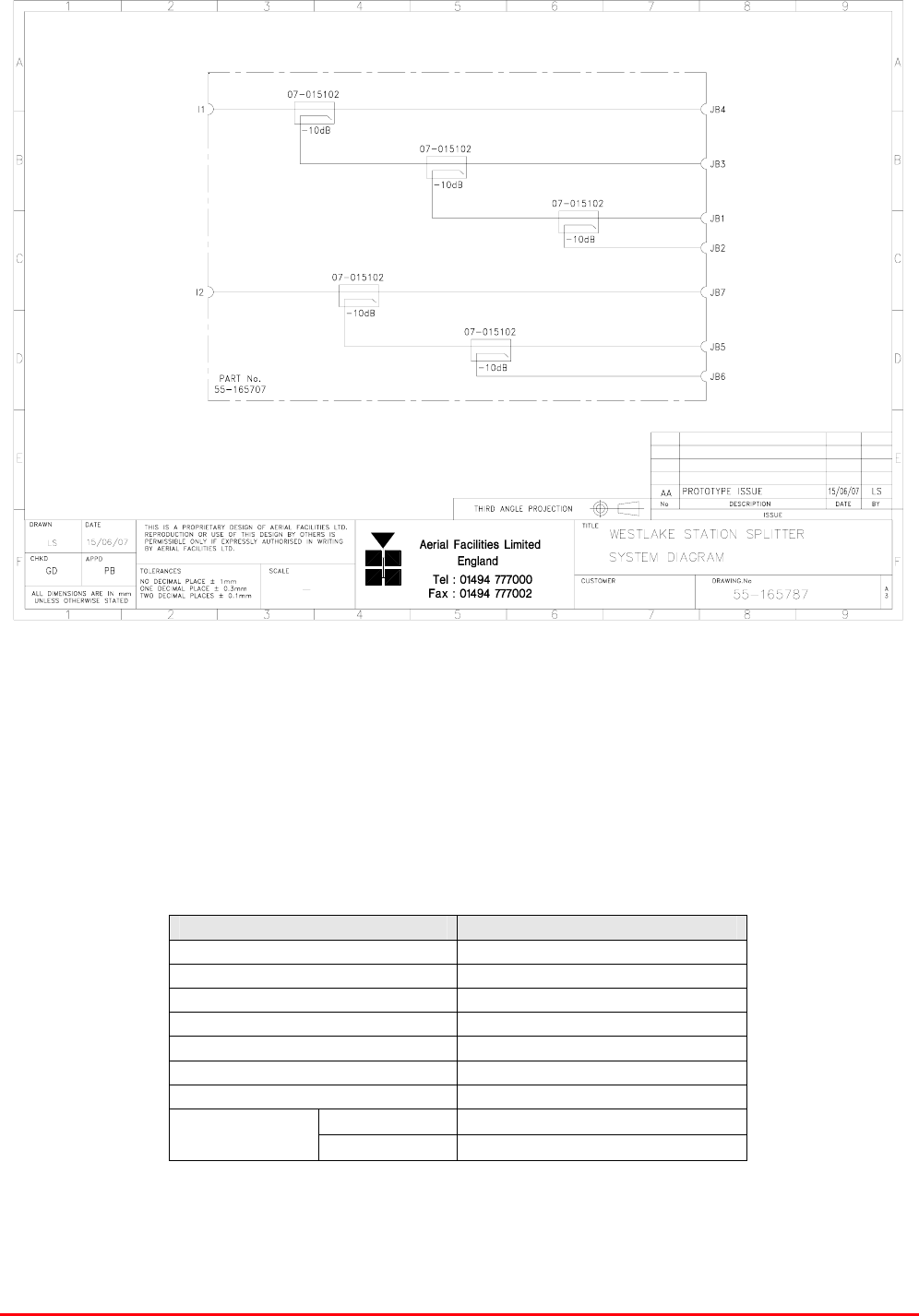
STTRS DOCUMENTATION
Document Number 80-330501HBKM – Issue A - Draft Page 238 of 500
12.4.3.2. Westlake Station. Splitter (55-165707) system diagram
Drawing number 55-165787
12.4.3.3. Wideband Asymmetric Coupler (07-015102)
The purpose of Wideband Asymmetric Coupler (07-015102) is to tap off a known portion (in this case
10dB) of RF signal from transmission lines and to combine them, for example through splitter units for
different purposes (alarms/monitoring etc.), whilst maintaining an accurate 50Ω load to all
ports/interfaces throughout the specified frequency range. They are known formally as directional
couplers as they couple power from the RF mainline in one direction only.
07-015102 Specification
PARAMETER SPECIFICATION
Frequency Range 800 - 2500 MHz
Coupling Value 10 dB ± 1.0 dB
Main Line Insertion Loss <1.6 dB
VSWR 1.4:1
Directivity >18 dB
Power Rating 200 Watts
RF Connectors ‘N’ female
operation -20°C to +60°C
Temperature
range storage -40°C to +70°C

STTRS DOCUMENTATION
Document Number 80-330501HBKM – Issue A - Draft Page 239 of 500
13 ATTENUATOR SHELF (ITAC) 1 (55-165506)
Attenuator Shelf (ITAC) 1 (55-165506) list of major components
Section Component
Part Component Part Description Qty. Per
Assembly
13.3.1. 05-002602 900MHz Splitter/Combiner 1
13.3.2. 05-003007 4 Port Hybrid Coupler 1
13.3.3. 09-000902 Dummy load 1
13.3.4. 10-000901 Switched Attenuator 0.25W, 0 - 15dB 1
13.3.5. 10-002960 25W 2.5GHz 60dB ATTENUATOR N M/F 1
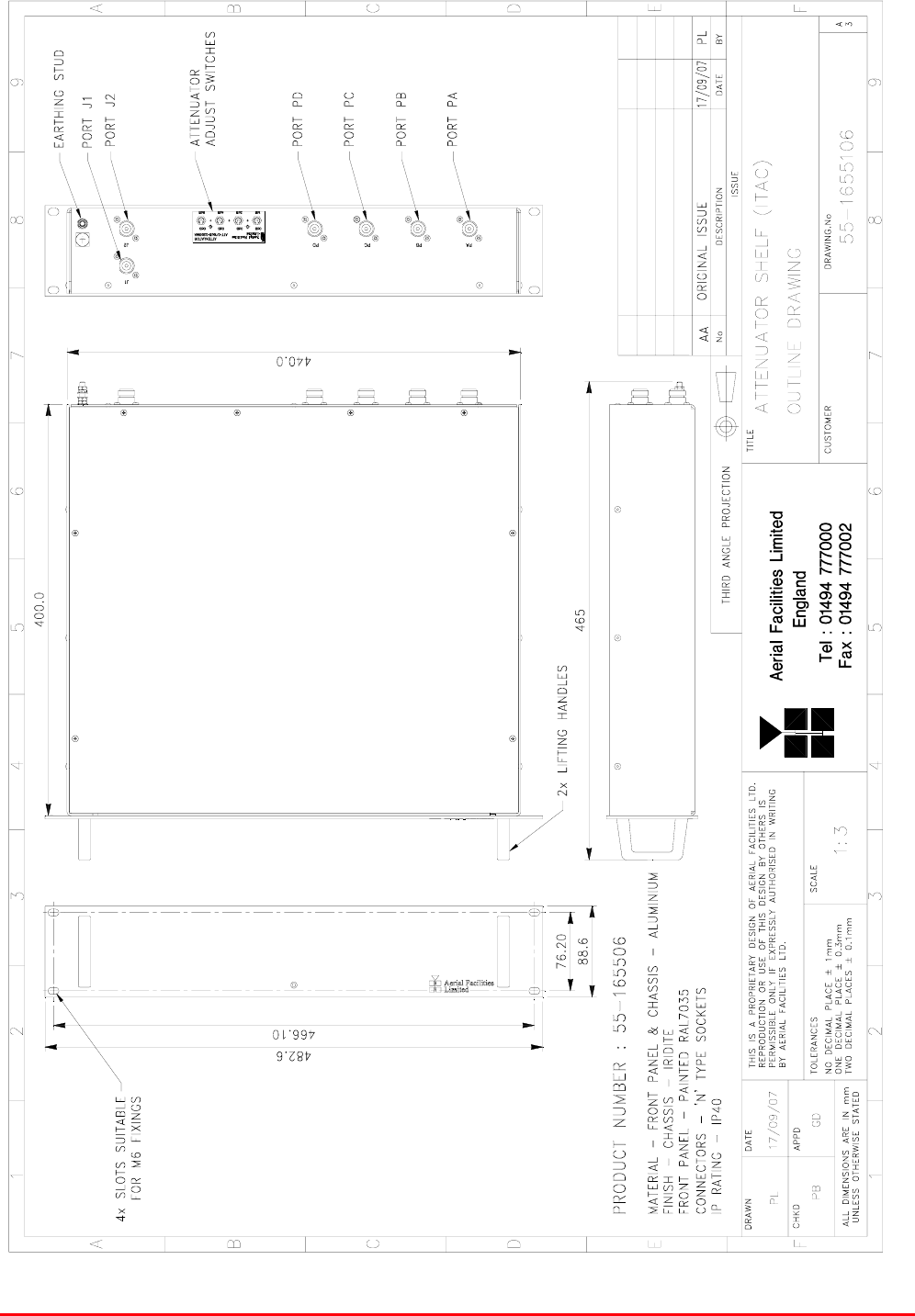
STTRS DOCUMENTATION
Document Number 80-330501HBKM – Issue A - Draft Page 240 of 500
13.1. Attenuator Shelf (ITAC) 1 (55-165506) outline drawing
Drawing number 55-1655106
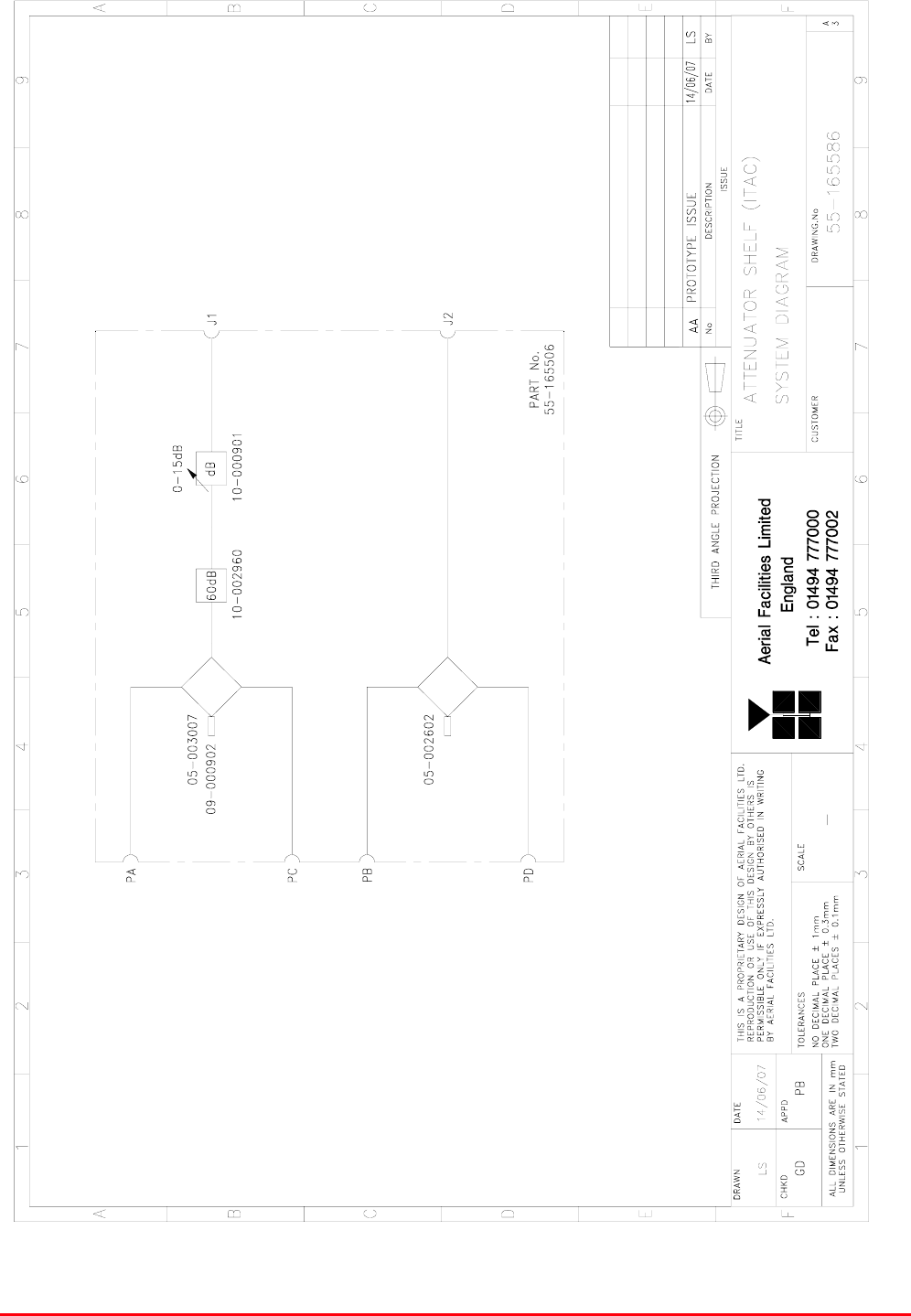
STTRS DOCUMENTATION
Document Number 80-330501HBKM – Issue A - Draft Page 241 of 500
13.2 Attenuator Shelf (ITAC) 1 (55-165506) system diagram
Drawing number 55-165586
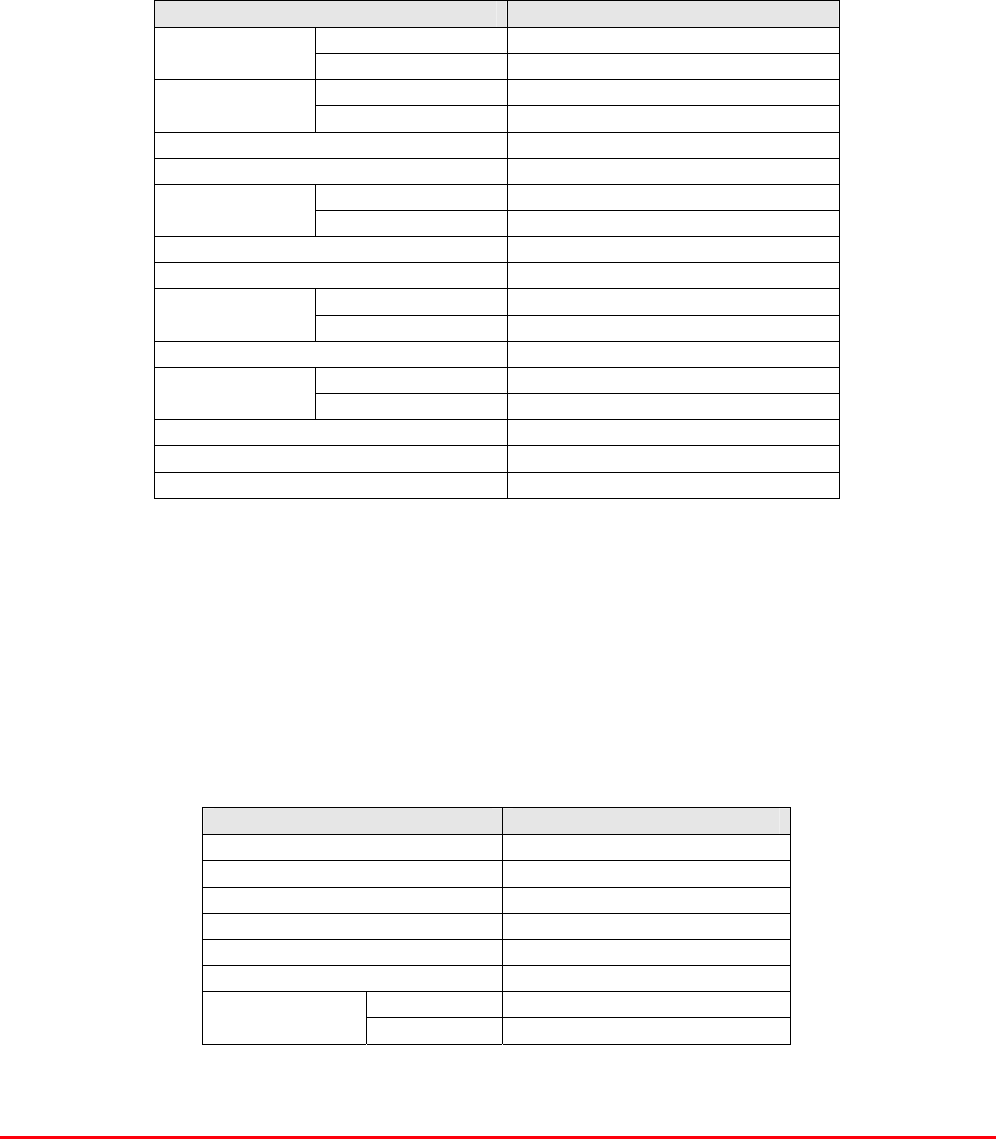
STTRS DOCUMENTATION
Document Number 80-330501HBKM – Issue A - Draft Page 242 of 500
13.3. Attenuator Shelf (ITAC) 1 (55-165506) major components
13.3.1. 900MHz Splitter/Combiner (05-002602)
The Splitter/Combiner used is a device for accurately matching two or more RF signals to single or
multiple ports, whilst maintaining an accurate 50Ω load to all inputs/outputs and ensuring that the
VSWR and insertion losses are kept to a minimum. Any unused ports should be terminated with an
appropriate 50Ω load.
Being passive devices, the splitters should have an extremely long operational life and require no
maintenance. Should a unit be suspect, it is usually most time efficient to replace the whole module
rather than attempt repair or re-tuning.
05-002602 Specification
PARAMETER SPECIFICATION
Narrowband 815 – 960MHz Frequency
range Broadband 800 – 1200MHz
Narrowband 145MHz
Bandwidth Broadband 400MHz
Input ports 1
Output ports 2
Narrowband 3.3dB
Insertion loss Broadband 3.5dB
Return loss input & output 1.3:1
Impedance 50Ω
Narrowband >20dB
Isolation Broadband >18dB
MTFB >180,000 hours
Splitting 20Watts
Power rating Combining 0.5Watt
Connectors SMA female
Weight 200g (approximately)
Size 54 x 44 x 21mm
13.3.2. 4 Port Hybrid Coupler (05-003007)
This transmitter hybrid coupler is a device for accurately matching two or more RF signals to single or
multiple ports, whilst maintaining an accurate 50Ω load to all inputs/outputs and ensuring that the
insertion losses are kept to a minimum. Any unused ports should be terminated with an appropriate
50Ω load. In this specific instance one port of 4 Port Hybrid Coupler (05-003007) is terminated with
Dummy load 09-000902 (see below).
05-003007 Specification
PARAMETER SPECIFICATION
Frequency range 700-900MHz
Bandwidth 200MHz
Rejection >14dB
Insertion loss 6.5dB (in band, typical)
Connectors SMA
Weight <1.0kg
operational -10%C to +60%C Temperature
range storage -20%C to +70%C
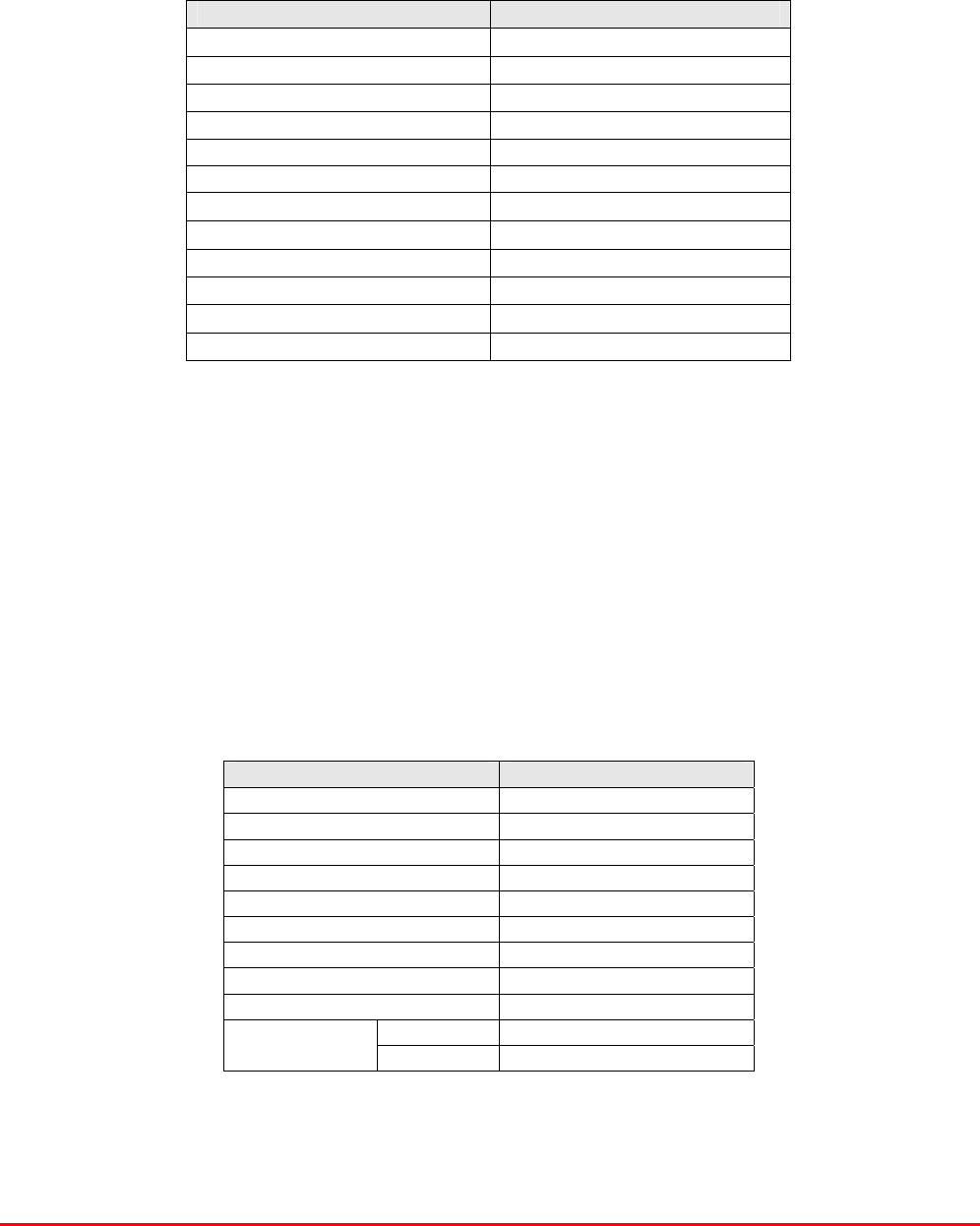
STTRS DOCUMENTATION
Document Number 80-330501HBKM – Issue A - Draft Page 243 of 500
13.3.3. Dummy load (09-000902)
When a combiner system is used to split or combine RF signals, in many cases it is most cost
effective to use a standard stock item 4, 6 or 8 port device where, in fact, only a 3 or 6 port device is
needed. In this case 4 Port Hybrid Coupler (05-003007) has one of its ports terminated with Dummy
load (09-000902) in order to preserve the correct impedance of the device over the specified
frequency range.
09-000902 specification
PARAMETER SPECIFICATION
Frequency Range 0 - 2500 MHz
Power Rating 25 Watts continuous
VSWR Better than 1.1:1
Impedance 50 Ohms
Temperature Range -20 to +60°C
RF Connectors N Type female
Dimension 110.3mm x 38.1mm x
Weight 485 grams
Finish Black Anodised
RF Connector N Type male
Environmental IP66
MTBF >180,000 hours
13.3.4. Switched Attenuator 0.25W, 0 - 15dB (10-000901)
In many practical applications for Cell Enhancers etc., the gain in each path is found to be excessive.
Therefore, provision is made within the unit for the setting of attenuation in each path, to reduce the
gain.
10-000901 provides attenuation from 0 - 15dB in 2 dB steps The attenuation is simply set using the
four miniature toggle switches on the top of each unit. Each switch is clearly marked with the
attenuation it provides, and the total attenuation in line is the sum of the values switched in. They are
designed to maintain an accurate 50Ω impedance over their operating frequency at both input and
output.
10-000901 Specification
PARAMETER SPECIFICATION
Attenuation Values 0-15dB
Attenuation Steps 1, 2, 4 and 8dB
Power Handling 0.25 Watt
Attenuation Accuracy ± 1.0 dB
Frequency Range DC to 1GHz
Impedance 50Ω
Connectors SMA
VSWR 1.3:1
Weight 0.2kg
operation -20°C to +60°C Temperature
range storage -40°C to +70°C
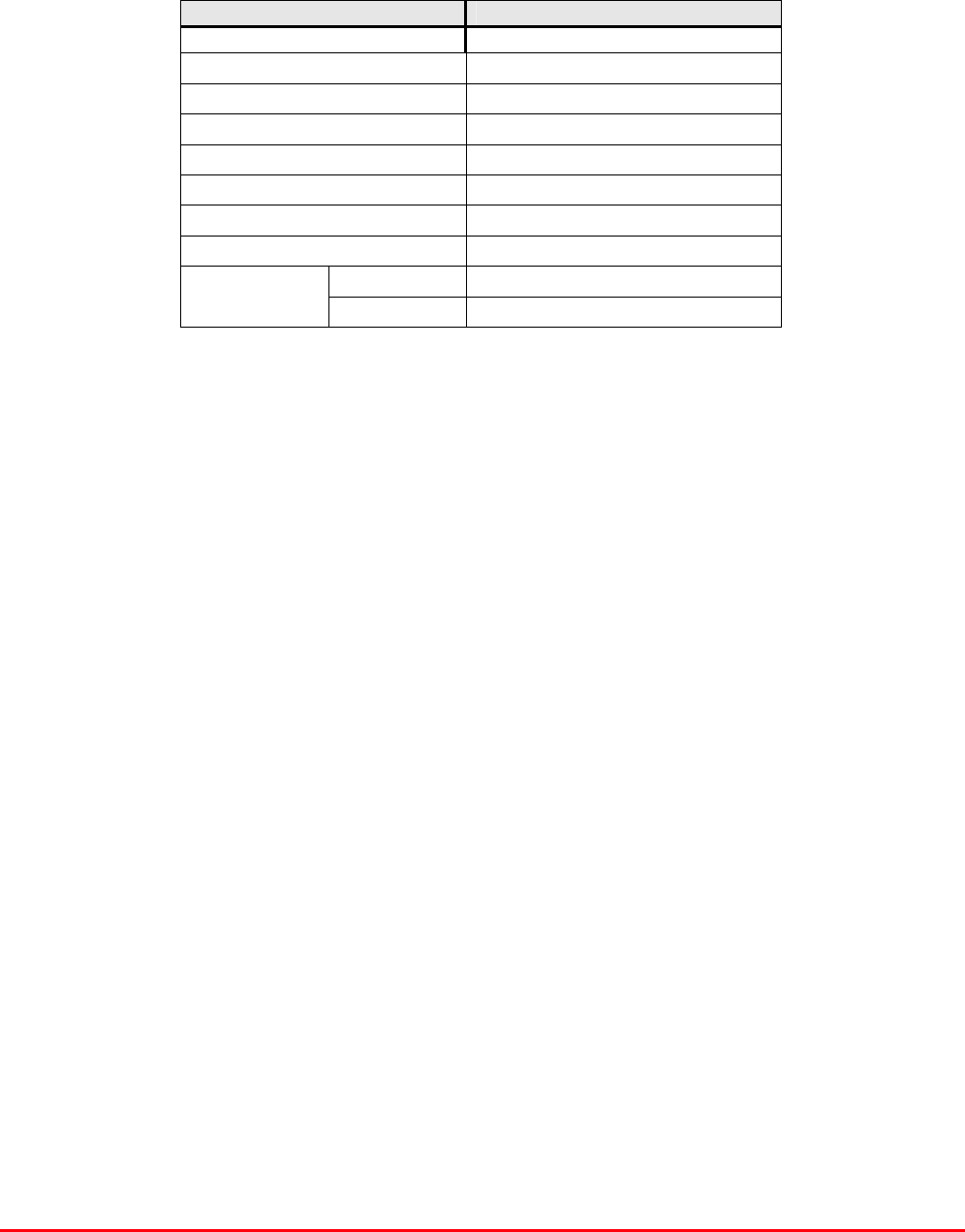
STTRS DOCUMENTATION
Document Number 80-330501HBKM – Issue A - Draft Page 244 of 500
13.3.5. Attenuator 25W, 60dB (10-002960)
In many practical applications for Cell Enhancers etc., the gain in each path is found to be excessive.
Therefore, provision is made within the unit for the setting of attenuation in each path, to reduce the
gain. Attenuator 25W, 60dB (10-002960) is a fixed attenuator providing 60dB of signal attenuation.
10-002960 Specification
PARAMETER SPECIFICATION
Frequency Range DC to 2.5GHz
Power Handling 25 W
Attenuation 60 dB
Attenuation Accuracy ± 0.5dB
Return Loss to 2.2GHz 18dB
Nominal Impedance 50 Ω
RF Conectors N male to N female
Finish Matt Black Anodise
operational -20%C to +55%C
Temperature
range storage -20%C to +70%C

STTRS DOCUMENTATION
Document Number 80-330501HBKM – Issue A - Draft Page 245 of 500
14 ATTENUATOR SHELF (ITAC) 2 (55-165506)
Attenuator Shelf (ITAC) 2 (55-165506) list of major components
Section Component
Part Component Part Description Qty. Per
Assembly
13.3.1. 05-002602 900MHz Splitter/Combiner 1
13.3.2. 05-003007 4 Port Hybrid Coupler 1
13.3.3. 09-000902 Dummy load 1
13.3.4. 10-000901 Switched Attenuator 0.25W, 0 - 15dB 1
13.3.5. 10-002960 Attenuator 25W, 60dB 1
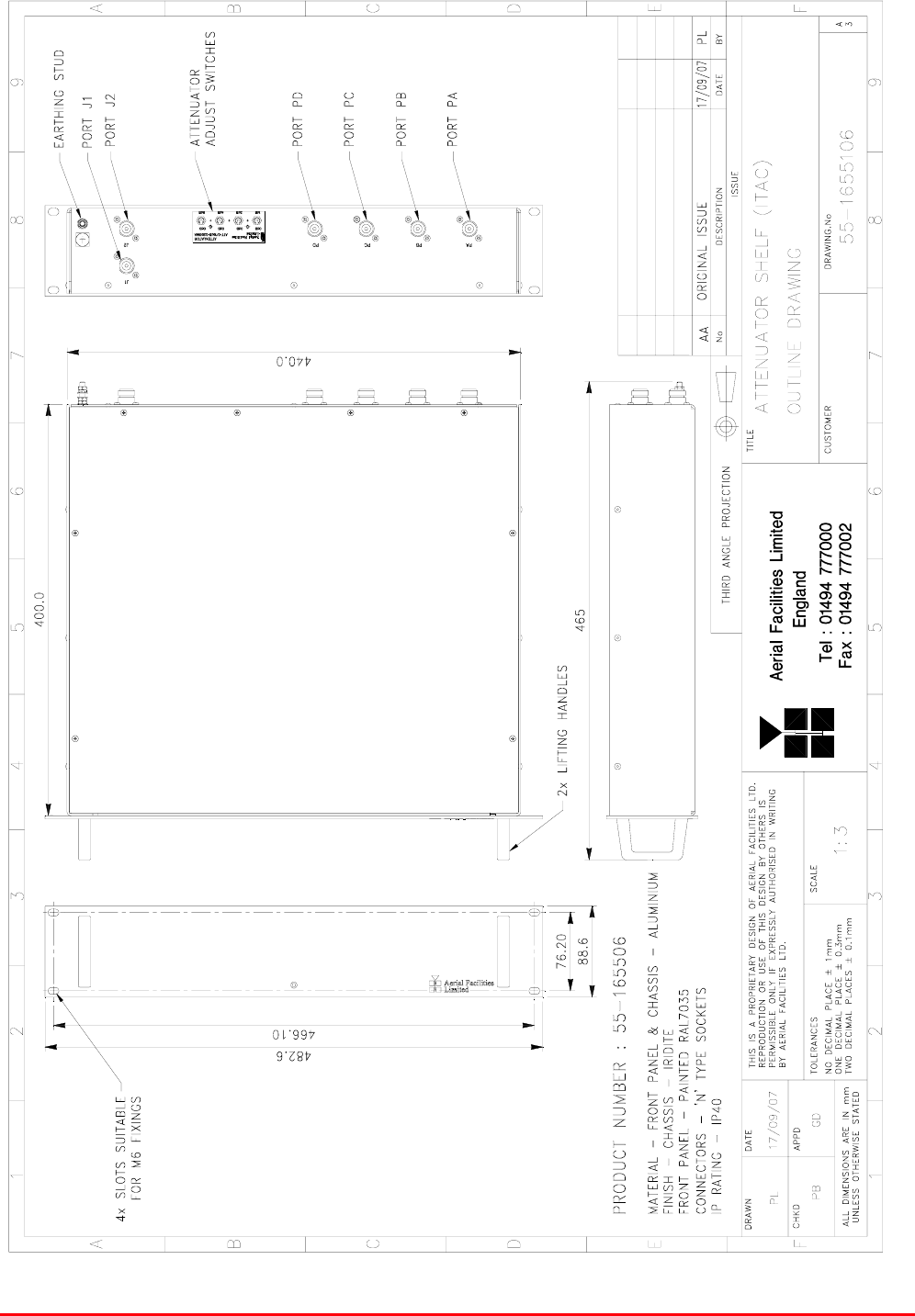
STTRS DOCUMENTATION
Document Number 80-330501HBKM – Issue A - Draft Page 246 of 500
14.1. Attenuator Shelf (ITAC) 2 (55-165506) outline drawing
Drawing number 55-1655106
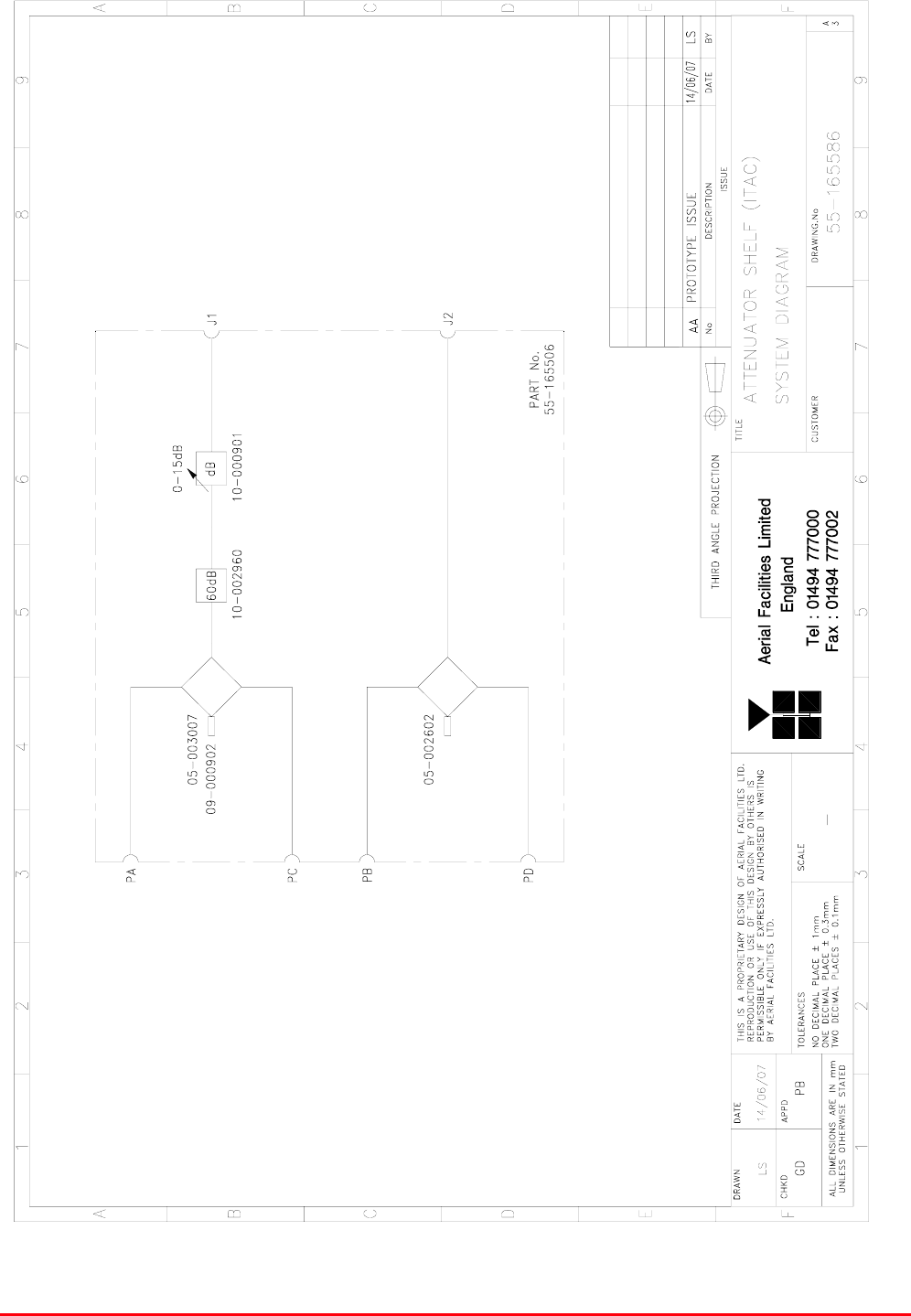
STTRS DOCUMENTATION
Document Number 80-330501HBKM – Issue A - Draft Page 247 of 500
14.2 Attenuator Shelf (ITAC) 2 (55-165506) system diagram
Drawing number 55-165586
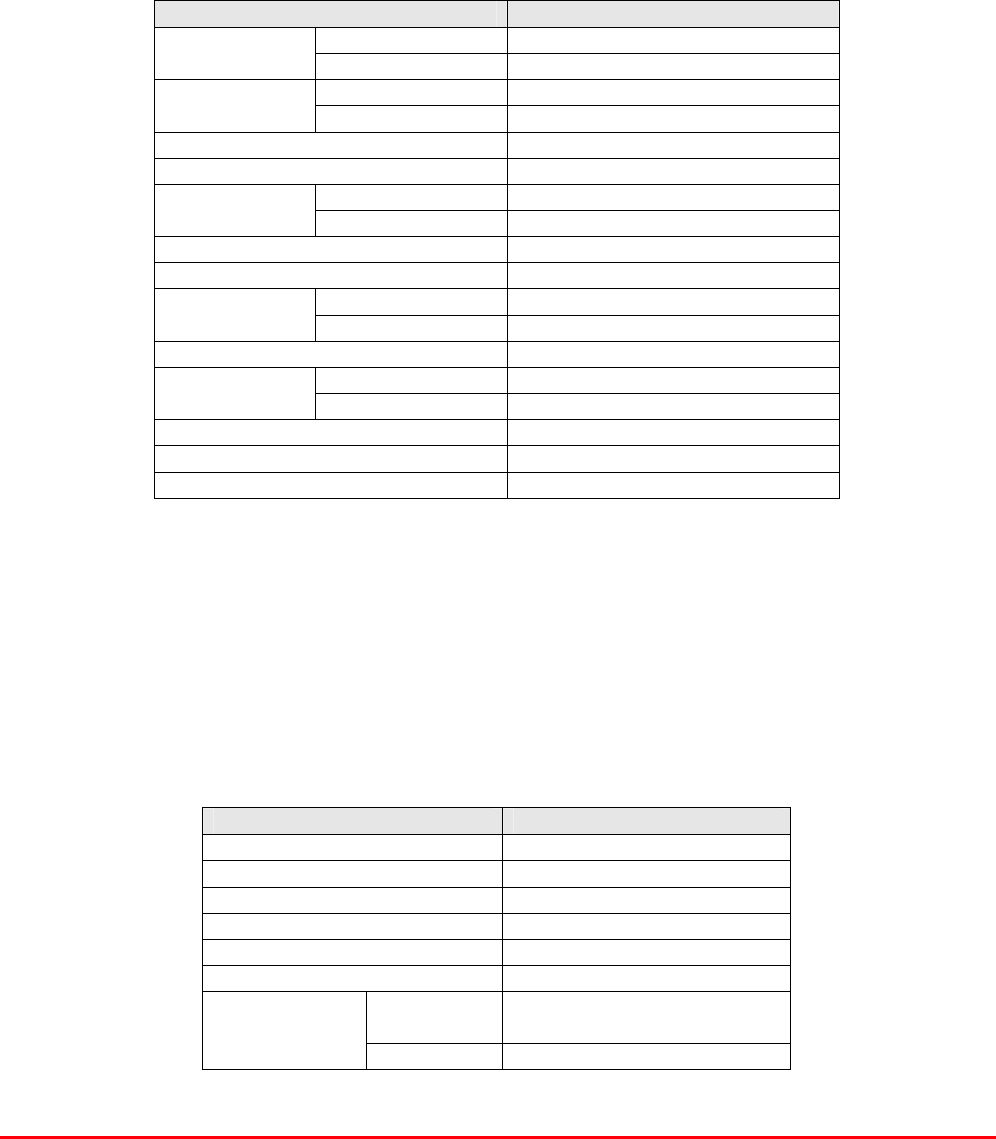
STTRS DOCUMENTATION
Document Number 80-330501HBKM – Issue A - Draft Page 248 of 500
14.3. Attenuator Shelf (ITAC) 2 (55-165506) major components
14.3.1. 900MHz Splitter/Combiner (05-002602)
The Splitter/Combiner used is a device for accurately matching two or more RF signals to single or
multiple ports, whilst maintaining an accurate 50Ω load to all inputs/outputs and ensuring that the
VSWR and insertion losses are kept to a minimum. Any unused ports should be terminated with an
appropriate 50Ω load.
Being passive devices, the splitters should have an extremely long operational life and require no
maintenance. Should a unit be suspect, it is usually most time efficient to replace the whole module
rather than attempt repair or re-tuning.
05-002602 Specification
PARAMETER SPECIFICATION
Narrowband 815 – 960MHz Frequency
range Broadband 800 – 1200MHz
Narrowband 145MHz
Bandwidth Broadband 400MHz
Input ports 1
Output ports 2
Narrowband 3.3dB
Insertion loss Broadband 3.5dB
Return loss input & output 1.3:1
Impedance 50Ω
Narrowband >20dB
Isolation Broadband >18dB
MTFB >180,000 hours
Splitting 20Watts
Power rating Combining 0.5Watt
Connectors SMA female
Weight 200g (approximately)
Size 54 x 44 x 21mm
14.3.2. 4 Port Hybrid Coupler (05-003007)
This transmitter hybrid coupler is a device for accurately matching two or more RF signals to single or
multiple ports, whilst maintaining an accurate 50Ω load to all inputs/outputs and ensuring that the
insertion losses are kept to a minimum. Any unused ports should be terminated with an appropriate
50Ω load. In this specific instance one port of 4 Port Hybrid Coupler (05-003007) is terminated with
Dummy load 09-000902 (see below).
05-003007 Specification
PARAMETER SPECIFICATION
Frequency range: 700-900MHz
Bandwidth: 200MHz
Rejection: >14dB
Insertion loss: 6.5dB (in band, typical)
Connectors: SMA
Weight: <1.0kg
operational
:-10%C to +60%C
Temperature
range: storage -20%C to +70%C
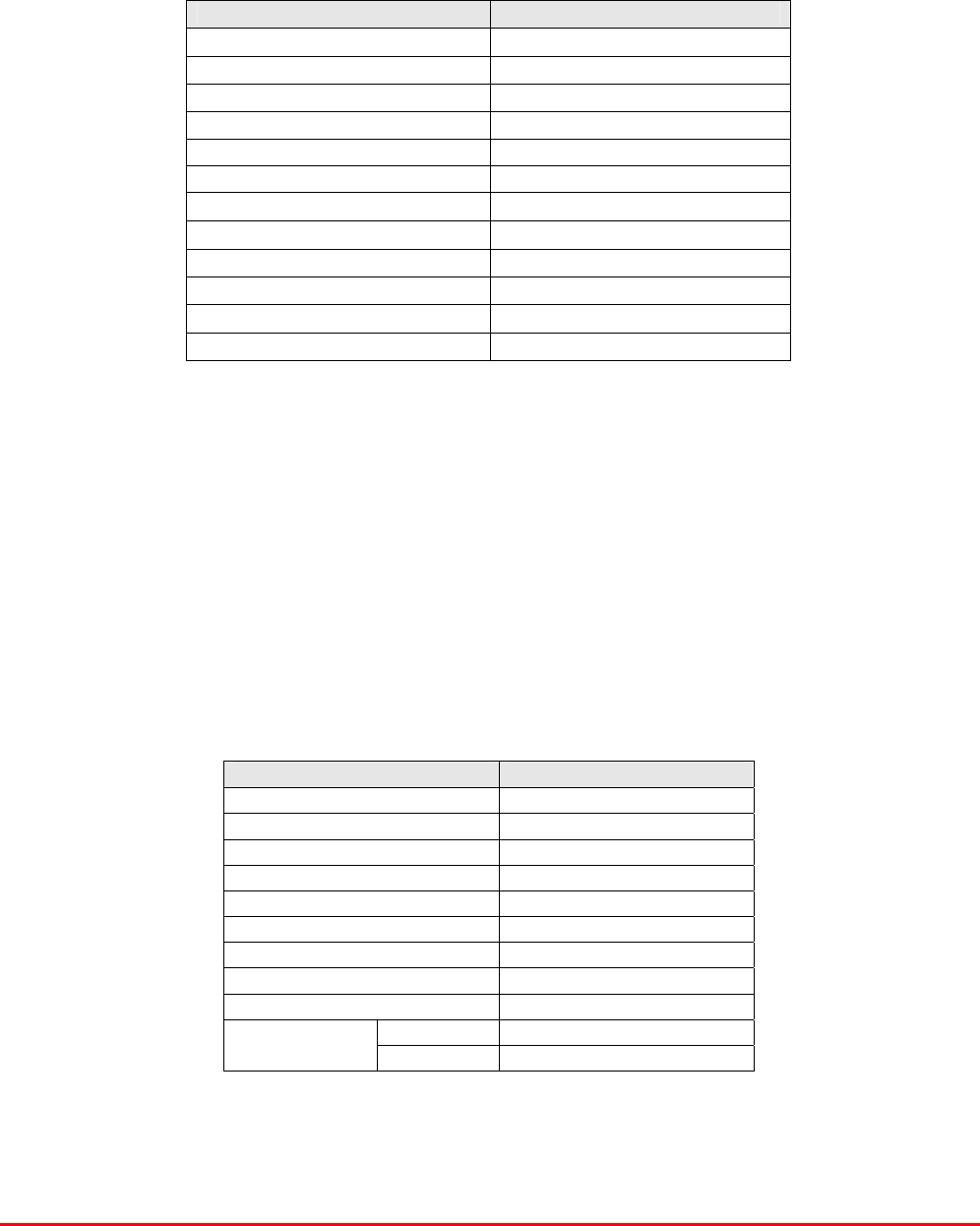
STTRS DOCUMENTATION
Document Number 80-330501HBKM – Issue A - Draft Page 249 of 500
14.3.3. Dummy load 09-000902
When a combiner system is used to split or combine RF signals, in many cases it is most cost
effective to use a standard stock item 4, 6 or 8 port device where, in fact, only a 3 or 6 port device is
needed. In this case 4 Port Hybrid Coupler (05-003007) has one of its ports terminated with Dummy
load (09-000902) in order to preserve the correct impedance of the device over the specified
frequency range.
09-000902 specification
PARAMETER SPECIFICATION
Frequency Range 0 - 2500 MHz
Power Rating 25 Watts continuous
VSWR Better than 1.1:1
Impedance 50 Ohms
Temperature Range -20 to +60°C
RF Connectors N Type female
Dimension 110.3mm x 38.1mm x
Weight 485 grams
Finish Black Anodised
RF Connector N Type male
Environmental IP66
MTBF >180,000 hours
14.3.4. Switched Attenuator 0.25W, 0 - 15dB (10-000901)
In many practical applications for Cell Enhancers etc., the gain in each path is found to be excessive.
Therefore, provision is made within the unit for the setting of attenuation in each path, to reduce the
gain.
10-000901 provides attenuation from 0 - 15dB in 2 dB steps The attenuation is simply set using the
four miniature toggle switches on the top of each unit. Each switch is clearly marked with the
attenuation it provides, and the total attenuation in line is the sum of the values switched in. They are
designed to maintain an accurate 50Ω impedance over their operating frequency at both input and
output.
10-000901 Specification
PARAMETER SPECIFICATION
Attenuation Values 0-15dB
Attenuation Steps 1, 2, 4 and 8dB
Power Handling 0.25 Watt
Attenuation Accuracy ± 1.0 dB
Frequency Range DC to 1GHz
Impedance 50Ω
Connectors SMA
VSWR 1.3:1
Weight 0.2kg
operation -20°C to +60°C Temperature
range storage -40°C to +70°C
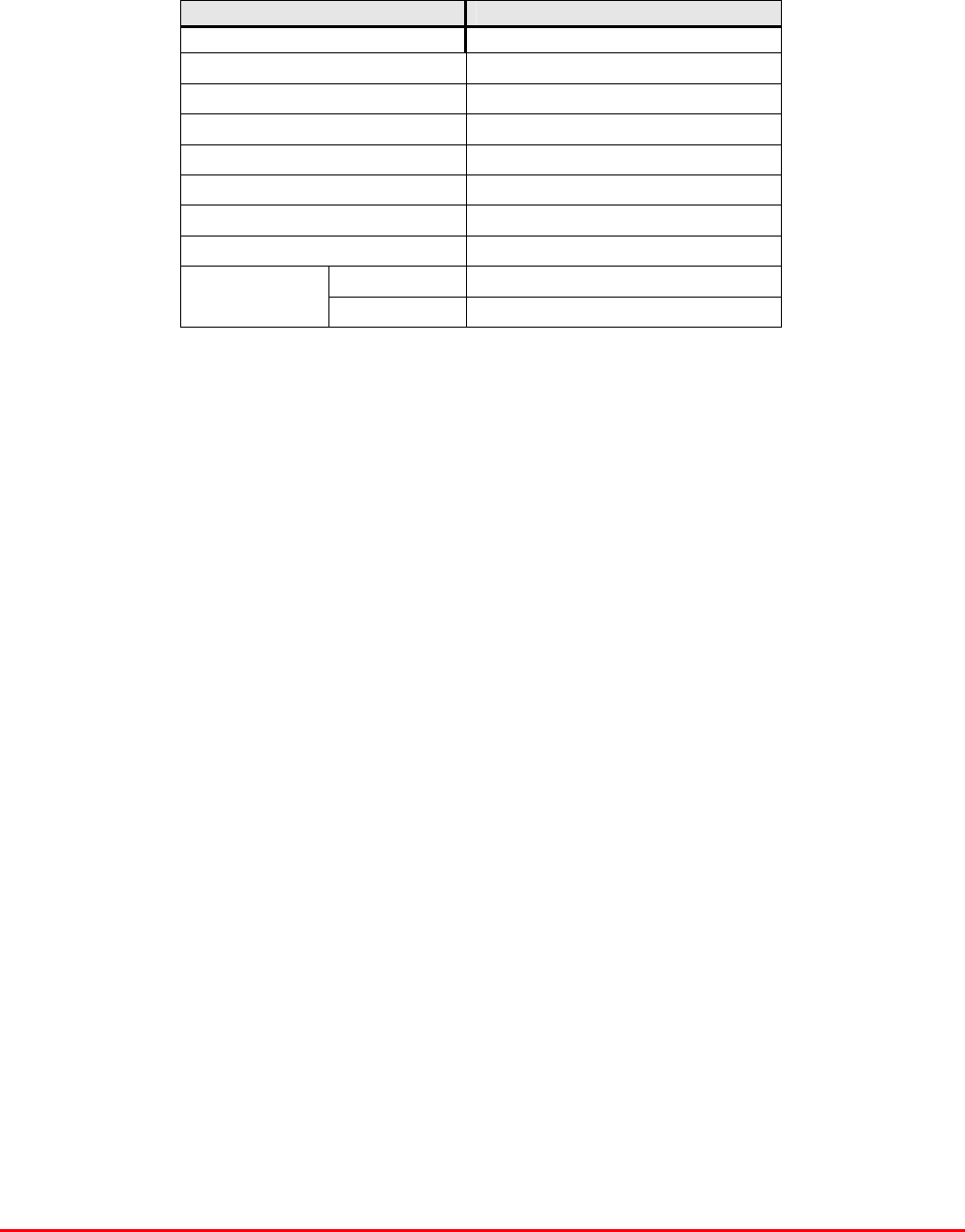
STTRS DOCUMENTATION
Document Number 80-330501HBKM – Issue A - Draft Page 250 of 500
14.3.5. Attenuator 25W, 60dB (10-002960)
In many practical applications for Cell Enhancers etc., the gain in each path is found to be excessive.
Therefore, provision is made within the unit for the setting of attenuation in each path, to reduce the
gain. Attenuator 25W, 60dB (10-002960) is a fixed attenuator providing 60dB of signal attenuation.
10-002960 Specification
PARAMETER SPECIFICATION
Frequency Range DC to 2.5GHz
Power Handling 25 W
Attenuation 60 dB
Attenuation Accuracy ± 0.5dB
Return Loss to 2.2GHz 18dB
Nominal Impedance 50 Ω
RF Conectors N male to N female
Finish Matt Black Anodise
operational -20%C to +55%C
Temperature
range storage -20%C to +70%C